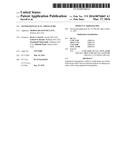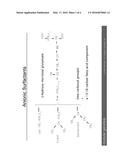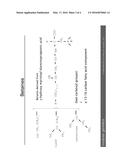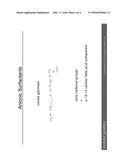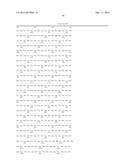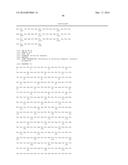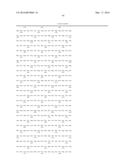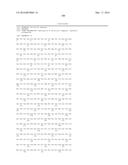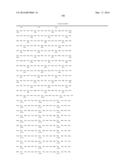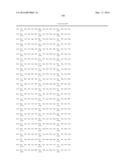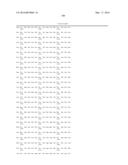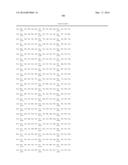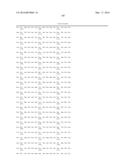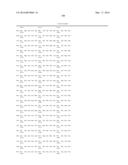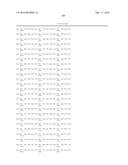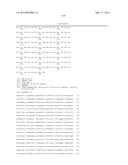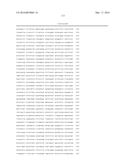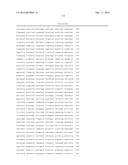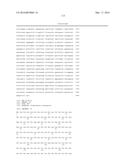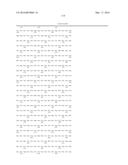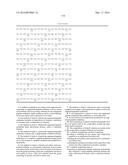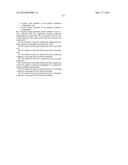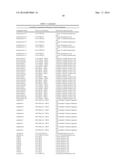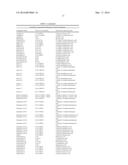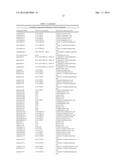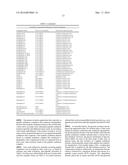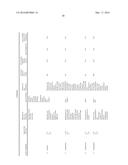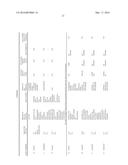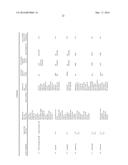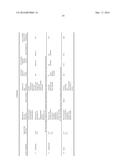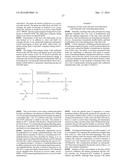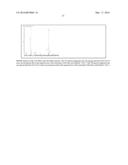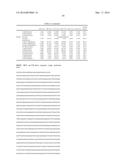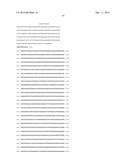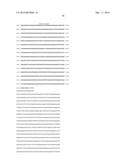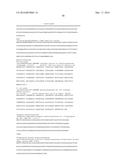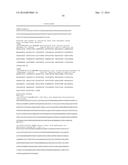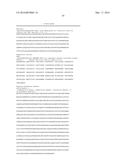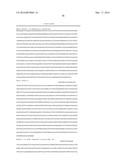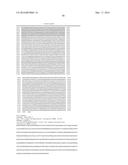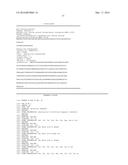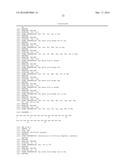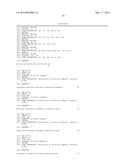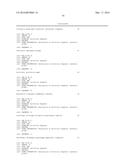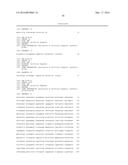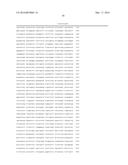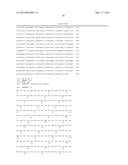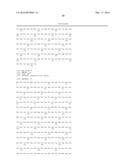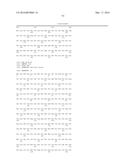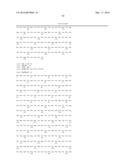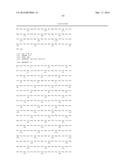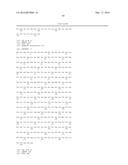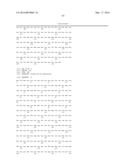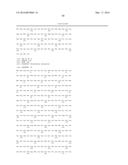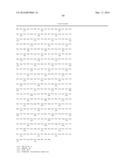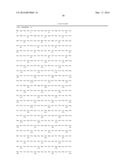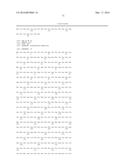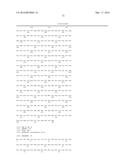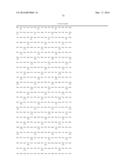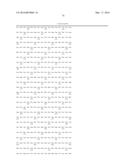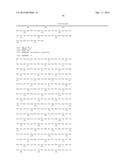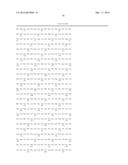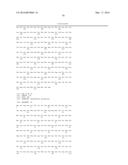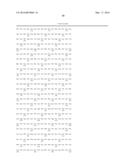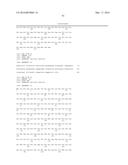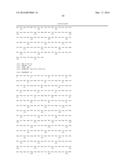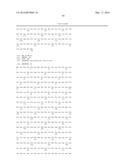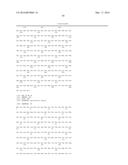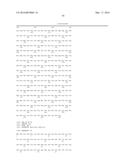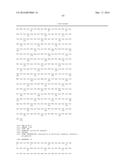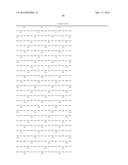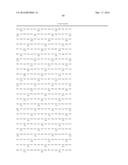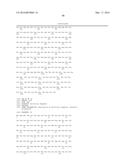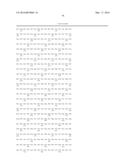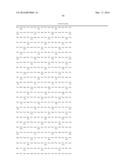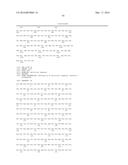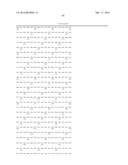Patent application title: GENERATION OF ACYL AMINO ACIDS
Inventors:
Kevin A. Jarrell (Lincoln, MA, US)
Gabriel O. Reznik (Waltham, MA, US)
Prashanth Vishwanath (Arlington, MA, US)
Michelle Pynn (Andover, MA, US)
IPC8 Class: AC12P1302FI
USPC Class:
514556
Class name: Designated organic active ingredient containing (doai) radical -xh acid, or anhydride, acid halide or salt thereof (x is chalcogen) doai inner quaternary ammonium salt (e.g., betaine, etc.)
Publication date: 2016-03-17
Patent application number: 20160076065
Abstract:
Engineered polypeptides useful in synthesizing acyl amino acids are
provided. Also provided are methods of making acyl amino acids using
engineered polypeptides.Claims:
1. A method of making an acyl amino acid composition by contacting an
engineered peptide synthetase with an amino acid substrate and an acyl
entity substrate for the engineered peptide synthetase, under conditions
and for a time sufficient for an acyl amino acid composition to be made.
2. The method of claim 1, wherein the engineered peptide synthetase includes an adenylation (A) domain, a thiolation (T) domain, and a condensation (C) domain.
3. The method of claim 1, wherein the engineered peptide synthetase lacks thioesterase domain, and/or a reductase domain.
4. The method of claim 1, wherein the engineered peptide synthetase contains only a single peptide synthetase domain.
5. The method of claim 1, wherein the engineered peptide synthetase is or comprises a peptide synthetase domain found in as a first domain in a peptide synthetase that synthesizes a lipopeptide.
6. The method of claim 1, wherein acyl amino acid composition includes, as a prominent component, an acyl amino acid whose amino acid moiety is from an amino acid selected from the group consisting of glycine or glutamate and whose acyl moiety is from a fatty acid selected from the group consisting of myristic acid and or lauric acid.
7. The method of claim 1, wherein the step of contacting comprises providing a cell engineered to express at least one engineered peptide synthetase.
8. A cell engineered to express at least one engineered peptide synthetase that synthesizes an acyl amino acid.
9. An acyl amino acid composition produced by an engineered peptide synthetase.
10. The composition of claim 9, wherein substantially all of the acyl amino acids in the composition contain the same amino acid component.
11. The composition of claim 9, wherein acyl amino acids in the composition comprise different acyl moieties.
12. A method of preparing a product comprising: providing or obtaining an acyl amino acid composition prepared in an engineered microbial cell; enriching the acyl amino acid composition for a particular acyl amino acid; combining the enriched acyl amino acid composition with at least one other component to produce a product.
13. A method comprising steps of: contacting an engineered peptide synthetase polypeptide that comprises a single peptide synthetase domain and lacks a thioesterase domain, and/or a reductase domain with: an amino acid substrate of the peptide synthetase polypeptide; and an acyl moiety substrate of the peptide synthetase polypeptide, the contacting being performed under conditions and for a time sufficient that the engineered peptide synthetase polypeptide covalently links the acyl moiety from the acyl moiety substrate to the amino acid so that an acyl amino acid is generated.
14. The method of claim 13, wherein the engineered peptide synthetase polypeptide is produced by a cell.
15. The method of claim 14, wherein the cell is a microbial cell.
16. The method of claim 15, wherein the cell is a bacterial cell.
17. The method of claim 2, wherein the step of contacting comprises contacting the cell with the substrates.
18. The method of claim 13, wherein the cell is an engineered cell.
19. The method of claim 20, wherein the cell is engineered in that the peptide synthetase polypeptide is an engineered peptide synthetase polypeptide.
20. The method of claim 3, wherein the step of contacting comprises contacting the cell with the substrates.
21. The method of claim 4, wherein the step of contacting comprises contacting the cell with the substrates.
Description:
CROSS-REFERENCE TO RELATED APPLICATIONS
[0001] This application claims the benefit of U.S. Provisional application Ser. No. ______, filed Mar. 15, 2013, the contents of which are hereby incorporated herein in its entirety.
BACKGROUND
[0002] Acyl amino acids are commercially important compounds. Many have advantageous characteristics and are sold as surfactants, antibiotics, anti-insect agents and as a variety of other important agents.
[0003] Traditionally, acyl amino acids have been manufactured chemically. Such chemical manufacturing methods are hampered by a variety of shortcomings including the ease of obtaining and storing the starting materials, the necessity of using harsh and sometimes dangerous chemical reagents in the manufacturing process, the difficulty and efficiency of the synthesis itself, the fiscal and environmental cost of disposing of chemical by-products, etc. Thus, new compositions and methods for the efficient and cost-effective synthesis of acyl amino acids and manufacture on a commercial scale would be beneficial.
[0004] Recently, important technologies have been developed that permit production of acyl amino acids by engineered peptide synthetase polypeptides (See U.S. Pat. No. 7,981,685, issued Jul. 19, 2011 and incorporated herein by reference in its entirety). Improvements and/or supplements to such technologies would be desirable and beneficial.
SUMMARY OF THE INVENTION
[0005] In certain embodiments, the present invention comprises compositions and methods useful in the generation of acyl amino acids. In certain embodiments, the present invention provides an engineered polypeptide comprising a peptide synthetase domain; in some such embodiments, the engineered polypeptide comprises only a single peptide synthetase domain. In some embodiments, the present invention provides an engineered peptide synthetase that is substantially free of a thioesterase domain, and/or a reductase domain.
[0006] In certain embodiments, the present invention provides an acyl amino acid composition comprising a plurality of different forms of an acyl amino acid. In some such compositions, substantially all of the acyl amino acids within the composition contain the same amino acid moiety and differ with respect to acyl moiety. We also described populations where the fatty acid si for example 95% one length (C14, myristic)
[0007] In some embodiments, the present invention provides a method of making an acyl amino acid composition by contacting an engineered peptide synthetase with an amino acid substrate and an acyl entity substrate for the engineered peptide synthetase, under conditions and for a time sufficient for an acyl amino acid composition to be made. In some embodiments, the method comprises providing a cell engineered to express the engineered peptide synthetase. In some embodiments, the engineered peptide synthetase does not include a thioesterase domain; in some embodiments, the engineered peptide synthetase does not include a reductase domain; in some embodiments, the engineered peptide synthetase includes neither a thioesterase domain not a reductase domain.
[0008] In some embodiments, an amino acid substrate is or comprises an amino acid as set forth herein.
[0009] In some embodiments, an acyl entity substrate is or comprises a fatty acid moiety. In some embodiments, an acyl entity substrate is or comprises a fatty acid.
[0010] The present invention provides cells engineered to express at least one engineered peptide synthetase that synthesizes an acyl amino acid.
[0011] In some embodiments, the present invention comprises an an acyl amino acid composition produced by an engineered peptide synthetase.
[0012] The present invention provides methods of preparing a product comprising: providing or obtaining an acyl amino acid composition prepared in an engineered host (e.g., microbial) cell; optionally enriching the acyl amino acid composition for a particular acyl amino acid; and, in some embodiments, combining the enriched acyl amino acid composition with at least one other component to produce a product.
[0013] In some embodiments, the invention provides a method comprising steps of: contacting an engineered peptide synthetase polypeptide that comprises a single peptide synthetase domain and lacks either of a thioesterase domain, and/or a reductase domain with (i) an amino acid substrate of the peptide synthetase polypeptide; and (ii) an acyl moiety substrate of the peptide synthetase polypeptide, the contacting being performed under conditions and for a time sufficient that the engineered peptide synthetase polypeptide covalently links the acyl moiety from the acyl moiety substrate to the amino acid so that an acyl amino acid is generated.
DESCRIPTION OF CERTAIN EMBODIMENTS
Definitions
[0014] Acyl amino acid: The term "acyl amino acid" as used herein refers to an amino acid that is covalently linked to a fatty acid moiety. In some embodiments, the amino acid and fatty acid are covalently linked via an amide bond formed between a carboxylic acid group of a fatty acid and an amino group of an amino acid. In some embodiments, a fatty acid moiety or entity utilized or included in an acyl amino acid includes a β-hydroxyl group; in some embodiments, a fatty acid moiety or entity utilized or included in an acyl amino acid does not include a β-hydroxyl group. In some embodiments, a fatty acid moiety utilized or included in an acyl amino acid includes a β-amino group; in some embodiments, a fatty acid moiety or entity utilized or included in an acyl amino acid does not include a β-amino group. In some embodiments, a fatty acid moiety utilized or included in an acyl amino acid is unmodified at the 3-position.
[0015] Amino acid: As used herein, the term "amino acid," in its broadest sense, refers to any compound and/or substance that can be utilized in peptide synthesis (e.g., ribosomal or non-ribosomal synthesis). In some embodiments, an amino acid is any compound and/or substance that can be incorporated into a polypeptide chain, e.g., through formation of one or more peptide bonds. In some embodiments, an amino acid is any compound and/or substance that is a substrate for a peptide synthetase; in some such embodiments, an amino acid is any compound and/or substance onto which a peptide synthetase can link an acyl entity, for example through formation of an amide bond. In some embodiments, an amino acid has the general structure H2N--C(H)(R)--COOH. In some embodiments, an amino acid is a naturally-occurring amino acid. In some embodiments, an amino acid is a synthetic amino acid; in some embodiments, an amino acid is a D-amino acid; in some embodiments, an amino acid is an L-amino acid. "Standard amino acid" refers to any of the twenty standard L-amino acids commonly found in naturally occurring peptides. "Nonstandard amino acid" refers to any amino acid, other than the standard amino acids, regardless of whether it is prepared synthetically or obtained from a natural source. In some embodiments, an amino acid, including a carboxy- and/or amino-terminal amino acid in a polypeptide, can contain a structural modification as compared with the general structure above. For example, in some embodiments, an amino acid may be modified by methylation, amidation, acetylation, and/or substitution as compared with the general structure. In some embodiments, such modification may, for example, alter the circulating half life of a polypeptide containing the modified amino acid as compared with one containing an otherwise identical unmodified amino acid. In some embodiments, such modification does not significantly alter a relevant activity of a polypeptide containing the modified amino acid, as compared with one containing an otherwise identical unmodified amino acid. As will be clear from context, in some embodiments, the term "amino acid" is used to refer to a free amino acid; in some embodiments it is used to refer to an amino acid residue of a polypeptide. In some embodiments, a "naturally occurring" amino acid is one of the standard group of twenty amino acids that are the building blocks of polypeptides of most organisms, including alanine, arginine, asparagine, aspartic acid, cysteine, glutamic acid, glutamine, glycine, histidine, isoleucine, leucine, lysine, methionine, phenylalanine, proline, serine, threonine, tryptophan, tyrosine, and valine. In certain embodiments a "naturally occurring" amino acid may be one of those amino acids that are used less frequently and are typically not included in this standard group of twenty but are nevertheless still used by one or more organisms and incorporated into certain polypeptides. For example, the codons UAG and UGA normally encode stop codons in most organisms. However, in some organisms the codons UAG and UGA encode the amino acids selenocysteine and pyrolysine. Thus, in certain embodiments, selenocysteine and pyrolysine are naturally occurring amino acids.
[0016] Associated with: Two events or entities are "associated" with one another, as that term is used herein, if the presence, level and/or form of one is correlated with that of the other. For example, a particular entity (e.g., polypeptide) is considered to be associated with a particular disease, disorder, or condition, if its presence, level and/or form correlates with incidence of and/or susceptibility of the disease, disorder, or condition (e.g., across a relevant population). In some embodiments, two or more entities are physically "associated" with one another if they interact, directly or indirectly, so that they are and remain in physical proximity with one another. In some embodiments, two or more entities that are physically associated with one another are covalently linked to one another; in some embodiments, two or more entities that are physically associated with one another are not covalently linked to one another but are non-covalently associated, for example by means of hydrogen bonds, van der Waals interaction, hydrophobic interactions, magnetism, and combinations thereof.
[0017] Beta-hydroxy fatty acid linkage domain: The term "beta-hydroxy fatty acid linkage domain" as used herein refers to a polypeptide domain that covalently links a beta-hydroxy fatty acid to an amino acid to form an acyl amino acid. A variety of beta-hydroxy fatty acid linkage domains are known to those skilled in the art. However, different beta-hydroxy fatty acid linkage domains often exhibit specificity for one or more beta-hydroxy fatty acids. As one non-limiting example, the beta-hydroxy fatty acid linkage domain from surfactin synthetase is specific for the beta-hydroxy myristic acid, which contains 13 to 15 carbons in the fatty acid chain. Thus, the beta-hydroxy fatty acid linkage domain from surfactin synthetase can be used in accordance with the present invention to construct an engineered polypeptide useful in the generation of an acyl amino acid that comprises the fatty acid beta-hydroxy myristic acid.
[0018] Beta-hydroxy fatty acid: The term "beta-hydroxy fatty acid" as used herein refers to a fatty acid chain comprising a hydroxy group at the beta position of the fatty acid chain. As is understood by those skilled in the art, the beta position corresponds to the third carbon of the fatty acid chain, the first carbon being the carbon of the carboxylate group. Thus, when used in reference to an acyl amino acid of the present invention, where the carboxylate moiety of the fatty acid has been covalently attached to the nitrogen of the amino acid, the beta position corresponds to the carbon two carbons removed from the carbon having the ester group. A beta-hydroxy fatty acid to be used in accordance with the present invention may contain any number of carbon atoms in the fatty acid chain. As non-limiting examples, a beta-hydroxy fatty acid may contain 3, 4, 5, 6, 7, 8, 9, 10, 11, 12, 3, 14, 15, 15, 16, 17, 18, 19, 20 or more carbon atoms. Beta-hydroxy fatty acids to be used in accordance with the present invention may contain linear carbon chains, in which each carbon of the chain, with the exception of the terminal carbon atom and the carbon attached to the nitrogen of the amino acid, is directly covalently linked to two other carbon atoms. Additionally or alternatively, beta-hydroxy fatty acids to be used in accordance with the present invention may contain branched carbon chains, in which at least one carbon of the chain is directly covalently linked to three or more other carbon atoms. Beta-hydroxy fatty acids to be used in accordance with the present invention may contain one or more double bonds between adjacent carbon atoms. Alternatively, beta-hydroxy fatty acids to be used in accordance with the present invention may contain only single-bonds between adjacent carbon atoms. A non-limiting exemplary beta-hydroxy fatty acid that may be used in accordance with the present invention is or comprises a beta-hydroxy, acid which contains 13 to 15 carbons in the fatty acid chain; in some embodiments, an exemplary beta-hydroxy fatty acid that may be used in accordance with the present invention is or comprises myristic acid myristic is usually used to mean 14 carbons Those of ordinary skill in the art will be aware of various beta-hydroxy fatty acids that can be used in accordance with the present invention. Different beta-hydroxy fatty acid linkage domains that exhibit specificity for other beta-hydroxy fatty acids (e.g., naturally or non-naturally occurring beta-hydroxy fatty acids) may be used in accordance with the present invention to generate any acyl amino acid of the practitioner's choosing.
[0019] Characteristic sequence element: As used herein, the phrase "characteristic sequence element" refers to a sequence element found in a polymer (e.g., in a polypeptide or nucleic acid) that represents a characteristic portion of that polymer. In some embodiments, presence of a characteristic sequence element correlates with presence or level of a particular activity or property of the polymer. In some embodiments, presence (or absence) of a characteristic sequence element defines a particular polymer as a member (or not a member) of a particular family or group of such polymers. A characteristic sequence element typically comprises at least two monomers (e.g., amino acids or nucleotides). In some embodiments, a characteristic sequence element includes at least 2, 3, 4, 5, 6, 7, 8, 9, 10, 11, 12, 13, 14, 15, 20, 25, 30, 35, 40, 45, 50, or more monomers (e.g., contiguously linked monomers). In some embodiments, a characteristic sequence element includes at least first and second stretches of continuous monomers spaced apart by one or more spacer regions whose length may or may not vary across polymers that share the sequence element.
[0020] Combination therapy: As used herein, the term "combination therapy" refers to those situations in which a subject is simultaneously exposed to two or more therapeutic agents. In some embodiments, such agents are administered simultaneously; in some embodiments, such agents are administered sequentially; in some embodiments, such agents are administered in overlapping regimens.
[0021] Comparable: The term "comparable", as used herein, refers to two or more agents, entities, situations, sets of conditions, etc that may not be identical to one another but that are sufficiently similar to permit comparison therebetween so that conclusions may reasonably be drawn based on differences or similarities observed. Those of ordinary skill in the art will understand, in context, what degree of identity is required in any given circumstance for two or more such agents, entities, situations, sets of conditions, etc to be considered comparable.
[0022] Corresponding to: As used herein, the term "corresponding to" is often used to designate the position/identity of a residue in a polymer, such as an amino acid residue in a polypeptide or a nucleotide residue in a nucleic acid. Those of ordinary skill will appreciate that, for purposes of simplicity, residues in such a polymer are often designated using a canonical numbering system based on a reference related polymer, so that a residue in a first polymer "corresponding to" a residue at position 190 in the reference polymer, for example, need not actually be the 190th residue in the first polymer but rather corresponds to the residue found at the 190th position in the reference polymer; those of ordinary skill in the art readily appreciate how to identify "corresponding" amino acids, including through use of one or more commercially-available algorithms specifically designed for polymer sequence comparisons.
[0023] Domain, Polypeptide domain: The terms "domain" and "polypeptide domain" as used herein generally refer to polypeptide moieties that display a particular activity, even when isolated (e.g., cleaved) from other polypeptides or polypeptide domains. In some embodiments, a polypeptide domain folds into a particular discrete structure in three-dimensional space. In some embodiments, a polypeptide domain within a longer polypeptide is separated from one or more other polypeptide domains within the longer polypeptide by virtue of a linker element, for example, that may comprise a substantially unstructured stretch of amino acids. In some embodiments, the terms refer to domains that naturally occur in longer polypeptides; in some embodiments, the term refers to engineered polypeptide moieties that correspond and/or show significant homology and/or identity to such naturally occurring polypeptide moieties, or to other reference polypeptide moieties (e.g., historical engineered moieties). In some embodiments, an engineered domain that corresponds and/or shows significant homology and/or identity to a naturally occurring or other reference moiety shares a characteristic structure (e.g., primary structure such as the amino acid sequence of the domain, and/or secondary, tertiary, quaternary, etc. structures); alternatively or additionally, such an engineered domain may exhibit one or more distinct functions that it shares with its reference polypeptide moieties. As will be understood by those skilled in the art, in many cases polypeptides are modular and are comprised of one or more polypeptide domains; in some such embodiments, each domain exhibits one or more distinct functions that contribute to the overall function of the polypeptide. In some embodiments, the structure and/or function of many such domains are known to those skilled in the art.
[0024] Engineered: The term "engineered" as used herein refers to a non-naturally occurring moiety that has been created by the hand of man. For example, in reference to a polypeptide, an "engineered polypeptide" refers to a polypeptide that has been designed and/or produced by the hand of man. In some embodiments, an engineered polypeptide has an amino acid sequence that includes one or more sequence elements that do(es) not occur in nature. In some embodiments, an engineered polypeptide has an amino acid sequence that includes one or more sequence elements that does occur in nature, but that is present in the engineered polypeptide in a different sequence context (e.g., separated from at least one sequence to which it is linked in nature and/or linked with at least one sequence element to which it is not linked in nature) from that in which it occurs in nature. In some embodiments, an engineered polypeptide is one in which naturally-occurring sequence element(s) is/are separated from at least one sequence with which they/it is associated (e.g., linked) in nature and/or is otherwise manipulated to comprise a polypeptide that does not exist in nature. In various embodiments, an engineered polypeptide comprises two or more covalently linked polypeptide domains. Typically such domains will be linked via peptide bonds, although the present invention is not limited to engineered polypeptides comprising polypeptide domains linked via peptide bonds, and encompasses other covalent linkages known to those skilled in the art. One or more covalently linked polypeptide domains of engineered polypeptides may be naturally occurring. Thus, in certain embodiments, engineered polypeptides of the present invention comprise two or more covalently linked domains, at least one of which is naturally occurring. In certain embodiments, two or more naturally occurring polypeptide domains are covalently linked to generate an engineered polypeptide. For example, naturally occurring polypeptide domains from two or more different polypeptides may be covalently linked to generate an engineered polypeptide. In certain embodiments, naturally occurring polypeptide domains of an engineered polypeptide are covalently linked in nature, but are covalently linked in the engineered polypeptide in a way that is different from the way the domains are linked nature. For example, two polypeptide domains that naturally occur in the same polypeptide but which are separated by one or more intervening amino acid residues may be directly covalently linked (e.g., by removing the intervening amino acid residues) to generate an engineered polypeptide of the present invention. Additionally or alternatively, two polypeptide domains that naturally occur in the same polypeptide which are directly covalently linked together (e.g., not separated by one or more intervening amino acid residues) may be indirectly covalently linked (e.g., by inserting one or more intervening amino acid residues) to generate an engineered polypeptide of the present invention. In certain embodiments, one or more covalently linked polypeptide domains of an engineered polypeptide may not exist naturally. For example, such polypeptide domains may be engineered themselves.
[0025] Fatty acid linkage domain: The term "fatty acid linkage domain" as used herein refers to a polypeptide domain that covalently links a fatty acid to an amino acid to form an acyl amino acid. In some embodiments, a fatty acid linkage domain is a condensation domain; in some embodiments such a fatty acid linkage domain is part of a single polypeptide or a polypeptide complex with at least or only an adenylkation domain, a thiolation domain, or both. A variety of fatty acid linkage domains are known in the art, such as for example, fatty acid linkage domains present in various peptide synthetase complexes that produce lipopeptides. In certain embodiments, a fatty acid linkage domain links a beta-hydroxy fatty acid to an amino acid; in some embodiments, a fatty acid linkage domain links a beta-amino fatty acid to an amino acid; in some embodiments, a fatty acid linkage domain links a fatty acid that is unmodified at the beta position to an amino acid. In some embodiments, a fatty acid linkage domain catalyzes condensation of a fatty acid and an amino acid so that an amide both is formed, for example between a carboxylic acid moiety on a fatty acid and an amino moiety on an amino acid.
[0026] Homology: As used herein, the term "homology" refers to the overall relatedness between polymeric molecules, e.g., between nucleic acid molecules (e.g., DNA molecules and/or RNA molecules) and/or between polypeptide molecules. In some embodiments, polymeric molecules are considered to be "homologous" to one another if their sequences are at least 25%, 30%, 35%, 40%, 45%, 50%, 55%, 60%, 65%, 70%, 75%, 80%, 85%, 90%, 95%, or 99% identical. In some embodiments, polymeric molecules are considered to be "homologous" to one another if their sequences are at least 25%, 30%, 35%, 40%, 45%, 50%, 55%, 60%, 65%, 70%, 75%, 80%, 85%, 90%, 95%, or 99% similar (e.g., containing residues with related chemical properties at corresponding positions). For example, as is well known by those of ordinary skill in the art, certain amino acids are typically classified as similar to one another as "hydrophobic" or "hydrophilic" amino acids, and/or as having "polar" or "non-polar" side chains. Substitution of one amino acid for another of the same type may often be considered a "homologous" substitution. Typical amino acid categorizations are summarized below:
TABLE-US-00001 Alanine Ala A nonpolar neutral 1.8 Arginine Arg R polar positive -4.5 Asparagine Asn N polar neutral -3.5 Aspartic acid Asp D polar negative -3.5 Cysteine Cys C nonpolar neutral 2.5 Glutamic acid Glu E polar negative -3.5 Glutamine Gln Q polar neutral -3.5 Glycine Gly G nonpolar neutral -0.4 Histidine His H polar positive -3.2 Isoleucine Ile I nonpolar neutral 4.5 Leucine Leu L nonpolar neutral 3.8 Lysine Lys K polar positive -3.9 Methionine Met M nonpolar neutral 1.9 Phenylalanine Phe F nonpolar neutral 2.8 Proline Pro P nonpolar neutral -1.6 Serine Ser S polar neutral -0.8 Threonine Thr T polar neutral -0.7 Tryptophan Trp W nonpolar neutral -0.9 Tyrosine Tyr Y polar neutral -1.3 Valine Val V nonpolar neutral 4.2
TABLE-US-00002 Ambiguous Amino Acids 3-Letter 1-Letter Asparagine or aspartic acid Asx B Glutamine or glutamic acid Glx Z Leucine or Isoleucine Xle J Unspecified or unknown amino acid Xaa X
As will be understood by those skilled in the art, a variety of algorithms are available that permit comparison of sequences in order to determine their degree of homology, including by permitting gaps of designated length in one sequence relative to another when considering which residues "correspond" to one another in different sequences. Calculation of the percent homology between two nucleic acid sequences, for example, can be performed by aligning the two sequences for optimal comparison purposes (e.g., gaps can be introduced in one or both of a first and a second nucleic acid sequences for optimal alignment and non-corresponding sequences can be disregarded for comparison purposes). In certain embodiments, the length of a sequence aligned for comparison purposes is at least 30%, at least 40%, at least 50%, at least 60%, at least 70%, at least 80%, at least 90%, at least 95%, or substantially 100% of the length of the reference sequence. The nucleotides at corresponding nucleotide positions are then compared. When a position in the first sequence is occupied by the same nucleotide as the corresponding position in the second sequence, then the molecules are identical at that position; when a position in the first sequence is occupied by a similar nucleotide as the corresponding position in the second sequence, then the molecules are similar at that position. The percent homology between the two sequences is a function of the number of identical and similar positions shared by the sequences, taking into account the number of gaps, and the length of each gap, which needs to be introduced for optimal alignment of the two sequences. Representative algorithms and computer programs useful in determining the percent homology between two nucleotide sequences include, for example, the algorithm of Meyers and Miller (CABIOS, 1989, 4: 11-17), which has been incorporated into the ALIGN program (version 2.0) using a PAM120 weight residue table, a gap length penalty of 12 and a gap penalty of 4. The percent homology between two nucleotide sequences can, alternatively, be determined for example using the GAP program in the GCG software package using an NWSgapdna.CMP matrix.
[0027] Identity: As used herein, the term "identity" refers to the overall relatedness between polymeric molecules, e.g., between nucleic acid molecules (e.g., DNA molecules and/or RNA molecules) and/or between polypeptide molecules. In some embodiments, polymeric molecules are considered to be "substantially identical" to one another if their sequences are at least 25%, 30%, 35%, 40%, 45%, 50%, 55%, 60%, 65%, 70%, 75%, 80%, 85%, 90%, 95%, or 99% identical. As will be understood by those skilled in the art, a variety of algorithms are available that permit comparison of sequences in order to determine their degree of homology, including by permitting gaps of designated length in one sequence relative to another when considering which residues "correspond" to one another in different sequences. Calculation of the percent identity between two nucleic acid sequences, for example, can be performed by aligning the two sequences for optimal comparison purposes (e.g., gaps can be introduced in one or both of a first and a second nucleic acid sequences for optimal alignment and non-corresponding sequences can be disregarded for comparison purposes). In certain embodiments, the length of a sequence aligned for comparison purposes is at least 30%, at least 40%, at least 50%, at least 60%, at least 70%, at least 80%, at least 90%, at least 95%, or substantially 100% of the length of the reference sequence. The nucleotides at corresponding nucleotide positions are then compared. When a position in the first sequence is occupied by the same nucleotide as the corresponding position in the second sequence, then the molecules are identical at that position. The percent identity between the two sequences is a function of the number of identical positions shared by the sequences, taking into account the number of gaps, and the length of each gap, which needs to be introduced for optimal alignment of the two sequences. Representative algorithms and computer programs useful in determining the percent identity between two nucleotide sequences include, for example, the algorithm of Meyers and Miller (CABIOS, 1989, 4:11-17), which has been incorporated into the ALIGN program (version 2.0) using a PAM120 weight residue table, a gap length penalty of 12 and a gap penalty of 4. The percent identity between two nucleotide sequences can, alternatively, be determined for example using the GAP program in the GCG software package using an NWSgapdna.CMP matrix.
[0028] Isolated: As used herein, the term "isolated" refers to a substance and/or entity that has been (1) separated from at least some of the components with which it was associated when initially produced (whether in nature and/or in an experimental setting), and/or (2) designed, produced, prepared, and/or manufactured by the hand of man. Isolated substances and/or entities may be separated from about 10%, about 20%, about 30%, about 40%, about 50%, about 60%, about 70%, about 80%, about 90%, about 91%, about 92%, about 93%, about 94%, about 95%, about 96%, about 97%, about 98%, about 99%, or more than about 99% of the other components with which they were initially associated. In some embodiments, isolated agents are about 80%, about 85%, about 90%, about 91%, about 92%, about 93%, about 94%, about 95%, about 96%, about 97%, about 98%, about 99%, or more than about 99% pure. As used herein, a substance is "pure" if it is substantially free of other components. In some embodiments, as will be understood by those skilled in the art, a substance may still be considered "isolated" or even "pure", after having been combined with certain other components such as, for example, one or more carriers or excipients (e.g., buffer, solvent, water, etc.); in such embodiments, percent isolation or purity of the substance is calculated without including such carriers or excipients. In some embodiments, isolation involves or requires disruption of covalent bonds (e.g., to isolate a polypeptide domain from a longer polypeptide and/or to isolate a nucleotide sequence element from a longer oligonucleotide or nucleic acid).
[0029] Naturally occurring: The term "naturally occurring", as used herein, refers to an agent or entity that is known to exist in nature.
[0030] Nucleic acid: As used herein, the term "nucleic acid," in its broadest sense, refers to any compound and/or substance that is or can be incorporated into an oligonucleotide chain. In some embodiments, a nucleic acid is a compound and/or substance that is or can be incorporated into an oligonucleotide chain via a phosphodiester linkage. As will be clear from context, in some embodiments, "nucleic acid" refers to individual nucleic acid residues (e.g., nucleotides and/or nucleosides): in some embodiments, "nucleic acid" refers to an oligonucleotide chain comprising individual nucleic acid residues. In some embodiments, a "nucleic acid" is or comprises RNA; in some embodiments, a "nucleic acid" is or comprises DNA. In some embodiments, a nucleic acid is, comprises, or consists of one or more natural nucleic acid residues. In some embodiments, a nucleic acid is, comprises, or consists of one or more nucleic acid analogs. In some embodiments, a nucleic acid analog differs from a nucleic acid in that it does not utilize a phosphodiester backbone. For example, in some embodiments, a nucleic acid is, comprises, or consists of one or more "peptide nucleic acids", which are known in the art and have peptide bonds instead of phosphodiester bonds in the backbone, are considered within the scope of the present invention. Alternatively or additionally, in some embodiments, a nucleic acid has one or more phosphorothioate and/or 5'-N-phosphoramidite linkages rather than phosphodiester bonds. In some embodiments, a nucleic acid is, comprises, or consists of one or more natural nucleosides (e.g., adenosine, thymidine, guanosine, cytidine, uridine, deoxyadenosine, deoxythymidine, deoxyguanosine, and deoxycytidine). In some embodiments, a nucleic acid is, comprises, or consists of one or more nucleoside analogs (e.g., 2-aminoadenosine, 2-thiothymidine, inosine, pyrrolo-pyrimidine, 3-methyl adenosine, 5-methylcytidine, C-5 propynyl-cytidine, C-5 propynyl-uridine, 2-aminoadenosine, C5-bromouridine, C5-fluorouridine, C5-iodouridine, C5-propynyl-uridine, C5-propynyl-cytidine, C5-methylcytidine, 2-aminoadenosine, 7-deazaadenosine, 7-deazaguanosine, 8-oxoadenosine, 8-oxoguanosine, O(6)-methylguanine, 2-thiocytidine, methylated bases, intercalated bases, and combinations thereof). In some embodiments, a nucleic acid comprises one or more modified sugars (e.g., 2'-fluororibose, ribose, 2'-deoxyribose, arabinose, and hexose) as compared with those in natural nucleic acids. In some embodiments, a nucleic acid has a nucleotide sequence that encodes a functional gene product such as an RNA or protein. In some embodiments, a nucleic acid includes one or more introns. In some embodiments, nucleic acids are prepared by one or more of isolation from a natural source, enzymatic synthesis by polymerization based on a complementary template (in vivo or in vitro), reproduction in a recombinant cell or system, and chemical synthesis. In some embodiments, a nucleic acid is at least 3, 4, 5, 6, 7, 8, 9, 10, 15, 20, 25, 30, 35, 40, 45, 50, 55, 60, 65, 70, 75, 80, 85, 90, 95, 100, 110, 120, 130, 140, 150, 160, 170, 180, 190, 20, 225, 250, 275, 300, 325, 350, 375, 400, 425, 450, 475, 500, 600, 700, 800, 900, 1000, 1500, 2000, 2500, 3000, 3500, 4000, 4500, 5000 or more residues long.
[0031] Peptide synthetase complex: The term "peptide synthetase complex" as used herein refers to an enzyme that catalyzes the non-ribosomal production of peptides. As will be appreciated by those of ordinary skill in the art, peptide synthetase complexes are modular, and are comprised of individual peptide synthetase modules that perform different steps in the synthesis of the ultimate peptide, typically, each module performs one step (e.g., adds a single amino acid). A peptide synthetase complex may comprise a single enzymatic subunit (e.g., a single polypeptide), or may comprise two or more enzymatic subunits (e.g., two or more polypeptides). A peptide synthetase complex typically comprises at least one peptide synthetase domain, and may further comprise one or more additional domains such as for example, a fatty acid linkage domain, a thioesterase domain, a reductase domain, etc. Peptide synthetase domains of a peptide synthetase complex may comprise two or more enzymatic subunits, with two or more peptide synthetase domains present in a given enzymatic subunit. For example the surfactin peptide synthetase complex (also referred to herein simply as "surfactin synthetase complex") comprises three distinct polypeptide enzymatic subunits: the first two subunits comprise three peptide synthetase domains, while the third subunit comprises a single peptide synthetase domain.
[0032] Peptide synthetase domain: The term "peptide synthetase domain" as used herein refers to a polypeptide domain that minimally comprises three domains: an adenylation (A) domain, responsible for selectively recognizing and activating a specific amino acid, a thiolation (T) domain, which tethers the activated amino acid to a cofactor via thioester linkage, and a condensation (C) domain, which links amino acids joined to successive units of the peptide synthetase by the formation of amide bonds. A peptide synthetase domain typically recognizes and activates a single, specific amino acid, and in the situation where the peptide synthetase domain is not the first domain in the pathway, links the specific amino acid to the growing peptide chain.
[0033] Polypeptide: The term "polypeptide" as used herein refers to a series of amino acids joined together in peptide linkages. In some embodiments, a "polypeptide" has a structure as achieve through synthesis by ribosomal machinery in naturally occurring organisms. In some embodiments a "polypeptide" has a structure as achieved through chemical synthesis (e.g., in vitro). In some embodiments, a "polypeptide" has a structure as achieved through joining of a series of amino acids joined together by non-ribosomal machinery, such as by way of non-limiting example, polypeptides synthesized by peptide synthetases. Such non-ribosomally produced polypeptides exhibit a greater diversity in covalent linkages than polypeptides synthesized by ribosomes (although those skilled in the art will understand that the amino acids of ribosomally-produced polypeptides may also be linked by covalent bonds that are not peptide bonds, such as the linkage of cystines via di-sulfide bonds). In some embodiments, the term is used to refer to specific functional classes of polypeptides, such as, for example, autoantigen polypeptides, nicotinic acetylcholine receptor polypeptides, alloantigen polypeptides, etc. For each such class, the present specification provides several examples of amino acid sequences of known exemplary polypeptides within the class; in some embodiments, such known polypeptides are reference polypeptides for the class. In such embodiments, the term "polypeptide" refers to any member of the class that shows significant sequence homology or identity with a relevant reference polypeptide. In many embodiments, such member also shares significant activity with the reference polypeptide. For example, in some embodiments, a member polypeptide shows an overall degree of sequence homology or identity with a reference polypeptide that is at least about 30-40%, and is often greater than about 50%, 60%, 70%, 80%, 90%, 91%, 92%, 93%, 94%, 95%, 96%, 97%, 98%, 99% or more and/or includes at least one region (i.e., a conserved region, often including a characteristic sequence element) that shows very high sequence identity, often greater than 90% or even 95%, 96%, 97%, 98%, or 99%. Such a conserved region usually encompasses at least 3-4 and often up to 20 or more amino acids; in some embodiments, a conserved region encompasses at least one stretch of at least 2, 3, 4, 5, 6, 7, 8, 9, 10, 11, 12, 13, 14, 15 or more contiguous amino acids. Polypeptides can be two or more amino acids in length, although most polypeptides produced by ribosomes and peptide synthetases are longer than two amino acids. For example, in some embodiments, polypeptides may be 2, 3, 4, 5, 6, 7, 8, 9, 10, 15, 20, 25, 30, 35, 40, 45, 50, 55, 60, 65, 70, 75, 80, 85, 90, 95, 100, 150, 200, 250, 300, 350, 400, 450, 500, 600, 700, 800, 900, 1000, 2000, 3000, 4000, 5000, 6000, 7000, 8000, 9000, 10,000 or more amino acids in length.
[0034] Reductase Domain: The term "reductase domain" as used herein refers to a polypeptide domain that catalyzes release of an acyl amino acid produced by a peptide synthetase complex from the peptide synthetase complex. In certain embodiments, a reductase domain is covalently linked to a peptide synthetase domain and a fatty acid linkage domain such as a beta-hydroxy fatty acid linkage domain to generate an engineered polypeptide useful in the synthesis of an acyl amino acid. A variety of reductase domains are found in nature in nonribosomal peptide synthetase complexes from a variety of species. A non-limiting example of a reductase domain that may be used in accordance with the present invention includes the reductase domain from linear gramicidin (ATCC8185). However, any reductase domain that releases an acyl amino acid produced by a peptide synthetase complex from the peptide synthetase complex may be used in accordance with the present invention. In some embodiments, reductase domains are characterized by the presence of the consensus sequence: [LIVSPADNK]-x(9)-{P}-x(2)-Y-[PSTAGNCV]-[STAGNQCIVM]-[STAGC]-K-{PC}-[SAGFY- R]-[LIVMSTAGD]-x-{K}-[LIVMFYW]-{D}-x-{YR}-[LIVMFYWGAPTHQ]-[GSACQRHM] (SEQ ID NO: 1), where square brackets ("[ ]") indicate amino acids that are typically present at that position, squiggly brackets ("{ }") indicate amino acids that amino acids that are typically not present at that position, and "x" denotes any amino acid or a gap. X(9) for example denotes any amino acids or gaps for nine consecutive positions. Those skilled in the art will be aware of methods to determine whether a give polypeptide domain is a reductase domain.
[0035] Small molecule: As used herein, the term "small molecule" means a low molecular weight organic compound that may serve as an enzyme substrate or regulator of biological processes. In general, a "small molecule" is a molecule that is less than about 5 kilodaltons (kD) in size. In some embodiments, provided nanoparticles further include one or more small molecules. In some embodiments, the small molecule is less than about 4 kD, 3 kD, about 2 kD, or about 1 kD. In some embodiments, the small molecule is less than about 800 daltons (D), about 600 D, about 500 D, about 400 D, about 300 D, about 200 D, or about 100 D. In some embodiments, a small molecule is less than about 2000 g/mol, less than about 1500 g/mol, less than about 1000 g/mol, less than about 800 g/mol, or less than about 500 g/mol. In some embodiments, one or more small molecules are encapsulated within the nanoparticle. In some embodiments, small molecules are non-polymeric. In some embodiments, in accordance with the present invention, small molecules are not proteins, polypeptides, oligopeptides, peptides, polynucleotides, oligonucleotides, polysaccharides, glycoproteins, proteoglycans, etc. In some embodiments, a small molecule is a therapeutic. In some embodiments, a small molecule is an adjuvant. In some embodiments, a small molecule is a drug.
[0036] Surfactin: Surfactin is cyclic lipopeptide that is naturally produced by certain bacteria, including the Gram-positive endospore-forming bacteria Bacillus subtilis. Surfactin is an amphiphilic molecule (having both hydrophobic and hydrophilic properties) and is thus soluble in both organic solvents and water. Surfactin exhibits exceptional surfactant properties, making it a commercially valuable molecule. Due to its surfactant properties, surfactin also functions as an antibiotic. For example, surfactin is known to be effective as an anti-bacterial, anti-viral, anti-fungal, anti-mycoplasma and hemolytic compound. Surfactin is capable of penetrating the cell membranes of all types of bacteria, including both Gram-negative and Gram-positive bacteria, which differ in the composition of their membrane. Gram-positive bacteria have a thick peptidoglycan layer on the outside of their phospholipid bilayer. In contrast, Gram-negative bacteria have a thinner peptidoglycan layer on the outside of their phospholipid bilayer, and further contain an additional outer lipopolysaccharide membrane. Surfactin's surfactant activity permits it to create a permeable environment for the lipid bilayer and causes disruption that solubilizes the membrane of both types of bacteria. In order for surfactin to carry out minimal antibacterial effects, the minimum inhibitory concentration (MIC) is in the range of 12-50 μg/ml. In addition to its antibacterial properties, surfactin also exhibits antiviral properties, and its known to disrupt enveloped viruses such as HIV and HSV. Surfactin not only disrupts the lipid envelope of viruses, but also their capsids through ion channel formations. Surfactin isoforms containing fatty acid chains with 14 or 15 carbon atoms exhibited improved viral inactivation, thought to be due to improved disruption of the viral envelope. Surfactin consists of a seven amino acid peptide loop, and a hydrophobic fatty acid chain (beta-hydroxy myristic acid) that is thirteen to fifteen carbons long. The fatty acid chain allows permits surfactin to penetrate cellular membranes. The peptide loop comprises the amino acids L-asparagine, L-leucine, glycine, L-leucine, L-valine and two D-leucines. Glycine and asparagine residues at positions 1 and 6 respectively, constitute a minor polar domain. On the opposite side, valine residue at position 4 extends down facing the fatty acid chain, making up a major hydrophobic domain. Surfactin is synthesized by the surfactin synthetase complex, which comprises the three surfactin synthetase polypeptide subunits SrfA-A, SrfA-B, and SrfA-C. The surfactin synthetase polypeptide subunits SrfA-A and SrfA-B each comprise three peptide synthetase domains, each of which adds a single amino acid to the growing surfactin peptide, while the monomodular surfactin synthetase polypeptide subunit SrfA-C comprises a single peptide synthetase domain and adds the last amino acid residue to the heptapeptide. Additionally the SrfA-C subunit comprises a thioesterase domain, which catalyzes the release of the product via a nucleophilic attack of the beta-hydroxy of the fatty acid on the carbonyl of the C-terminal Leu of the peptide, cyclizing the molecule via formation of an ester. The spectrum of the beta-hydroxy fatty acids was elucidated as iso, anteiso C13, iso, normal C14 and iso, anteiso C15, and a recent study has indicated that surfactin retains an R configuration at C-beta (Nagai et al., Study on surfactin, a cyclic depsipeptide. 2. Synthesis of surfactin B2 produced by Bacillus natto KMD 2311. Chem Pharm Bull (Tokyo) 44: 5-10, 1996).
[0037] Surfactin is a lipopeptide synthesized by the surfactin synthetase complex. Surfactin comprises seven amino acids, which are initially joined by peptide bonds, as well as a beta-hydroxy fatty acid covalently linked to the first amino acid, glutamate. However, upon addition the final amino acid (leucine), the polypeptide is released and the thioesterase domain of the SRFC protein catalyzes the release of the product via a nucleophilic attack of the beta-hydroxy of the fatty acid on the carbonyl of the C-terminal Leu of the peptide, cyclizing the molecule via formation of an ester, resulting in the C-terminus carboxyl group of leucine attached via a lactone bond to the b-hydroxyl group of the fatty acid.
[0038] Thioesterase domain: The term "thioesterase domain" as used herein refers to a polypeptide domain that catalyzes release of an acyl amino acid produced by a peptide synthetase complex from the peptide synthetase complex. A variety of thioesterase domains are found in nature in nonribosomal peptide synthetase complexes from a variety of species. A non-limiting example of a thioesterase domain that may be used in accordance with the present invention includes the thioesterase domain from the Bacillus subtilis surfactin synthetase complex, present in Srf-C subunit. However, any thioesterase domain that releases an acyl amino acid produced by a peptide synthetase complex from the peptide synthetase complex may be used in accordance with the present invention. In some embodiments, thioesterase domains are characterized by the presence of the consensus sequence: [LIV]-{KG}-[LIVFY]-[LIVMST]-G-[HYWV]-S-{YAG}-G-[GSTAC] (SEQ ID NO: 2), where square brackets ("[ ]") indicate amino acids that are typically present at that position, and squiggly brackets ("{ }") indicate amino acids that amino acids that are typically not present at that position. Those skilled in the art will be aware of methods to determine whether a give polypeptide domain is a thioesterase domain.
Engineered Polypeptides Useful in the Generation of Acyl Amino Acids
[0039] The present invention provides compositions and methods for the generation of acyl amino acids. In certain embodiments, compositions of the present invention comprise engineered polypeptides that are useful in the production of acyl amino acids. In certain embodiments, engineered polypeptides of the present invention comprise a peptide synthetase domain.
[0040] In one aspect, the present invention encompasses the recognition that a single peptide synthetase domain, not associated (e.g., not associated covalently and/or not otherwise associated) with, for example, another domain typically found in a peptide synthetase complex (e.g., a fatty acid linkage domain, a thioesterase domain, a reductase domain, etc. and/or a combination thereof), can be sufficient to produce an acyl amino acid as described herein.
[0041] In accordance with many embodiments of the present invention, peptide synthetase domains useful for the production of acyl amino acids as described herein, correspond and/or show significant homology and/or identity to a first peptide synthetase domain found in a naturally-occurring peptide synthetase complex. That is, as is known in the art, some peptide synthetase domains (i.e., some polypeptides comprising adenylation (A), thiolation (T), and condensation (C) domains) catalyze condensation of a fatty acid with an amino acid, and some catalyze condensation of two amino acids with one another. In accordance with the some embodiments of the present invention, peptide synthetase domains useful for the production of acyl amino acids as described herein are those that catalyze condensation of an amino acid with a fatty acid; such peptide synthetase domains are typically utilized herein in a form (e.g., as part of a polypeptide) that is separated from and/or does not include another peptide synthetase domain. Many naturally-occurring peptide synthetase domains are found in nature within peptide synthetase complexes that synthesize lipopeptides. Such peptide synthetase complexes are multienzymatic complexes found in both prokaryotes and eukaryotes, and comprising one or more enzymatic subunits that catalyze the non-ribosomal production of a variety of peptides (see, for example, Kleinkauf et al., Annu. Rev. Microbiol. 41:259-289, 1987; see also U.S. Pat. No. 5,652,116 and U.S. Pat. No. 5,795,738). Non-ribosomal synthesis is also known as thiotemplate synthesis (see e.g., Kleinkauf et al.). Peptide synthetase complexes typically include one or more peptide synthetase domains that recognize specific amino acids and are responsible for catalyzing addition of the amino acid to the polypeptide chain.
[0042] The catalytic steps in the addition of amino acids typically include: recognition of an amino acid by the peptide synthetase domain, activation of the amino acid (formation of an amino-acyladenylate), binding of the activated amino acid to the enzyme via a thioester bond between the carboxylic group of the amino acid and an SH group of an enzymatic co-factor, which cofactor is itself bound to the enzyme inside each peptide synthetase domain, and formation of the peptide bonds among the amino acids.
[0043] A peptide synthetase domain comprises subdomains that carry out specific roles in these steps to form the peptide product. One subdomain, the adenylation (A) domain, is responsible for selectively recognizing and activating the amino acid that is to be incorporated by a particular unit of the peptide synthetase. The activated amino acid is joined to the peptide synthetase through the enzymatic action of another subdomain, the thiolation (T) domain, that is generally located adjacent to the A domain. Amino acids joined to successive units of the peptide synthetase are subsequently linked together by the formation of amide bonds catalyzed by another subdomain, the condensation (C) domain.
[0044] Peptide synthetase domains that catalyze the addition of D-amino acids often also have the ability to catalyze the racemization of L-amino acids to D-amino acids. Peptide synthetase complexes also typically include a conserved thioesterase domain that terminates the growing amino acid chain and releases the product.
[0045] The genes that encode peptide synthetase complexes have a modular structure that parallels the functional domain structure of the complexes (see, for example, Cosmina et al., Mol. Microbiol. 8:821, 1993; Kratzxchmar et al., J. Bacteriol. 171:5422, 1989; Weckermann et al., Nuc. Acids res. 16:11841, 1988; Smith et al., EMBO J. 9:741, 1990; Smith et al., EMBO J. 9:2743, 1990; MacCabe et al., J. Biol. Chem. 266:12646, 1991; Coque et al., Mol. Microbiol. 5:1125, 1991; Diez et al., J. Biol. Chem. 265:16358, 1990).
[0046] Hundreds of peptides are known to be produced by peptide synthetase complexes. Such nonribosomally-produced peptides often have non-linear structures, including cyclic structures exemplified by the peptides surfactin, cyclosporin, tyrocidin, and mycobacillin, or branched cyclic structures exemplified by the peptides polymyxin and bacitracin. Moreover, such nonribosomally-produced peptides may contain amino acids not usually present in ribosomally-produced polypeptides such as for example norleucine, beta-alanine and/or ornithine, as well as D-amino acids. Additionally or alternatively, such nonribosomally-produced peptides may comprise one or more non-peptide moieties that are covalently linked to the peptide. As one non-limiting example, surfactin is a cyclic lipopeptide that comprises a beta-hydroxy fatty acid covalently linked to the first glutamate of the lipopeptide. Other non-peptide moieties that are covalently linked to peptides produced by peptide synthetase complexes are known to those skilled in the art, including for example sugars, chlorine or other halogen groups, N-methyl and N-formyl groups, glycosyl groups, acetyl groups, etc.
[0047] Typically, each amino acid of the non ribosomally-produced peptide is specified by a distinct peptide synthetase domain. For example, the surfactin synthetase complex which catalyzes the polymerization of the lipopeptide surfactin consists of three enzymatic subunits. The first two subunits each comprise three peptide synthetase domains, whereas the third has only one. These seven peptide synthetase domains are responsible for the recognition, activation, binding and polymerization of L-Glu, L-Leu, D-Leu, L-Val, L-Asp, D-Leu and L-Leu, the amino acids present in surfactin.
[0048] A similar organization in discrete, repeated peptide synthetase domains occurs in various peptide synthetase genes in a variety of species, including bacteria and fungi, for example srfA (Cosmina et al., Mol. Microbiol. 8, 821-831, 1993), grsA and grsB (Kratzxchmar et al., J. Bacterial. 171, 5422-5429, 1989) tycA and tycB (Weckermann et al., Nucl. Acid. Res. 16, 11841-11843, 1988) and ACV from various fungal species (Smith et al., EMBO J. 9, 741-747, 1990; Smith et al., EMBO J. 9, 2743-2750, 1990; MacCabe et al., J. Biol. Chem. 266, 12646-12654, 1991; Coque et al., Mol. Microbiol. 5, 1125-1133, 1991; Diez et al., J. Biol. Chem. 265, 16358-16365, 1990). The peptide synthetase domains of even distant species contain sequence regions with high homology, some of which are conserved and specific for all the peptide synthetases. Additionally, certain sequence regions within peptide synthetase domains are even more highly conserved among peptide synthetase domains which recognize the same amino acid (Cosmina et al., Mol. Microbiol. 8, 821-831, 1992).
[0049] Exemplary lipopeptides synthesized by peptide synthetase complexes in nature are listed below in Table 1 (See also the NORINE database, which provides access to information on peptides and lipopeptides that are known to be, or in some cases believed to be, produced by peptide synthetase enzymes; still further, see Segolene et al. (Ref4)).
TABLE-US-00003 TABLE 1 Exemplary Lipopeptides Synthesized by Peptide Synthetases Lipopeptide Name Fatty Acid Component Fatty Acid Component name [Ala4]surfactin aC15 aC15:0-OH(3) 3-hydroxy-12-methyl-tetradecanoic acid [Ala4]surfactin iC14 iC14:0-OH(3) 3-hydroxy-12-methyl-tridecanoic acid [Ala4]surfactin iC15 iC15:0-OH(3) 3-hydroxy-13-methyl-tetradecanoic acid [Ala4]surfactin nC14 C14:0-OH(3) 3-hydroxy-tetradecanoic acid [Ala4]surfactin nC15 C15:0-OH(3) 3-hydroxy-pentadecanoic acid [Gln1]surfactin C15:0-OH(3) 3-hydroxy-pentadecanoic acid [Gln1]surfactin aC15 aC15:0-OH(3) 3-hydroxy-12-methyl-tetradecanoic acid [Gln1]surfactin iC15 iC15:0-OH(3) 3-hydroxy-13-methyl-tetradecanoic acid [Ile2.4.7]surfactin aC15:0-OH(3) 3-hydroxy-12-methyl-tetradecanoic acid [Ile4.7]surfactin aC15:0-OH(3) 3-hydroxy-12-methyl-tetradecanoic acid [Ile4]surfactin aC15:0-OH(3) 3-hydroxy-12-methyl-tetradecanoic acid [Ile7]surfactin aC15:0-OH(3) 3-hydroxy-12-methyl-tetradecanoic acid [Leu4]surfactin aC15:0-OH(3) 3-hydroxy-12-methyl-tetradecanoic acid [Phe25]syringopeptin 25A C10:0-OH(3) 3-hydroxy-decanoic acid [Val7]surfactin aC15:0-OH(3) 3-hydroxy-12-methyl-tetradecanoic acid A21978C1 aC11:0 8-methyldecanoic acid A21978C2 iC12:0 10-methylundecanoic acid A21978C3 aC13:0 10-methyldodecanoic acid A54145 A iC10:0 decanoic acid A54145 A1 C10:0 decanoic acid A54145 B C10:0 decanoic acid A54145 B1 iC10:0 decanoic acid A54145 C aC11:0 8-methyldecanoic acid A54145 D aC11:0 8-methyldecanoic acid A54145 E aC11:0 8-methyldecanoic acid A54145 F iC10:0 decanoic acid amphibactin B C14:0-OH(3) 3-hydroxy-tetradecanoic acid amphibactin C C16:1(9)-OH(3) 3-hydroxy-9-hexadecenoic acid amphibactin D C14:0 tetradecanoic acid amphibactin E C16:1(9) 9-hexadecenoic acid amphibactin F C16:0-OH(3) 3-hydroxy-hexadecanoic acid amphibactin G C18:1(9)-OH(3) 3-hydroxy-9-octadecenoic acid amphibactin H C16:0 hexadecanoic acid amphibactin I C18:1(9) 9-octadecenoic acid amphisin C10:0-OH(3) 3-hydroxy-decanoic acid amphomycin A1437 A iC13:1(3) 11-methyl-3-dodecenoic acid amphomycin A1437 B iC14:1(3) 12-methyl-3-tridecenoic acid amphomycin A1437 D aC15:1(3) 12-methyl-3-tetradecenoic acid amphomycin A1437 E aC13:1(3) 10-methyl-3-dodecenoic acid apramide A C8:0:1(7)-Me(2) 2-methylact-7-ynoic acid apramide B C8:0:1(7) oct-7-ynoic acid apramide C C9:1(8)-Me(2) 2-methyl-8-noneic acid apramide D C8:0:1(7)-Me(2) 2-methylact-7-ynoic acid apramide E C8:0:1(7) oct-7-ynoic acid apramide F C9:1(8)-Me(2) 2-methyl-8-noneic acid apramide G C8:0:1(7)-Me(2) 2-methylact-7-ynoic acid aquachelin A C12:1(5) 2-methyl-5-dodecenoic acid aquachelin B C12:0 dodecanoic acid aquachelin C C14:1(7) 7-tetradecenoic acid aquachelin D C14:0 tetradecanoic acid arthrofactin C10:0-OH(3) 3-hydroxy-decanoic acid arylomycin A1 iC11:0 9-methyldecanoic acid arylomycin A2 iC12:0 10-methylundecanoic acid arylomycin A3 C12:0 dodecanoic acid arylomycin A4 aC13:0 10-methyldodecanoic acid arylomycin A5 iC14:0 12-methyl-tridecanoic acid arylomycin B1 iC11:0 9-methyldecanoic acid arylomycin B2 iC12:0 10-methylundecanoic acid arylomycin B3 C12:0 dodecanoic acid arylomycin B4 aC13:0 10-methyldodecanoic acid arylomycin B5 iC13:0 11-methyldodecanoic acid arylomycin B6 iC14:0 12-methyl-tridecanoic acid arylomycin B7 aC15:0 12-methyltetradecanoic acid bacillomycin D-1 C14:0-NH2(3) 3-amino-tetradecanoic acid bacillomycin D-2 iC15:0-NH2(3) 3-amino-13-methyl-tetradecanoic acid bacillomycin D-3 aC15:0-NH2(3) 3-amino-12-methyl-tetradecanoic acid bacillomycin D-4 C16:0-NH2(3) 3-amino-hexadecanoic acid bacillomycin D-5 iC16:0-NH2(3) 3-amino-14-methyl-pentadecanoic acid bacillomycin F-1 iC15:0-NH2(3) 3-amino-13-methyl-tetradecanoic acid bacillomycin F-2 aC15:0-NH2(3) 3-amino-12-methyl-tetradecanoic acid bacillomycin F-3 iC16:0-NH2(3) 3-amino-14-methyl-pentadecanoic acid bacillomycin F-4 C16:0-NH2(3) 3-amino-hexadecanoic acid bacillomycin F-5 iC17:0-NH2(3) 3-amino-15-methyl-hexadecanoic acid bacillomycin F-6 aC17:0-NH2(3) 3-amino-14-methyl-hexadecanoic acid bacillomycin L-1 C14:0-NH2(3) 3-amino-tetradecanoic acid bacillomycin L-2 iC15:0-NH2(3) 3-amino-13-methyl-tetradecanoic acid bacillomycin L-3 aC15:0-NH2(3) 3-amino-12-methyl-tetradecanoic acid bacillomycin L-4 C16:0-NH2(3) 3-amino-hexadecanoic acid bacillomycin L-5 iC16:0-NH2(3) 3-amino-14-methyl-pentadecanoic acid beauverolide A C10:0-Me(4)--OH(3) 3-hydroxy-4-methyl-decanoic acid beauverolide B C10:0-Me(4)--OH(3) 3-hydroxy-4-methyl-decanoic acid beauverolide Ba C10:0-Me(4)--OH(3) 3-hydroxy-4-methyl-decanoic acid beauverolide C C10:0-Me(4)--OH(3) 3-hydroxy-4-methyl-decanoic acid beauverolide Ca C10:0-Me(4)--OH(3) 3-hydroxy-4-methyl-decanoic acid beauverolide D C8:0-Me(4)--OH(3) 4-methyl-3-hydroxy-octanoic acid beauverolide E C8:0-Me(4)--OH(3) 4-methyl-3-hydroxy-octanoic acid beauverolide Ea C8:0-Me(4)--OH(3) 4-methyl-3-hydroxy-octanoic acid beauverolide F C8:0-Me(4)--OH(3) 4-methyl-3-hydroxy-octanoic acid beauverolide Fa C8:0-Me(4)--OH(3) 4-methyl-3-hydroxy-octanoic acid beauverolide H C9:0-OH(3) 3-hydroxy-nonanoic acid beauverolide I C8:0-Me(4)--OH(3) 4-methyl-3-hydroxy-octanoic acid beauverolide II C10:0-Me(4)--OH(3) 3-hydroxy-4-methyl-decanoic acid beauverolide III C8:0-Me(4)--OH(3) 4-methyl-3-hydroxy-octanoic acid beauverolide IV C8:0-Me(4)--OH(3) 4-methyl-3-hydroxy-octanoic acid beauverolide Ja C8:0-Me(4)--OH(3) 4-methyl-3-hydroxy-octanoic acid beauverolide Ka C10:0-Me(4)--OH(3) 3-hydroxy-4-methyl-decanoic acid beauverolide L C10:0-Me(4)--OH(3) 3-hydroxy-4-methyl-decanoic acid beauverolide La C10:0-Me(4)--OH(3) 3-hydroxy-4-methyl-decanoic acid beauverolide M C8:0-Me(4)--OH(3) 4-methyl-3-hydroxy-octanoic acid beauverolide N C8:0-Me(4)--OH(3) 4-methyl-3-hydroxy-octanoic acid beauverolide V C8:0-Me(4)--OH(3) 4-methyl-3-hydroxy-octanoic acid beauverolide VI C8:0-Me(4)--OH(3) 4-methyl-3-hydroxy-octanoic acid beauverolide VII C8:0-Me(4)--OH(3) 4-methyl-3-hydroxy-octanoic acid beauverolide VIII C10:0-Me(4)--OH(3) 3-hydroxy-4-methyl-decanoic acid callipeltin A iC8:0-Me(2.4)--OH(3) 2,4,6-trimethyl-3-hydroxy-heptanoic acid callipeltin C iC8:0-Me(2.4)--OH(3) 2,4,6-trimethyl-3-hydroxy-heptanoic acid callipeltin D iC8:0-Me(2.4)--OH(3) 2,4,6-trimethyl-3-hydroxy-heptanoic acid callipeltin F iC8:0-Me(2.4)--OH(3) 2,4,6-trimethyl-3-hydroxy-heptanoic acid callipeltin G iC8:0-Me(2.4)--OH(3) 2,4,6-trimethyl-3-hydroxy-heptanoic acid callipeltin H iC8:0-Me(2.4)--OH(3) 2,4,6-trimethyl-3-hydroxy-heptanoic acid callipeltin I iC8:0-Me(2.4)--OH(3) 2,4,6-trimethyl-3-hydroxy-heptanoic acid callipeltin J iC8:0-Me(2.4)--OH(3) 2,4,6-trimethyl-3-hydroxy-heptanoic acid callipeltin K iC8:0-Me(2.4)--OH(3) 2,4,6-trimethyl-3-hydroxy-heptanoic acid callipeltin L iC8:0-Me(2.4)--OH(3) 2,4,6-trimethyl-3-hydroxy-heptanoic acid carmabin A C10:0:1(9)-Me(2.4) 2,4-dimethyl-dec-9-ynoic acid carmabin B C10:0-Me(2.4)-oxo(9) 9-oxo-2,4-dimethyldecanoic acid CDA1b C6:0-Ep(2) 2-epoxy-hexanoic acid CDA2a C6:0-Ep(2) 2-epoxy-hexanoic acid CDA2b C6:0-Ep(2) 2-epoxy-hexanoic acid CDA2d C6:0-Ep(2) 2-epoxy-hexanoic acid CDA2fa C6:0-Ep(2) 2-epoxy-hexanoic acid CDA2fb C6:0-Ep(2) 2-epoxy-hexanoic acid CDA3a C6:0-Ep(2) 2-epoxy-hexanoic acid CDA3b C6:0-Ep(2) 2-epoxy-hexanoic acid CDA4a C6:0-Ep(2) 2-epoxy-hexanoic acid CDA4b C6:0-Ep(2) 2-epoxy-hexanoic acid cormycin A C16:0-OH(3.4) 3,4-dihydroxy-hexadecanoic acid corpeptin A C10:0-OH(3) 3-hydroxy-decanoic acid corpeptin B C12:1(5)-OH(3) 3-hydroxy-5-dodecenoic acid corrugatin C8:0 octanoic acid daptomycin C10:0 decanoic acid enduracidin A iC12:2(2.t4) 10-methyl-2,trans4-undecanoic acid enduracidin B aC13:2(2.t4) 10-methyl-2,trans4-dodecenoic acid fengycin A C16:0-OH(3) 3-hydroxy-hexadecanoic acid fengycin B C16:0-OH(3) 3-hydroxy-hexadecanoic acid friulimicin A iC13:1(3) 11-methyl-3-dodecenoic acid friulimicin B iC14:1(3) 12-methyl-3-tridecenoic acid friulimicin C aC13:1(3) 10-methyl-3-dodecenoic acid friulimicin D aC15:1(3) 12-methyl-3-tetradecenoic acid fuscopeptin A C8:0-OH(3) 3-hydroxy-octanoic acid fuscopeptin B C10:0-OH(3) 3-hydroxy-decanoic acid Ile-polymyxin B1 aC9:0 6-methyloctanoic acid Ile-polymyxin E1 aC9:0 6-methyloctanoic acid Ile-polymyxin E2 iC8:0 6-methylheptanoic acid Ile-polymyxin E8 aC10:0 8-methyldecanoic acid iturin A-1 C13:0-NH2(3) 3-amino-tridecanoic acid iturin A-2 C14:0-NH2(3) 3-amino-tetradecanoic acid iturin A-3 aC15:0-NH2(3) 3-amino-12-methyl-tetradecanoic acid iturin A-4 iC15:0-NH2(3) 3-amino-13-methyl-tetradecanoic acid iturin A-5 C15:0-NH2(3) 3-amino-pentadecanoic acid iturin A-6 iC16:0-NH2(3) 3-amino-14-methyl-pentadecanoic acid iturin A-7 C16:0-NH2(3) 3-amino-hexadecanoic acid iturin A-8 aC17:0-NH2(3) 3-amino-14-methyl-hexadecanoic acid iturin C-1 iC14:0-NH2(3) 3-amino-12-methyl-tridecanoic acid iturin C-2 aC15:0-NH2(3) 3-amino-12-methyl-tetradecanoic acid iturin C-3 iC16:0-NH2(3) 3-amino-14-methyl-pentadecanoic acid iturin C-4 aC17:0-NH2(3) 3-amino-14-methyl-hexadecanoic acid kulomo opunalide 1 C8:0:1(7)-Me(2)--OH(3) 2-methyl-3-hydroxy-7-octynoic acid kulomo opunalide 2 C8:0:1(7)-Me(2)--OH(3) 2-methyl-3-hydroxy-7-octynoic acid lichenysin A aC13 aC13:0-OH(3) 3-hydroxy-10-methyl-dodecanoic acid lichenysin A aC15 aC15:0-OH(3) 3-hydroxy-12-methyl-tetradecanoic acid lichenysin A aC17 aC17:0-OH(3) 3-hydroxy-14-methyl-hexadecanoic acid lichenysin A iC12 iC12:0-OH(3) 3-hydroxy-10-methyl-undecanoic acid lichenysin A iC13 iC13:0-OH(3) 3-hydroxy-11-methyl-dodecanoic acid lichenysin A iC14 iC14:0-OH(3) 3-hydroxy-12-methyl-tridecanoic acid lichenysin A iC15 iC15:0-OH(3) 3-hydroxy-13-methyl-tetradecanoic acid lichenysin A iC16 iC16:0-OH(3) 3-hydroxy-14-methyl-pentadecanoic acid lichenysin A iC17 iC17:0-OH(3) 3-hydroxy-15-methyl-hexadecanoic acid lichenysin A nC12 C12:0-OH(3) 3-hydroxy-dodecanoic acid lichenysin A nC13 C13:0-OH(3) 3-hydroxy-tridecanoic acid lichenysin A nC14 C14:0-OH(3) 3-hydroxy-tetradecanoic acid lichenysin A nC15 C15:0-OH(3) 3-hydroxy-pentadecanoic acid lichenysin A nC16 C16:0-OH(3) 3-hydroxy-hexadecanoic acid lokisin C10:0-OH(3) 3-hydroxy-decanoic acid marinobactin A C12:0 dodecanoic acid marinobactin B C14:1(7) 7-tetradecenoic acid marinobactin C C14:0 tetradecanoic acid marinobactin D1 C16:1(9) 9-hexadecenoic acid marinobactin D2 C16:1(7) 7-hexadecenoic acid marinobactin E C16:0 hexadecanoic acid massetolide A C10:0-OH(3) 3-hydroxy-decanoic acid massetolide B C11:0-OH(3) 3-hydroxy-undecanoic acid massetolide C C12:0-OH(3) 3-hydroxy-dodecanoic acid massetolide D C10:0-OH(3) 3-hydroxy-decanoic acid massetolide E C10:0-OH(3) 3-hydroxy-decanoic acid massetolide F C10:0-OH(3) 3-hydroxy-decanoic acid massetolide G C11:0-OH(3) 3-hydroxy-undecanoic acid massetolide H C12:0-OH(3) 3-hydroxy-dodecanoic acid massetolide L C10:0-OH(3) 3-hydroxy-decanoic acid mycosubtilin 1 C16:0-NH2(3) 3-amino-hexadecanoic acid mycosubtilin 2 iC16:0-NH2(3) 3-amino-14-methyl-pentadecanoic acid mycosubtilin 3 iC17:0-NH2(3) 3-amino-15-methyl-hexadecanoic acid mycosubtilin 4 aC17:0-NH2(3) 3-amino-14-methyl-hexadecanoic acid neamphamide A iC8:0-Me(2.4)--OH(3) 2,4,6-trimethyl-3-hydroxy-heptanoic
acid Nva-polymyxin E1 aC9:0 6-methyloctanoic acid papuamide A aC11:2(4.6)-Me(2.6)--OH(2.3) 2,3-dihydroxy-2,6,8-trimethyldeca- (4Z,6E)-dienoic acid papuamide B aC11:2(4.6)-Me(2.6)--OH(2.3) 2,3-dihydroxy-2,6,8-trimethyldeca- (4Z,6E)-dienoic acid papuamide C aC11:2(4.6)-Me(2.6)--OH(2.3) 2,3-dihydroxy-2,6,8-trimethyldeca- (4Z,6E)-dienoic acid papuamide D aC11:2(4.6)-Me(2.6)--OH(2.3) 2,3-dihydroxy-2,6,8-trimethyldeca- (4Z,6E)-dienoic acid pholipeptin C10:0-OH(3) 3-hydroxy-decanoic acid plusbacin A1 C14:0-OH(3) 3-hydroxy-tetradecanoic acid plusbacin A2 iC15:0-OH(3) 3-hydroxy-13-methyl-tetradecanoic acid plusbacin A3 iC16:0-OH(3) 3-hydroxy-14-methyl-pentadecanoic acid plusbacin A4 C16:0-OH(3) 3-hydroxy-hexadecanoic acid plusbacin B1 C14:0-OH(3) 3-hydroxy-tetradecanoic acid plusbacin B2 iC15:0-OH(3) 3-hydroxy-13-methyl-tetradecanoic acid plusbacin B3 iC16:0-OH(3) 3-hydroxy-14-methyl-pentadecanoic acid plusbacin B4 C16:0-OH(3) 3-hydroxy-hexadecanoic acid polymyxin B1 aC9:0 6-methyloctanoic acid polymyxin B2 iC8:0 6-methylheptanoic acid polymyxin B3 C8:0 octanoic acid polymyxin B4 C7:0 heptanoic acid polymyxin B5 C9:0 nonanoic acid polymyxin B6 aC9:0-OH(3) 3-hydroxy-6-methyloctanoic acid polymyxin E1 aC9:0 6-methyloctanoic acid polymyxin E2 iC8:0 6-methylheptanoic acid polymyxin E3 C8:0 octanoic acid polymyxin E4 C7:0 heptanoic acid polymyxin E7 iC9:0 7-methyloctanoic acid polymyxin M aC9:0 6-methyloctanoic acid pseudomycin A C14:0-OH(3.4) 3,4-dihydroxy-tetradecanoic acid pseudomycin B C14:0-OH(3) 3-hydroxy-tetradecanoic acid pseudomycin C C16:0-OH(3.4) 3,4-dihydroxy-hexadecanoic acid pseudomycin C2 C16:0-OH(3) 3-hydroxy-hexadecanoic acid pseudophomin A C10:0-OH(3) 3-hydroxy-decanoic acid pseudophomin B C12:0-OH(3) 3-hydroxy-dodecanoic acid putisolvin I C6:0 hexanoic acid putisolvin II C6:0 hexanoic acid putisolvin III C6:0 hexanoic acid ramoplanin A1 C8:2(2.t4) 2,trans4-octenoic acid ramoplanin A2 iC9:2(2.t4) 2,trans4-7-methyl-octenoic acid ramoplanin A3 iC10:2(2.t4) 2,trans4-8-methyl-noneoic acid serrawettin W1 C10:0-OH(3) 3-hydroxy-decanoic acid serrawettin W2 C10:0-OH(3) 3-hydroxy-decanoic acid surfactin aC13 aC13:0-OH(3) 3-hydroxy-10-methyl-dodecanoic acid surfactin aC15 aC15:0-OH(3) 3-hydroxy-12-methyl-tetradecanoic acid surfactin iC12 iC12:0-OH(3) 3-hydroxy-10-methyl-undecanoic acid surfactin iC14 iC14:0-OH(3) 3-hydroxy-12-methyl-tridecanoic acid surfactin iC15 iC15:0-OH(3) 3-hydroxy-13-methyl-tetradecanoic acid surfactin iC16 iC16:0-OH(3) 3-hydroxy-14-methyl-pentadecanoic acid surfactin nC13 C13:0-OH(3) 3-hydroxy-tridecanoic acid surfactin nC14 C14:0-OH(3) 3-hydroxy-tetradecanoic acid surfactin nC15 C15:0-OH(3) 3-hydroxy-pentadecanoic acid syringafactin A C10:0-OH(3) 3-hydroxy-decanoic acid syringafactin B C10:0-OH(3) 3-hydroxy-decanoic acid syringafactin C C10:0-OH(3) 3-hydroxy-decanoic acid syringafactin D C12:0-OH(3) 3-hydroxy-dodecanoic acid syringafactin E C12:0-OH(3) 3-hydroxy-dodecanoic acid syringafactin F C12:0-OH(3) 3-hydroxy-dodecanoic acid syringomycin A1 C10:0-OH(3) 3-hydroxy-decanoic acid syringomycin E C12:0-OH(3) 3-hydroxy-dodecanoic acid syringomycin G C14:0-OH(3) 3-hydroxy-tetradecanoic acid syringopeptin 22 PhvA C10:0-OH(3) 3-hydroxy-decanoic acid syringopeptin 22 PhvB C12:0-OH(3) 3-hydroxy-dodecanoic acid syringopeptin 22A C10:0-OH(3) 3-hydroxy-decanoic acid syringopeptin 22B C12:0-OH(3) 3-hydroxy-dodecanoic acid syringopeptin 25A C10:0-OH(3) 3-hydroxy-decanoic acid syringopeptin 25B C12:0-OH(3) 3-hydroxy-dodecanoic acid syringopeptin 508A C12:0-OH(3) 3-hydroxy-dodecanoic acid syringopeptin 508B C14:0-OH(3) 3-hydroxy-tetradecanoic acid syringopeptin SC 1 C10:0-OH(3) 3-hydroxy-decanoic acid syringopeptin SC 2 C12:0-OH(3) 3-hydroxy-dodecanoic acid syringostatin A C14:0-OH(3) 3-hydroxy-tetradecanoic acid syringostatin B C14:0-OH(3.4) 3,4-dihydroxy-tetradecanoic acid syringotoxin B C14:0-OH(3) 3-hydroxy-tetradecanoic acid tensin C10:0-OH(3) 3-hydroxy-decanoic acid tolaasin A Pda pentanedioic acid tolaasin B C8:0-OH(3) 3-hydroxy-octanoic acid tolaasin C C8:0-OH(3) 3-hydroxy-octanoic acid tolaasin D C8:0-OH(3) 3-hydroxy-octanoic acid tolaasin E C8:0-OH(3) 3-hydroxy-octanoic acid tolaasin I C8:0-OH(3) 3-hydroxy-octanoic acid tolaasin II C8:0-OH(3) 3-hydroxy-octanoic acid tripropeptin A iC13:0-OH(3) 3-hydroxy-11-methyl-dodecanoic acid tripropeptin B iC14:0-OH(3) 3-hydroxy-12-methyl-tridecanoic acid tripropeptin C iC15:0-OH(3) 3-hydroxy-13-methyl-tetradecanoic acid tripropeptin D iC16:0-OH(3) 3-hydroxy-14-methyl-pentadecanoic acid tripropeptin E iC17:0-OH(3) 3-hydroxy-15-methyl-hexadecanoic acid tripropeptin Z iC12:0-OH(3) 3-hydroxy-10-methyl-undecanoic acid Val-polymyxin E1 aC9:0 6-methyloctanoic acid Val-polymyxin E2 iC8:0 6-methylheptanoic acid viscosin C10:0-OH(3) 3-hydroxy-decanoic acid viscosinamide C10:0-OH(3) 3-hydroxy-decanoic acid White Line Inducing Principle C10:0-OH(3) 3-hydroxy-decanoic acid
[0050] The present invention appreciates that, typically, in peptide synthetase complexes that synthesize lipopeptides, the first active peptide synthetase domain is the one that links a fatty acid to an amino acid; subsequent peptide synthetase domains typically add additional amino acids. In accordance with certain embodiments of the present invention, an acyl amino acid is prepared through use of an engineered peptide synthetase that comprises a first peptide synthetase domain found in a peptide synthetase complex that synthesizes a lipopeptide, and is engineered in that it is separated from at least some other domains found in the peptide synthetase complex.
[0051] Fatty acids utilized by naturally-occurring peptide synthetases can be β-hydroxy fatty acids (e.g., as found in surfactin and other β-hydroxy lipo-peptides described in Table 1). In other cases, utilized fatty acids are a β-amino fatty acid (for example, Iturin; see Table 1). In certain instances, utilized fatty acids are unmodified at the β-position (e.g., as in daptomycin and certain other lipo-peptides described in Table 1).
[0052] As described herein, the present invention encompasses the appreciation that, for all three types of fatty acids utilized by peptide synthetases that synthesize lipopeptides, the the first protein domain of the first module of the relevant peptide synthetase complex typically plays a critical role in lipo-initiation. However, the precise mechanism of lipo-initiation differs for each of the three types of fatty acid. In general terms, the first modules of a peptide synthetase enzyme, which naturally creates a lipo-peptide, has a particular organization. Each module begins with a condensation domain that is required for the lipo-initiation reaction. The condensation domain is followed by an adenylation domain, which is followed by a thiolation domain (also known as a peptidyl carrier protein (PCP) domain). The adenylation domain selects the 1st amino acid that will be incorporated into the lipo-peptide and creates an amino acid adenylate. Subsequent to adenylation, the amino acid becomes tethered to the enzyme via linkage to a phosphopantethione moiety, which is attached to the thiolation domain. The chemical reaction that results in tethering of the amino acid releases AMP as a byproduct.
[0053] For synthetases that attach a β-hydroxy fatty acid to the bound amino acid, the condensation domain of the first module utilizes β-hydroxy fatty acid CoA as a substrate, and transfers the fatty acid to the N-terminus of the amino acid substrate, which is tethered to the thiolation domain. No enzyme activity, other than the activity of the C-domain itself, is required for this particular reaction, although it has been reported that the srfD protein stimulates the lipo-initiation reaction (see Steller et al., which was cited in U.S. Pat. No. 7,981,685) (Ref5).
[0054] For synthetases that attach a β-amino group to the fatty acid, the condensation domain has several sub-domains, each of which has a particular function (see FIG. 6 of Duitman et al.) (Ref6). Considering the iturin synthetase as a specific examples (also known as the mycosubtilin synthetase), the mechanism of lipo-initiation is the following (see Hansen et al., (Ref7) and Aron et al., (Ref8) for details): the acyl ligase domain adenylates a long-chain fatty acid (in this case myristic) and the fatty acid is then transferred to an enzyme-linked 4-phosphopantetheine and AMP is released, in a separate reaction, the fenF gene product catalyzes the transfer of malonate (from manonyl-CoA) to a second acyl carrier domain (located within module 1). The β-ketoacyl synthetase domain catalyzes the condensation of the malonyl and acyl thioesters, creating a β-keto thioester, the B-keto thioester is converted into a β-amino fatty acid by a transaminase domain homologous to amino acid transferases, the β amino fatty acid is transferred to a thiolation domain and is then joined to the substrate amino acid (in this case asparagine), which was previously linked to the enzyme via the action of the module 1 adenylation domain. This series of reactions results in the joining of a beta-amino fatty acid to an amino acid.
[0055] For synthetases that attach fatty acids that are unmodified at the β-position, the condensation domain of the 1st module catalyzes the transfer of the fatty acid to the N-terminus of the amino acid substrate, which is tethered to the thiolation domain. Considering the daptomycin synthetase as an example, two additional proteins are involved: an acyl-CoA ligase (DptE) (sequence listing GenBank: AAX31555.1) and an acyl carrier protein (DptF) (sequence listing GenBank: AAX31556.1). DptE activates the fatty acid substrate by linking it to CoA, and the activated fatty acid is then transferred to DptF, and subsequently transferred to the enzyme-bound amino acid substrate (see Wittmann et al.) (Ref9). Note that studies conducted in vitro have confirmed that DptE transfers the fatty acid to DptF, but experiments aimed at demonstrating the involvement of the condensation domain in subsequent transfer of the fatty acid from DptF to the amino acid substrate appears not to have been reported in the literature.
[0056] Phylogenetic analysis of peptide synthetase condensation domains is described in Roongsawang et al. (Ref2), and in Rausch et al. (Ref3). Those of ordinary skill in the art, guided by the present disclosure, and optionally in consultation with such references, can readily identify, select, and/or engineer appropriate peptide synthetase condensation domains for use in designing, constructing, producing, and/or otherwise providing engineered peptide synthetases for production of acyl amino acids in accordance with the present invention.
[0057] Non-limiting examples of peptide synthetase complexes that may contain peptide synthetase domains useful in the identification, selection, design, and/or production of engineered peptide synthetases as described herein include, for example, surfactin synthetase, fengycin synthetase, arthrofactin synthetase, lichenysin synthetase, syringomycin synthetase, syringopeptin synthetase, saframycin synthetase, gramicidin synthetase, cyclosporin synthetase, tyrocidin synthetase, mycobacillin synthetase, polymyxin synthetase, bacitracin synthetase, and combinations thereof.
[0058] Thus, the present invention provides engineered peptide synthetases, which in some embodiments comprise or consist of isolated peptide synthetase domains from reference peptide synthetase complexes that synthesize lipopeptides. In some embodiments, such reference peptide synthetase complexes are known peptide synthetase complexes. In some embodiments, such reference peptide synthetase complexes are naturally occurring peptide synthetase complexes. In some embodiments, provided engineered peptide synthetases comprise or consist of a single peptide synthetase domain. In some embodiments, provided engineered peptide synthetases comprises or consist of a first peptide synthetase domain from a peptide synthetase complex that synthesizes a lipopeptide.
[0059] In some embodiments, an engineered peptide synthetase, peptide synthetase domain, or component thereof (e.g., adenylation (A) domain, thiolation (T) domain, and/or condensation (C) domain) may contain one or more sequence modifications as compared with a reference peptide synthetase, domain, or component. Typically, however, an engineered peptide synthetase, peptide synthetase domain, or component thereof shows a high overall degree of sequence identity and/or homology with its reference peptide synthetase, domain, or component.
[0060] In some embodiments, an engineered peptide synthetase, peptide synthetase domain, or component thereof contains insertions, deletions, substitutions or inversions of 1, 2, 3, 4, 5, 6, 7, 8, 9, 10, 11, 12, 13, 14, 15, 16, 17, 18, 19, 20, 21, 22, 23, 24, 25, 26, 27, 28, 29, 30, 31, 32, 33, 34, 35, 36, 37, 38, 39, 40, 41, 42, 43, 44, 45, 46, 47, 48, 49, 50, 55, 60, 65, 70, 75, 80, 85, 90, 95 or more amino acids as compared to its relevant reference.
[0061] In certain embodiments, such amino acid substitutions result in an engineered polypeptide that comprises an amino acid whose side chain contains a structurally similar side chain as compared to the corresponding amino acid in the relevant reference. For example, amino acids with aliphatic side chains, including glycine, alanine, valine, leucine, and isoleucine, may be substituted for each other; amino acids having aliphatic-hydroxyl side chains, including serine and threonine, may be substituted for each other; amino acids having amide-containing side chains, including asparagine and glutamine, may be substituted for each other, amino acids having aromatic side chains, including phenylalanine, tyrosine, and tryptophan, may be substituted for each other; amino acids having basic side chains, including lysine, arginine, and histidine, may be substituted for each other; and amino acids having sulfur-containing side chains, including cysteine and methionine, may be substituted for each other.
[0062] In certain embodiments, amino acid substitutions result in an engineered polypeptide that comprises an amino acid whose side chain exhibits similar chemical properties to a corresponding amino acid present in a relevant reference. For example, in certain embodiments, amino acids that comprise hydrophobic side chains may be substituted for each other. In some embodiments, amino acids may be substituted for each other if their side chains are of similar molecular weight or bulk. For example, an amino acid in an engineered domain may be substituted for an amino acid present in the relevant reference if its side chains exhibits a minimum/maximum molecular weight or takes up a minimum/maximum amount of space.
[0063] In certain embodiments, an engineered polypeptide shows at least about 50, 55, 60, 65, 70, 75, 80, 85, 90, 91, 92, 93, 94, 95, 96, 97, 98, or 99% homology or identity with a relevant reference (e.g., over a portion that spans at least 5, 6, 7, 8, 9, 10, 15, 20, 25, 30, 35, 40, 45, 50, 60, 70, 80, 90, 100, 200, 300, 400, 500, 600, 700, 800, 900, 1000 or more amino acids).
[0064] In certain embodiments, engineered polypeptides of the present invention comprise two or more polypeptide domains that occur in one or more naturally occurring or other known reference polypeptides, but that are i) separated from one or more sequence elements with which they are associated in the reference polypeptide; ii) associated with one or more sequence elements with which they are not associated in the reference polypeptide(s); and/or iii) associated in a different way (e.g., in a different order or via a different linkage) with one or more sequence elements with which they are associated in the reference polypeptide. As a non-limiting example, two naturally occurring polypeptide domains that are directly covalently linked in nature may be separated in an engineered polypeptide by one or more intervening amino acid residues. Additionally or alternatively, two naturally occurring polypeptide domains that are indirectly covalently linked in nature may be directly covalently linked in an engineered polypeptide, e.g. by removing one or more intervening amino acid residues.
[0065] In certain embodiments, two naturally occurring peptide domains that are from different peptide synthetases are covalently joined to generate an engineered polypeptide of the present invention.
[0066] In some embodiments, engineered peptide synthetases provided by and/or for use in accordance with the present invention do not include thioesterase and/or reductase domains. Such domains are known to function in the release of peptides and lipopeptides from the nonribosomal peptide synthetase complexes that produce them. In one aspect, the present invention provides the surprising finding that, notwithstanding their central role in release of lipopeptides from peptide synthetase complexes, such domains are often not required for release of acyl amino acids from engineered peptide synthetases as described herein. This thioesterase and/or reductase domains may optionally be included in some embodiments of the present invention, but are specifically excluded in some embodiments.
[0067] In certain embodiments, compositions and methods of the present invention are useful in large-scale production of acyl amino acids. In certain embodiments, acyl amino acids are produced in commercially viable quantities using compositions and methods of the present invention. For example, engineered polypeptides of the present invention may be used to produce acyl amino acids to a level of at least 5, 6, 7, 8, 9, 10, 11, 12, 13, 14, 15, 16, 17, 18, 19, 20, 30, 40, 50, 60, 70, 80, 90, 100, 110, 120, 130, 140, 150, 150, 200, 250, 300, 400, 500, 600, 700, 800, 900, 1000 mg/L or higher. As will be appreciated by those skilled in the art, biological production of acyl amino acids using engineered polypeptides of the present invention achieves certain advantages over other methods of producing acyl amino acids. For example, as compared to chemical production methods, production of acyl amino acids using compositions and methods of the present invention utilizes more readily available and starting materials that are easier to store, reduces the necessity of using harsh and sometimes dangerous chemical reagents in the manufacturing process, reduces the difficulty and efficiency of the synthesis itself by utilizing host cells as bioreactors, and reduces the fiscal and environmental cost of disposing of chemical by-products. Other advantages will be clear to practitioners who utilize compositions and methods of the present invention.
Acyl Amino Acids and Compositions
[0068] The present invention provides compositions comprising acyl amino acids produced by engineered peptide synthetases as described herein. In some embodiments, such compositions comprise a collection of individual acyl amino acid molecules, that are related to one another in that they are each synthesized by the same engineered peptide synthetase and together represent a distribution of chemical entities, varied in precise chemical structure (e.g., due to varying length and/or composition of acyl chains, linkages within such acyl chains and/or between an acyl chain and the amino acid, etc), that are synthesized by the relevant engineered peptide synthetase, under the conditions of synthesis (e.g., in vivo or in vitro). In some embodiments, a provided composition includes straight-chain acyl moieties, branched acyl moieties, and/or combinations thereof.
[0069] That is, it will be appreciated by those skilled in the art that, in some embodiments, one feature of engineered production of acyl amino acids is that engineered peptide synthetases may not generate pure populations of single chemical entities, particularly when acting in vivo. Thus, as noted above, the present invention provides acyl amino acid compositions comprising distributions of chemical entities. In some embodiments, the present invention provides acyl amino acid compositions in which substantially all acyl amino acids comprise the same amino acid moiety, but the composition includes a distribution of acyl moieties.
[0070] As described herein, the present invention provides a wide variety of acyl amino acids and compositions. In some embodiments, the present invention provides acyl amino acids and compositions in which the amino acid moiety is or comprises one found in an amino acid selected from the group consisting of alanine, arginine, asparagine, aspartic acid, cysteine, glutamic acid, glutamine, glycine, histidine, isoleucine, leucine, lysine, methionine, phenylalanine, proline, serine, threonine, tryptophan, tyrosine, and/or valine. Alternatively or additionally, in some embodiments, the present invention provides acyl amino acids and compositions in which the amino acid moiety is or comprises one found in an amino acid selected from the group consisting of selenocysteine and/or pyrrolysine. In some embodiments, the present invention provides acyl amino acids and compositions in which the amino acid moiety is or comprises one found in an amino acid selected from the group consisting of norleucine, beta-alanine and/or ornithine. In some embodiments, the present invention provides acyl amino acids and compositions in which the amino acid moiety is or comprises one found in an amino acid selected from the group consisting of L-amino acids. In some embodiments, the present invention provides acyl amino acids and compositions in which the amino acid moiety is or comprises one found in an amino acid selected from the group consisting of D-amino acids. In some embodiments, the present invention provides acyl amino acids and compositions in which the amino acid moiety is or comprises or comprises one found in an amino acid D-glu or D-diaminopropionic acid. Those skilled in the art will be aware of appropriate amino acid substrates, usable by peptide synthetases as described herein (and particularly by engineered peptide synthetases as described herein) to generate acyl amino acids containing such amino acid moieties. In some embodiments, the amino acid substrate is or comprises the recited amino acid. In some embodiments, the present invention provides acyl amino acids and compositions in which the acyl group is found in a saturated fatty acid such as butyric acid, caproic acid, caprylic acid, capric acid, lauric acid, myristic acid, palmitic acid, stearic arachidic acid, behenic acid, and/or lignoceric acid, the present invention provides acyl amino acids and compositions in which the acyl group is found in an unsaturated fatty acids such as, without limitation, myristoleic acid, palmitoleic acid, oleic acid, linoleic acid, alpha-linolenic acid, arachidonic acid, eicosapentaenoic acid, erucic acid, and/or docosahexaenoic acid. Other saturated and unsaturated fatty acids whose acyl moieties may be used in accordance with the present invention will be known to those of ordinary skill in the art. In certain embodiments, acyl amino acids and compositions provided by present invention comprise beta-hydroxy fatty acids as the fatty acid moiety. As is understood by those of ordinary skill in the art, beta-hydroxy fatty acids comprise a hydroxy group attached to the third carbon of the fatty acid chain, the first carbon being the carbon of the carboxylate group.
[0071] In some embodiments, the present invention provides acyl amino acids and compositions in which the acyl group comprises or consists of fatty acid chains with a length within a range bounded by a shorter length selected from the group consisting of C2, C3, C4, C5, C6, C7, C8, C9, C10, C11, C12, C13, C14, C15, C16, C17, C18, C19, C20, C21, C22, C23, C24, C25, C26, C27, C28, C29, C30, and an upper length selected from the group consisting of C30, C29, C28, C27, C26, C25, C24, C23, C22, C21, C20, C19, C18, C17, C16, C15, C14, C13, C12, C11, C10, C9, C8, C7, C6, C5, C4, C3, C2, and C1, wherein the upper length is the same as or larger than the lower length. In some particular embodiments, the present invention provides acyl amino acids and compositions in which the acyl group comprises or consists of C10-C14 fatty acid chains, C13-16 fatty acid chains, C13-15 fatty acid chains, C16-24 fatty acid chains, C18-22 fatty acid chains, C18-24 fatty acid chains, C8-C16 fatty acid chains. In some embodiments, the present invention provides acyl amino acids and compositions in which the acyl group comprises, consists predominantly of, or consists of C5, C6, C7, C8, C9, C10, C11, C12, C13, C14, C15, C16, C17, C18, C19, and/or C20 fatty acid chains. In some embodiments, the present invention provides acyl amino acids and compositions in which the acyl group comprises, consists predominantly of, or consists of comprises, consists predominantly of, or consists of C8, C9, C10, C11, C12, C13, C14, C15, and/or C16 fatty acid chains. In some embodiments, the present invention provides acyl amino acids and compositions in which the acyl group comprises, consists predominantly of, or consists of comprises, consists predominantly of, or consists of C12, C13, C14, C15, and/or C16 fatty acid chains.
[0072] In some embodiments, the present invention provides acyl amino acid compositions in which all acyl amino acids comprise the same amino acid moiety (or comprise an amino acid moiety from the same amino acid.
[0073] In some embodiments, the present invention provides acyl amino acid compositions in which different acyl amino acids within the composition have different acyl moieties (e.g., acyl moieties that differ, in composition, structure, branching, and/or length (of one or more chains). In some embodiments, such compositions predominantly include acyl moieties of a length (or within a range of lengths) as set forth above. In some such embodiments, such predominant acyl moieties are present in the composition at a level of at least 50%, 51%, 52%, 53%, 54%, 55%, 56%, 57%, 58%, 59%, 60%, 61%, 62%, 63%, 64%, 65%, 66%, 67%, 68%, 69%, 70%, 71%, 72%, 73%, 74%, 75%, 76%, 77%, 78%, 79%, 80%, 81%, 82%, 83%, 84%, 85%, 86%, 87%, 88%, 89%, 90%, 91%, 92%, 93%, 94%, 95%, 96%, 97%<98%, or 99%. The Figures and Examples herein depict and/or describe certain particular acyl amino acids and/or acyl amino acid compositions that are provided by and can be prepared in accordance with certain embodiments of the present invention. To give but a few particular examples, the present invention specifically exemplifies and/or otherwise provides certain acyl amino acids and/or acyl amino acid compositions comprising, consisting predominantly of, or consisting of 2,4 diaminobutyric acid, (2S)-2,3-diaminobutyric acid, 2,3-diaminoproprionic acid, β-hydroxy myristoyl glutamate, β-hydroxy myristoyl diaminopropionic acid, betaines, cocyl glycinate, glycine laureate, glutamine laureate, etc. For example, in some particular embodiments, the present invention provides acyl amino acid compositions in which the amino acid moiety within acyl amino acids in the composition is from glycine or glutamate, and the fatty acid moiety is predominantly a C12 fatty acid (i.e.g, is from lauric acid).; in some such embodiments, all acyl amino acids in the composition have the same amino acid moiety.
Host Cells
[0074] Engineered polypeptides of the present invention may be introduced in any of a variety of host cells for the production of acyl amino acids. As will be understood by those skilled in the art, engineered polypeptides will typically be introduced into a host cell in an expression vector. So long as a host cell is capable of receiving and propagating such an expression vector, and is capable of expressing the engineered polypeptide, such a host cell is encompassed by the present invention. An engineered polypeptide of the present invention may be transiently or stably introduced into a host cell of interest. For example, an engineered polypeptide of the present invention may be stably introduced by integrating the engineered polypeptide into the chromosome of the host cell. Additionally or alternatively, an engineered polypeptide of the present invention may be transiently introduced by introducing a vector comprising the engineered polypeptide into a host cell, which vector is not integrated into the genome of the host cell, but is nevertheless propagated by the host cell.
[0075] In certain embodiments, a host cell is a bacterium. Non-limiting examples of bacteria that are useful as host cells of the present invention include bacteria of the genera Escherichia, Streptococcus, Bacillus, and a variety of other genera known to those skilled in the art. In certain embodiments, an engineered polypeptide of the present invention is introduced into a host cell of the species Bacillus subtilis.
[0076] Bacterial host cells of the present invention may be wild type. Alternatively, bacterial host cells of the present invention may comprise one or more genetic changes as compared to wild type species. In certain embodiments, such genetic changes are beneficial to the production of acyl amino acids in the bacterial host. For example, such genetic changes may result in increased yield or purity of the acyl amino acid, and/or may endow the bacterial host cell with various advantages useful in the production of acyl amino acids (e.g., increased viability, ability to utilize alternative energy sources, etc.).
[0077] In certain embodiments, the host cell is a plant cell. Those skilled in the art are aware of standard techniques for introducing an engineered polypeptide of the present invention into a plant cell of interest such as, without limitation, gold bombardment and agrobacterium transformation. In certain embodiments, the present invention provides a transgenic plant that comprises an engineered polypeptide that produces an acyl amino acid of interest. Any of a variety of plants species may be made transgenic by introduction of an engineered polypeptide of the present invention, such that the engineered polypeptide is expressed in the plant and produces an acyl amino acid of interest. The engineered polypeptide of transgenic plants of the present invention may be expressed systemically (e.g. in each tissue at all times) or only in localized tissues and/or during certain periods of time. Those skilled in the art will be aware of various promoters, enhancers, etc. that may be employed to control when and where an engineered polypeptide is expressed.
[0078] Insects, including insects that are threats to agriculture crops, produce acyl amino acids that are likely to be important or essential for insect physiology. For example, an enzyme related to peptide synthetases produces the product of the Drosophila Ebony genes, which product is important for proper pigmentation of the fly, but is also important for proper function of the nervous system (see e.g., Richardt et al., Ebony, a novel nonribosomal peptide synthetase for beta-alanine conjugation with biogenic amines in Drosophila, J. Biol. Chem., 278(42):41160-6, 2003). Acyl amino acids are also produced by certain Lepidoptera species that are a threat to crops. Thus, compositions and methods of the present invention may be used to produce transgenic plants that produce an acyl amino acid of interest that kills such insects or otherwise disrupts their adverse effects on crops. For example, an engineered polypeptide that produces an acyl amino acid that is toxic to a given insect species may be introduced into a plant such that insects that infest such a plant are killed. Additionally or alternatively, an engineered polypeptide that produces an acyl amino acid that disrupts an essential activity of the insect (e.g., feeding, mating, etc.) may be introduced into a plant such that the commercially adverse effects of insect infestation are minimized or eliminated. In certain embodiments, an acyl amino acid of the present invention that mitigates an insect's adverse effects on a plant is an acyl amino acid that is naturally produced by such an insect. In certain embodiments, an acyl amino acid of the present invention that mitigates an insect's adverse effects on a plant is a structural analog of an acyl amino acid that is naturally produced by such an insect. Compositions and methods of the present invention are extremely powerful in allowing the construction of engineered polypeptides that produce any of a variety of acyl amino acids, which acyl amino acids can be used in controlling or eliminating harmful insect infestation of one or more plant species.
Producing Acyl Amino Acids and Compositions
[0079] Acyl amino acids and compositions may be produced by engineered peptide synthetases as described herein. In some embodiments, acyl amino acids are produced in vitro. In some embodiments, acyl amino acids are produced in vivo, for example in host cells engineered to express an engineered peptide synthetase or component or domain thereof. In some embodiments, acyl amino acids are produced in association with one or more components of a cell and/or with an engineered peptide synthetase. In some embodiments, acyl amino acid compositions are subjected to one or more isolation procedures, for example as is known in the art, e.g., to separate produced acyl amino acid compounds from one or more components of their production system (e.g., from an engineered peptide synthetase or component or domain thereof, and/or from one or more components of a cell such as an engineered cell.
EXEMPLIFICATION
Example 1
Engineering Peptide Synthetases to Produce Acyl Amino Acids with β-Hydroxy Amino Acids
[0080] In some embodiments of the present invention, an engineered peptide synthetase that produces an acyl amino acid is designed and/or produced by isolating and/or otherwise engineering a known peptide synthetase domain (e.g., by separating a first peptide synthetase domain that is found in a peptide synthetase complex that synthesizes a lipopeptide from other elements, domains, or components of the lipopeptide-synthesizing complex) to produce the acyl amino acid.
[0081] For example, an acyl amino acid with a β-hydroxy fatty acid can be created by expressing Module 1 of a synthetase, such as the srf (surfactin) synthetase in an appropriate host organism. Since Module 1 of the srfAA (sequence listing srfAA module 1) is glutamate-specific, the expression of Module 1 in an appropriate host leads to the production of β-hydroxyl myristoyl glutamate.
[0082] The same approach can be used to link fatty acids to a variety of different amino acids since there are known (sequenced) "Module 1 DNA segments", which can be cloned from various natural systems, with adenylation domains specific for four distinct amino acids (Leu, Glu, Ser or Dhb; see Table). In addition, a variety of naturally occurring β-hydroxy lipo-peptides (which are believed to be produced by peptide synthetase enzymes) have been reported, for which the gene cluster encoding the synthetase responsible for their production has not been sequenced. A new β-hydroxy acyl amino acid can be produced by using standard molecule biology techniques to specifically identify "Module 1" of one of those synthetases (which belongs to the set "Module 1's" that have not yet been sequenced) and expressing that Module 1 in an appropriate host. This approach would lead to the generation of additional new β-hydroxy acyl amino acids, including β-hydroxy acyl: Phe, D-Ala, 2,3-dehydro-2-aminobutyric acid, NMe-Ile, Gly, Thr and D-allo-threonine. The Table below summarizes various attributes of known lipopeptides and the peptide synthetases that synthesize them in nature, including the amino acid acyl group and amino acid specificity of the relevant Module 1.
TABLE-US-00004 amino acid gene encoding Reference for reference for specifcity adenylate- gene encoding length of fatty fatty acid gene of the forming malonyl-CoA number lipopeptide acid chain information name of module 1 information module enzyme gene encoding ACP transacylase The "fatty acid adding" domain of these 18 synthetases adds β-hydroxy fatty acids to the amino acid 1 amphisin C-10 A New arfA module1 Cloning and Leu N/A N/A N/A (one form is arthrofactin) Lipopeptide Characterization Biosurfactant of the Gene Produced by Cluster Arthrobacter sp. Encoding Strain MIS38 Arthrofactin (database 692) Synthetase from Pseudomonas sp. MIS38 (database 6911 2 beauverolide C8 to C-10 Extraribosomal ND synthetase Phe N/A N/A N/A cyclic genes have not tetradepsipeptides been identified beauverolides: profiling and modeling the fragmentation pathways (citation from PubMed) 3 callipeltin C-8 Isolation of ND synthetase D-Ala N/A N/A N/A callipeltins A-C and genes have not of two new open- been identified chain derivatives of callipeltin A from the marine sponge Latrunculia sp. A revision of the stereostructure of callipeltins (ref from Norine database) 4 corpeptin C-10 to C-12 Zampella A, ND syntnetase 2,3- N/A N/A N/A Randazzo A, genes have not dehydro- Borbone N, been identified 2- Luciani S, Trevisi L, aminobutyric Debitus C, D acid Auria MV, Tetrahedron Letters, 2002, 43 (35), pp. 6163-6166 5 fengycin C-14 to C-18 Application of fenC1 Functional and Glu N/A N/A N/A electrospray Transcriptional ionization mass Analyses of a spectrometry in Fengycin rapid typing of Synthetase fengycin Gene, fenC, homologues from Bacillus produced by subtilis Bacillus subtilis 6 fuscopeptin C-8 to C-10 Structure of ND synthetase 2,3- N/A N/A N/A fuscopeptins, genes have not dehydro- phytotoxic been identified 2- metabolites of aminobutyric Pseudomonas acid fuscovaginae, 7 kulomo opunalide 2-hydroxyiso More Peptides ND synthetase NMe-Ile N/A N/A N/A valeric and C8:01 and Other Diverse genes have not (7)-Me(2)-OH(3) and Constituents of been identified 2-hydroxy iso valeric the Marine Mollusk Philinopsis Speciosa 8 lichenysin C-15 Structural and licA Molecular and Glu N/A N/A N/A immunological module 1 Biochemical Characterization Characterization of a Biosurfactant of the Protein Produced by Template Bacillus Controlling licheniformis JF-2 Biosynthesis of the Lipopeptide Lichenysin 9 papuamdie C-11 Papuamides A-D, ND synthetase Gly N/A N/A N/A HIV-inhibitory and genes have not cytotoxic been identified depsipeptides from the sponges Theonella mirabilis and Theonella swinhoei collected in Papua New Guinea. 10 plusbacin C-14 Structures of new ND synthetase Thr N/A N/A N/A to C- peptide genes have not 16 antibiotics, been identified plusbacins A1-A4 and B1-B4, 11 serrawettin C-10 A Novel Serratia D-Leu N/A N/A N/A Extracellular marcescens Cyclic Lipopeptide gene Which Promotes required Flagellum- for Dependent and - surfactant independent serrawettin W 1 Spreading Growth production of Serratia encodes marcescens putative aminolipid synthetase belonging to nonribosmal peptide synthetase family 12 surfactin C13 Separation and srfA Sequence and Glu N/A N/A N/A to Characterization module 1 analysis of the C15 of Surfactin genetic locus Isoforms responsible for Produced by surfactin Bacillus subtilis synthesis in OKB 105 Bacillus subtilis. I do not have a copy of this paper. It is not in the database. 13 syringafactin C-10 Identification of a SyfA Identification of Leu N/A N/A N/A to C- biosynthetic gene module 1 a biosynthetic 12 duster and the six gene cluster associated and the six lipopeptides associated involved in lipopeptides swarming motility involved in of Pseudomonas swarming syringae pv. motility of tomato DC3000. Pseudomonas syringae pv. tomato DC3000. 14 syringomycin C12 The structure of SyrE1 Characterization Ser N/A N/A N/A to syringomycins A1. of the C14 E and G Syringomycin Synthetase Gene Cluster 15 syringopeptin C10 Novel Cyclic SypA- the sypa sypb Dhb N/A N/A N/A to Lipodepsipeptide M1 sypc synthetase C14 from genes encod Pseudomonas twenty-two syringae pv. modules lachrymans Strain invovied 508 and nonribosomal Syringopeptin peptide Antimicrobial synthesis Activities syringopeptin pseudomonas syringae 16 tolaasin C8 tolaasins A-E, five synthetase 2,3-dehydro-2- N/A N/A N/A and new genes aminobutyric glutaric lipodepsipeptides have not acid (dhb) (pentadecanoic) produced by been Pseudomonas identified tolaasii 17 tripropeptin C12 tripropeptins, synthetase D-allo-threonine N/A N/A N/A to novel genes C17 antimicrobial have not agents produced been by Lysobacter sp identified 18 Viscosin C10 Massetolides A-H, Massatolide A L-leu N/A N/A N/A to antimycobacterial biosynthesis C12 cyclic in depsipeptides Pseudomonas produced by two fluorescens pseudomonads isolated from marine habitats The "fatty acid adding" domain of these 14 synthettses adds fatty acids to the amino acid (no β-hydroxy) 19 A54145 C10 A54145, a new the lipopeptide Trp lptEF not N/A to lipopeptide antibiotic identified C11 antibiotic A54145 complex: isolation biosynthetic and gene cluster characteriztion from Streptomyces fradiae 20 apramide C8 to Apramides A-G synthetase Nme-Ala not not N/A C9 novel lipooeptides genes have not identified identified from the marine been identified cyanobacterium Lyngbya majuscula 21 aquachelin C12 Structure and synthetase D-OH- not not N/A to membrane affinity genes have not Asp identified identified C14 of a suite of been identified amphiphilic siderophores produced by a marine bacterium 22 arylomycin C11 Arylomycins A synthetase D-Nme- not not N/A to and B, new biaryl- genes have not Ser identified identified C15 lipopeptide been identified antibiotics produced by Streptomyces sp. Tu 6075.II Structure elucidation 23 CDA1b through CDA4B 2-epoxy-hexanoic acid Structure Structure Ser ACS SCO3249 N/A biosynthetic origin biosynthetic (acyl-CoA and enggineered origin and synthetase) biosynthesis of enggineered calcium- biosynthesis of dependent calcium- antibiotics from dependent Streptomyces antibiotics from coelicolor Streptomyces coelicolor 24 carmabin C10 Carmabins A and synthetase NMe- not not N/A B new genes have not Phe identified identified lipopeptides from been identified the Caribean cyanobacterium Lyngbya majuscula 25 corrugatin C8 Corrugatin A synthetase OH-His not not N/A lipopeptide genes have not identified identified siderophore from been identified Pseudomonas corrugata 26 daptomycin C10 A21978C a Daptomycin Trp DptE DptF N/A to complex of new biosynthesis in C13 acidic peptide streptomyces antibiotics: roseosporus: isolation, cloning and chemistry, and analysis of the mass spectral gene cluster structure and revision of elucidation peptide stereochemistry 27 enduracidin C12 The enduracidin Asp Orf45 Orf35 N/A to biosynthetic C13 gene cluster from Streptomyces fungicidicus 28 friulimicin C13 Friulimicins: novel Sequencing Asp or LipA LipD N/A to lipopeptide analysis of the Asn
C15 antibiotics with biosynthetic peptidoglycan gene cluster of synthesis the lipopeptide inhibiting activity antibiotic Friulimicin from Actinoplanes in friuliensis sp. nov. Actinoplanes II. Isolation and friuliensis structural characterization 29 marinobactin C12 Membrane affinity synthetase D-OH- not not N/A to of the genes have not Asp identified identified C16 amphiphilic marinobactin been identified siderophores 30 polymyxin C7 to CONTRIBUTION Identification of 2,4 not not N/A C9 TO THE a Polymyxin diaminobutyric identified identified ELUCIDATION Synthetase acid OF Gene Cluster of THE STRUCTURE Paenibacillus OF POLYMYXIN polymyxa and B1 Heterologous Expression of the Gene in Bacillus subtilis 31 putisolvin C6 Characterization Genetic and Leu not not N/A of two functional identified identified Pseudomonas characterization putida lipopeptide of the gene biosurfactants, putisolvin cluster directing I and II, the biosynthesis which inhibit of putisolvin I biofilm formation and II in and break down Pseudomonas existing biofilms putida strain PCL1445 32 ramoplanin C8 to Studies on the Chemistry and Asn Ramo 26 Ramo 11 N/A C10 biosynthesis of biology of the the ramoplanin lipodepsipeptide family of peptide antibiotic anitibiotics Ramoplanin A2 The "fatty acid adding" domain of this synthetase adds both β-hydroxy and "normal" (not β-hydroxy) fatty acids to the amino acid 33 Amphibactin C14 Structure and synthetase N- not not N/A to membrane affinity genes have not acetyl- identified identified C18 of a suite of been identified Hydroxy amphiphilic Ornithine siderophores produced by a marine bacterium The "fatty acid adding" domain of this synthetase adds β-amine fatty acids to the amino acid 34 Iturin C14 Revised structure MycA Cloning, Asn N/A N/A fenF to of mycosubtilin, a sequencing, C17 peptidolipid and antibiotic from characterization Bacillus subtilis of the iturin A operon
[0083] As is specifically described in Examples herein, additional new β-hydroxy acyl amino acids can be produced by operationally linking a condensation domain, which specifies the addition of a β-hydroxy fatty acid, to an adenylation domain which specifies a particular desired amino acid. In Example XXX, a condensation domain is operationally linked to an adenylation domain that is specific for glycine and, upon expression of the chimera in an appropriate host, β-hydroxy myristyl glycine is produced. One who is skilled in the art will appreciate that this approach can be used to create any desired β-hydroxy acyl amino acid, as long as an adenylation domain is available that is specific for the desired amino acid.
[0084] Naturally occurring peptide synthetase modules are available that specify the use of each of the standard 20 amino acids, and in addition adenylation domains are available that are specific for about 300 additional amino acids, or amino acid-like molecules (Kleinkauf et al) (Ref10). This approach can be used to link a I-hydroxy fatty acid to any of these amino acids, or amino acid-like molecules.
Example 2
Engineered Peptide Synthetases Comprising or Consisting of Mycosubtilin Module 1 (MycA)
[0085] Strategies analogous to those described above can be used to link a β-amino fatty acid to any desired amino acid. One approach is to identify a naturally occurring "Module 1" (such as MycA of the mycosubtilin synthetase, see Duitman et. al.) (Ref6) and to express the module in an appropriate host. In this specific example, the FenF gene is desirably also be expressed in the host (sequence listing AAF08794.1).
[0086] In general, a particular β-amino fatty acid can be produced in an appropriate host by expressing a module known to specify the joining of a β-amino fatty acid to a particular amino acid, along with any gene or genes that encode critical additional functions that are not naturally found in the host organism (such as for example FenF). Additional new β-amino acyl amino acids can be produced by operationally linking a condensation domain, which specifies the addition of a β-amino fatty acid, to an adenylation domain which specifies a particular desired amino acid. Again, and genes that encode additional required factors (such as homologs of FenF) can also be expressed in the host. This approach can be used to link a β-amino fatty acid to any amino acid, as long as an adenylation domain is available that is specific for the desired amino acid.
Example 3
Engineered Peptide Synthetases Comprising or Consisting of Daptomycin Synthetase Module 1
[0087] Strategies analogous to those described above can be used to link a fatty acid (which is unmodified at the β-position) to any desired amino acid. One approach is to identify a naturally occurring "Module 1" (such as the Trp1 module of the daptomycin synthetase, see Miao et. al.) (Ref11) and to express the module in an appropriate host (Sequence listing: dptA1 module 1 of daptomycin synthetase). In addition, in this specific example, the DptE and DptF genes should also be express in the host.
[0088] In general, a particular acyl amino acid (unmodified at the β-position) can be produced in an appropriate host by expressing a module known to specify the joining of a fatty acid to a particular amino acid, along with any gene or genes that encode critical additional functions that are not naturally found in the host organism (such as for example DptE and DptF). Additional new acyl amino acids can be produced by operationally linking a condensation domain, which specifies the addition of a fatty acid, to an adenylation domain which specifies a particular desired amino acid. For example, fatty acid that is unmodified at the beta position can be attached to glycine using a chimeric synthetase composed of the condensation domain of dptA1 module 1 linked to that adenylation and thiolation domains of dptA1 module 5 (which is specific for glycine) (sequence listing dptA1 Module 5)
Example 4
Additional Genes Useful or Necessary for Some Embodiments
[0089] For the Calcium-Dependent Antibiotic (CDA) system, it is believed that specific locus-associated fatty acid synthases produce the hexanoic acid, which is joined to the first amino acid of CDA; in particular, the ACP (SCO3249), FabH4 (SCO3246), FabF3 (SCO3248) gene products are believed to be important for production of the hexanoic acid, which is then joined to the amino acid substrate, in this case Ser (Ref12).
Example 5
FA-Glu Compositions
[0090] In some embodiments, the distribution of fatty acids produced by a typical engineered strain that utilizes an engineered peptide synthetase to synthesize FA-Glu is composed of fatty acids that all have a β-hydroxyl but that have varying chain lengths. In some particular embodiments, the chain lengths vary in the following manner C12, 1.6%; C13, 16.2%; C14, 55%; C15, 25.9%; C16, 1.2% and C17, 0.01%.
[0091] In some embodiments, some of the even numbered fatty acids are branched and some are straight chain.
[0092] In some embodiments, none of the odd numbered fatty acids are straight chain (i.e., they are all branched). Odd numbered chains can be either iso or anteiso; in some embodiments, the present invention provides different compositions with different relative amounts (e.g., ratios) of these forms. Branching nomenclature is well presented in FIG. 1 of Ref16. Fatty Acids of the Gemnus Bacillus: an example of branched-chain preference, Toshi Kaneda, Bacteriological Review, 1977, Vol 41(2), 391-418.
[0093] In some embodiments, for an engineered strain that produces FA-Glu with an engineered peptide synthetase, the fatty acid chain distribution changes when particular keto acids are fed to the strain (see Table 1 below). Dramatic changes in fatty acid chain distribution can be generated when the enzyme that synthesizes the keto acids used to initiate fatty acid synthesis in Bacillus is knocked out and single keto acids are fed to the strain. In some embodiments, as the concentration of the keto acid is changed, the pattern of fatty acid species is altered.
[0094] In some embodiments, compositions are provided containing FA-Glu with 95% C14 fatty acid by feeding 20 mM isobutyric to the mutant.
[0095] In some embodiments, feeding of low levels of keto acids that can only be used to produce branched fatty acids with odd number chains, is utilized to produce a population of fatty acids with about 80% (100 uM 2-methylbutyric or 100 uM isovaleric) surfactant with C14 length fatty acid.
[0096] Significantly, since the mutant cannot synthesize its own keto acid starters for even numbered branched chain fatty acid synthesis, feeding of low concentrations of either of these ketos acids (100 uM 2-methylbutyric or 100 uM isovaleric) allows the production of a population of surfactant that is predominantly even numbered and straight chain. Thus, the present invention surprising provides methods and compositions for generating, and compositions comprising mostly straight chain (rather than branched) fatty acid, produced by B. subtilis. Indeed, the present invention specifically describes strategies for generating a Bacillus strain (and strains so generated) that exclusively produces straight chain fatty acid.
Example 6
Production of Amphoteric Surfactants
[0097] The present Example describes use of engineered peptide synthetases (in engineered host cells) to produce amphoteric surfactants with one region or regions that harbor a negative charge and another region or regions that harbor a positive charge. Examples of amino acids that can be used to produce such surfactants are shown in the FIGURE below. The amino acids all have two amino groups and include: 2,4-diaminobutyric acid, (2S)-2,3-diaminobutyric acid, 2,3-diaminopropionic acid, ornithine and lysine.
##STR00001##
[0098] One particular example of a surfactant of this sort is shown in the FIGURE below, it is β-hydroxy myristoyl diaminopropionic acid:
##STR00002##
[0099] This surfactant will be zwitterionic at physiological pH given that the pKa of the beta amine of 2,3 diaminoprionic acid is 9.57 and the pKa of an alpha carboxyl is about 2.2. To generate this surfactant, a condensation domain capable of directing the linkage of β-hydroxyl fatty acid to an amino acid (such as the condensation domain of SRFAA module 1) (sequence listing srfAA Module 1) is linked to the adenylation and thiolation domain of a module that is specific for 2,3-diaminopropionic acid (DAP). Felnagle et al., described a peptide synthetase that incorporates DAP. The synthetase is found in Saccharothrix mutabilis subsp. capreolus ATCC 23892. The DAP-specific module is the second module of CmnA (Sequence listing CmaA, A2).
[0100] Bacillus subtilis 168 does not synthesize DAP. Two genes need to be added to Bacillus in order to enable conversion of serine to DAP. The genes are described in references cited below. The genes are found in Staphylococcus aureus and other bacteria. The genes are called sbnA and sbnB. For example, the genes are present in Staphylococcus aureus strain JH9, and also in Staphylococcus aureus strain Mu50/ATCC 700699. The sbnA gene (sequence listing sbnA) is also known as SaurJH9 0103. The sbnB gene (sequence listing sbnB) is also known as SaurJH9 0104.
[0101] Homologues of the sbnA and sbnB genes can be used instead of, or in addition to, sbnA and sbnB. For example, Bacillus cereus strains that synthesize zwittermicin encode homologues of sbnA and sbnB, called ZmaU (sequence listing ZmaU) and ZmaV (sequence listing ZmaV), respectively.
[0102] The charge of the primary amine of the surfactant shown in the FIGURE above will depend on pH, and will be positive in the vicinity of pH 7.0. As the pH is elevated, the amine will lose a hydrogen and become neutral in charge. A surfactant with a positive charge that is independent of pH can be produced by converting the surfactant shown above into a betaine (which harbors a quaternary ammonium group) see FIGURE below.
##STR00003##
[0103] This can be done in vitro using a method described by Simon and Shokat. (see reference in reference list). 100 mg of (2-bromoethyl) trimethylammonium bromide are added to a microfuge tube. 1 mL of a solution of the fatty Acid-DAP (FA-DAP) surfactant is added to the tube. The mixture is shaken at 50° C. until the solid dissolves. Reaction proceeds for about 5 hours. To consume the remaining alkylating agent, the reaction is quenched with 50 μl 20mercaptoethanol and incubated at room temperature for 30 minutes.
[0104] Alternatively or additionally, methylation can be accomplished in vivo using a methyltransferase. One of the symbols did not translate it's shown as a boxBacterial quadrature-N-methyltrasferases have been described by Zhang, et al. As example, genes encoding methyltransferases can be obtained from Bacillus subtilis (sequence listing Bacillus prmA) or E. coli (sequence listing E. coli prmA). A methyltransferase that modifies cypemycin can be used (sequencing listing cypemycin methyltrasferase); the gene is found in Streptomyces sp. OH-4156. A gene encoding a similar protein (76% identical) can be obtained from Streptomyces griseus subsp. griseus NBRC 13350 (sequencing listing Streptomyces griseus methyltransferase).
Example 7
Production of Fatty Acids and Fatty Acid Derivatives with Particular Fatty Acid Branching Patterns
[0105] Naturally occurring fatty acids produced by living organisms typically have two sorts of modifications that affect the melting temperature of the fatty acids and their derivatives. These modifications are branching and desaturation (i.e., the presence of particular double bonds), and both modifications lower the melting point of the fatty acid.
[0106] Certain organisms, including particular gram positive and gram negative bacteria, as well as typical eukaryotes such as yeast, control the fluidity of membranes by desaturation of fatty acids. The ability to introduce desaturated fatty acids into membranes is important with regard to maintenance of membrane fluidity as temperature decreases. Certain bacteria, such as Bacillus subtilis, do not rely on desaturation to increase membrane fluidity. Instead, these bacteria control membrane fluidity via the synthesis of branched fatty acids (for a list of representative bacterial genera that synthesize branched fatty acids, see Table 3 of Ref13.).
[0107] Given the general need of organisms to control membrane fluidity, biologically produced oils typically contain branches, double bonds, or both. From the perspective of commercial production of fatty acids and their derivatives, there is a need to control these branching and desaturation reactions in order to produce fatty acids with particular characteristics that provide specific benefits to customers. Methods for controlling branching and desaturation are described below.
[0108] As background information, we will consider E. coli as an example of an organism that synthesizes straight chain fatty acids (i.e., fatty acids that lack branching), fatty acid synthesis initiates when the enzyme fadH (β-ketoacyl-ACP synthase Ill) catalyzes condensation of acetyl-coenzyme A (acetyl CoA) with malonyl-acyl carrier protein (malonyl-ACP)(Ref14). This condensation produces an acetoacetyl-ACP that is then elongated by the iterative action of the E. coli fatty acid synthesis machinery.
[0109] Initiation of fatty acid synthesis in Bacillus subtilis occurs by a different, but similar, mechanism. Bacillus subtilis encodes two β-ketoacyl-ACP synthase II enzymes (fadHA and fadHB). Although these enzymes will utilize acetyl-CoA as a substrate, they prefer to use branched substrates such as isobutyryl-CoA, 2-methylbutyryl-CoA and isovaleryl-CoA (REF 15). These CoA derivatives are produced from the amino acids L-valine, L-isoleucine and L-leucine, respectively (REF 16).
[0110] Initiation of fatty acid synthesis with a branched starter unit leads to the syntheses of a terminally branched fatty acid. The precise chemical composition of the branched starter impacts the length and specific branching of the synthesized fatty acid. For example, initiation with isobutyrate in Bacillus leads to production of"iso" fatty acids with even number lengths, such as 14 carbons (C14) and 16 carbons (C16). Initiation with 2-methyl butyrate leads to synthesis of odd numbered "anteiso" fatty acids (e.g., C15 and C17). Initiation with isovalerate
[0111] The enzymatic activity responsible for conversion of particular amino acids (L-valine, L-isoleucine and L-leucine) to their respective keto acids is α-keto acid dehydrogenase. Mutant Bacillus cells that lack α-keto acid dehydrogenase activity require the addition of at least one keto acid for growth (isobutyrate, β-methyl butyrate or isovalerate) (Ref17). Feeding a specific keto acid to a strain that lacks β-keto acid dehydrogenase activity not only rescues the growth deficiency of the mutant strain but also specifically affects the fatty acid composition of the cells. For example, feeding isobutyrate to the mutant leads to the exclusive synthesis of fatty acids with even numbered chain length. These fatty acid chains include fatty acids derived from the isobutyrate starter (i14:0, 33%; i16:0, 51%) and also straight chain fatty acids produced using de novo synthesized acetate as a starter (14:0, 2%; 16:0, 13%) (see Ref 17), Furthermore, note that the odd numbered fatty acids are eliminated when a strain that lacks β-keto acid dehydrogenase activity is fed isobutyrate (but not fed 2-methyl butyrate and/or isovalerate).
[0112] Feeding of 2-methyl butyrate leads to the production of a15:0, 51% and a17:0, 39%, with some straight chain even numbered fatty acid still produced via utilization of de novo produced acetate (14:0, 2%: 16:0, 8%) (Ref 17).
[0113] Feeding of isovalerate leads to the following pattern: i15:0, 56%; a15:0, 7%; i17:0, 12%; a17:0, 2%; 14:0, 3% and 16:0, 16%). The presence of anteiso fatty acids is unexpected and suggests that the isovalerate used in the study was contaminated with a keto acid such as 2-methyl butyrate. The straight chain even numbered fatty acids are produced utilizing de novo produced acetate (these data are taken from Ref 17).
[0114] There is a commercial need to produce fatty acids and fatty acid derivatives with precise lengths and branching. In Examples herein, we describe methods for producing particular populations of fatty acids and fatty acid derivatives, such as acyl amino acid surfactants.
[0115] In addition to specifically controlling the branching of fatty acids in organisms such as Bacillus, it is advantageous in certain cases to eliminate branching in organisms such as Bacillus, for example in order to produce surfactants with straight chain rather than branched fatty acid tails. This can be accomplished by expressing a β-ketoacyl-ACP synthase III enzyme in Bacillus that prefers to use straight chain starts, such as acetyl CoA. As an example of this, Li and coworkers converted a strain of Streptomyce coelicolor (which typically predominantly synthesizes branched fatty acids) into a strain that synthesizes 86% straight chain fatty acids by replacing the endogenous β-ketoacyl-ACP synthase III enzyme with E. coli fabH (Ref 18). A general method can be followed to identify enzymes that function in a manner analogous to E. coli fadH, that is they initiate fatty acid synthesis using predominantly straight chain starter units, such as acetyl CoA, which will result in the synthesis of straight chain fatty acids.
[0116] Methods such as gas-liquid-chromatography can be used to determine whether an organism synthesizes straight chain fatty acids, or instead synthesizes a mixture of straight chain and branched fatty acids. For example, Kaneda (Ref 16) used gas-liquid-chromatography to characterize the fatty acids of sixteen species of Bacillus, and found that all sixteen species synthesized a mixture of straight chain and branched fatty acids. In contrast, a similar study reported by Kaneda and Smith (Ref 19) showed that certain bacteria and yeasts exclusively synthesize straight chain fatty acids, and indeed it is true that most organisms synthesize exclusively straight chain fatty acids. Kaneda and Smith reported that the bacteria E. coli and Pseudomonas fluorescens exclusively synthesize straight chain fatty acids. Other examples of organisms that exclusively synthesize straight chain fatty acids are reported in Ref 20 and include various Streptococcus and Enterococcus species, and other species.
[0117] Once an organism has been identified that exclusively synthesizes straight chain fatty acids, assuming the genome of the organism has been sequenced, comparative sequence analysis can be used to determine whether the organism encodes a protein similar to E. coli fabH. For example, the gene encoding the Streptococcus pneumonia fabH homologue is 39% identical to E. coli fabH. The Streptococcus fabH has been cloned and, when the enzyme was produced and studied in vitro, it was found to prefer to utilize short straight CoA primers and to synthesize straight chain fatty acids (Ref 21)(SEE SEQUENCE LISTING AF384041).
[0118] In certain instances, an organism that exclusively or predominantly synthesizes straight chain fatty acids will encode an enzyme that is functionally equivalent to E. coli fabH, but that does not have homology to fabH. As an example, the Pseudomonas aeruginosa PA5174 gene encodes a fabY enzyme that is not homologous to fadH, but serves the same function and prefers to use acetyl CoA as the starter for fatty acid synthesis (see this Ref 22 Fatty Acid Biosynthesis in Pseudomonas aeruginosa is initiated by the FabY Class of-Ketoacyl Acyl Carrier Protein Synthases). Genes homologus to PAS 174, that can be used for this purpose, include the following genes and their homologues--see Sequence listing: Pmen_0396, MDS_0454, Psefu_4068, Avin_05510, PSPA7_5914, PLES_55661 and PA14_68360.
[0119] In order to convert a strain that produces branched fatty acids (such as Bacillus subtilis) into a strain the produces predominantly or exclusively straight chain fatty acids a gene such as E. coli fabH or Pseudomonas aeruginosa PA5174 is introduced into the strain such that it is expressed at the correct time and level. In the specific case of Bacillus subtilis, to ensure that the heterologous enzyme, which prefers straight chain starters, is expressed at the correct time and at the correct level, it is advantageous to place the heterologous gene that encodes the β-ketoacyl-ACP synthase III enzyme under the control of the promoter that that usually controls the expression of Bacillus fadHA (the fadhA promoter, see sequence listing "fabhA promoter
[0120] Once the heterologous β-ketoacyl-ACP synthase Ill enzyme is being expressed in Bacillus, branched fatty acid synthesis can be further reduced by reducing, altering or eliminating β-keto acid dehydrogenase activity. In addition, the level of branched fatty acid can be reduced by reducing, altering or eliminating the activity of the endogenous Bacillus fadHA and/or fadHB genes (also known as fadH1 or fadH2).
[0121] When engineered strains are developed with lower levels of branched fatty acids, it is advantageous to express a desaturase enzyme in Bacillus in order to introduce sufficient double bonds into a subset of the Bacillus fatty acids to enable the Bacillus to maintain membrane fluidity. Examples of deasturases that can be used include quadrature9-fatty acid desaturase from Psychrobacter urativorans (Ref 23)(sequence listing EF617339) and the quadrature9-fatty acid desaturase from Mortierella alpine (Ref 24) (sequence listing AB015611).
[0122] Alternatively or additionally, genetic changes can be made that result in the constitutive expression of the endogenous Bacillus desaturase, des (Ref 25) (sequence listing AF037430). For example, constitutive des expression can be enabled via deletion of desk (Seq listing DesK gen)(Ref 26). It has been demonstrated that strains with a lipA (yutB) knockout are not able to synthesize fatty acids and require both keto acids and acetate for growth Ref 26. Constitutive expression of des was achieved by knocking out desK, which leads to overexpression of the transcriptional activator DesR, resulting in constitutive expression of des. Overexpression of des led to desaturation of about 13% of the Bacillus fatty acids and eliminated the keto acid requirement, indicating that the growth defect caused by an inability to produce branched fatty acids can be overcome by desaturation of a certain population of Bacillus fatty acids.
[0123] An alternative strategy to produce acyl amino acid surfactants with straight chain fatty acids is to express the peptide synthetase enzyme that produces the acyl amino acid in a strain that does not produce branched fatty acids, such as E. coli. It has been reported that the srfA operon required for production of surfactin has been cloned and expressed in E. coli (Ref 27). However, the lipopoetide was not characterized directly, rather the authors report that the engineered strain produces a new hydrophobic compound, which was analyzed by TCL using surfactin as a control. Surfactin's Rf value was 0.63 and the new hydrophobic compound showed an Rf value of 0.52. The authors did not speculate on why the Rf values differed.
[0124] An acyl amino acid with a straight chain fatty acid can be produced by cloning a gene that encodes a peptide synthetase enzyme capable of directing the synthesis of an acyl amino acid (such as Module 1 of srfAA) into an E. coli plasmid under the control of a promoter such as the T7 promoter and introducing the cloned gene into E. coli. It is also necessary to clone and express a gene such as Bacillus sfp, which is a phosphpantetheinyl transferase needed to modify peptide synthetase, enzymes in order to functionally activate those enzymes (see Ref 28). The amount of surfactant produced, and the length of the fatty acid tails present on the population of surfactant molecules, can be determine using LCMS as described in Ref 29.
[0125] Once a strain is generated that produces a desired acyl amino acid, the strain can be further modified to increase the yield of the acyl amino acid. One strategy for increasing yield is to inactivate (e.g., delete) genes that limit production of the acyl amino acid. Once genes are identified that, when deleted, increase yield of an acyl amino acid, a strain harboring multiple such deletions can be generated. In addition, genes that either do not affect surfactant yield, or that negatively affect surfactant yield, can be replaced with genes that stimulate acyl amino acid production. Examples herein describe genes that, when deleted, increase yield of an acyl glutamate surfactant referred to as FA-Glu
Example 8
Production of Q-Hydroxy Myristoyl Glycinate by Fermentation
[0126] As described in U.S. Pat. No. 7,981,685, Modular Genetics, Inc. (Modular) has shown that an engineered peptide synthetase enzyme can be used to produce an acyl amino acid (3-hydroxy myristoyl glutamate). This approach has been expanded to produce β-hydroxy myristoyl glycinate. Here is the detailed information on production of β-hydroxy myristoyl glycinate.
[0127] Engineering of a FA-GLY-TE Construct Using a Fusion Between DNA encoding the condensation domain of srfAA module 1 and DNA encoding the adenylation domain of Module 2 of Linear Gramicidin
[0128] In this Example, we amplified the genomic DNA from OKB105Δ(upp)SpectRFA-GLU-TE-MG that encodes for the genes responsible for FA-GLU production, and this region was amplified using primers 35664-C4:5'-TTGTACTIGAGAGTGCACCATAtATCGACAAAAAATGTCATGAAAGAATCG-3- ' and 35664-D4:5'-ACGCCAAGCTTGCATGCCtTTATGAAACCGTTACGGTTTGTGTATT-3'. This fragment was annealed to the PCR product obtained from the template pUC19 and primers 35664-B4:5'-AGGCATGCAAGCTTGGCGtAATCATGGTCATAGCTGTTTCCTGTG-3' and 35664-A4:5'-ATATGGTGCACTCTCAGTACAaTCTGCTCTGATGCCGCATAGTT-3'. The annealed mixture was transformed into SURE cells to produce the plasmid Psrf-Glu-TE-pUC19.
[0129] Psrf-Glu-TE-pUC19 was used as a template to engineer a variant of this plasmid that contained a fusion of the condensation domain of srfAA module 1 to the adenylation domain of Module 2 of Linear Gramicidin (which adenylation domain is specific for the amino acid glycine), followed by the TE.
[0130] The DNA sequence corresponding to Module 2 of Linear Gramicidin was amplified from genomic DNA of strain Bacillus brevis (ATCC 8185) using primers 35664-G4:5'-GCTTGCTTGCGGAGCAGATCA-3' and 35664-H4:5'-TCGAATCTCCGCCCAGTTCGA-3'. The resulting PCR was used as a template for primers 35664-H2:5'-CACTGATTTCTGATGCGGAgAAACGCGATTTGTTTGCGG-3' and 35664-F2:5'-CTCCGAGCGCAAAGAAATcGTCGCGAATCCCGATCCG-3'.
[0131] This fragment was annealed to the PCR product obtained from the template Psrf-Glu-TE-pUC19 using primers 35664-C7:5'-GATTTCTTTGCGCTCGGAgGGCATTCCTTGAAGGCCATGA-3' and 35664-E7:5'-CTCCGCATCAGAAATCAGTgTTAATTCATCAATTGTATGTTCTGGATGC-3'. The annealed mixture was transformed into SURE cells to produce the plasmid Psrf-Gly-lgr_m2-F3-TE-pUC19. This plasmid was used to transform 23844-d1 OKB105Δ(upp)SpectR(Δ mod(2-7))upp+KanR. The resulting strain was named OKB105Δ(upp)SpectRFA-GLY-TE.
[0132] One strain derived from this strategy, which had the correct sequence to produce FA-GLY, was named 37237-d3. Analysis of the production of FA-GLY by strain OKB105Δ(upp)SpectRFA-GLY-TE shows that the strain was able to produce detectable amounts of FA-GLY. Data was obtained using LC-MS analysis. MS-MS analysis of the material derived from OKB105Δ(upp)SpectRFA-GLY-TE revealed that the product was indeed FA-GLY. (sequence listing Psrf-Gly-lgr_m2-F3-TE-pUC19).
[0133] LCMS analysis of FA-Gly. The 300 Dalton species is FA-Glu with a 14 carbon fatty acid tail. The 600 Dalton species is a dimer of the 300 Dalton species. The 314 Dalton species is FA-Glu with a 15 carbon fatty acid tail. The 628 Dalton species is a dimer of the 314 Dalton species.
MS/MS analysis of the 314 Dalton and 328 Dalton species: The 314 species fragments into one species that has Gly+CH3CO and a second species that is the expected size of the remainder of the fatty acid (labeled "-Gly"). The 328 species fragments into one species that has Gly+CH3CO and a second species that is the expected size of the remainder of the fatty acid (labeled "-Gly").
Example 9
[0134] The Bacillus α-keto acid dehydrogenase activity was knocked out by deleting the genes that encode two enzymes bkdAA and bkdAB. These genes encode the Bacillus E1quadrature and E1β components of α-keto acid dehydrogenase (also known as branched chain quadrature-oxo acid dehydrogenase) see Ref 30. These genes were knocked out in a strain that produces an acyl amino acid surfactant called FA-Glu, which is composed of fatty acid (FA) linked to the amino acid glutamic acid (Glu).
[0135] As is shown in Table A for the control strain (which retains α-keto acid dehydrogenase activity), the surfactant is composed of a population of molecules with fatty acid tails that vary in length from C12 to C17, with C14 predominant (55%). When the mutant strain (which lacks α-keto acid dehydrogenase activity) is fed 20 mM isobutyrate the fatty acid composition of the surfactant population narrows to about 95% C14. Surfactants with a fatty acid tail length of C14 are particularly useful for certain applications, such as use in personal care products such as shampoos, body washes and other products. The population of surfactant fatty acid tail lengths can be specifically modified by feeding the mutant strain a starter keto acid that results in production of odd numbered branched fatty acids. Specifically, a population of surfactant molecules with a fatty acid tail composition of C13:0, 27%; C15:0, 65% was produced upon feeding the mutant 20 mM 2-methylbutyric acid. Thus, the strain produced surfactant with over 90% odd numbered branched fatty acid tails (presumably anteiso). A population of surfactant molecules with a fatty acid tail composition of C12:0, 3.71%; C14:0, 76.04%; C16:0, 2.20% was produced upon feeding the mutant 100 μM 2-methylbutyric acid. Thus, the strain produced surfactant with over 80% even numbered fatty acid tails. Given that the mutant strain is incapable of producing branched fatty acids with even numbered chain lengths, and was fed a keto acid that can only be used to produce odd numbered branched fatty acids this population of even numbered fatty acid molecules is comprised of straight chain (unbranched) fatty acids. Feeding of 20 mM isovaleric produced surfactant with over 90% odd numbered branched fatty acid tails (presumably iso). Feeding of 100 μM isovaleric produced surfactant with over 80% even numbered (straight chain) fatty acid tails.
[0136] We have demonstrated previously that acylases can be used to specifically cleave an acyl amino acid surfactant to generate a free fatty acid and an amino acid. This approach can be used with the surfactant populations described above to produce particular purified populations of fatty acids, for example a population composed of over 90% C14 fatty acid or a population composed of over 90% anteiso C13 and C15 or over 90% iso C13 and C15, or over 80% straight chain (even numbered fatty acids).
Experimental Details
[0137] In this example, we amplified the genomic region of B. subtilis strain OKB105 encoding for the bkdAA and bkdAB genes and upstream and downstream flanking genes (buk, lpdV, bkdB, bmrR, and bmr) using primers 47014:5'-AATATCGTAITGAATAGACAGACAGACAGG-3' and 47015:5'-ATCTTTATTTGCATTATTCGTGGAT-3'. The resulting PCR was used as a template to amplify both upstream and downstream fragments.
[0138] The upstream fragment was amplified using primers 47020:5'-GTGTAAATCATTTAATGAAAAAAGGAAAAATTGACGTG-3' and 47023:5'-ATCATTAAGCCTTCCTGGCAGTCAGCCCTAGTCKTTGATGTCGGTTTG-3'. The downstream fragment was amplified using primers 47026:5'-AATTAAAAGCCATTGAGGCAGACGTAAGGGAGGATACAATCTTATGGCAATT-3' and 47021:5'-GGTATTCTTGCTGACAACGGTACAITCATATG-3'. The genes encoding for UPPIKan were amplified from the template pUCI9-UPP-KAN using primers 47024:5'-ACACGATATAGCCAGGAAGGCGGGTTTTTGACGATGTCTTGAAACTC-3' and 47025:5'-AATTAAAAGCCACAAAGGCCTAGGTACTAAAACAATTCATCCAGTAA-3'.
[0139] The upstream, downstream and UPP/Kan fragments were all digested to completion with restriction endonuclease BglI. All 3 fragments were subsequently ligated together with T4 DNA ligase. The ligated DNA mix was transformed into FA-Glu producing strain 43074-B2 and transformants were selected for ability to grow on LB agar supplemented with Kanamycin (30 ug:mL) and Isobutyric, Isovaleric and 2-methylbutyric acids (100 uM). One strain derived from this strategy, which had the correct sequence to replace bkdAA and bkdAB with UPP/Kan, was named 47392-A6 and was used in subsequent experiments.
[0140] 47392-A6 was grown alongside 43074-B2 in S7(Phos7.5) (minimal media containing 100 mM Potassium Phosphate Buffer pH7.5, 10 mM Ammonium Sulfate, 20 mM Monosodium Glutamate, 2% Glucose and trace metals) supplemented with 0, 100 uM, 1 mM, 5 mM or 20 mM 2-methylbutyric, Isovaleric, Isobutyric acids (all neutralized to pH7.5) in 10 mM cultures for 4 days at 37° C.
TABLE-US-00005 TABLE A FA-Glu 344 = C12 358 = C13 372 = C14 386 = C15 400 = C16 414 = C17 (mg/L) Control No Acid 1.60% 16.29% 54.78% 26.02% 1.19% 0.12% 439.2 100 uM 2- 1.76% 18.27% 52.08% 26.68% 1.09% 0.12% 397.1 methylbutyric 1 mM 2-methylbutyric 1.25% 23.84% 34.54% 39.28% 0.74% 0.35% 443.8 5 mM 2-methylbutyric 0.99% 26.91% 22.05% 49.22% 0.38% 0.46% 409.6 20 mM 2-methylbutyric 0.57% 26.79% 16.49% 55.19% 0.30% 0.65% 333.6 100 uM Isovaleric 1.66% 17.42% 53.04% 26.70% 1.05% 0.12% 451.4 1 mM Isovaleric 1.15% 24.84% 39.84% 33.28% 0.75% 0.15% 437.6 5 mM Isovaleric 0.64% 34.26% 19.87% 44.67% 0.33% 0.22% 434.4 20 mM Isovaleric 0.53% 34.06% 8.55% 56.54% 0.14% 0.19% 338.5 100 uM Isobutyric 1.72% 15.64% 58.19% 23.08% 1.23% 0.13% 457.1 1 mM Isobutyric 1.53% 11.44% 63.98% 21.51% 1.45% 0.10% 470.1 5 mM Isobutyric 1.55% 9.43% 69.63% 17.76% 1.53% 0.09% 433.2 20 mM Isobutyric 1.33% 9.09% 69.83% 17.86% 1.82% 0.07% 434.5 Mutant No Acid no growth observed 100 uM 2- 3.71% 10.41% 76.04% 7.56% 2.20% 0.07% 401.4 methylbutyric 1 mM 2-methylbutyric 2.38% 25.73% 32.49% 38.46% 0.57% 0.36% 441.4 5 mM 2-methylbutyric 1.00% 31.76% 10.00% 56.32% 0.21% 0.71% 415.2 20 mM 2-methylbutyric 0.68% 27.28% 6.37% 64.77% 0.17% 0.73% 307.2 100 uM Isovaleric 3.53% 8.30% 78.33% 7.89% 1.93% 0.02% 417.9 1 mM Isovaleric 1.28% 22.86% 36.65% 38.72% 0.43% 0.06% 370.8 5 mM Isovaleric 0.48% 38.41% 11.76% 49.02% 0.20% 0.13% 425.8 20 mM Isovaleric 0.31% 36.41% 4.14% 58.89% 0.09% 0.16% 334.9 100 uM Isobutyric 2.88% 5.96% 84.74% 4.67% 1.72% 0.03% 250.1 1 mM Isobutyric 2.34% 3.37% 90.10% 2.08% 2.08% 0.02% 420.3 5 mM Isobutyric 1.82% 0.66% 94.03% 1.01% 2.48% 0.01% 433.0 20 mM Isobutyric 1.68% 0.30% 94.50% 0.81% 2.69% 0.02% 390.7
[0141] BKD up-U/K-down sequence using restriction sites:
TABLE-US-00006 AATATCGTATTGAATAGACAGACAGGAGTGAGTCACCAT GGCAACTGAGTATGACGTAGTCATTCTGGGCGGCGGTACCGGCGGTTATG TTGCGGCCATCAGAGCCGCTCAGCTCGGCTTAAAAACAGCCGTTGTGGAA AAGGAAAAACTCGGGGGAACATGTCTGCATAAAGGCTGTATCCCGAGTAA AGCGCTGCTTAGAAGCGCAGAGGTATACCGGACAGCTCGTGAAGCCGATC AATTCGGAGTGGAAACGGCTGGCGTGTCCCTCAACTTTGAAAAAGTGCAG CAGCGTAAGCAAGCCGTTGTTGATAAGCTTGCAGCGGGTGTAAATCATTT AATGAAAAAAGGAAAAATTGACGTGTACACCGGATATGGACGTATCCTTG GACCGTCAATCTTCTCTCCGCTGCCGGGAACAATTTCTGTTGAGCGGGGA AATGGCGAAGAAAATGACATGCTGATCCCGAAACAAGTGATCATTGCAAC AGGATCAAGACCGAGAATGCTTCCGGGTCTTGAAGTGGACGGTAAGTCTG TACTGACTTCAGATGAGGCGCTCCAAATGGAGGAGCTGCCACAGTCAATC ATCATTGTCGGCGGAGGGGTTATCGGTATCGAATGGGCGTCTATGCTTCA TGATTTTGGCGTTAAGGTAACGGTTATTGAATACGCGGATCGCATATTGC CGACTGAAGATCTAGAGATTTCAAAAGAAATGGAAAGTCTTCTTAAGAAA AAAGGCATCCAGTTCATAACAGGGGCAAAAGTGCTGCCTGACACAATGAC AAAAACATCAGACGATATCAGCATACAAGCGGAAAAAGACGGAGAAACCG TTACCTATTCTGCTGAGAAAATGCTTGTTTCCATCGGCAGACAGGCAAAT ATCGAAGGCATCGGCCTAGAGAACACCGATATTGTTACTGAAAATGGCAT GATTTCAGTCAATGAAAGCTGCCAAACGAAGGAATCTCATATTTATGCAA TCGGAGACGTAATCGGTGGCCTGCAGTTAGCTCACGTTGCTTCACATGAG GGAATTATTGCTGTTGAGCATTTTGCAGGTCTCAATCCGCATCCGCTTGA TCCGACGCTTGTGCCGAAGTGCATTTACTCAAGCCCTGAAGCTGCCAGTG TCGGCTTAACCGAAGACGAAGCAAAGGCGAACGGGCATAATGTCAAAATC GGCAAGTTCCCATTTATGGCGATTGGAAAAGCGCTTGTATACGGTGAAAG CGACGGTTTTGTCAAAATCGTGGCTGACCGAGATACAGATGATATTCTCG GCGTTCATATGATTGGCCCGCATGTCACCGACATGATTTCTGAAGCGGGT CTTGCCAAAGTGCTGGACGCAACACCGTGGGAGGTCGGGCAAACGATTCA CCCGCATCCAACGCTTTCTGAAGCAATTGGAGAAGCTGCGCTTGCCGCAG ATGGCAAAGCCATTCATTTTTAAAAGCATAAAGGAGGGGCTTGAATGAGT ACAAACCGACATCAAGCACTAGGGCTGACTGCCAGGAAGGC ##STR00004## ##STR00005## ##STR00006## AGGCAGACGTAAGGGAGGAT ACAATCATGGCAATTGAACAAATGACGATGCCGCAGCTTGGAGAAAGCGT AACAGAGGGGACGATCAGCAAATGGCTTGTCGCCCCCGGTGATAAAGTGA ACAAATACGATCCGATCGCGGAAGTCATGACAGATAAGGTAAATGCAGAG GTTCCGTCTTCTTTTACTGGTACGATAACAGAGCTTGTGGGAGAAGAAGG CCAAACCCTGCAAGTCGGAGAAATGATTTGCAAAATTGAAACAGAAGGCG CGAATCCGGCTGAACAAAAACAAGAACAGCCAGCAGCATCAGAAGCCGCT GAGAACCCTGTTGCAAAAAGTGCTGGAGCAGCCGATCAGCCCAATAAAAA GCGCTACTCGCCAGCTGTTCTCCGTTTGGCCGGAGAGCACGGCATTGACC TCGATCAAGTGACAGGAACTGGTGCCGGCGGGCGCATCACACGAAAAGAT ATTCAGCGCTTAATTGAAACAGGCGGCGTGCAAGAACAGAATCCTGAGGA GCTGAAAACAGCAGCTCCTGCACCGAAGTCTGCATCAAAACCTGAGCCAA AAGAAGAGACGTCATATCCTGCGTCTGCAGCCGGTGATAAAGAAATCCCT GTCACAGGTGTAAGAAAAGCAATTGCTTCCAATATGAAGCGAAGCAAAAC AGAAATTCCGCATGCTTGGACGATGATGGAAGTCGACGTCACAAATATGG TTGCATATCGCAACAGTATAAAAGATTCTTTTAAGAAGACAGAAGGCTTT AATTTAACGTTCTTCGCCTTTTTTGTAAAAGCGGTCGCTCAGGCGTTAAA AGAATTCCCGCAAATGAATAGCATGTGGGCGGGGGACAAAATTATTCAGA AAAAGGATATCAATATTTCAATTGCAGTTGCCACAGAGGATTCTTTATTT GTTCCGGTGATTAAAAACGCTGATGAAAAAACAATTAAAGGCATTGCGAA AGACATTACCGGCCTAGCTAAAAAAGTAAGAGACGGAAAACTCACTGCAG ATGACATGCAGGGAGGCACGTTTACCGTCAACAACACAGGTTCGTTCGGG TCTGTTCAGTCGATGGGCATTATCAACTACCCTCAGGCTGCGATTCTTCA AGTAGAATCCATCGTCAAACGCCCGGTTGTCATGGACAATGGCATGATTG CTGTCAGAGACATGGTTAATCTGTGCCTGTCATTAGATCACAGAGTGCTT GACGGTCTCGTGTGCGGACGATTCCTCGGACGAGTGAAACAAATTTTAGA ATCGATTGACGAGAAGACATCTGTTTACTAAATAAGCAAAAAGAGCATTT TTTGAAGTTTTGTTTCAAAAAATGCTCTTTTTCTATGCTTTATTATTCAG CGATCCGTATTTTCATTTCGACTCGATATTCTTCTTGTTTTTTCGGGGAG TAATGAATCGGTATGATTAACTCGTATACATCACTGACAACTGTTAATTG GCGGTCCGCGATATATTTGATAAGCTTCTGTAAGTTGAGAAAATAATGTT CAGGCGAAAAATTATACGCGATACACGCATACCTCCCTTTAGGGATCGTT GTGATTTCCATATCCGGCGTAATTGATGAAATCTGTTTATTCGTCAATAC AGGTGTGAAAATATGACGGTAAGTCATTTCATCAATGCTGGTGTAGGGCT GAAAAGAGAAAGTAGCGCCGTAGCTATTGTTCGTAAATCCATCTGCTGAC TCGATAAATTTTTTTAATTTGCTGTAGGAGGCGTTGAGCACGTTTTCAGG CCCGATTCCTTCTGCCTCTGTCTGAATGATCCGTATTTCTTCTTCATCTA AAACAAACACCTCACCGAGCGCGGGATATTCCATCTGCCGTTTCATCCGC TTTTTCACCAATGAAATGGTTTGCTCCAGGGCTGATAAAAAGTCTAATTT CTCCCTGATTTGCCTCTCCTGCTCTGTATAAAAAGCAAACAGTTCTTCCA TCTCTAAGTCCTGTGCTTTTTTCATCTCTTCTAAAGGTGTGCCGATATAT TTCAATGATTTGATCAAATCCAGATGAATGAGCTGAGAATCTGTATAATA GCGGTAGCTGGTATCCGGGTCGACGTAGGCTGGTTTAAATAAATCAATTT TATCGTAATAACGGAGCGCTTTTATCGACACGTTTGCCAGTTTTGATACT TCCCCAATTGAGTAATACGATTCCTTCATGCCATCACTCCTTCTATCATC AGTATAAAGAAGAAGCGCATTCTTTGCAGTACACAAAGAATGCGCTTCTT ATCACGTGCTGGCTTTAAGATGTGCAGGCGCTTTCCAAGCAATGGTCAGT GCAATCCCTATGGCTAAGGTGACCGTTGCAAAGTAGAAAGGATAGTTTAC ATCTATATCGAACAGCATTCCGCCGATAATAGGCCCGAATACATTGCCGA TACTTGTAAACATTGAATTCATACCGCCGGCAAACCCCTGTTCATTTCCC GCAATCTTTGACAGGTAAGTCGTTACCGCAGGCCGCATGAGATCAAATCC GACAAATACGGTGACTGTCACCAGCAGAATCGCAACATATGAATGTACCG TTGTCAGCAAGAATACCAGACTCGTCGAGAGAATTAAGCTGTACCGAATT AAATGAATTTCGCCAAACCATCTTGTGAAGCGGTCGAATAAGACGACTTG CGTAATGGCGCCAACAATCGCTCCTCCTGTAATCATAATGGCAATGTCGC TGGCCGTAAATCCGAATTTATGATCCACGAATAATGCAAATAAAGAT
Example 10
[0142] The following genes were deleted by replacing the coding sequence of each gene with a upp/kan cassette. The effect on FA-Glu yield is shown in Table #: Maf, Abh, RocG, degU, RapC, eps, yngF, yhaR, mmgB, spxA.
[0143] An additional copy of each of the following gene was introduced into Bacillus under the control of either a constitutive promoter (e.g., PgroEL or under the control of the Psrf promoter, which normally controls expression of genes in the srf operon (which genes are required for production of surfactin). The effect on FA-Glu yield is shown in Table B:
TABLE-US-00007 FA-Glu Increase relative to Single Knockouts parental strain Ave RapC 34.1% 25.9% 17.6% plip 21.2% 21.2% yqxM 19.7% 19.7% eps 19.1% 19.1% degU 13.3% 18.0% 22.8% yngF 14.5% 14.5% RocG 12.0% 12.0% yhaR 13.3% 11.5% 9.6% mmgB 11.4% 11.4% 6.2% 9.7% abh 16.0% 6.9% maf 15.6% 8.0% 0.5% spoIIAC 7.8% 7.8% fapR 3.3% 4.8% 6.3% spxA 2.7% 2.7% FA-Glu Increase relative to Knockin parental strain eps->pGroEL-lcfA 11.5% amyE->Pspac-srfD 12.7% amyE->PgroEL-sfp-srfD 44.3% phe+ 79.2% NOTE: All Single knockouts are in the 43074-B2 background that contains 1) plip KO, 2) phe+, 3)amyE->PgroEL-sfp-srfD and 4) spoIIAC KO
REFERENCES
[0144] 1. Krass et al., "Functional Dissection of Surfactin Synthetase Initiation Module Reveals Insights into the Mechanism of Lipoinitiation" Chemistry & Biology, 17:872-880, 2010.
[0145] 2. Roongsawang et al., "Phylogeneticv analysis of condensation domains in nonribosomal peptide synthetases" FEMS Microbiology Letters, 252:143-151, 2005.
[0146] 3. Rausch et al., "Phylogenetic analysis of condensation domains in NRPS sheds light on their functional evolution" BMC Evolutionary Biology 7(78): 1-15, 2007.
[0147] 4. Segolene et al., "NORINE: a database of nonribosomal peptides." Nucleic Acids Research, 36: D327-D331, 2008.
[0148] 5. Steller, et al., "initiation of Surfactin Biosynthesis and the Role of the SrfD-Thioesterase Protein." Biochemistry, 43:11331-11343, 2004.
[0149] 6. Duitman et al., "The Mycosubtilin synthetase of Bacillus subtilis ATCC6633: A Multifunctional Hybrid Between a Peptide Synthetase, an Amino Transferase, and a fatty Acid Synthase" PNAS, 96(23):13294-13299, 1999.
[0150] 7. Hansen et al., "The Loading Module of Mycosubtilin: An adenylation Domain with fatty Acid Selectivity" J Am Chem Soc, 129(20): 6366-6367, 2007.
[0151] 8. Aron et al., "FenF: Servicing the Mycosubtilin Synthetase Assembly Line in trans" ChemBioChem, 8: 613-616, 2007.
[0152] 9. Wittmann et al., "Role of DptE and DptF in the lipidation reaction of daptomycin" FEBS Journal, 275:5343-5353, 2008.
[0153] 10. Kleinkauf et al., "A nonribosomal system of peptide biosynthesis" Eur J Biochem, 236: 335-351, 1996.
[0154] 11. Miao et al., "Daptomycin biosynthesis in Streptomyces roseosporus: cloning and analysis of the gene cluster and revision of peptide stereochemistry" Microbiology, 151: 1507-1523, 2005.
[0155] 12. Zohreh et al., "Structure, biosynthetic origin, and engineering Biosynthesis of calcium-Dependent Antibiotics from Streptomyces coelicolor" Chemistry & Biology, 9:1175-1187, 2002.
[0156] 13. Kaneda, "Iso- and anteiso-fatty acids in bacteria: biosynthesis, function, and taxonomic significance," Microbiological Reviews., 55(2):288-302, 1991.
[0157] 14. Isolation and characterization of the quadraturequadrature-ketoacyl-acyl carrier protein synthase III gene (fabH) from Escherichia coli K-12, Tsay, et al., JBC, 267(10). 6807-6814, 1992.
[0158] 15. Choi et al., "quadrature-ketoacyl-acyl carrier protein synthase III (FabH) is a determining factor in branched-chain fatty acid biosynthesis,"Journal of Bacteriology, 182(2):365-370, 2000.
[0159] 16. Kaneda, "Fatty acids of the genus Bacillus: an example of branched-chain preference," Bacteriological Reviews, 41(2):391-418, 1977.
[0160] 17. Willecke et al., "Fatty acid-requiring mutant of bacillus subtilis defective in branched chain α-keto acid dehydrogenase," The Journal of Biological Chemistry, 246(17):5264-5272.
[0161] 18. Alteration of the fatty acid profile of Streptomyces coelicolor by replacement of the initiation enzyme 3-ketoacyl acyl carrier protein synthase III (FabH).
[0162] 19. Relationship of primer specificity of fatty acid de novo synthetase to fatty acid composition in 10 species of bacteria and yeasts. Kaneda dn Smith. Can. J. Microbiol., Vol 26, 1980.
[0163] 20. Application of cellular fatty acid analysis, david welch, Clinical Microbiology Reviews, October 1991, 422-438.
[0164] 21. Identification, substrate specificity, and inhibition of the Streptococcus pneumonia b-ketoacyl-acp carrier protein synthase Ill (FabH), Khandekar, et al., JBC, 276(32), 2001.
[0165] 22. Fatty Acid Biosynthesis in Pseudomonas aeruginosa Is Initiated by the FabY Class of-Ketoacyl Acyl Carrier Protein Synthases
[0166] 23. Identification and functional expression of a quadrature9-fatty acid desaturase from Psychrobacter urativorans in Escherichia coli, Li et al., Lipids, 43, 207-213, 2008.
[0167] 24. Δ9-fatty acid desaturase from arachidonic acid-producing fungus unique gene sequence and its heterologous expression in a fungus, Aspergillus, Sakuradani et al., Eur. J. Biochem., 260, 208-219, 1999.
[0168] 25. A Bacillus subtilis gene induced by cold shock encodes a membrane phospholipid desaturase, Aguilar et al., Journal of bacteriology, 180(8):2194-2200, 1998.
[0169] 26. Martin, et al., "a lipA (yutB) mutant, encoding lipoic acid synthase, provides insight into the interplay between branched-chain and unsaturated fatty acid biosynthesis in Bacillus subtilis," Journal of Bacteriology, 191 (24): 7447-7455, 2009.
[0170] 27. Lee et al., "Cloning of srfA operon from Bacillus subtilis C9 and its expression in E. coli," Appl Microbiol Biotechnol, 75(3):567-572, 2007.
[0171] 28. Quadri et al., "Characterization of Sfp, a Bacillus subtilis phosphopantetheinyl transferase for peptididyl carrier domains in peptide synthetases," Biochemistry, 37(6): 1585-1595, 1998.
[0172] 29. Reznik et al., "Use of sustainable chemistry to produce an acyl amino acid surfactant,", Appl Microbiol Biotechnol, published online, 2010.
[0173] 30. Wang, et al., "The primary structure of branched-chain a-oxo acid dehydrogenase from bacillus subtilis and its similarity to other a-oxo acid dehydrogenases," Eur. J. Biochem., 213:1091-1099, 1993.
[0174] 31. This reference is out of order relative to its position in the text. Felnagle, et al., "Identification of the biosynthetic gene cluster and an additional gene for resistance to the antituberculosis drug capreomycin," Applied and Environmental Microbiology, 73(13):4162-4170, 2007.
[0175] 32. This reference is out of order relative to where it is mentioned in the text. Beasley et al., "Mutation of L-2,3-diaminopropionic acid synthase genes blocks staphyloferrin B synthesis in Staphylococcus aureus," BMC Microbiology, 11:199, 2011.
[0176] 33. This reference is out of order relative to its position in the text. Simon and Shokat, "A method to site-specifically incorporate methyl-lysine analogues into recombinant proteins," Methods in Enzymology, Volume 512, Nuclososomes: Histones & Chromatin, Part A, edited Carl Wu and C. David Allis, Elsevier, Inc., 2012.
[0177] 34. This reference is out of order relative to its position in the text. Zhang et al., "Catalytic promiscuity of a bacterial quadrature-N-methyltransferase," FEBS Letter, 586:3391-3397, 2012.
[0178] 35. This reference is out of order relative to its position in the text. Komiyama, et al., "A new antibiotic, cepemycin taxonomy, fermentation, isolation and biological characteristics," The Journal of Antibiotics, 46(11):1666-1671, 1993.
TABLE-US-00008
[0178] Sequence Listing Proteins for synthesis of 2,3-diaminopropionic acid sbna >sp|Q7A1Z6|SBNA_STAAW Probable siderophore biosynthesis protein SbnA OS = Staphylococcus aureus (strain MW2) GN = sbna PE = 3 SV = 1 MIEKSQACHDSLLDSVGQTPMVQLHQLFPKHEVFAKLEYMNPGGSMKDRPAKYTIEHGIK HGLITENTHLIESTSGNLGIALAMIAKIKGLKLTCVVDPKISPTNLKIIKSYGANVEMVE EPDAHGGYLMTRIAKVQELLATIDDAYWINQYANELNWQSHYHGAGTEIVETIKQPIDYF VAPVSTTGSIMGMSRKIKEVHPNAQIVAVDAKGSVIFGDKPINRELPGIGASRVPEILNR SEINQVIHVDDYQSALGCRKLIDYEGTFAGGSTGSTIAAIEQLITSIEEGATIVTILPDR GDRYLDLVYSDTWLEKMKSRQGVKSE sbnB >tr|Q6X7U6|Q6X7U6_STAAU SbnB OS = Staphylococcus aureus GN = snbB PE = 4 SV = 1 MNREMLYLNRSDIEQAGGNHSQVYVDALTEALTAHAHNDFVQPLKPYLRQDPENGHTADR IIAMPSHIGGEHAISGIKWIGSKHDNPSKRNMERASGVIILNDPETNYPIAVEASLISS MRTAAVSVIAAKHLAKKGFKDLTIIGCGLIGDKQLQSMLEQFDHIERVFVYDQFSEACAR FVDRWQQQRPEINFIATENAKEAVSNGEVVITCTVTDQPYIEYDWLQKGAFISNISIMDV HKEVFIKADKVVVDDWSQCNREKKTINQLVLEGKFSKEALHAELGQLVTGDIPGREDDDE IILLNPMGMAIEDISSAYFIYQQAQQQNIGTTLNLY ZmaU >gi|223047493|gb|ACM79820.1|ZmaU [Bacillus cereus] MSFRYKFYLKYIRNKIYTLYSLIIFLDFNQERKQIMLKKLESLERVIGNTPMIKLEHEKINLYAKLEYYN LMNSVKVRAAYHILKSAINRGEVNENSTIIESSSGNFAVALATLCRYIGLKFIPVIDPNINDSYENFLRA TSYQVANVDERDETGGYLLTRLNKVKELLNTIPNAYWTNQYNNADNFEAHYQGIGGEISNDFKQLDYAFI GVSTGGTIAGVSTRLKEKFPNIKIIAVDSQGSITFGDKPRKRYIPGIGASMIPGMVKKALIDDVMIVPEV HTVAGCYELFNKHATFAGGSSGTSYYAIQKYFENRDVQNTPNVVFLCPDNGQAYTSTIYNVEWVEWLNTQ KSVEDQLVSL ZmaV >gi|223047494|gb|ACM79821.1|ZmaV [Bacillus cereus] MMYLNTKHFNEMGVNWEETINVISKAVKSLDSEDFSQPIKPYLRFDDPANRIIAMPAYIGGEFKVSGIKW IASFPKNIEKGIQRAHSVTILNDAMTGKPFATLNTAMVSVIRTASVTGLMIREFAKLRDLNNVKVGIIGF GPIGQMHLKMVTALLGDKIEGVYLYDINGIKDELIPEEIYSKTQKVNAYEEAYNDADIFITCTVSAEGYI DKKPKDGALLNVSLRDFKPDILEYTKSLVVDNWEEVCREKTDVERMHLERGLQKEDTVSIADVVIRGAL QNFPYDKAILFNPMGMAIFDVAIAAYYYQRARENEMGVLLED Methyltrasferases Bacillus prmA >gnl|BSUB|BSU25450-MONOMER ribosomal protein Lil methyltransferase (complement (2624760 . . . 2623825)) Bacillus subtilis subtilis 168 MKWSELSIHT THEAVEPISN ILHEAGASGV VIEDPLKLIK ERENVYGEIY QLDPNDYPDE GVIVKAYLPV NSFLGETVDG IKETINNLLL YNIDLGRNHI TISEVNEEEW ATAWKKYYHP VKISEKFTIV PTWEEYTPVH TDELIIEMDP GMAFGTGTHP TTVLCIQALE RFVQKGDKVI DVGTGSGILS IAAAMLEAES VHAYDLDPVA VESARLNLKL NKVSDIAQVK QNNLLDGTEG EHDVIVANIL AEVILRFTSQ AYSLLKEGGH FITSGIIGHK KQEVKEALEQ AGFTIVEILS MEDWVSIIAK K E. coli prmA >gn1|ECOLI|EG11497-MONOMER methyltransferase for 50S ribosomal subunit protein L11 3407092 . . . 3407973 Escherichia coli K-12 substr. MG1655 MPWIQLKLNT TGANAEDLSK ALMEAGAVSI TFQDTHDTPV FEPLPGETRL WGDTDVIGLF DAETDMVDVV AILENHPLLG AGFAHKIEQL EDKDWEREWM DNFHPMRFGE RLWICPSWRD VPDENAVNVM LDPGLAFGTF THPTTSLCLQ WLDSLDLTGK TVIDFGCGSG ILAIAALKLG AAKAIGIDID PQAIQASRDN AERNGVSDRL ELYLPKDQPE EMKADVVVAN ILAGPLRELA PLISVLPVSG GLLGLSGILA SQAESVCEAY ADSFALDPVV EKEEWCRITG RKN cypemycin methyltrasferase >sp|E5KIC0|CYPM_STRSQ Cypemycin methyltransferase OS = Streptomyces sp. GN = sypM PE = 1 SV = 1 MSDPSVYDETAIEAYDLVSSMLSPGAGLVAWVSSHRPLDGRTVLDLGCGTGVSSFALAEA GARVVAVDASRPSLDMLEKKRLDRDVEAVEGDFRDLTFDSTFDVVTMSRNTFFLAQEQEE KIALLRGIARHLKPGGAAFLDCTDPAEFQRAGGTDARSVTYPLGRDRMVTVTQTADRAGQQ ILSIFLVQGATTLTAFHEQATWATLAEIRLMARTAGLEVTGVDGSYAGEPYTARSREMLV VLERQ Streptomyces griseus methyltransferase >gi|182440155|ref|YP_001827874.1|methyltransferase [Streptomyces griseus subsp. griseus NBRC 13350] MSEPTVYDAAAIDAYDLISSMLSPGAGLAAWVSSHRPLAGRTVLDLGAGTGVSSFALADAGAQVVAVDAS RPSLDLLESRRGERKVDTVEADFRDLRLDSAFDVVTMSKNTFFLAQSHDEKIELLRAIGRHLKPGGAVFL DCTDPVEYLRADGAAHTVTYPLGREQMVTITQNADRATQAIMSIFMVQSASTLTSFHEMATWASLPEIRL LARAAGLEVTAVDGSYAGDAYTARSREMLVVLEAK Proteins for initiation of straight chain fatty acid synthesis fadH family members for initiation of straight chain fatty acid synthesis M77744 >M77744_1 (M77744|pid:none) Escherichia coli beta-ketoacyl-acyl carrier protein synthase III (fagH) gene, complete cds. MYTKIIGTGSYLPEQVRTNADLEKMVDTSDEWIVTRTGIRERHIAAPNETVSTMGFEAAT RAIEMAGIEKDQIGLIVVATTSATHAFPSAACQIQSMLGIKGCPAFDVAAACAGFTYALS VADQYVKSGAVKYALVVGSDVLARTCDPTDRGTIIIFGDGAGAAVLAASEEPGIISTHLH ADGSYGELLTLPNADRVNPENSIHLTMAGNEVFKVAVTELAHIVDETLAANNLDRSQLDW LVPHQANLRIISATAKKLGMSMDNVVVTLDRHGNTSAASVPCALDEAVRDGRIKPGQLVL LEAFGGGFTWGSALVRF AF384041 >sp|P0A3C5|FABH_STRPN 3-oxoacyl-[acyl-carrier-protein] synthase 3 OS = Streptococcus pneumoniae serotype 4 (strain ATCC BAA-334/TIGR4) GN = fabH PE = 3 SV = 1 MAFAKISQVAHYVPEQVVTNHDLAQIMDTNDEWISSRTGIRQRHISRTESTSDLATEVAK KLMAKAGITGEELDFIILATITPDSMMPSTAARVQANIGANKAFAFDLTAACSGFVFALS TAEKFIASGRFQKGLVIGSETLSKAVDWSDRSTAVLFGDGAGGVLLEASEQEHFLAESLN SDGSRSECLTYGHSGLHSPFSDQESADSFLKMDGRTVFDFAIRDVAKSIKQTIDESPIEV TDLDYLLLHQANDRILDKMARKIGVDRAKLPANMMEYGNTSAASIPILLSECVEQGLIPL DGSQTVLLSGFGGGLTWGTLILTI fadY family members for initiation of straight chain fatty acid synthesis PA5174 >tr|Q9HU15|Q9HU15_PSEAE Probable bets-ketoacyl synthase OS = Pseudomonas aeruginosa (strain ATCC 15692/PAO1/1C/PRS 101/LMG 12228) GN = PA5174 PE = 3 SV = 1 MSRLPVIVGFGGYNAAGRSSFHHGFRRMVIESMDPQARQETLAGLAVMMKLVKAEGGRYL AEDGTPLSPEDIERRYAERIFASTLVRRIEPQYLDPDAVHWHKVLELSPAEGQALTFKAS PKQLPEPLPANWSIAPAEDGEVLVSIHERCEFKVDSYRALTVKSAGQLPTGFEPGELYNS RFHPRGLQMSVVAATDAIRSTGIDWKTIVDNVQPDEIAVFSGSIMSQLDDNGFGGLMQSR LKGHRVSAKQLPLGFNSMPTDFINAYVLGSVGMTGSITGACATFLYNLQKGIDVITSGQA RVVIVGNSEAPILPECIEGYSAMGALATEEGLRLIEGRDDVDFRRASRPFGENCGFTLAE SSQYVVLMDDELALRLGADIHGAVTDVFINADGFKKSISAPGPGNYLTVAKAVASAVQIV GLDTVRHASFVHAHGSSTPANRVTESEILDRVASAFGIDGWPVTAVKAYVGHSLATASAD QLISALGTFKYGILPGIKTIDKVADDVHQQRLSISNRDMRQDKPLEVCFINSKGFGGNNA SGVVLSPRIAEKMLRKRHGQAAFAAYVEKREQTRAAARAYDQRALQGDLEIIYNFGQDLI DEHAIEVSAEQVTVPGFSQPLVYKKDARFSDMLD Pmen_0396 >pmy:Pmen_0396 pyrC; dihydroorotase (EC:3.5.2.3); K01465 dihydroorotase [EC:3.5.2.3](A) MRTAILGARVIDPASGLDQVTDLYIDGTKLVAFGQAPAGFTADKTLNAQGLIAAPGLVDL SVALREPGYSRKGSIATETLAAAAGGVTSLCCPPLTKPVLDTPAVAELILDRAREAGHTK VFPIGALSKGLAGEQLAELVALRDAGCVAPGNGLDNFRSARTLRRALEYAATFDLQVIFH SQDFSLAEGGLAHEGPTASFLGLAGIPETAETVALARDLLLVEQSGVRAHFSQITSARGA ELIANAQARGLPVTADVALYQLILTDEALIDFSSLYHVQPPLRSRADRDGLREAVKAGVI SAIASHHQPHERDAKLAPFAATEPGISSVQLQLPLAMSLVQDGLLDLPTLLARLSSGPAA ALRLPAGTLSVGGAADIVLFDAQASTVAGEQWYSKGSNCPFIGHCLPGAVRYTLVDGHIS YQS MDS_0454 >pmk:MDS_0454 beta-ketoacyl sythase (A) MSRLPVIVGFGGYNAAGRSSFHHGFRRTVQESLEPQARQETLAGLAQMMKLVRVVDGYQ DQDGQPLSLADIESRYAKQILAGTLVRRIEKQHLDPDAAHWQKSIGVTPADGTSLSFLTQ RKQLPEPLPANWSIEELEGNEVRVTLHDSCEFKVDSYRPLAVKSAGQLPTGFEPSELYNA RFHPRGLAMTVVGVTDALRSVGIDWQRIVQHVAPDEIAVFASCIMSQLDENGFGGMMQSR LKGGRVTAKQLALGLNTMPADFINAYVLGSVGTTGSITGACATFLYNLQKGIEQIASGKA RVVIVGSBEAPINQECIEGYGAMGALATEEGLRQIEGKSEVDFRRASRPFGDNCGFTLAE ACQFVVLMDDELALELGADIHGAVPDVFINADGFKKSISAPGPGNYLTVAKAVASAVQLL GLDAVRNRSFVHAHGSSTPANRVTESEILDRVAAAFGIEQWPVTAVKAFVGHSLATASGD QVIGALGAFKYGIVPGIKTIDAVAGDVHQHHLSLSTEDRKVGDQALDVAFINSKGFGGNN ASALVLAPHVTERMLRKRHGQAAFDAYLARREGTRAAAAAYDQQALQGKLDIIYNFGNDM IDDQAISITTEEVKVPGFDQPLVFRKDARYSDMLD Psefu_4068 >tr|F6AJT1|F6AJT1_PSEF1 Beta-ketoacyl synthase OS = Pseudomonas fulva (strain 12-X) GN = Psefu_4068 PE = 3 SV = 1 MKSRLPVIVGFGGYNAAGRSSFHHGFRRTVIESLDEQARQETLTGLAVMTKLVRVVDGRY QSQDGEALSPADIERRYGAQILASTLVRRIEKQHLDPDAAHWHKSIAVGGEAGSLTFVSS RKQLPEPLPANWTVEELGGNDVRVTLHDSCEFKVDSYRALPVKSAGQLPTGFEPGELYNS RFHPRGLQMAVVGVTDALRATGVPWQTIVDHVAPDEIAVFAGSIMSQLDENGFGGLMQSR LKGHRVSSKQLALGLNTMPADFINAYVLGSVGTTGSVTGACATFLYNLQKGIEQINAGKA RVVIVGNSEAPINAECIEGYGAMGALATEDGLRLIEGKDDVDFRRASRPFGENCGFTLSE ACQFVVLMDDELALQLGADIHGAATDVFINADGFKKSISAPGPGNYLTVAKAVAAATQLV GIDAVRRRSFVHAHGSSTPANRVTESELLDRVAAAFAIDSWPVAAVKAFVGHSLATASGD QVISALGTFKYGIIPGIKTIDEVAADVHQQHLSISNVDRHDQRMDVCFINSKGFGGNNAS AVVLAPHVVERMLRKRHGEAAFSAYQQRREQTRANAQAYDEQATKGQLEIIYNFGNDLID DTEIAIDDAQIKVPGFAQPLLYKQDDRYSDMLD Avin_05510 >avn:Avin_05510 beta-ketoacyl synthase (A) MSRLPVIVGFGGYNSAGRSSFHHGFRRTVIESLTPQARQETLAGLAVMMKLVSVVDGQYR DSDGSTLTPAEIERRHGERILAATLIRRIERQYFDVDATHWHKSLTLSGEDQPLHFTTSA
KQLPEPLPANWSVEPLEEHQVRVTIHGSCEFKVDSYREMPVKSAGQLPTGFEPGELYNSR FHPRGLQLSVVAATDALRSTGIDWQTILDHVQPDEVAVFSGSIMSQLDENGYGGLLQSRL KGHRVSSKQLPLGFNSMPTDFINAYVLGSVGSTGSITGACATFLYNLQKGIDVITSGQAR VVVAGNAEAPITPEIVEGYAAMGALATEEGLRHIEGRDQVDFRRASRPFGANCGFTLAEA AQYVVLMDDSLALELGADIHGAVPDVFVNADGFKKSISAPGPGNYLTVAKAVASAMQLVG EDGVRQRSFIHAHGSSTPANRVTESELLDRVAGAFGIADWPVAAVKAYVGHSLATASGDQ LISALGTFKYGLLPGIKTVDRFADDVHDQHLRLSMRDVRRDDLDVCFINSKGFGGNNATG VLLSPRVTEKMLRKRHGEAAFADYRSRREATREAARRYDEQVLQGRFDILYNFGQDMIDE HAIEVNEEGVKVPGFKQAIRFRKDERFGDMLD PSPA7_5914 >pap:PSPA7_5914 putative beta_ketoacyl synthase (A) MSRLPVIVGFGGYNAAGRSSFHHGFRRMVIESMDPQARQETLAGLAVMMKLVKAEGGRYL AEDGTPLSPEDIERRYAERIFASTLVRRIEPQYLDPDAVHWHKVLEATPAEGQALTFKAS PKQLPEPLPGNWSVTPAADGEVLVSIHERCEFKVDSYRPLTVKSAGQLPTGFEPGELYNS RFHPRGLQMSVVAATDAIRSTGIDWQTIVDNVQPDEIAVFSGSIMSQLDDNGFGGLMQSR LKGHRVSAKQLPLGFNSMPTDFINAYVLGSVGMTGSITGACATFLYNLQKGIDVITSGQA RVVIVGNSEAPILPECIEGYSAMGALATEEGLRLIEGRDEVDFRRASRPFGENCGFTLAE SSQYVVLMDDELALRLGADIHGAVTDVFINADGFKKSISAPGPGNYLTVAKAVASAVQIV GLDYVRHASFVHAHGSSTPANRVTESEILDRVASAFGIDGWPVTAVKAYVGHSLATASAD QLISALGTFKYGILPGIKTIDKVADDVHQQRLSISNPDVRQDKPLEVCFINSKGPGGNNA SGVVLSPRIAEKMLRRRHGEAAFAAYVEKREQTRGAARAYDQRALQGDLEIIYNFGQDLI DEQAIEVSAEQVTVPGFSQPLVYKKDAPFSDMLD PLES_55661 >pag:PLES_55661 putative beta-ketoacyl synthase (A) MYRLPVIVGFGGYMAAGRSSFHHGFRRMVIESMDPQARQETLAGLAVMMKLVKAEGGRYL AEDGTPLSPEDIERRYAERIFASTLVRRIEPQYLDPDAVHWHKVLELSPAEGQALTFKAS PKQLPEPLPANWTIAPAEDGEVLVSIHERCEFKVDSYRALTVKSAGQLPTGFEPGELYNS RFHPRGLQMSVVAATDAIRSTGIDWKTIVDNVQPDEIAVFSGSIMSQLDDNGFGGLMQSR LKGHRVSAKQLPLGFNSMPTDFINAYVLGSVGMTGSITGACATFLYNLQKGIDVITSGQA RVVIVGNSEAPILPECIEGYSAMGALATEEGLRLIEGRDDVDFRRASRPFGENCGFTLAE SSQYVVLMDDELALRLGADIHGAVTDVFINADGFKKSISAPGPGNYLTVAKAVASAVQIV GLDTVRHASFVHAHAGSSTPANRVTESEILDRVASAFGIDGWPVTAVKAYVGHSLATASAD QLISALGTFKYGILPGIKTIDKVADDVHQQRLSISNRDMRQDKPLEVCFINSKGFGGNNA SGVVLSPRIAEKMLRKRHGQAAFAAYVEKREQTRAAARAYDQRALQGDLEITYNFGQDLI DEHAIEVSAEQVTVPGFSQPLVYKKDARFSDMLD PA14_68360 >tr|Q02EJ1|Q02EJ1_PSEAE Putative beta-ketoacyl synthase OS = Pseudomonas aeruginosa (strain UCBPP-PA14) GN = PA14_68360 PE = 3 SV = 1 MSRLPVIVGFGGYNAAGRSSFHHGFRRMVIESMDPQARQETLAGLAVMMKLVKAEGGRYL AEDGTPLSPEDIERRYAERIFASTLVRRIEPRYLDPDAVHWHKVLELSPAEGQALTFKAS PKQLPEPLPANWSIAPAEDGEVLVSIHERCEFKVDSYRALTVKSAGQLPTGFEPGELYNS RFHPRGLQMSVVAATDAIRSTGIDWKTIVDNVQPDEIAVFSGSIMSQLDDNGFGGLMQSR LKGHRVSAKQLPLGFNSMPTDFINAYVLGSVGMTGSITGACATFLYNLQKGIDVITSGQA RVVIVGNSEAPILPECIEGYSAMGALATEEGLRLIEGRDDVDFRRASRPFGENCGFTLAE SSQYVVLMDDELALRLGADIHGAVTDVFINADGFKKSISAPGPGNYLTVAKAVASAVQIV GLDTVRHASFVHAHGSSTPANRVTESEILDRVASAFGIDGWPVTAVKAYVGHSLATASAD QLISALGTFKYGILPGIKTIDKVADDVHQQRLSISNRDMRQDKPLEVCFINSKGFGGNNA SGVVLSPRIAEKMLRKRHGQAAFAAYVEKREQTRAAARAYDQRALRGDLEIIYNFGQDLI DEHAIEVSAEQVTVPGFSQPLVYKKDARFSDMLD fabHA promoter ACGCCTCCTTTCCATATACCATACTCTATGAGTAAGATGAACTGATAGTTTAGACGAATATAT TGCCATGTGAAAAAAAATAGGATAGAATTAGTACCTGATACTAATAATTGATCACAACCTGAT TGATCTTCTAAATTTAAGATATAAAGGAGTCTTCCCTA Proteins that prefer to initiation fatty acid synthesis using short straight chain starters fabHA >gn1|BSUB|BSU11330-MONOMER beta-ketoacyl-acyl carrier protein synthase III 1208222 . . . 1209160 Bacillus subtilis subtilis 168 MKAGILGVGR YIPEKVLTNH DLEKMVETSD EWIRTRTGIE ERRIAADDVF SSHMAVAAAK NALEQAEVAA EDLDMILVAT VTPDQSFPTV SCMIQEQLGA KKACAMDISA ACAGFMYGVV TGKQFIESGT YKHVLVVGVE KLSSITDWED RNTAVLFGDG AGAAVVGPVS DDRGILSFEL GADGTGGQHL YLNEKRHTIM NGREVFKFAV RQMGESCVNV IEKAGLSKED VDFLIPHQAN IRIMEAARER LELPVEKMSK TVHKYGNTSA ASIPISLVEE LEAGKIKDGD VVVMVGFGGG LTWGAIAIRW GR fabHB >gn1|BSUB|SU10170-MONOMER beta-ketoacyl-acyl carrier protein synthase III (complement (1093747 . . . 1092770)) Bacillus subtilis subtilis 168 MSKAKITAIG TYAPSRRLTN ADLEKIVDTS DEWIVQRTGM RERRIADEHQ FTSDLCIEAV KNLKSRYKGT LDDVDMILVA TTTSDYAFPS TACRVQEYFG WESTGALDIN ATCAGLTYGL HLANGLITSG LHQKILVIAG ETLSKVTDYT DRTTCVLFGD AAGALLVERD EETPGFLASV QGTSGNGGDI LYRAGLRNEI NGVQLVGSGK MVQNGREVYK WAARTVPGEF ERLLHKAGLS SDDLDWFVPH SANLRMIESI CEKTPFPIEK TLTSVEHYGN TSSVSIVLAL DLAVKAGKLK KDQIVLLFGF GGGLTYTGLL IKWGM Desaturase enzymes EF617339 >gi|148791377|gb|ABR12480.1|D9-fatty acid desaturase [Psychrobacter urativorans] MIAKTAMGLPLKGLRLAIKSSDILIQTAGTQALRLKTWYEEGKANEAASEQPTATSNVNELSPANDDTSI NTKTSASTSDNNKTLSTEKPIDIRELEFKKAPINWIPATILITTPIAAAVITPWYLFTHQVSAPVWGVFG AFMVWTGISITAGYHRLLAHRAYKAHPIVKNFLLLGSTLAVQGSAFDWVSGHRSHHRHVDDRMDDPYSAK RGFFFSHIGWMLKNYPSGKFDYKNIPKLTKDRTLQIQHKYYGLWVLAANVGLVAAIGWLIGDVWGTLVLA GLLRLVLTHHFTFFINSLCHMFGSRPYTDTNTARDNFFLALFTWGEGYHNYHHFFQYDYRNGVKWWQYDP TKWLIAGLSKVGLTTELRTIDDTTIKHAEVQMQFKKAQQQIDTVNAGGLDIPHAMKTFQDRIKFEFEAFT QTVEEWQALKAKAIEMKKTEFADRLHEVDDKLKHEYANIEQKTHEHNDNLKVAFRSIGHNSKAA AB015611 >tr|O94747|O94747_MORAP Delta-9 fatty acid desaturase OS = Mortierella alpina PE = 2 SV = 1 MATPLPPSFVVPATQTETRRDPLQHEELPPLFPEKITIYNIWRYLDYKHVVGLGLTPLIA LYGLLTTEIQTKTLIWSIIYYYATGLGITAGYHRLWAHRAYNAGPAMSFVLALLGAGAVE GSIKWWSRGHRAHHRWTDTEKDPYSAHRGLFFSHIGWMLIKRPGWKIGHADVDDLNKSKL VQWQHKNYLPLVLIMGVVFPTLVAGLGWGDWRGGYFYAAILRLVFVHHATFCVNSLAHWL GDGPFDDRHSPRDHFITAFVTLGEGYHNFHHQFPQDYPNAIRFYQYDPTKWVIALCAFFG LASHLKTFPENEVRKGQLQMIEKRVLEKKTKLQWGTPIADLPILSFEDYQHACKNDNKKW ILLEGVVYDVADFMSEHPGGEKYIKMGVGKDMTAAFNGGMYDHSNAARNLLSLMRVAVVE YGGEVEAQKKNPSMPIYGTDHAKAE AF037430 >sp|O34653|DES_BACSU Fatty acid desaturase OS = Bacillus subtilis (strain 168) GN = des PE = 2 SV = 1 MTEQTIAHKQKQLTKQVAAFAQPETKNSLIQLLNTFIPFFGLWFLAYLSLDVSYLLTLAL TVIAAGFLTRIFIIFHDCCHQSFFKQKRYNHILGFLTGVLTLFPYLQWQHSHSIHHATSS NLDKRGTGDIWMLTVNEYKAASRRTKLAYRLYRNPFIMFILGPIYVFLITNRFNKKGARR KERVNTYLTNLAIVALAAACCLIFGWQSFLLVQGPIFLISGSIGVWLFYVQHTFEDSYFE ADENWSYVQAAVEGSSFYKLPKLLQWLTGNIGYHHVHHLSPKVPNYKLEVAHEHHEPLKN VPTITLKTSLQSLAFRLWDEDNKQFVSFRATKHIPVSLPPDSPEKQKLRKNA Regulatory factors DesK >gn1|BSUB|BSU19190-MONOMER DesK two-component sensory histidine kinase 2090574 . . . 2091686 Bacillus subtilis subtilis 168 MIKNHFTFQK LNGITYPYWT IFFILPFYFI WKSSSTFVII VGIILTLLFF SVYRFAFVSK GWTIYLWGFL LIGISTASIT LFSYIYFAFF IAYFIGNIKE RVPFHILYYV HLISAAVAAN FSLVLKKEFF LTQIPFVVIT LISAILLPFS IKDRKERERL EEKLEDANER IAELVKLEER QRIARDLHDT LGQKLSLIGL KSDLARKLTY KDPEQAAREL KSVQQTARTS LNEVRKIVSS MKGIRLKDEL INIKQILEAA DIMFIYEEEK WPENISLLNE NILSMCLKEA VTNVVKHSQA KTCRVDIQQL WKEVVITVSD DGTFKGEENS FSKGHGLLGM RERLEFANGS LHTDTENGTK LTMAIPNNSK Peptide synthetase modules srfAA module a (condensation domain, adenylation domain, thiolation domain, it is glutamate specific) MEITFYPLTDAQKRIWYTEKFYPHTSISNLAGIGKLVASADAIDYVLVEQAIQEFIRRNDA MRLRLRLDENGEPVQYISEYRPVDIKHTDTTEDPNAIEFISQWSREETKKPLPLYDCDLF RFSLFTIKENEVWFYANVHHVISDGISMNILGNAIMHIYLELASGSETKEGISHSFIDHV LSEQEYAQSKRFEKDKAFWNKQFESVPELVSLKRNASAGGSLDAERFSKDVPEALHQQIL SFCEANKVSVLSVFQSLLAAYLYRVSGQNDVVTGTFMGNRTNAKEKQMLGMFVSTVPLRT NIDGGQAFSEFVKDRMKDLMKTLRHQKYPYNLLINDLRETKSSLTKLFTVSLEYQVMQWQ KEEDLAFLTEPIFSGSGLNDVSIHVKDRWDTGKLTIDFDYRTDLFSREEINMICERMITM LENALTHPEHTIDELTLISDAEKEKLLAPAGGKSVSYRKDMTIPELFQEKAELLSDHPAV VFEDRTLSYRTLHEQSARIANVLKQKGVGPDSPVAVLIERSERMITAIMGILKAGGAYVP IDPGFPAERIQYILEDCGADFILTESKVAAPEADAELIDLDQAIEEGAEESLNADVNARN LAYIIYTSGTTGRPKGVMIEHRQVHHLVESLQQTIYQSGSQTLRMALLAPFHFDASVKQI FASLLLGQTLYIVPKKTVTNGAALTAYYRKNSIEATDGTPAHLQMLAAAGDFEGLKLKHM LIGGEGLSSVVADKLLKLFKEAGTAPRLTNVYGPTETCVDASVHPVIPENAVQSAYVPIG KALGNNRLYILDQKGRLQPEGVAGELYIAGDGVGRGYLHLPELTEEKFLQDPFVPGDRMY RTGDVVRWLPDGTIEYLGREDDQVKVRGYRIELGEIEAVIQQAPDVAKAVVLARPDEQGN LEVCAYVVQKPGSEFAPAGLREHAARQLPDYMVPAYFTEVTEIPLTPSGKVDRRKLFALE VKAVSGTAYTAPRNETEKAIAAIWQDVLNVEKAGIFDNFFETGGHSLKAMTLLTKIHKET GIEIPLQFLFEHPTITALAEEADHRESKAFAVIEPAEKQEHYPL dptA1 module 1 of daptomycin synthetase MDMQSQRLGVTAAQQSVWLAGQLADDHRLYHCAAYLSLTGSIDPRTLGTAVRRTLDETEALRTRFVPQDG ELLQILEPGAGQLLLEADFSGDPDPERAAHDWMHAALAAPVRLDRAGTATHALLTLGPSRHLLYFGYHHI ALDGYGALLHLRRLAHVYTALSNGDDPGPCPFGPLAGVLTEEAAYRDSDNHRRDGEFWTRSLAGADEAPG LSEREAGALAVPLRRTVELSGERTEKLAASAAATGARWSSLLVAATAAFVRRHAAADDTVIGLPVTARLT
GPALRTPCMLANDVPLRLDARLDAPFAALLADTTRAVGTLARHQRFRGEELHRNLGGVGRTAGLARVTVN VLAYVDNIRFGDCRAVVHELSSGPVRDFHINSYGTPGTPDGVQLVFSGNPALYTATDLADHQERFLRFLD AVTADPDLPTGRHRLLSPGTRARLLDDSRGTERPVPRATLPELFAEQARRTPDAPAVQHDGTVLTYRDLH RSVERAAGRLAGLGLRTEDVVALALPKSAESVAILLGIQRAGAAYVPLDPTHPAERLARVLDDTRPRYLV TTGHIDGLSHPTPQLAAADLLREGGPEPAPGRPAPGNAAYIIQTSGSTGRPKGVVVTHEGLATLAADQIR RYRTGPDARVLQFISPGFDVFVSELSMTLLSGGCLVIPPDGLTGRHLADFLAAEAVTTTSLTPGALATMP ATDLPHLRTLIVGGEVCPPEIFDQWGRGRDIVNAYGPTETTVEATAWHRDGATHGPVPLGRPTLNRRGYV LDPALEPVPDGTTGELYLAGEGLARGYVAAPGPTAERFVADPFGPPGSRMYRTGDLVRRRSGGMLEFVGR ADGQVKLRGFRIELGEVQAALTALPGVRQAGVLIREDRPGDPRLVGYIVPAPGAEPDAGELRAALARTLP PHMVPWALVPLPALPLTSNGKLDRAALPVPAARAGGSGQRPVTPQEKTLCALFADVLGVTEVATDDVFFE LGGHSLNGTRLLARIRTEFGTDLTLRDLFAFPTVAGLLPLLDDNGRQHTTPPLPPRPERLPLS dptA1 module 5 TDRRPERLPLSFAQRRLWFL SKLEGPSATYNIPVAVRLTGALDVPALRAALGDVTARHESLRTVFPDDGGEPRQLVLPHAEPPFLTHEVT VGEVAEQAASATGYAFDITSDTPLRATLLRVSPEEHVLVVVIHHIAGDGWSMGPLVRDLVTAYRARTRGD APEYTPLPVQYADYALWQHAVAGDEDAPDGRTARRLGYWREMLAGLPEEHTLPADRPRPVRSSHRGGRVR FELPAGVHRSLLAVARDRRATLFMVVQAALAGLLSRLGAGDDIPIGTPVAGRGDEALDDVVGFFVNTLVL RTNLAGDPSFADLVDRVRTADLDAFAHQDVPFERLVEALAPRRSLARHPLFQIWYTLTNADQDITGQALN ALPGLTGDEYPLGASAAKFDLSFTFTEHRTPDGDAAGLSVLLDYSSDLYDHGTAAALGHRLTGFFAALAA DPTAPLGTVPLLTDDERDRILGDWGSGTHTPLPPRSVAEQIVRRAALDPDAVAVITAEEELSYRELERLS GETARLLADRGIGRESLVAVALPRTAGLVTTLLGVLRTGAAYLPLDTGYPAERLAHVLSDARPDLVLTHA GLAGRLPAGLAPTVLVDEPQPPAAAAPAVPTSPSGDHLAYVIHTSGSTGRPKGVAIAESSLRAFLADAVR RHDLTPHDRLLAVTTVGFDIAGLELFAPLLAGAAIVLADEDAVRDPASITSLCARHHVTVVQATPSWWRA MLDGAPADAAARLEHVRILVGGEPLPADLARVLTATGAAVTNVYGPTEATIWATAAPLTAGDDRTPGIGT PLDNWRVHILDAALGPVPPGVPGEIHIAGSGLARGYLRRPDLTAERFVANPFAPGERMYRTGDLGRFRPD GTLEHLGRVDDQVKVRGFRIELGDVEAALARHPDVGRAAAAVRPDHRGQGRLVAYVVPRPGTRGPDAGEL RETVRELLPDYMVPSAQVTLTTLPHTPNGKLDRAALPAPVFGTPAGRAPATREEKILAGLFADILGLPDV GADSGFFDLGGDSVLSIQLVSRARREGLHITVRDVFEHGTVGALAAAALPAPADDADDTVPGTDVLPSIS DDEFEEFELELGLEGEEEQW Module 2 of CmnA (Sequence listing CmaA, A2) PSPEPVAEVSRAEQR IWLLSRLGGHPAEYAIPVALRLAGPLDVAKLKNAVDAVVRRHEGLRHVFPEVDGSPTRAVLDPGSITVAE EANRSVREVLAEGVAALDPATGPLARFTLVNQGPQDHVLAIVLHHLIADGWSVDVLLRDIAAHYTGAPTA TPGRYADYLALERAEEQDGALGRALEHFVTALDGVPDEVSFPPDHPRPAQRTGRGDVVRHRIDAAPVTAL AERLRTTPFAVLLAAVGVLLHRVGGHRDVVVGTAVARRPDAGLDGLVGLCLNTLALRWPVQPHDTLGEVV RAVTDRLADGLQHDAASFDRVVDKLAPARDSGRTPVFQVMALYEEPYETALALPDVTTTDVTVHCGSAQA DAAFGFVPREGGIDLTLQFSTDVFTRATASRWARRLATLLAGARADTRVADLPLLPEDESQDLERWSGTT GEAPTTTLHALAHEIAQRHPDRPAIHFGQNSLTYGEFDARSAQLAHELRARGVRAETPVVVCLERSPEAL IAVYGVLKAGGAYVPVETSNPDLRIAELIADSGAALVLTQRRLADRLAALGAEVVVVDEPLPRHPTTDPE PLTGPDHLAYVIYTSGSTGRPKGVMVQHGSVLNFLDALDRRFDLTPDDRLLHKSPALFDVSVREVFWALT RGASVVVAEPGRHADPGHLVDLVERERVTVAHFVPSSLAVFLEGLPGPGRCPTLRHVLTSGETLPVTTAR AARDLLGARLRNMYGPTETTVEMTDHDVVDDTVDRLPIGHPFEGAVVRVLDADLRPVPPGSTGELCVGGL PVARGYLGRPALTAERFVPDPLGPAGARLYRTGDLARLLPDGQLDFLGRNDFQVKVRGHRIEPGEVEAVL GALPGVHGALVTAHDDRLIGYAVTDRDGEELRTALAERLPEHLVPSVVLTLDRFPLTGNGKLDRAALPTP TGRHTGDSRPLTATEAALAAIWRDLLDVPEVRADDHFFALGGHSLLAARVAARAGAALGVALPLPTVLRF PRLADLATAVDGTRADREPVRPRPDRRRRAPLSSAQRRLWIEENLRPGTATYTVAEAFRLRGELDEEAFA AAVDDVLRRHDALRAHVESVEDGEPELVVAPEPRTALRVGDLPADRVRDALAAESARVFDPAGPLVATSL HRLAPDEWLFQFTAHHLVVDGWSLDVLWRDLAACYHDRRAGRAPRPRDGLTFTDYTWWERDVRSRDLEPH LAFWRGELAGLRPQPPADAHGPGAVLDFALGAALSDELRATAAGLGVSPFVLGLTAFALALGEDSPGAIG VEVANRASAETADLVGLFVNHVPVRVAPRGTGRAAVAAVDEARRRVLPHEHVPFDLVVDLLGPGRAPTSV AFSHLDVRGHSPRLDGVTATRLTPPHNGTAKFDLLLEVLDTEHGLTGAFEYRPERFTAARVAQVRNHWEA ALLTLLADPDLPVDARRPDFA /gene="mycA" /coded_by="AF184956.1:3161 . . . 15076" /trans1_table=11 ORIGIN 1 mytsqfqtlv dvirnrsnis drgirfiesd kietfvsyrq lfdeaggflg ylqhigiqpk 61 qeivfqiqen ksfvvafwac liggmipvpv sigedndhkl kvwriwniln npfllasetv 121 ldkmkkfaad hdlqdfhhql ieksdiiqdr iydhpasqye peadelafiq fssgstgdpk 181 gvmlthhnli hntcairnal aidlkdtlls wmplthdmgl iachlvpala ginqnlmpte 241 lfirrpilwm kkahehkasi lsspnfgyny flkflkdnks ydwdlshirv iangaepilp 301 elcdefltrc aafnmkrsai lnvyglaead vgatfsnige rfvpvylhrd hlnlgerave 361 vskedqncas fvevgkpidy cqiricnean egledgfigh iqikgenvtq gyynnpestn 421 raltpdgwvk tgdlgfirkg nlvvtgrekd iifvngknvy phdiervaie ledidlgrva 481 acgvydgetr sreivlfavy kksadrfapl vkdikkhlyq rggwsikeil pirklpktts 541 gkvkryelae qyesgkfale stkikegleg hstepvqtpi heietallsi fsevmdgkki 601 hlndhyfdmg atslqlsqia erieqkfgce ltvadlftyp siadlaafly enhseikqtd 661 takpsrsssk diaiigmsln vpgasnksdf whllengehg ireypaprvk daidylrsik 721 sernekqfvr ggyldeidrf dysffglapk takfmdpngr lflqsawhai edagyagdti 781 sgsqlgvyvg yskvgydyer llsanypeel hhyivgnlps vlasriayfl nlkgpavtvd 841 tacssslvav hmackalltg dcemalaggi rtsllpmrig ldmessdgit ktfskdsdgt 901 gsgegvaavl lkplqaaird gdhiygvikg saingdgttv gitapspaaq teviemawkd 961 agiapetlsf ieahgtgtkl gdpvefnglc kafekvtekk qfcaigsvka nighlfeaag 1021 ivgliksalm lnhkkippla hfnkpnplip fhsspfyvnq evmdftpedr plrggissfg 1081 fsgtnahvvl eeytpeseya pedgndphlf vlsahteasl yelthqyrqy isddsqsslr 1141 sicytastgr ahldyclami vssnqelfdk ltsliqgern lpqvhfgykn ikemqpaekd 1201 nlskqisdlm qhrpctkder itwlnriael yvqravidwr avysnevvqk tplplypfer 1261 nrcwveavye sakerkekge valdinhtkt hiesflktve snasgirade idsnahfigf 1321 gldsimltqv kkaiadefnv dipmerffdt mnniesvvdy laenvpsaas tppqesvtaq 1381 eelvisgaqp elehqehmld kiiasqnqli qqtlqaqlds fnllrnnshf vskeseisqd 1441 ktslspksvt akknsaqeak pyipfqrqtl neqvnytpqq rqylesfiek yvdktkgskq 1501 ytdetrfaha nnrnlssfrs ywkemvypii aersdgsrmw didgneyidi tmgfgvnlfg 1561 hhpsfitqtv vdsthsalpp lgpmsnvage vadriractg vervafynsg teavmvalrl 1621 araatgrtkv vvfagsyhgt fdgvlgvant kggaepanpl apgipqsfmn dliilhynhp 1681 dsldvirnlg nelaavlvep vqsrrpdlqp esflkelrai tqqsgtalim deiitgfrig 1741 lggaqewfdi qadlvtygki igggqplgiv agkaefmnti dggtwqygdd syptdeakrt 1801 fvagtfnthp ltmrmslavl rylqaegetl yerlnqktty lvdqlnsyfe qsqvpirmvq 1861 fgslfrfvss vdndlffyhl nykgvyvweg rncflstaht sddiayiiqa vqetvkdlrr 1921 ggfipegpds pndgghkepe tyelspeqkq lavvsqygnd asaalnqsim lkvkgavght 1981 llkqavrniv krhdalrtvi hvddevqqvq arinveipii dftgypneqr esivqkwlte 2041 dakrpfhfhe qkplfrvhvl tskqdehliv ltfhhiiadg wsiavfvqel estyaaivqg 2101 splpshevvs frqyldwqqa qienghyeeg irywrqylse pipqailtsm sssryphgye 2161 gdrytvtldr plskaiksls irmknsvfat ilgafhlflq gltkqaglvi giptagqlhm 2221 kqpmlvgncv nmvpvkntas sestladylg hmkenmdqvm rhqdvpmtlv asqlphdqmp 2281 dmriifnldr pfrklhfgqm eaeliaypik cisydlflnv tefdqeyvld fdfntsviss 2341 eimnkwgtgf vnllkkmveg dsasldslkm fskedqhdll elyadhqlri astldhkgvr 2401 avyeepenet elqiaqiwae liglekvgrs dhflslggns lkatlmlski qqtfnqkvsi 2461 gqffshqtvk elanfirgek nvkyppmkpv eqkafyrtsp aqqrvyflhq mepnqvsqnm 2521 fgqisiigky dekaliaslq qvmqrheafr tsfhiidgei vqqiageldf nvrvhsmdre 2581 efeayadgyv kpfrleqapl vraelikvdn egaellidmh hiisdgysms iltnelfaly 2641 hgnplpeipf eykdfaewqn qlligevmeq qeeywlegfk qevpilqlpa dgsramewss 2701 egqrvtcslq sslirslqem aqqkgttlym vllaaynvll hkytgqediv vgtpvsgrnq 2761 pniesmigif iqtmgirtkp qankrftdyl devkrqtlda fenqdypfdw lvekvnvqre 2821 ttgkslfntm fvyqniefqe ihqdgctfrv kernpgvsly dlmltiedae kqidihfdfn 2881 pnqfeqetie qiirhytsll dslvkepeks lssvpmlsdi erhqllmgcn dtetpfphnd 2941 tvcqwfetqa eqrpddeavi fgnerctygq lnervnglar tlrtkgvqad gfvaiicphr 3001 ielivgilav lkaggayvpi dpeypedriq ymlkdseaki vlaqldlhkh ltfdadvvll 3061 deessyhedr snleptcgan dlaymiytsg stgnpkgvli ehrglanyie wakevyvnde 3121 ktnfplyssi sfdltvtsif tplvtgntii vfdgedksav lstimqdpri diikltpahl 3181 hvlkemkiad gttirkmivg genlstrlaq svscqfkggl difneygpte avvgemiyry 3241 dtkrdrrefv pigapaants iyvidasmnl vpvgvpgemy iggagvargy whrpdltaek 3301 fvhnpfapgt imyktgdlak rirdgnllyl grideqvkir ghrielgeve aamhkveavq 3361 kavvlareee dglqqlcayy vsnkpitiae ireqlslelp dymvpshyiq leqlpltsng 3421 kinrkalpap evsleqiaey vppgnevesk lavlwqemlg ihrvgikhnf fdlggnsira 3481 talaarihke ldvnlsvkdi fkfptieqla nmalrmekir yvsipsaqki syypvssaqk 3541 rmyllshteg geltynmtga msvegaidle rltaafqkli erhevlrtsf elyegepaqr 3601 ihpsieftie qiqareeeve dhvldfiksf dlakpplmrv glieltpekh vllvdmhhii 3661 sdgvsmnilm kdlnqfykgi epdplpiqyk dyavwqqtea qrqnikkqea ywinrfhdei 3721 pvldmptdye rpairdyege sfeflipiel kqrlsqmeea tgttlymilm aaytillsky 3781 sgqedivvgt pvsgrshmdv esvvgmfvnt lvirnhpagr kifedylnev kenmlnaygn 3841 qdypleeliq hvhllkdssr nplfdtmfvl qnldqvelnl dslrftpykl hhtvakfdlt 3901 lsiqtdqdkh hglfeyskkl fkksrieals kdylhilsvi sqqpsigieh ielsgstaed 3961 dnlihsieln f Psrf-Gly-1gr_m2-F3-TE-pUC19 ##STR00007## ##STR00008## ##STR00009## ##STR00010## ##STR00011## CoA Ligases GenBank: AAX31555.1 acyl-CoA ligase [Streptomyces roseosporus NRRL 11379] GenPept Graphics >gi|60650930|gb|AAX31555.1|acyl-CoA ligase [Streptomyces roseosporus NRRL 11379] MSESRCAGQGLVGALRTWARTRARETAVVLVRDTGTTDDTASVDYGQLDEWARSIAVTLRQQLAPGGRAL LLLPSGPEFTAAYLGCLYAGLAAVPAPLPGGRHFERRRVAAIAADSGAGVVLTVAGETASVHDWLTETTA PATRVVAVDDRAALGDPAQWDDPGVAPDDVALIQYTSGSTGNPKGVVVTHANLLANARNLAEACELTAAT PMGGWLPMYHDMGLLGTLTPALYLGTTCVLMSSTAFIKRPHLWLRTIDRFGLVWSSAPDFAYDMCLKRVT DEQIAGLDLSRWRWAGNGAEPIRAATVRAFGERFARYGLRPEALTAGYGLAEATLFVSRSQGLHTARVAT AALERHEFRLAVPGEAAREIVSCGPVGHFRARIVEPGGHRVLPPGQVGELVLQGAAVCAGYWQAKEETEQ TFGLTLDGEDGHWLRTGDLAALHEGNLHITGRCKEALVIRGRNLYPQDIEHELRLQHPELESVGAAFTVP AAPGTPGLMVVHEVRTPVPADDHPALVSALRGTINREFGLDAQGIALVSRGTVLRTTSGKVRRGAMRDLC LRGELNIVHADKGWHAIAGTAGEDIAPTDHAPHPHPA Acyl Carrier proteins GenBank: AAX31556.1 probable acyl carrier protein [Streptomyces roseosporus NRRL 11379] GenPept Graphics <gi|6050931|gb|AAX31556.1|probable acyl carrier protien [Streptomyces roseosporus NRRL 11379] MNPPEAVSTPSEVTAWITGQIAEFVNETPDRIAGDAPLTDHGLDSVSGVALCAQVEDRYGIE VDPELLWS VPTLNEFVQALMPQLADRT malonyl-CoA transacylase /protein_id = "AAF08794.1" /gen = "fenF" /note = "malonyl-CoA transacylase" /codon_start = 1 /transl_table = 11 /product = "FenF" /db_xref = "GI:6449054" /translation = "MNNLAFLFPGQGSQFVGMGKSFWNDFVLAKRLFEEASDAISMDV KKLCFDGMTELTRTMNAQPAILTVSVIAYQVYMQEIGIKPHFLAGHSLGEYSALVCA GVLSFQEAVKLIRQRGILMQNADPEQLGTMAAITQVYIQPLQDLCTEISTEDFPVGVA CMNSDQQHVISGHRQAVEFVIKKAERMGANHTYLNVSAPFHSSMMRSASEQFQTALNQ YSFRDAEWPIISNVTAIPYNNGHSVREHLQTHMTMPVRWAESMHYLLLHGVTEVIEMG PKNVLVGLLKKITNHIAAYPLGQTSDLHLLSDSAERNENIVNLRKKQLNKMMIQSIIA RNYNKDAKTYSNLTTPLFPQIQLLKERVERKEVELSAEELEHSIHLCQLICEAKQLPT WEQLRILK"
Sequence CWU
1
1
55129PRTArtificial SequenceDescription of Artificial Sequence Synthetic
peptide 1Xaa Xaa Xaa Xaa Xaa Xaa Xaa Xaa Xaa Xaa Xaa Xaa Xaa Tyr Xaa
Xaa 1 5 10 15 Xaa
Lys Xaa Xaa Xaa Xaa Xaa Xaa Xaa Xaa Xaa Xaa Xaa 20
25 210PRTArtificial SequenceDescription of
Artificial Sequence Synthetic peptide 2Xaa Xaa Xaa Xaa Gly Xaa Ser
Xaa Gly Xaa 1 5 10 349DNAArtificial
SequenceDescription of Artificial Sequence Synthetic primer
3ttgtactgag agtgcaccat atatcgacaa aaatgtcatg aaagaatcg
49446DNAArtificial SequenceDescription of Artificial Sequence Synthetic
primer 4acgccaagct tgcatgcctt tatgaaaccg ttacggtttg tgtatt
46545DNAArtificial SequenceDescription of Artificial Sequence
Synthetic primer 5aggcatgcaa gcttggcgta atcatggtca tagctgtttc ctgtg
45644DNAArtificial SequenceDescription of Artificial
Sequence Synthetic primer 6atatggtgca ctctcagtac aatctgctct
gatgccgcat agtt 44721DNAArtificial
SequenceDescription of Artificial Sequence Synthetic primer
7gcttgcttgc ggagcagatc a
21821DNAArtificial SequenceDescription of Artificial Sequence Synthetic
primer 8tcgaatctcc gcccagttcg a
21941DNAArtificial SequenceDescription of Artificial Sequence
Synthetic primer 9cactgatttc tgatgcggag aaacgcgatt tgtttttgcg g
411037DNAArtificial SequenceDescription of Artificial
Sequence Synthetic primer 10ctccgagcgc aaagaaatcg tcgcgaatcc cgatccg
371140DNAArtificial SequenceDescription of
Artificial Sequence Synthetic primer 11gatttctttg cgctcggagg
gcattccttg aaggccatga 401249DNAArtificial
SequenceDescription of Artificial Sequence Synthetic primer
12ctccgcatca gaaatcagtg ttaattcatc aattgtatgt tctggatgc
491326DNAArtificial SequenceDescription of Artificial Sequence Synthetic
primer 13aatatcgtat tgaatagaca gacagg
261425DNAArtificial SequenceDescription of Artificial Sequence
Synthetic primer 14atctttattt gcattattcg tggat
251538DNAArtificial SequenceDescription of Artificial
Sequence Synthetic primer 15gtgtaaatca tttaatgaaa aaaggaaaaa
ttgacgtg 381648DNAArtificial
SequenceDescription of Artificial Sequence Synthetic primer
16atcattaagc cttcctggca gtcagcccta gtgcttgatg tcggtttg
481750DNAArtificial SequenceDescription of Artificial Sequence Synthetic
primer 17aattaaaagc cattgaggca gacgtaaggg aggatacaat catggcaatt
501832DNAArtificial SequenceDescription of Artificial Sequence
Synthetic primer 18ggtattcttg ctgacaacgg tacattcata tg
321949DNAArtificial SequenceDescription of Artificial
Sequence Synthetic primer 19acacgatata gccaggaagg cgggtttttt
gacgatgttc ttgaaactc 492047DNAArtificial
SequenceDescription of Artificial Sequence Synthetic primer
20aattaaaagc cacaaaggcc taggtactaa aacaattcat ccagtaa
47216475DNAArtificial SequenceDescription of Artificial Sequence
Synthetic polynucleotide 21aatatcgtat tgaatagaca gacaggagtg
agtcaccatg gcaactgagt atgacgtagt 60cattctgggc ggcggtaccg gcggttatgt
tgcggccatc agagccgctc agctcggctt 120aaaaacagcc gttgtggaaa aggaaaaact
cgggggaaca tgtctgcata aaggctgtat 180cccgagtaaa gcgctgctta gaagcgcaga
ggtataccgg acagctcgtg aagccgatca 240attcggagtg gaaacggctg gcgtgtccct
caactttgaa aaagtgcagc agcgtaagca 300agccgttgtt gataagcttg cagcgggtgt
aaatcattta atgaaaaaag gaaaaattga 360cgtgtacacc ggatatggac gtatccttgg
accgtcaatc ttctctccgc tgccgggaac 420aatttctgtt gagcggggaa atggcgaaga
aaatgacatg ctgatcccga aacaagtgat 480cattgcaaca ggatcaagac cgagaatgct
tccgggtctt gaagtggacg gtaagtctgt 540actgacttca gatgaggcgc tccaaatgga
ggagctgcca cagtcaatca tcattgtcgg 600cggaggggtt atcggtatcg aatgggcgtc
tatgcttcat gattttggcg ttaaggtaac 660ggttattgaa tacgcggatc gcatattgcc
gactgaagat ctagagattt caaaagaaat 720ggaaagtctt cttaagaaaa aaggcatcca
gttcataaca ggggcaaaag tgctgcctga 780cacaatgaca aaaacatcag acgatatcag
catacaagcg gaaaaagacg gagaaaccgt 840tacctattct gctgagaaaa tgcttgtttc
catcggcaga caggcaaata tcgaaggcat 900cggcctagag aacaccgata ttgttactga
aaatggcatg atttcagtca atgaaagctg 960ccaaacgaag gaatctcata tttatgcaat
cggagacgta atcggtggcc tgcagttagc 1020tcacgttgct tcacatgagg gaattattgc
tgttgagcat tttgcaggtc tcaatccgca 1080tccgcttgat ccgacgcttg tgccgaagtg
catttactca agccctgaag ctgccagtgt 1140cggcttaacc gaagacgaag caaaggcgaa
cgggcataat gtcaaaatcg gcaagttccc 1200atttatggcg attggaaaag cgcttgtata
cggtgaaagc gacggttttg tcaaaatcgt 1260ggctgaccga gatacagatg atattctcgg
cgttcatatg attggcccgc atgtcaccga 1320catgatttct gaagcgggtc ttgccaaagt
gctggacgca acaccgtggg aggtcgggca 1380aacgattcac ccgcatccaa cgctttctga
agcaattgga gaagctgcgc ttgccgcaga 1440tggcaaagcc attcattttt aaaagcataa
aggaggggct tgaatgagta caaaccgaca 1500tcaagcacta gggctgactg ccaggaaggc
gggttttttg acgatgttct tgaaactcaa 1560tgtctttttt tgtagaatca atagaagtgt
gtaattgttg atgggacaat aaaaaaggag 1620ctgaaacaca gtatgggaaa ggtttatgta
tttgatcatc ctttaattca gcacaagctg 1680acatatatac ggaatgaaaa tacaggtacg
aaggatttta gagagttagt agatgaagtg 1740gctacactca tggcatttga aattacccgc
gatcttcctc tggaagaagt ggatatcaat 1800acaccggttc aggctgcgaa atcgaaagtc
atctcaggga aaaaactcgg agtggttcct 1860atcctcagag caggattggg aatggttgac
ggcattttaa agctgattcc tgcggcaaaa 1920gtgggacatg tcggccttta ccgtgatcca
gaaaccttaa aacccgtgga atactatgtc 1980aagcttcctt ctgatgtgga agagcgtgaa
ttcatcgtgg ttgacccgat gctcgctaca 2040ggcggttccg cagttgaagc cattcacagc
cttaaaaaac gcggtgcgaa aaatatccgt 2100ttcatgtgtc ttgtagcagc gccggagggt
gtggaagaat tgcagaagca tcattcggac 2160gttgatattt acattgcggc gctagatgaa
aaattaaatg aaaaaggata tattgttcca 2220ggtctcggag atgcgggtga ccgcatgttt
ggaacaaaat aaaaaatgaa atccccaaaa 2280gggggtttca tttttttatc cagttttttg
ctattcggtg aatctgtata caattatagg 2340tgaaaatgtg aacattctgg gatccgataa
acccagcgaa ccatttgagg tgataggtaa 2400gattataccg aggtatgaaa acgagaattg
gacctttaca gaattactct atgaagcgcc 2460atatttaaaa agctaccaag acgaagagga
tgaagaggat gaggaggcag attgccttga 2520atatattgac aatactgata agataatata
tcttttatat agaagatatc gccgtatgta 2580aggatttcag ggggcaaggc ataggcagcg
cgcttatcaa tatatctata gaatgggcaa 2640agcataaaaa cttgcatgga ctaatgcttg
aaacccagga caataacctt atagcttgta 2700aattctatca taattgtggt ttcaaaatcg
gctccgtcga tactatgtta tacgccaact 2760ttcaaaacaa ctttgaaaaa gctgttttct
ggtatttaag gttttagaat gcaaggaaca 2820gtgaattgga gttcgtcttg ttataattag
cttcttgggg tatctttaaa tactgtagaa 2880aagaggaagg aaataataaa tggctaaaat
gagaatatca ccggaattga aaaaactgat 2940cgaaaaatac cgctgcgtaa aagatacgga
aggaatgtct cctgctaagg tatataagct 3000ggtgggagaa aatgaaaacc tatatttaaa
aatgacggac agccggtata aagggaccac 3060ctatgatgtg gaacgggaaa aggacatgat
gctatggctg gaaggaaagc tgcctgttcc 3120aaaggtcctg cactttgaac ggcatgatgg
ctggagcaat ctgctcatga gtgaggccga 3180tggcgtcctt tgctcggaag agtatgaaga
tgaacaaagc cctgaaaaga ttatcgagct 3240gtatgcggag tgcatcaggc tctttcactc
catcgacata tcggattgtc cctatacgaa 3300tagcttagac agccgcttag ccgaattgga
ttacttactg aataacgatc tggccgatgt 3360ggattgcgaa aactgggaag aagacactcc
atttaaagat ccgcgcgagc tgtatgattt 3420tttaaagacg gaaaagcccg aagaggaact
tgtcttttcc cacggcgacc tgggagacag 3480caacatcttt gtgaaagatg gcaaagtaag
tggctttatt gatcttggga gaagcggcag 3540ggcggacaag tggtatgaca ttgccttctg
cgtccggtcg atcagggagg atatcgggga 3600agaacagtat gtcgagctat tttttgactt
actggggatc aagcctgatt gggagaaaat 3660aaaatattat attttactgg atgaattgtt
ttagtaccta ggcctttgag gcagacgtaa 3720gggaggatac aatcatggca attgaacaaa
tgacgatgcc gcagcttgga gaaagcgtaa 3780cagaggggac gatcagcaaa tggcttgtcg
cccccggtga taaagtgaac aaatacgatc 3840cgatcgcgga agtcatgaca gataaggtaa
atgcagaggt tccgtcttct tttactggta 3900cgataacaga gcttgtggga gaagaaggcc
aaaccctgca agtcggagaa atgatttgca 3960aaattgaaac agaaggcgcg aatccggctg
aacaaaaaca agaacagcca gcagcatcag 4020aagccgctga gaaccctgtt gcaaaaagtg
ctggagcagc cgatcagccc aataaaaagc 4080gctactcgcc agctgttctc cgtttggccg
gagagcacgg cattgacctc gatcaagtga 4140caggaactgg tgccggcggg cgcatcacac
gaaaagatat tcagcgctta attgaaacag 4200gcggcgtgca agaacagaat cctgaggagc
tgaaaacagc agctcctgca ccgaagtctg 4260catcaaaacc tgagccaaaa gaagagacgt
catatcctgc gtctgcagcc ggtgataaag 4320aaatccctgt cacaggtgta agaaaagcaa
ttgcttccaa tatgaagcga agcaaaacag 4380aaattccgca tgcttggacg atgatggaag
tcgacgtcac aaatatggtt gcatatcgca 4440acagtataaa agattctttt aagaagacag
aaggctttaa tttaacgttc ttcgcctttt 4500ttgtaaaagc ggtcgctcag gcgttaaaag
aattcccgca aatgaatagc atgtgggcgg 4560gggacaaaat tattcagaaa aaggatatca
atatttcaat tgcagttgcc acagaggatt 4620ctttatttgt tccggtgatt aaaaacgctg
atgaaaaaac aattaaaggc attgcgaaag 4680acattaccgg cctagctaaa aaagtaagag
acggaaaact cactgcagat gacatgcagg 4740gaggcacgtt taccgtcaac aacacaggtt
cgttcgggtc tgttcagtcg atgggcatta 4800tcaactaccc tcaggctgcg attcttcaag
tagaatccat cgtcaaacgc ccggttgtca 4860tggacaatgg catgattgct gtcagagaca
tggttaatct gtgcctgtca ttagatcaca 4920gagtgcttga cggtctcgtg tgcggacgat
tcctcggacg agtgaaacaa attttagaat 4980cgattgacga gaagacatct gtttactaaa
taagcaaaaa gagcattttt tgaagttttg 5040tttcaaaaaa tgctcttttt ctatgcttta
ttattcagcg atccgtattt tcatttcgac 5100tcgatattct tcttgttttt tcggggagta
atgaatcggt atgattaact cgtatacatc 5160actgacaact gttaattggc ggtccgcgat
atatttgata agcttctgta agttgagaaa 5220ataatgttca ggcgaaaaat tatacgcgat
acacgcatac ctccctttag ggatcgttgt 5280gatttccata tccggcgtaa ttgatgaaat
ctgtttattc gtcaatacag gtgtgaaaat 5340atgacggtaa gtcatttcat caatgctggt
gtagggctga aaagagaaag tagcgccgta 5400gctattgttc gtaaatccat ctgctgactc
gataaatttt tttaatttgc tgtaggaggc 5460gttgagcacg ttttcaggcc cgattccttc
tgcctctgtc tgaatgatcc gtatttcttc 5520ttcatctaaa acaaacacct caccgagcgc
gggatattcc atctgccgtt tcatccgctt 5580tttcaccaat gaaatggttt gctccagggc
tgataaaaag tctaatttct ccctgatttg 5640cctctcctgc tctgtataaa aagcaaacag
ttcttccatc tctaagtcct gtgctttttt 5700catctcttct aaaggtgtgc cgatatattt
caatgatttg atcaaatcca gatgaatgag 5760ctgagaatct gtataatagc ggtagctggt
atccgggtcg acgtaggctg gtttaaataa 5820atcaatttta tcgtaataac ggagcgcttt
tatcgacacg tttgccagtt ttgatacttc 5880cccaattgag taatacgatt ccttcatgcc
atcactcctt ctatcatcag tataaagaag 5940aagcgcattc tttgcagtac acaaagaatg
cgcttcttat cacgtgctgg ctttaagatg 6000tgcaggcgct ttccaagcaa tggtcagtgc
aatccctatg gctaaggtga ccgttgcaaa 6060gtagaaagga tagtttacat ctatatcgaa
cagcattccg ccgataatag gcccgaatac 6120attgccgata cttgtaaaca ttgaattcat
accgccggca aacccctgtt catttcccgc 6180aatctttgac aggtaagtcg ttaccgcagg
ccgcatgaga tcaaatccga caaatacggt 6240gactgtcacc agcagaatcg caacatatga
atgtaccgtt gtcagcaaga ataccagact 6300cgtcgagaga attaagctgt accgaattaa
atgaatttcg ccaaaccatc ttgtgaagcg 6360gtcgaataag acgacttgcg taatggcgcc
aacaatcgct cctcctgtaa tcataatggc 6420aatgtcgctg gccgtaaatc cgaatttatg
atccacgaat aatgcaaata aagat 647522326PRTStaphylococcus aureus
22Met Ile Glu Lys Ser Gln Ala Cys His Asp Ser Leu Leu Asp Ser Val 1
5 10 15 Gly Gln Thr Pro
Met Val Gln Leu His Gln Leu Phe Pro Lys His Glu 20
25 30 Val Phe Ala Lys Leu Glu Tyr Met Asn
Pro Gly Gly Ser Met Lys Asp 35 40
45 Arg Pro Ala Lys Tyr Ile Ile Glu His Gly Ile Lys His Gly
Leu Ile 50 55 60
Thr Glu Asn Thr His Leu Ile Glu Ser Thr Ser Gly Asn Leu Gly Ile 65
70 75 80 Ala Leu Ala Met Ile
Ala Lys Ile Lys Gly Leu Lys Leu Thr Cys Val 85
90 95 Val Asp Pro Lys Ile Ser Pro Thr Asn Leu
Lys Ile Ile Lys Ser Tyr 100 105
110 Gly Ala Asn Val Glu Met Val Glu Glu Pro Asp Ala His Gly Gly
Tyr 115 120 125 Leu
Met Thr Arg Ile Ala Lys Val Gln Glu Leu Leu Ala Thr Ile Asp 130
135 140 Asp Ala Tyr Trp Ile Asn
Gln Tyr Ala Asn Glu Leu Asn Trp Gln Ser 145 150
155 160 His Tyr His Gly Ala Gly Thr Glu Ile Val Glu
Thr Ile Lys Gln Pro 165 170
175 Ile Asp Tyr Phe Val Ala Pro Val Ser Thr Thr Gly Ser Ile Met Gly
180 185 190 Met Ser
Arg Lys Ile Lys Glu Val His Pro Asn Ala Gln Ile Val Ala 195
200 205 Val Asp Ala Lys Gly Ser Val
Ile Phe Gly Asp Lys Pro Ile Asn Arg 210 215
220 Glu Leu Pro Gly Ile Gly Ala Ser Arg Val Pro Glu
Ile Leu Asn Arg 225 230 235
240 Ser Glu Ile Asn Gln Val Ile His Val Asp Asp Tyr Gln Ser Ala Leu
245 250 255 Gly Cys Arg
Lys Leu Ile Asp Tyr Glu Gly Ile Phe Ala Gly Gly Ser 260
265 270 Thr Gly Ser Ile Ile Ala Ala Ile
Glu Gln Leu Ile Thr Ser Ile Glu 275 280
285 Glu Gly Ala Thr Ile Val Thr Ile Leu Pro Asp Arg Gly
Asp Arg Tyr 290 295 300
Leu Asp Leu Val Tyr Ser Asp Thr Trp Leu Glu Lys Met Lys Ser Arg 305
310 315 320 Gln Gly Val Lys
Ser Glu 325 23336PRTStaphylococcus aureus 23Met Asn
Arg Glu Met Leu Tyr Leu Asn Arg Ser Asp Ile Glu Gln Ala 1 5
10 15 Gly Gly Asn His Ser Gln Val
Tyr Val Asp Ala Leu Thr Glu Ala Leu 20 25
30 Thr Ala His Ala His Asn Asp Phe Val Gln Pro Leu
Lys Pro Tyr Leu 35 40 45
Arg Gln Asp Pro Glu Asn Gly His Ile Ala Asp Arg Ile Ile Ala Met
50 55 60 Pro Ser His
Ile Gly Gly Glu His Ala Ile Ser Gly Ile Lys Trp Ile 65
70 75 80 Gly Ser Lys His Asp Asn Pro
Ser Lys Arg Asn Met Glu Arg Ala Ser 85
90 95 Gly Val Ile Ile Leu Asn Asp Pro Glu Thr Asn
Tyr Pro Ile Ala Val 100 105
110 Met Glu Ala Ser Leu Ile Ser Ser Met Arg Thr Ala Ala Val Ser
Val 115 120 125 Ile
Ala Ala Lys His Leu Ala Lys Lys Gly Phe Lys Asp Leu Thr Ile 130
135 140 Ile Gly Cys Gly Leu Ile
Gly Asp Lys Gln Leu Gln Ser Met Leu Glu 145 150
155 160 Gln Phe Asp His Ile Glu Arg Val Phe Val Tyr
Asp Gln Phe Ser Glu 165 170
175 Ala Cys Ala Arg Phe Val Asp Arg Trp Gln Gln Gln Arg Pro Glu Ile
180 185 190 Asn Phe
Ile Ala Thr Glu Asn Ala Lys Glu Ala Val Ser Asn Gly Glu 195
200 205 Val Val Ile Thr Cys Thr Val
Thr Asp Gln Pro Tyr Ile Glu Tyr Asp 210 215
220 Trp Leu Gln Lys Gly Ala Phe Ile Ser Asn Ile Ser
Ile Met Asp Val 225 230 235
240 His Lys Glu Val Phe Ile Lys Ala Asp Lys Val Val Val Asp Asp Trp
245 250 255 Ser Gln Cys
Asn Arg Glu Lys Lys Thr Ile Asn Gln Leu Val Leu Glu 260
265 270 Gly Lys Phe Ser Lys Glu Ala Leu
His Ala Glu Leu Gly Gln Leu Val 275 280
285 Thr Gly Asp Ile Pro Gly Arg Glu Asp Asp Asp Glu Ile
Ile Leu Leu 290 295 300
Asn Pro Met Gly Met Ala Ile Glu Asp Ile Ser Ser Ala Tyr Phe Ile 305
310 315 320 Tyr Gln Gln Ala
Gln Gln Gln Asn Ile Gly Thr Thr Leu Asn Leu Tyr 325
330 335 24360PRTBacillus cereus 24Met Ser
Phe Arg Tyr Lys Phe Tyr Leu Lys Tyr Ile Arg Lys Asn Ile 1 5
10 15 Tyr Thr Tyr Leu Ser Leu Ile
Ile Phe Leu Asp Phe Asn Gln Glu Arg 20 25
30 Lys Gln Ile Met Leu Lys Lys Leu Glu Ser Leu Glu
Arg Val Ile Gly 35 40 45
Asn Thr Pro Met Ile Lys Leu Glu His Glu Lys Ile Asn Leu Tyr Ala
50 55 60 Lys Leu Glu
Tyr Tyr Asn Leu Met Asn Ser Val Lys Val Arg Ala Ala 65
70 75 80 Tyr His Ile Leu Lys Ser Ala
Ile Asn Arg Gly Glu Val Asn Glu Asn 85
90 95 Ser Thr Ile Ile Glu Ser Ser Ser Gly Asn Phe
Ala Val Ala Leu Ala 100 105
110 Thr Leu Cys Arg Tyr Ile Gly Leu Lys Phe Ile Pro Val Ile Asp
Pro 115 120 125 Asn
Ile Asn Asp Ser Tyr Glu Asn Phe Leu Arg Ala Thr Ser Tyr Gln 130
135 140 Val Ala Asn Val Asp Glu
Arg Asp Glu Thr Gly Gly Tyr Leu Leu Thr 145 150
155 160 Arg Leu Asn Lys Val Lys Glu Leu Leu Asn Thr
Ile Pro Asn Ala Tyr 165 170
175 Trp Thr Asn Gln Tyr Asn Asn Ala Asp Asn Phe Glu Ala His Tyr Gln
180 185 190 Gly Ile
Gly Gly Glu Ile Ser Asn Asp Phe Lys Gln Leu Asp Tyr Ala 195
200 205 Phe Ile Gly Val Ser Thr Gly
Gly Thr Ile Ala Gly Val Ser Thr Arg 210 215
220 Leu Lys Glu Lys Phe Pro Asn Ile Lys Ile Ile Ala
Val Asp Ser Gln 225 230 235
240 Gly Ser Ile Ile Phe Gly Asp Lys Pro Arg Lys Arg Tyr Ile Pro Gly
245 250 255 Ile Gly Ala
Ser Met Ile Pro Gly Met Val Lys Lys Ala Leu Ile Asp 260
265 270 Asp Val Met Ile Val Pro Glu Val
His Thr Val Ala Gly Cys Tyr Glu 275 280
285 Leu Phe Asn Lys His Ala Ile Phe Ala Gly Gly Ser Ser
Gly Thr Ser 290 295 300
Tyr Tyr Ala Ile Gln Lys Tyr Phe Glu Asn Arg Asp Val Gln Asn Thr 305
310 315 320 Pro Asn Val Val
Phe Leu Cys Pro Asp Asn Gly Gln Ala Tyr Thr Ser 325
330 335 Thr Ile Tyr Asn Val Glu Trp Val Glu
Trp Leu Asn Thr Gln Lys Ser 340 345
350 Val Glu Asp Gln Leu Val Ser Leu 355
360 25322PRTBacillus cereus 25Met Met Tyr Leu Asn Thr Lys His Phe Asn
Glu Met Gly Val Asn Trp 1 5 10
15 Glu Glu Thr Ile Asn Val Ile Ser Lys Ala Val Lys Ser Leu Asp
Ser 20 25 30 Glu
Asp Phe Ser Gln Pro Ile Lys Pro Tyr Leu Arg Phe Asp Asp Pro 35
40 45 Ala Asn Arg Ile Ile Ala
Met Pro Ala Tyr Ile Gly Gly Glu Phe Lys 50 55
60 Val Ser Gly Ile Lys Trp Ile Ala Ser Phe Pro
Lys Asn Ile Glu Lys 65 70 75
80 Gly Ile Gln Arg Ala His Ser Val Thr Ile Leu Asn Asp Ala Met Thr
85 90 95 Gly Lys
Pro Phe Ala Thr Leu Asn Thr Ala Met Val Ser Val Ile Arg 100
105 110 Thr Ala Ser Val Thr Gly Leu
Met Ile Arg Glu Phe Ala Lys Leu Arg 115 120
125 Asp Leu Asn Asn Val Lys Val Gly Ile Ile Gly Phe
Gly Pro Ile Gly 130 135 140
Gln Met His Leu Lys Met Val Thr Ala Leu Leu Gly Asp Lys Ile Glu 145
150 155 160 Gly Val Tyr
Leu Tyr Asp Ile Asn Gly Ile Lys Asp Glu Leu Ile Pro 165
170 175 Glu Glu Ile Tyr Ser Lys Thr Gln
Lys Val Asn Ala Tyr Glu Glu Ala 180 185
190 Tyr Asn Asp Ala Asp Ile Phe Ile Thr Cys Thr Val Ser
Ala Glu Gly 195 200 205
Tyr Ile Asp Lys Lys Pro Lys Asp Gly Ala Leu Leu Leu Asn Val Ser 210
215 220 Leu Arg Asp Phe
Lys Pro Asp Ile Leu Glu Tyr Thr Lys Ser Leu Val 225 230
235 240 Val Asp Asn Trp Glu Glu Val Cys Arg
Glu Lys Thr Asp Val Glu Arg 245 250
255 Met His Leu Glu Arg Gly Leu Gln Lys Glu Asp Thr Val Ser
Ile Ala 260 265 270
Asp Val Val Ile Arg Gly Ala Leu Gln Asn Phe Pro Tyr Asp Lys Ala
275 280 285 Ile Leu Phe Asn
Pro Met Gly Met Ala Ile Phe Asp Val Ala Ile Ala 290
295 300 Ala Tyr Tyr Tyr Gln Arg Ala Arg
Glu Asn Glu Met Gly Val Leu Leu 305 310
315 320 Glu Asp 26311PRTBacillus subtilis 26Met Lys Trp
Ser Glu Leu Ser Ile His Thr Thr His Glu Ala Val Glu 1 5
10 15 Pro Ile Ser Asn Ile Leu His Glu
Ala Gly Ala Ser Gly Val Val Ile 20 25
30 Glu Asp Pro Leu Asp Leu Ile Lys Glu Arg Glu Asn Val
Tyr Gly Glu 35 40 45
Ile Tyr Gln Leu Asp Pro Asn Asp Tyr Pro Asp Glu Gly Val Ile Val 50
55 60 Lys Ala Tyr Leu
Pro Val Asn Ser Phe Leu Gly Glu Thr Val Asp Gly 65 70
75 80 Ile Lys Glu Thr Ile Asn Asn Leu Leu
Leu Tyr Asn Ile Asp Leu Gly 85 90
95 Arg Asn His Ile Thr Ile Ser Glu Val Asn Glu Glu Glu Trp
Ala Thr 100 105 110
Ala Trp Lys Lys Tyr Tyr His Pro Val Lys Ile Ser Glu Lys Phe Thr
115 120 125 Ile Val Pro Thr
Trp Glu Glu Tyr Thr Pro Val His Thr Asp Glu Leu 130
135 140 Ile Ile Glu Met Asp Pro Gly Met
Ala Phe Gly Thr Gly Thr His Pro 145 150
155 160 Thr Thr Val Leu Cys Ile Gln Ala Leu Glu Arg Phe
Val Gln Lys Gly 165 170
175 Asp Lys Val Ile Asp Val Gly Thr Gly Ser Gly Ile Leu Ser Ile Ala
180 185 190 Ala Ala Met
Leu Glu Ala Glu Ser Val His Ala Tyr Asp Leu Asp Pro 195
200 205 Val Ala Val Glu Ser Ala Arg Leu
Asn Leu Lys Leu Asn Lys Val Ser 210 215
220 Asp Ile Ala Gln Val Lys Gln Asn Asn Leu Leu Asp Gly
Ile Glu Gly 225 230 235
240 Glu His Asp Val Ile Val Ala Asn Ile Leu Ala Glu Val Ile Leu Arg
245 250 255 Phe Thr Ser Gln
Ala Tyr Ser Leu Leu Lys Glu Gly Gly His Phe Ile 260
265 270 Thr Ser Gly Ile Ile Gly His Lys Lys
Gln Glu Val Lys Glu Ala Leu 275 280
285 Glu Gln Ala Gly Phe Thr Ile Val Glu Ile Leu Ser Met Glu
Asp Trp 290 295 300
Val Ser Ile Ile Ala Lys Lys 305 310
27293PRTEscherichia coli 27Met Pro Trp Ile Gln Leu Lys Leu Asn Thr Thr
Gly Ala Asn Ala Glu 1 5 10
15 Asp Leu Ser Asp Ala Leu Met Glu Ala Gly Ala Val Ser Ile Thr Phe
20 25 30 Gln Asp
Thr His Asp Thr Pro Val Phe Glu Pro Leu Pro Gly Glu Thr 35
40 45 Arg Leu Trp Gly Asp Thr Asp
Val Ile Gly Leu Phe Asp Ala Glu Thr 50 55
60 Asp Met Asn Asp Val Val Ala Ile Leu Glu Asn His
Pro Leu Leu Gly 65 70 75
80 Ala Gly Phe Ala His Lys Ile Glu Gln Leu Glu Asp Lys Asp Trp Glu
85 90 95 Arg Glu Trp
Met Asp Asn Phe His Pro Met Arg Phe Gly Glu Arg Leu 100
105 110 Trp Ile Cys Pro Ser Trp Arg Asp
Val Pro Asp Glu Asn Ala Val Asn 115 120
125 Val Met Leu Asp Pro Gly Leu Ala Phe Gly Thr Gly Thr
His Pro Thr 130 135 140
Thr Ser Leu Cys Leu Gln Trp Leu Asp Ser Leu Asp Leu Thr Gly Lys 145
150 155 160 Thr Val Ile Asp
Phe Gly Cys Gly Ser Gly Ile Leu Ala Ile Ala Ala 165
170 175 Leu Lys Leu Gly Ala Ala Lys Ala Ile
Gly Ile Asp Ile Asp Pro Gln 180 185
190 Ala Ile Gln Ala Ser Arg Asp Asn Ala Glu Arg Asn Gly Val
Ser Asp 195 200 205
Arg Leu Glu Leu Tyr Leu Pro Lys Asp Gln Pro Glu Glu Met Lys Ala 210
215 220 Asp Val Val Val Ala
Asn Ile Leu Ala Gly Pro Leu Arg Glu Leu Ala 225 230
235 240 Pro Leu Ile Ser Val Leu Pro Val Ser Gly
Gly Leu Leu Gly Leu Ser 245 250
255 Gly Ile Leu Ala Ser Gln Ala Glu Ser Val Cys Glu Ala Tyr Ala
Asp 260 265 270 Ser
Phe Ala Leu Asp Pro Val Val Glu Lys Glu Glu Trp Cys Arg Ile 275
280 285 Thr Gly Arg Lys Asn
290 28245PRTStreptomyces sp. 28Met Ser Asp Pro Ser Val Tyr
Asp Glu Thr Ala Ile Glu Ala Tyr Asp 1 5
10 15 Leu Val Ser Ser Met Leu Ser Pro Gly Ala Gly
Leu Val Ala Trp Val 20 25
30 Ser Ser His Arg Pro Leu Asp Gly Arg Thr Val Leu Asp Leu Gly
Cys 35 40 45 Gly
Thr Gly Val Ser Ser Phe Ala Leu Ala Glu Ala Gly Ala Arg Val 50
55 60 Val Ala Val Asp Ala Ser
Arg Pro Ser Leu Asp Met Leu Glu Lys Lys 65 70
75 80 Arg Leu Asp Arg Asp Val Glu Ala Val Glu Gly
Asp Phe Arg Asp Leu 85 90
95 Thr Phe Asp Ser Thr Phe Asp Val Val Thr Met Ser Arg Asn Thr Phe
100 105 110 Phe Leu
Ala Gln Glu Gln Glu Glu Lys Ile Ala Leu Leu Arg Gly Ile 115
120 125 Ala Arg His Leu Lys Pro Gly
Gly Ala Ala Phe Leu Asp Cys Thr Asp 130 135
140 Pro Ala Glu Phe Gln Arg Ala Gly Gly Asp Ala Arg
Ser Val Thr Tyr 145 150 155
160 Pro Leu Gly Arg Asp Arg Met Val Thr Val Thr Gln Thr Ala Asp Arg
165 170 175 Ala Gly Gln
Gln Ile Leu Ser Ile Phe Leu Val Gln Gly Ala Thr Thr 180
185 190 Leu Thr Ala Phe His Glu Gln Ala
Thr Trp Ala Thr Leu Ala Glu Ile 195 200
205 Arg Leu Met Ala Arg Ile Ala Gly Leu Glu Val Thr Gly
Val Asp Gly 210 215 220
Ser Tyr Ala Gly Glu Pro Tyr Thr Ala Arg Ser Arg Glu Met Leu Val 225
230 235 240 Val Leu Glu Arg
Gln 245 29245PRTStreptomyces griseus 29Met Ser Glu Pro
Thr Val Tyr Asp Ala Ala Ala Ile Asp Ala Tyr Asp 1 5
10 15 Leu Ile Ser Ser Met Leu Ser Pro Gly
Ala Gly Leu Ala Ala Trp Val 20 25
30 Ser Ser His Arg Pro Leu Ala Gly Arg Thr Val Leu Asp Leu
Gly Ala 35 40 45
Gly Thr Gly Val Ser Ser Phe Ala Leu Ala Asp Ala Gly Ala Gln Val 50
55 60 Val Ala Val Asp Ala
Ser Arg Pro Ser Leu Asp Leu Leu Glu Ser Arg 65 70
75 80 Arg Gly Glu Arg Lys Val Asp Thr Val Glu
Ala Asp Phe Arg Asp Leu 85 90
95 Arg Leu Asp Ser Ala Phe Asp Val Val Thr Met Ser Lys Asn Thr
Phe 100 105 110 Phe
Leu Ala Gln Ser His Asp Glu Lys Ile Glu Leu Leu Arg Ala Ile 115
120 125 Gly Arg His Leu Lys Pro
Gly Gly Ala Val Phe Leu Asp Cys Thr Asp 130 135
140 Pro Val Glu Tyr Leu Arg Ala Asp Gly Ala Ala
His Thr Val Thr Tyr 145 150 155
160 Pro Leu Gly Arg Glu Gln Met Val Thr Ile Thr Gln Asn Ala Asp Arg
165 170 175 Ala Thr
Gln Ala Ile Met Ser Ile Phe Met Val Gln Ser Ala Ser Thr 180
185 190 Leu Thr Ser Phe His Glu Met
Ala Thr Trp Ala Ser Leu Pro Glu Ile 195 200
205 Arg Leu Leu Ala Arg Ala Ala Gly Leu Glu Val Thr
Ala Val Asp Gly 210 215 220
Ser Tyr Ala Gly Asp Ala Tyr Thr Ala Arg Ser Arg Glu Met Leu Val 225
230 235 240 Val Leu Glu
Ala Lys 245 30317PRTEscherichia coli 30Met Tyr Thr Lys
Ile Ile Gly Thr Gly Ser Tyr Leu Pro Glu Gln Val 1 5
10 15 Arg Thr Asn Ala Asp Leu Glu Lys Met
Val Asp Thr Ser Asp Glu Trp 20 25
30 Ile Val Thr Arg Thr Gly Ile Arg Glu Arg His Ile Ala Ala
Pro Asn 35 40 45
Glu Thr Val Ser Thr Met Gly Phe Glu Ala Ala Thr Arg Ala Ile Glu 50
55 60 Met Ala Gly Ile Glu
Lys Asp Gln Ile Gly Leu Ile Val Val Ala Thr 65 70
75 80 Thr Ser Ala Thr His Ala Phe Pro Ser Ala
Ala Cys Gln Ile Gln Ser 85 90
95 Met Leu Gly Ile Lys Gly Cys Pro Ala Phe Asp Val Ala Ala Ala
Cys 100 105 110 Ala
Gly Phe Thr Tyr Ala Leu Ser Val Ala Asp Gln Tyr Val Lys Ser 115
120 125 Gly Ala Val Lys Tyr Ala
Leu Val Val Gly Ser Asp Val Leu Ala Arg 130 135
140 Thr Cys Asp Pro Thr Asp Arg Gly Thr Ile Ile
Ile Phe Gly Asp Gly 145 150 155
160 Ala Gly Ala Ala Val Leu Ala Ala Ser Glu Glu Pro Gly Ile Ile Ser
165 170 175 Thr His
Leu His Ala Asp Gly Ser Tyr Gly Glu Leu Leu Thr Leu Pro 180
185 190 Asn Ala Asp Arg Val Asn Pro
Glu Asn Ser Ile His Leu Thr Met Ala 195 200
205 Gly Asn Glu Val Phe Lys Val Ala Val Thr Glu Leu
Ala His Ile Val 210 215 220
Asp Glu Thr Leu Ala Ala Asn Asn Leu Asp Arg Ser Gln Leu Asp Trp 225
230 235 240 Leu Val Pro
His Gln Ala Asn Leu Arg Ile Ile Ser Ala Thr Ala Lys 245
250 255 Lys Leu Gly Met Ser Met Asp Asn
Val Val Val Thr Leu Asp Arg His 260 265
270 Gly Asn Thr Ser Ala Ala Ser Val Pro Cys Ala Leu Asp
Glu Ala Val 275 280 285
Arg Asp Gly Arg Ile Lys Pro Gly Gln Leu Val Leu Leu Glu Ala Phe 290
295 300 Gly Gly Gly Phe
Thr Trp Gly Ser Ala Leu Val Arg Phe 305 310
315 31324PRTStreptococcus pneumoniae 31Met Ala Phe Ala Lys Ile
Ser Gln Val Ala His Tyr Val Pro Glu Gln 1 5
10 15 Val Val Thr Asn His Asp Leu Ala Gln Ile Met
Asp Thr Asn Asp Glu 20 25
30 Trp Ile Ser Ser Arg Thr Gly Ile Arg Gln Arg His Ile Ser Arg
Thr 35 40 45 Glu
Ser Thr Ser Asp Leu Ala Thr Glu Val Ala Lys Lys Leu Met Ala 50
55 60 Lys Ala Gly Ile Thr Gly
Glu Glu Leu Asp Phe Ile Ile Leu Ala Thr 65 70
75 80 Ile Thr Pro Asp Ser Met Met Pro Ser Thr Ala
Ala Arg Val Gln Ala 85 90
95 Asn Ile Gly Ala Asn Lys Ala Phe Ala Phe Asp Leu Thr Ala Ala Cys
100 105 110 Ser Gly
Phe Val Phe Ala Leu Ser Thr Ala Glu Lys Phe Ile Ala Ser 115
120 125 Gly Arg Phe Gln Lys Gly Leu
Val Ile Gly Ser Glu Thr Leu Ser Lys 130 135
140 Ala Val Asp Trp Ser Asp Arg Ser Thr Ala Val Leu
Phe Gly Asp Gly 145 150 155
160 Ala Gly Gly Val Leu Leu Glu Ala Ser Glu Gln Glu His Phe Leu Ala
165 170 175 Glu Ser Leu
Asn Ser Asp Gly Ser Arg Ser Glu Cys Leu Thr Tyr Gly 180
185 190 His Ser Gly Leu His Ser Pro Phe
Ser Asp Gln Glu Ser Ala Asp Ser 195 200
205 Phe Leu Lys Met Asp Gly Arg Thr Val Phe Asp Phe Ala
Ile Arg Asp 210 215 220
Val Ala Lys Ser Ile Lys Gln Thr Ile Asp Glu Ser Pro Ile Glu Val 225
230 235 240 Thr Asp Leu Asp
Tyr Leu Leu Leu His Gln Ala Asn Asp Arg Ile Leu 245
250 255 Asp Lys Met Ala Arg Lys Ile Gly Val
Asp Arg Ala Lys Leu Pro Ala 260 265
270 Asn Met Met Glu Tyr Gly Asn Thr Ser Ala Ala Ser Ile Pro
Ile Leu 275 280 285
Leu Ser Glu Cys Val Glu Gln Gly Leu Ile Pro Leu Asp Gly Ser Gln 290
295 300 Thr Val Leu Leu Ser
Gly Phe Gly Gly Gly Leu Thr Trp Gly Thr Leu 305 310
315 320 Ile Leu Thr Ile 32634PRTPseudomonas
aeruginosa 32Met Ser Arg Leu Pro Val Ile Val Gly Phe Gly Gly Tyr Asn Ala
Ala 1 5 10 15 Gly
Arg Ser Ser Phe His His Gly Phe Arg Arg Met Val Ile Glu Ser
20 25 30 Met Asp Pro Gln Ala
Arg Gln Glu Thr Leu Ala Gly Leu Ala Val Met 35
40 45 Met Lys Leu Val Lys Ala Glu Gly Gly
Arg Tyr Leu Ala Glu Asp Gly 50 55
60 Thr Pro Leu Ser Pro Glu Asp Ile Glu Arg Arg Tyr Ala
Glu Arg Ile 65 70 75
80 Phe Ala Ser Thr Leu Val Arg Arg Ile Glu Pro Gln Tyr Leu Asp Pro
85 90 95 Asp Ala Val His
Trp His Lys Val Leu Glu Leu Ser Pro Ala Glu Gly 100
105 110 Gln Ala Leu Thr Phe Lys Ala Ser Pro
Lys Gln Leu Pro Glu Pro Leu 115 120
125 Pro Ala Asn Trp Ser Ile Ala Pro Ala Glu Asp Gly Glu Val
Leu Val 130 135 140
Ser Ile His Glu Arg Cys Glu Phe Lys Val Asp Ser Tyr Arg Ala Leu 145
150 155 160 Thr Val Lys Ser Ala
Gly Gln Leu Pro Thr Gly Phe Glu Pro Gly Glu 165
170 175 Leu Tyr Asn Ser Arg Phe His Pro Arg Gly
Leu Gln Met Ser Val Val 180 185
190 Ala Ala Thr Asp Ala Ile Arg Ser Thr Gly Ile Asp Trp Lys Thr
Ile 195 200 205 Val
Asp Asn Val Gln Pro Asp Glu Ile Ala Val Phe Ser Gly Ser Ile 210
215 220 Met Ser Gln Leu Asp Asp
Asn Gly Phe Gly Gly Leu Met Gln Ser Arg 225 230
235 240 Leu Lys Gly His Arg Val Ser Ala Lys Gln Leu
Pro Leu Gly Phe Asn 245 250
255 Ser Met Pro Thr Asp Phe Ile Asn Ala Tyr Val Leu Gly Ser Val Gly
260 265 270 Met Thr
Gly Ser Ile Thr Gly Ala Cys Ala Thr Phe Leu Tyr Asn Leu 275
280 285 Gln Lys Gly Ile Asp Val Ile
Thr Ser Gly Gln Ala Arg Val Val Ile 290 295
300 Val Gly Asn Ser Glu Ala Pro Ile Leu Pro Glu Cys
Ile Glu Gly Tyr 305 310 315
320 Ser Ala Met Gly Ala Leu Ala Thr Glu Glu Gly Leu Arg Leu Ile Glu
325 330 335 Gly Arg Asp
Asp Val Asp Phe Arg Arg Ala Ser Arg Pro Phe Gly Glu 340
345 350 Asn Cys Gly Phe Thr Leu Ala Glu
Ser Ser Gln Tyr Val Val Leu Met 355 360
365 Asp Asp Glu Leu Ala Leu Arg Leu Gly Ala Asp Ile His
Gly Ala Val 370 375 380
Thr Asp Val Phe Ile Asn Ala Asp Gly Phe Lys Lys Ser Ile Ser Ala 385
390 395 400 Pro Gly Pro Gly
Asn Tyr Leu Thr Val Ala Lys Ala Val Ala Ser Ala 405
410 415 Val Gln Ile Val Gly Leu Asp Thr Val
Arg His Ala Ser Phe Val His 420 425
430 Ala His Gly Ser Ser Thr Pro Ala Asn Arg Val Thr Glu Ser
Glu Ile 435 440 445
Leu Asp Arg Val Ala Ser Ala Phe Gly Ile Asp Gly Trp Pro Val Thr 450
455 460 Ala Val Lys Ala Tyr
Val Gly His Ser Leu Ala Thr Ala Ser Ala Asp 465 470
475 480 Gln Leu Ile Ser Ala Leu Gly Thr Phe Lys
Tyr Gly Ile Leu Pro Gly 485 490
495 Ile Lys Thr Ile Asp Lys Val Ala Asp Asp Val His Gln Gln Arg
Leu 500 505 510 Ser
Ile Ser Asn Arg Asp Met Arg Gln Asp Lys Pro Leu Glu Val Cys 515
520 525 Phe Ile Asn Ser Lys Gly
Phe Gly Gly Asn Asn Ala Ser Gly Val Val 530 535
540 Leu Ser Pro Arg Ile Ala Glu Lys Met Leu Arg
Lys Arg His Gly Gln 545 550 555
560 Ala Ala Phe Ala Ala Tyr Val Glu Lys Arg Glu Gln Thr Arg Ala Ala
565 570 575 Ala Arg
Ala Tyr Asp Gln Arg Ala Leu Gln Gly Asp Leu Glu Ile Ile 580
585 590 Tyr Asn Phe Gly Gln Asp Leu
Ile Asp Glu His Ala Ile Glu Val Ser 595 600
605 Ala Glu Gln Val Thr Val Pro Gly Phe Ser Gln Pro
Leu Val Tyr Lys 610 615 620
Lys Asp Ala Arg Phe Ser Asp Met Leu Asp 625 630
33423PRTPseudomonas mendocina 33Met Arg Thr Ala Ile Leu Gly
Ala Arg Val Ile Asp Pro Ala Ser Gly 1 5
10 15 Leu Asp Gln Val Thr Asp Leu Tyr Ile Asp Gly
Thr Lys Leu Val Ala 20 25
30 Phe Gly Gln Ala Pro Ala Gly Phe Thr Ala Asp Lys Thr Leu Asn
Ala 35 40 45 Gln
Gly Leu Ile Ala Ala Pro Gly Leu Val Asp Leu Ser Val Ala Leu 50
55 60 Arg Glu Pro Gly Tyr Ser
Arg Lys Gly Ser Ile Ala Thr Glu Thr Leu 65 70
75 80 Ala Ala Ala Ala Gly Gly Val Thr Ser Leu Cys
Cys Pro Pro Leu Thr 85 90
95 Lys Pro Val Leu Asp Thr Pro Ala Val Ala Glu Leu Ile Leu Asp Arg
100 105 110 Ala Arg
Glu Ala Gly His Thr Lys Val Phe Pro Ile Gly Ala Leu Ser 115
120 125 Lys Gly Leu Ala Gly Glu Gln
Leu Ala Glu Leu Val Ala Leu Arg Asp 130 135
140 Ala Gly Cys Val Ala Phe Gly Asn Gly Leu Asp Asn
Phe Arg Ser Ala 145 150 155
160 Arg Thr Leu Arg Arg Ala Leu Glu Tyr Ala Ala Thr Phe Asp Leu Gln
165 170 175 Val Ile Phe
His Ser Gln Asp Phe Asp Leu Ala Glu Gly Gly Leu Ala 180
185 190 His Glu Gly Pro Thr Ala Ser Phe
Leu Gly Leu Ala Gly Ile Pro Glu 195 200
205 Thr Ala Glu Thr Val Ala Leu Ala Arg Asp Leu Leu Leu
Val Glu Gln 210 215 220
Ser Gly Val Arg Ala His Phe Ser Gln Ile Thr Ser Ala Arg Gly Ala 225
230 235 240 Glu Leu Ile Ala
Asn Ala Gln Ala Arg Gly Leu Pro Val Thr Ala Asp 245
250 255 Val Ala Leu Tyr Gln Leu Ile Leu Thr
Asp Glu Ala Leu Ile Asp Phe 260 265
270 Ser Ser Leu Tyr His Val Gln Pro Pro Leu Arg Ser Arg Ala
Asp Arg 275 280 285
Asp Gly Leu Arg Glu Ala Val Lys Ala Gly Val Ile Ser Ala Ile Ala 290
295 300 Ser His His Gln Pro
His Glu Arg Asp Ala Lys Leu Ala Pro Phe Ala 305 310
315 320 Ala Thr Glu Pro Gly Ile Ser Ser Val Gln
Leu Gln Leu Pro Leu Ala 325 330
335 Met Ser Leu Val Gln Asp Gly Leu Leu Asp Leu Pro Thr Leu Leu
Ala 340 345 350 Arg
Leu Ser Ser Gly Pro Ala Ala Ala Leu Arg Leu Pro Ala Gly Thr 355
360 365 Leu Ser Val Gly Gly Ala
Ala Asp Ile Val Leu Phe Asp Ala Gln Ala 370 375
380 Ser Thr Val Ala Gly Glu Gln Trp Tyr Ser Lys
Gly Ser Asn Cys Pro 385 390 395
400 Phe Ile Gly His Cys Leu Pro Gly Ala Val Arg Tyr Thr Leu Val Asp
405 410 415 Gly His
Ile Ser Tyr Gln Ser 420 34635PRTPseudomonas
mendocina 34Met Ser Arg Leu Pro Val Ile Val Gly Phe Gly Gly Tyr Asn Ala
Ala 1 5 10 15 Gly
Arg Ser Ser Phe His His Gly Phe Arg Arg Thr Val Gln Glu Ser
20 25 30 Leu Glu Pro Gln Ala
Arg Gln Glu Thr Leu Ala Gly Leu Ala Gln Met 35
40 45 Met Lys Leu Val Arg Val Val Asp Gly
Gln Tyr Gln Asp Gln Asp Gly 50 55
60 Gln Pro Leu Ser Leu Ala Asp Ile Glu Ser Arg Tyr Ala
Lys Gln Ile 65 70 75
80 Leu Ala Gly Thr Leu Val Arg Arg Ile Glu Lys Gln His Leu Asp Pro
85 90 95 Asp Ala Ala His
Trp Gln Lys Ser Ile Gly Val Thr Pro Ala Asp Gly 100
105 110 Thr Ser Leu Ser Phe Leu Thr Gln Arg
Lys Gln Leu Pro Glu Pro Leu 115 120
125 Pro Ala Asn Trp Ser Ile Glu Glu Leu Glu Gly Asn Glu Val
Arg Val 130 135 140
Thr Leu His Asp Ser Cys Glu Phe Lys Val Asp Ser Tyr Arg Pro Leu 145
150 155 160 Ala Val Lys Ser Ala
Gly Gln Leu Pro Thr Gly Phe Glu Pro Ser Glu 165
170 175 Leu Tyr Asn Ala Arg Phe His Pro Arg Gly
Leu Ala Met Thr Val Val 180 185
190 Gly Val Thr Asp Ala Leu Arg Ser Val Gly Ile Asp Trp Gln Arg
Ile 195 200 205 Val
Gln His Val Ala Pro Asp Glu Ile Ala Val Phe Ala Ser Cys Ile 210
215 220 Met Ser Gln Leu Asp Glu
Asn Gly Phe Gly Gly Met Met Gln Ser Arg 225 230
235 240 Leu Lys Gly Gly Arg Val Thr Ala Lys Gln Leu
Ala Leu Gly Leu Asn 245 250
255 Thr Met Pro Ala Asp Phe Ile Asn Ala Tyr Val Leu Gly Ser Val Gly
260 265 270 Thr Thr
Gly Ser Ile Thr Gly Ala Cys Ala Thr Phe Leu Tyr Asn Leu 275
280 285 Gln Lys Gly Ile Glu Gln Ile
Ala Ser Gly Lys Ala Arg Val Val Ile 290 295
300 Val Gly Ser Ser Glu Ala Pro Ile Asn Gln Glu Cys
Ile Glu Gly Tyr 305 310 315
320 Gly Ala Met Gly Ala Leu Ala Thr Glu Glu Gly Leu Arg Gln Ile Glu
325 330 335 Gly Lys Ser
Glu Val Asp Phe Arg Arg Ala Ser Arg Pro Phe Gly Asp 340
345 350 Asn Cys Gly Phe Thr Leu Ala Glu
Ala Cys Gln Phe Val Val Leu Met 355 360
365 Asp Asp Glu Leu Ala Leu Glu Leu Gly Ala Asp Ile His
Gly Ala Val 370 375 380
Pro Asp Val Phe Ile Asn Ala Asp Gly Phe Lys Lys Ser Ile Ser Ala 385
390 395 400 Pro Gly Pro Gly
Asn Tyr Leu Thr Val Ala Lys Ala Val Ala Ser Ala 405
410 415 Val Gln Leu Leu Gly Leu Asp Ala Val
Arg Asn Arg Ser Phe Val His 420 425
430 Ala His Gly Ser Ser Thr Pro Ala Asn Arg Val Thr Glu Ser
Glu Ile 435 440 445
Leu Asp Arg Val Ala Ala Ala Phe Gly Ile Glu Gln Trp Pro Val Thr 450
455 460 Ala Val Lys Ala Phe
Val Gly His Ser Leu Ala Thr Ala Ser Gly Asp 465 470
475 480 Gln Val Ile Gly Ala Leu Gly Ala Phe Lys
Tyr Gly Ile Val Pro Gly 485 490
495 Ile Lys Thr Ile Asp Ala Val Ala Gly Asp Val His Gln His His
Leu 500 505 510 Ser
Leu Ser Thr Glu Asp Arg Lys Val Gly Asp Gln Ala Leu Asp Val 515
520 525 Ala Phe Ile Asn Ser Lys
Gly Phe Gly Gly Asn Asn Ala Ser Ala Leu 530 535
540 Val Leu Ala Pro His Val Thr Glu Arg Met Leu
Arg Lys Arg His Gly 545 550 555
560 Gln Ala Ala Phe Asp Ala Tyr Leu Ala Arg Arg Glu Gly Thr Arg Ala
565 570 575 Ala Ala
Ala Ala Tyr Asp Gln Gln Ala Leu Gln Gly Lys Leu Asp Ile 580
585 590 Ile Tyr Asn Phe Gly Asn Asp
Met Ile Asp Asp Gln Ala Ile Ser Ile 595 600
605 Thr Thr Glu Glu Val Lys Val Pro Gly Phe Asp Gln
Pro Leu Val Phe 610 615 620
Arg Lys Asp Ala Arg Tyr Ser Asp Met Leu Asp 625 630
635 35633PRTPseudomonas fulva 35Met Lys Ser Arg Leu Pro
Val Ile Val Gly Phe Gly Gly Tyr Asn Ala 1 5
10 15 Ala Gly Arg Ser Ser Phe His His Gly Phe Arg
Arg Thr Val Ile Glu 20 25
30 Ser Leu Asp Glu Gln Ala Arg Gln Glu Thr Leu Thr Gly Leu Ala
Val 35 40 45 Met
Thr Lys Leu Val Arg Val Val Asp Gly Arg Tyr Gln Ser Gln Asp 50
55 60 Gly Glu Ala Leu Ser Pro
Ala Asp Ile Glu Arg Arg Tyr Gly Ala Gln 65 70
75 80 Ile Leu Ala Ser Thr Leu Val Arg Arg Ile Glu
Lys Gln His Leu Asp 85 90
95 Pro Asp Ala Ala His Trp His Lys Ser Ile Ala Val Gly Gly Glu Ala
100 105 110 Gly Ser
Leu Thr Phe Val Ser Ser Arg Lys Gln Leu Pro Glu Pro Leu 115
120 125 Pro Ala Asn Trp Thr Val Glu
Glu Leu Gly Gly Asn Asp Val Arg Val 130 135
140 Thr Leu His Asp Ser Cys Glu Phe Lys Val Asp Ser
Tyr Arg Ala Leu 145 150 155
160 Pro Val Lys Ser Ala Gly Gln Leu Pro Thr Gly Phe Glu Pro Gly Glu
165 170 175 Leu Tyr Asn
Ser Arg Phe His Pro Arg Gly Leu Gln Met Ala Val Val 180
185 190 Gly Val Thr Asp Ala Leu Arg Ala
Thr Gly Val Pro Trp Gln Thr Ile 195 200
205 Val Asp His Val Ala Pro Asp Glu Ile Ala Val Phe Ala
Gly Ser Ile 210 215 220
Met Ser Gln Leu Asp Glu Asn Gly Phe Gly Gly Leu Met Gln Ser Arg 225
230 235 240 Leu Lys Gly His
Arg Val Ser Ser Lys Gln Leu Ala Leu Gly Leu Asn 245
250 255 Thr Met Pro Ala Asp Phe Ile Asn Ala
Tyr Val Leu Gly Ser Val Gly 260 265
270 Thr Thr Gly Ser Val Thr Gly Ala Cys Ala Thr Phe Leu Tyr
Asn Leu 275 280 285
Gln Lys Gly Ile Glu Gln Ile Asn Ala Gly Lys Ala Arg Val Val Ile 290
295 300 Val Gly Asn Ser Glu
Ala Pro Ile Asn Ala Glu Cys Ile Glu Gly Tyr 305 310
315 320 Gly Ala Met Gly Ala Leu Ala Thr Glu Asp
Gly Leu Arg Leu Ile Glu 325 330
335 Gly Lys Asp Asp Val Asp Phe Arg Arg Ala Ser Arg Pro Phe Gly
Glu 340 345 350 Asn
Cys Gly Phe Thr Leu Ser Glu Ala Cys Gln Phe Val Val Leu Met 355
360 365 Asp Asp Glu Leu Ala Leu
Gln Leu Gly Ala Asp Ile His Gly Ala Ala 370 375
380 Thr Asp Val Phe Ile Asn Ala Asp Gly Phe Lys
Lys Ser Ile Ser Ala 385 390 395
400 Pro Gly Pro Gly Asn Tyr Leu Thr Val Ala Lys Ala Val Ala Ala Ala
405 410 415 Thr Gln
Leu Val Gly Ile Asp Ala Val Arg Arg Arg Ser Phe Val His 420
425 430 Ala His Gly Ser Ser Thr Pro
Ala Asn Arg Val Thr Glu Ser Glu Leu 435 440
445 Leu Asp Arg Val Ala Ala Ala Phe Ala Ile Asp Ser
Trp Pro Val Ala 450 455 460
Ala Val Lys Ala Phe Val Gly His Ser Leu Ala Thr Ala Ser Gly Asp 465
470 475 480 Gln Val Ile
Ser Ala Leu Gly Thr Phe Lys Tyr Gly Ile Ile Pro Gly 485
490 495 Ile Lys Thr Ile Asp Glu Val Ala
Ala Asp Val His Gln Gln His Leu 500 505
510 Ser Ile Ser Asn Val Asp Arg His Asp Gln Arg Met Asp
Val Cys Phe 515 520 525
Ile Asn Ser Lys Gly Phe Gly Gly Asn Asn Ala Ser Ala Val Val Leu 530
535 540 Ala Pro His Val
Val Glu Arg Met Leu Arg Lys Arg His Gly Glu Ala 545 550
555 560 Ala Phe Ser Ala Tyr Gln Gln Arg Arg
Glu Gln Thr Arg Ala Asn Ala 565 570
575 Gln Ala Tyr Asp Glu Gln Ala Thr Lys Gly Gln Leu Glu Ile
Ile Tyr 580 585 590
Asn Phe Gly Asn Asp Leu Ile Asp Asp Thr Glu Ile Ala Ile Asp Asp
595 600 605 Ala Gln Ile Lys
Val Pro Gly Phe Ala Gln Pro Leu Leu Tyr Lys Gln 610
615 620 Asp Asp Arg Tyr Ser Asp Met Leu
Asp 625 630 36632PRTAzotobacter vinelandii
36Met Ser Arg Leu Pro Val Ile Val Gly Phe Gly Gly Tyr Asn Ser Ala 1
5 10 15 Gly Arg Ser Ser
Phe His His Gly Phe Arg Arg Thr Val Ile Glu Ser 20
25 30 Leu Thr Pro Gln Ala Arg Gln Glu Thr
Leu Ala Gly Leu Ala Val Met 35 40
45 Met Lys Leu Val Ser Val Val Asp Gly Gln Tyr Arg Asp Ser
Asp Gly 50 55 60
Ser Thr Leu Thr Pro Ala Glu Ile Glu Arg Arg His Gly Glu Arg Ile 65
70 75 80 Leu Ala Ala Thr Leu
Ile Arg Arg Ile Glu Arg Gln Tyr Phe Asp Val 85
90 95 Asp Ala Thr His Trp His Lys Ser Leu Thr
Leu Ser Gly Glu Asp Gln 100 105
110 Pro Leu His Phe Thr Thr Ser Ala Lys Gln Leu Pro Glu Pro Leu
Pro 115 120 125 Ala
Asn Trp Ser Val Glu Pro Leu Glu Glu His Gln Val Arg Val Thr 130
135 140 Ile His Gly Ser Cys Glu
Phe Lys Val Asp Ser Tyr Arg Glu Met Pro 145 150
155 160 Val Lys Ser Ala Gly Gln Leu Pro Thr Gly Phe
Glu Pro Gly Glu Leu 165 170
175 Tyr Asn Ser Arg Phe His Pro Arg Gly Leu Gln Leu Ser Val Val Ala
180 185 190 Ala Thr
Asp Ala Leu Arg Ser Thr Gly Ile Asp Trp Gln Thr Ile Leu 195
200 205 Asp His Val Gln Pro Asp Glu
Val Ala Val Phe Ser Gly Ser Ile Met 210 215
220 Ser Gln Leu Asp Glu Asn Gly Tyr Gly Gly Leu Leu
Gln Ser Arg Leu 225 230 235
240 Lys Gly His Arg Val Ser Ser Lys Gln Leu Pro Leu Gly Phe Asn Ser
245 250 255 Met Pro Thr
Asp Phe Ile Asn Ala Tyr Val Leu Gly Ser Val Gly Ser 260
265 270 Thr Gly Ser Ile Thr Gly Ala Cys
Ala Thr Phe Leu Tyr Asn Leu Gln 275 280
285 Lys Gly Ile Asp Val Ile Thr Ser Gly Gln Ala Arg Val
Val Val Ala 290 295 300
Gly Asn Ala Glu Ala Pro Ile Thr Pro Glu Ile Val Glu Gly Tyr Ala 305
310 315 320 Ala Met Gly Ala
Leu Ala Thr Glu Glu Gly Leu Arg His Ile Glu Gly 325
330 335 Arg Asp Gln Val Asp Phe Arg Arg Ala
Ser Arg Pro Phe Gly Ala Asn 340 345
350 Cys Gly Phe Thr Leu Ala Glu Ala Ala Gln Tyr Val Val Leu
Met Asp 355 360 365
Asp Ser Leu Ala Leu Glu Leu Gly Ala Asp Ile His Gly Ala Val Pro 370
375 380 Asp Val Phe Val Asn
Ala Asp Gly Phe Lys Lys Ser Ile Ser Ala Pro 385 390
395 400 Gly Pro Gly Asn Tyr Leu Thr Val Ala Lys
Ala Val Ala Ser Ala Met 405 410
415 Gln Leu Val Gly Glu Asp Gly Val Arg Gln Arg Ser Phe Ile His
Ala 420 425 430 His
Gly Ser Ser Thr Pro Ala Asn Arg Val Thr Glu Ser Glu Leu Leu 435
440 445 Asp Arg Val Ala Gly Ala
Phe Gly Ile Ala Asp Trp Pro Val Ala Ala 450 455
460 Val Lys Ala Tyr Val Gly His Ser Leu Ala Thr
Ala Ser Gly Asp Gln 465 470 475
480 Leu Ile Ser Ala Leu Gly Thr Phe Lys Tyr Gly Leu Leu Pro Gly Ile
485 490 495 Lys Thr
Val Asp Arg Phe Ala Asp Asp Val His Asp Gln His Leu Arg 500
505 510 Leu Ser Met Arg Asp Val Arg
Arg Asp Asp Leu Asp Val Cys Phe Ile 515 520
525 Asn Ser Lys Gly Phe Gly Gly Asn Asn Ala Thr Gly
Val Leu Leu Ser 530 535 540
Pro Arg Val Thr Glu Lys Met Leu Arg Lys Arg His Gly Glu Ala Ala 545
550 555 560 Phe Ala Asp
Tyr Arg Ser Arg Arg Glu Ala Thr Arg Glu Ala Ala Arg 565
570 575 Arg Tyr Asp Glu Gln Val Leu Gln
Gly Arg Phe Asp Ile Leu Tyr Asn 580 585
590 Phe Gly Gln Asp Met Ile Asp Glu His Ala Ile Glu Val
Asn Glu Glu 595 600 605
Gly Val Lys Val Pro Gly Phe Lys Gln Ala Ile Arg Phe Arg Lys Asp 610
615 620 Glu Arg Phe Gly
Asp Met Leu Asp 625 630 37634PRTPseudomonas
aeruginosa 37Met Ser Arg Leu Pro Val Ile Val Gly Phe Gly Gly Tyr Asn Ala
Ala 1 5 10 15 Gly
Arg Ser Ser Phe His His Gly Phe Arg Arg Met Val Ile Glu Ser
20 25 30 Met Asp Pro Gln Ala
Arg Gln Glu Thr Leu Ala Gly Leu Ala Val Met 35
40 45 Met Lys Leu Val Lys Ala Glu Gly Gly
Arg Tyr Leu Ala Glu Asp Gly 50 55
60 Thr Pro Leu Ser Pro Glu Asp Ile Glu Arg Arg Tyr Ala
Glu Arg Ile 65 70 75
80 Phe Ala Ser Thr Leu Val Arg Arg Ile Glu Pro Gln Tyr Leu Asp Pro
85 90 95 Asp Ala Val His
Trp His Lys Val Leu Glu Ala Thr Pro Ala Glu Gly 100
105 110 Gln Ala Leu Thr Phe Lys Ala Ser Pro
Lys Gln Leu Pro Glu Pro Leu 115 120
125 Pro Gly Asn Trp Ser Val Thr Pro Ala Ala Asp Gly Glu Val
Leu Val 130 135 140
Ser Ile His Glu Arg Cys Glu Phe Lys Val Asp Ser Tyr Arg Pro Leu 145
150 155 160 Thr Val Lys Ser Ala
Gly Gln Leu Pro Thr Gly Phe Glu Pro Gly Glu 165
170 175 Leu Tyr Asn Ser Arg Phe His Pro Arg Gly
Leu Gln Met Ser Val Val 180 185
190 Ala Ala Thr Asp Ala Ile Arg Ser Thr Gly Ile Asp Trp Gln Thr
Ile 195 200 205 Val
Asp Asn Val Gln Pro Asp Glu Ile Ala Val Phe Ser Gly Ser Ile 210
215 220 Met Ser Gln Leu Asp Asp
Asn Gly Phe Gly Gly Leu Met Gln Ser Arg 225 230
235 240 Leu Lys Gly His Arg Val Ser Ala Lys Gln Leu
Pro Leu Gly Phe Asn 245 250
255 Ser Met Pro Thr Asp Phe Ile Asn Ala Tyr Val Leu Gly Ser Val Gly
260 265 270 Met Thr
Gly Ser Ile Thr Gly Ala Cys Ala Thr Phe Leu Tyr Asn Leu 275
280 285 Gln Lys Gly Ile Asp Val Ile
Thr Ser Gly Gln Ala Arg Val Val Ile 290 295
300 Val Gly Asn Ser Glu Ala Pro Ile Leu Pro Glu Cys
Ile Glu Gly Tyr 305 310 315
320 Ser Ala Met Gly Ala Leu Ala Thr Glu Glu Gly Leu Arg Leu Ile Glu
325 330 335 Gly Arg Asp
Glu Val Asp Phe Arg Arg Ala Ser Arg Pro Phe Gly Glu 340
345 350 Asn Cys Gly Phe Thr Leu Ala Glu
Ser Ser Gln Tyr Val Val Leu Met 355 360
365 Asp Asp Glu Leu Ala Leu Arg Leu Gly Ala Asp Ile His
Gly Ala Val 370 375 380
Thr Asp Val Phe Ile Asn Ala Asp Gly Phe Lys Lys Ser Ile Ser Ala 385
390 395 400 Pro Gly Pro Gly
Asn Tyr Leu Thr Val Ala Lys Ala Val Ala Ser Ala 405
410 415 Val Gln Ile Val Gly Leu Asp Thr Val
Arg His Ala Ser Phe Val His 420 425
430 Ala His Gly Ser Ser Thr Pro Ala Asn Arg Val Thr Glu Ser
Glu Ile 435 440 445
Leu Asp Arg Val Ala Ser Ala Phe Gly Ile Asp Gly Trp Pro Val Thr 450
455 460 Ala Val Lys Ala Tyr
Val Gly His Ser Leu Ala Thr Ala Ser Ala Asp 465 470
475 480 Gln Leu Ile Ser Ala Leu Gly Thr Phe Lys
Tyr Gly Ile Leu Pro Gly 485 490
495 Ile Lys Thr Ile Asp Lys Val Ala Asp Asp Val His Gln Gln Arg
Leu 500 505 510 Ser
Ile Ser Asn Arg Asp Val Arg Gln Asp Lys Pro Leu Glu Val Cys 515
520 525 Phe Ile Asn Ser Lys Gly
Phe Gly Gly Asn Asn Ala Ser Gly Val Val 530 535
540 Leu Ser Pro Arg Ile Ala Glu Lys Met Leu Arg
Arg Arg His Gly Glu 545 550 555
560 Ala Ala Phe Ala Ala Tyr Val Glu Lys Arg Glu Gln Thr Arg Gly Ala
565 570 575 Ala Arg
Ala Tyr Asp Gln Arg Ala Leu Gln Gly Asp Leu Glu Ile Ile 580
585 590 Tyr Asn Phe Gly Gln Asp Leu
Ile Asp Glu Gln Ala Ile Glu Val Ser 595 600
605 Ala Glu Gln Val Thr Val Pro Gly Phe Ser Gln Pro
Leu Val Tyr Lys 610 615 620
Lys Asp Ala Arg Phe Ser Asp Met Leu Asp 625 630
38634PRTPseudomonas aeruginosa 38Met Tyr Arg Leu Pro Val Ile
Val Gly Phe Gly Gly Tyr Asn Ala Ala 1 5
10 15 Gly Arg Ser Ser Phe His His Gly Phe Arg Arg
Met Val Ile Glu Ser 20 25
30 Met Asp Pro Gln Ala Arg Gln Glu Thr Leu Ala Gly Leu Ala Val
Met 35 40 45 Met
Lys Leu Val Lys Ala Glu Gly Gly Arg Tyr Leu Ala Glu Asp Gly 50
55 60 Thr Pro Leu Ser Pro Glu
Asp Ile Glu Arg Arg Tyr Ala Glu Arg Ile 65 70
75 80 Phe Ala Ser Thr Leu Val Arg Arg Ile Glu Pro
Gln Tyr Leu Asp Pro 85 90
95 Asp Ala Val His Trp His Lys Val Leu Glu Leu Ser Pro Ala Glu Gly
100 105 110 Gln Ala
Leu Thr Phe Lys Ala Ser Pro Lys Gln Leu Pro Glu Pro Leu 115
120 125 Pro Ala Asn Trp Thr Ile Ala
Pro Ala Glu Asp Gly Glu Val Leu Val 130 135
140 Ser Ile His Glu Arg Cys Glu Phe Lys Val Asp Ser
Tyr Arg Ala Leu 145 150 155
160 Thr Val Lys Ser Ala Gly Gln Leu Pro Thr Gly Phe Glu Pro Gly Glu
165 170 175 Leu Tyr Asn
Ser Arg Phe His Pro Arg Gly Leu Gln Met Ser Val Val 180
185 190 Ala Ala Thr Asp Ala Ile Arg Ser
Thr Gly Ile Asp Trp Lys Thr Ile 195 200
205 Val Asp Asn Val Gln Pro Asp Glu Ile Ala Val Phe Ser
Gly Ser Ile 210 215 220
Met Ser Gln Leu Asp Asp Asn Gly Phe Gly Gly Leu Met Gln Ser Arg 225
230 235 240 Leu Lys Gly His
Arg Val Ser Ala Lys Gln Leu Pro Leu Gly Phe Asn 245
250 255 Ser Met Pro Thr Asp Phe Ile Asn Ala
Tyr Val Leu Gly Ser Val Gly 260 265
270 Met Thr Gly Ser Ile Thr Gly Ala Cys Ala Thr Phe Leu Tyr
Asn Leu 275 280 285
Gln Lys Gly Ile Asp Val Ile Thr Ser Gly Gln Ala Arg Val Val Ile 290
295 300 Val Gly Asn Ser Glu
Ala Pro Ile Leu Pro Glu Cys Ile Glu Gly Tyr 305 310
315 320 Ser Ala Met Gly Ala Leu Ala Thr Glu Glu
Gly Leu Arg Leu Ile Glu 325 330
335 Gly Arg Asp Asp Val Asp Phe Arg Arg Ala Ser Arg Pro Phe Gly
Glu 340 345 350 Asn
Cys Gly Phe Thr Leu Ala Glu Ser Ser Gln Tyr Val Val Leu Met 355
360 365 Asp Asp Glu Leu Ala Leu
Arg Leu Gly Ala Asp Ile His Gly Ala Val 370 375
380 Thr Asp Val Phe Ile Asn Ala Asp Gly Phe Lys
Lys Ser Ile Ser Ala 385 390 395
400 Pro Gly Pro Gly Asn Tyr Leu Thr Val Ala Lys Ala Val Ala Ser Ala
405 410 415 Val Gln
Ile Val Gly Leu Asp Thr Val Arg His Ala Ser Phe Val His 420
425 430 Ala His Gly Ser Ser Thr Pro
Ala Asn Arg Val Thr Glu Ser Glu Ile 435 440
445 Leu Asp Arg Val Ala Ser Ala Phe Gly Ile Asp Gly
Trp Pro Val Thr 450 455 460
Ala Val Lys Ala Tyr Val Gly His Ser Leu Ala Thr Ala Ser Ala Asp 465
470 475 480 Gln Leu Ile
Ser Ala Leu Gly Thr Phe Lys Tyr Gly Ile Leu Pro Gly 485
490 495 Ile Lys Thr Ile Asp Lys Val Ala
Asp Asp Val His Gln Gln Arg Leu 500 505
510 Ser Ile Ser Asn Arg Asp Met Arg Gln Asp Lys Pro Leu
Glu Val Cys 515 520 525
Phe Ile Asn Ser Lys Gly Phe Gly Gly Asn Asn Ala Ser Gly Val Val 530
535 540 Leu Ser Pro Arg
Ile Ala Glu Lys Met Leu Arg Lys Arg His Gly Gln 545 550
555 560 Ala Ala Phe Ala Ala Tyr Val Glu Lys
Arg Glu Gln Thr Arg Ala Ala 565 570
575 Ala Arg Ala Tyr Asp Gln Arg Ala Leu Gln Gly Asp Leu Glu
Ile Ile 580 585 590
Tyr Asn Phe Gly Gln Asp Leu Ile Asp Glu His Ala Ile Glu Val Ser
595 600 605 Ala Glu Gln Val
Thr Val Pro Gly Phe Ser Gln Pro Leu Val Tyr Lys 610
615 620 Lys Asp Ala Arg Phe Ser Asp Met
Leu Asp 625 630 39634PRTPseudomonas
aeruginosa 39Met Ser Arg Leu Pro Val Ile Val Gly Phe Gly Gly Tyr Asn Ala
Ala 1 5 10 15 Gly
Arg Ser Ser Phe His His Gly Phe Arg Arg Met Val Ile Glu Ser
20 25 30 Met Asp Pro Gln Ala
Arg Gln Glu Thr Leu Ala Gly Leu Ala Val Met 35
40 45 Met Lys Leu Val Lys Ala Glu Gly Gly
Arg Tyr Leu Ala Glu Asp Gly 50 55
60 Thr Pro Leu Ser Pro Glu Asp Ile Glu Arg Arg Tyr Ala
Glu Arg Ile 65 70 75
80 Phe Ala Ser Thr Leu Val Arg Arg Ile Glu Pro Arg Tyr Leu Asp Pro
85 90 95 Asp Ala Val His
Trp His Lys Val Leu Glu Leu Ser Pro Ala Glu Gly 100
105 110 Gln Ala Leu Thr Phe Lys Ala Ser Pro
Lys Gln Leu Pro Glu Pro Leu 115 120
125 Pro Ala Asn Trp Ser Ile Ala Pro Ala Glu Asp Gly Glu Val
Leu Val 130 135 140
Ser Ile His Glu Arg Cys Glu Phe Lys Val Asp Ser Tyr Arg Ala Leu 145
150 155 160 Thr Val Lys Ser Ala
Gly Gln Leu Pro Thr Gly Phe Glu Pro Gly Glu 165
170 175 Leu Tyr Asn Ser Arg Phe His Pro Arg Gly
Leu Gln Met Ser Val Val 180 185
190 Ala Ala Thr Asp Ala Ile Arg Ser Thr Gly Ile Asp Trp Lys Thr
Ile 195 200 205 Val
Asp Asn Val Gln Pro Asp Glu Ile Ala Val Phe Ser Gly Ser Ile 210
215 220 Met Ser Gln Leu Asp Asp
Asn Gly Phe Gly Gly Leu Met Gln Ser Arg 225 230
235 240 Leu Lys Gly His Arg Val Ser Ala Lys Gln Leu
Pro Leu Gly Phe Asn 245 250
255 Ser Met Pro Thr Asp Phe Ile Asn Ala Tyr Val Leu Gly Ser Val Gly
260 265 270 Met Thr
Gly Ser Ile Thr Gly Ala Cys Ala Thr Phe Leu Tyr Asn Leu 275
280 285 Gln Lys Gly Ile Asp Val Ile
Thr Ser Gly Gln Ala Arg Val Val Ile 290 295
300 Val Gly Asn Ser Glu Ala Pro Ile Leu Pro Glu Cys
Ile Glu Gly Tyr 305 310 315
320 Ser Ala Met Gly Ala Leu Ala Thr Glu Glu Gly Leu Arg Leu Ile Glu
325 330 335 Gly Arg Asp
Asp Val Asp Phe Arg Arg Ala Ser Arg Pro Phe Gly Glu 340
345 350 Asn Cys Gly Phe Thr Leu Ala Glu
Ser Ser Gln Tyr Val Val Leu Met 355 360
365 Asp Asp Glu Leu Ala Leu Arg Leu Gly Ala Asp Ile His
Gly Ala Val 370 375 380
Thr Asp Val Phe Ile Asn Ala Asp Gly Phe Lys Lys Ser Ile Ser Ala 385
390 395 400 Pro Gly Pro Gly
Asn Tyr Leu Thr Val Ala Lys Ala Val Ala Ser Ala 405
410 415 Val Gln Ile Val Gly Leu Asp Thr Val
Arg His Ala Ser Phe Val His 420 425
430 Ala His Gly Ser Ser Thr Pro Ala Asn Arg Val Thr Glu Ser
Glu Ile 435 440 445
Leu Asp Arg Val Ala Ser Ala Phe Gly Ile Asp Gly Trp Pro Val Thr 450
455 460 Ala Val Lys Ala Tyr
Val Gly His Ser Leu Ala Thr Ala Ser Ala Asp 465 470
475 480 Gln Leu Ile Ser Ala Leu Gly Thr Phe Lys
Tyr Gly Ile Leu Pro Gly 485 490
495 Ile Lys Thr Ile Asp Lys Val Ala Asp Asp Val His Gln Gln Arg
Leu 500 505 510 Ser
Ile Ser Asn Arg Asp Met Arg Gln Asp Lys Pro Leu Glu Val Cys 515
520 525 Phe Ile Asn Ser Lys Gly
Phe Gly Gly Asn Asn Ala Ser Gly Val Val 530 535
540 Leu Ser Pro Arg Ile Ala Glu Lys Met Leu Arg
Lys Arg His Gly Gln 545 550 555
560 Ala Ala Phe Ala Ala Tyr Val Glu Lys Arg Glu Gln Thr Arg Ala Ala
565 570 575 Ala Arg
Ala Tyr Asp Gln Arg Ala Leu Arg Gly Asp Leu Glu Ile Ile 580
585 590 Tyr Asn Phe Gly Gln Asp Leu
Ile Asp Glu His Ala Ile Glu Val Ser 595 600
605 Ala Glu Gln Val Thr Val Pro Gly Phe Ser Gln Pro
Leu Val Tyr Lys 610 615 620
Lys Asp Ala Arg Phe Ser Asp Met Leu Asp 625 630
40164DNABacillus subtilis 40acgcctcctt tccatatacc atactctatg
agtaagatga actgatagtt tagacgaata 60tattgccatg tgaaaaaaaa taggatagaa
ttagtacctg atactaataa ttgatcacaa 120cctgattgat cttctaaatt taagatataa
aggagtcttc ccta 16441312PRTBacillus subtilis 41Met
Lys Ala Gly Ile Leu Gly Val Gly Arg Tyr Ile Pro Glu Lys Val 1
5 10 15 Leu Thr Asn His Asp Leu
Glu Lys Met Val Glu Thr Ser Asp Glu Trp 20
25 30 Ile Arg Thr Arg Thr Gly Ile Glu Glu Arg
Arg Ile Ala Ala Asp Asp 35 40
45 Val Phe Ser Ser His Met Ala Val Ala Ala Ala Lys Asn Ala
Leu Glu 50 55 60
Gln Ala Glu Val Ala Ala Glu Asp Leu Asp Met Ile Leu Val Ala Thr 65
70 75 80 Val Thr Pro Asp Gln
Ser Phe Pro Thr Val Ser Cys Met Ile Gln Glu 85
90 95 Gln Leu Gly Ala Lys Lys Ala Cys Ala Met
Asp Ile Ser Ala Ala Cys 100 105
110 Ala Gly Phe Met Tyr Gly Val Val Thr Gly Lys Gln Phe Ile Glu
Ser 115 120 125 Gly
Thr Tyr Lys His Val Leu Val Val Gly Val Glu Lys Leu Ser Ser 130
135 140 Ile Thr Asp Trp Glu Asp
Arg Asn Thr Ala Val Leu Phe Gly Asp Gly 145 150
155 160 Ala Gly Ala Ala Val Val Gly Pro Val Ser Asp
Asp Arg Gly Ile Leu 165 170
175 Ser Phe Glu Leu Gly Ala Asp Gly Thr Gly Gly Gln His Leu Tyr Leu
180 185 190 Asn Glu
Lys Arg His Thr Ile Met Asn Gly Arg Glu Val Phe Lys Phe 195
200 205 Ala Val Arg Gln Met Gly Glu
Ser Cys Val Asn Val Ile Glu Lys Ala 210 215
220 Gly Leu Ser Lys Glu Asp Val Asp Phe Leu Ile Pro
His Gln Ala Asn 225 230 235
240 Ile Arg Ile Met Glu Ala Ala Arg Glu Arg Leu Glu Leu Pro Val Glu
245 250 255 Lys Met Ser
Lys Thr Val His Lys Tyr Gly Asn Thr Ser Ala Ala Ser 260
265 270 Ile Pro Ile Ser Leu Val Glu Glu
Leu Glu Ala Gly Lys Ile Lys Asp 275 280
285 Gly Asp Val Val Val Met Val Gly Phe Gly Gly Gly Leu
Thr Trp Gly 290 295 300
Ala Ile Ala Ile Arg Trp Gly Arg 305 310
42325PRTBacillus subtilis 42Met Ser Lys Ala Lys Ile Thr Ala Ile Gly Thr
Tyr Ala Pro Ser Arg 1 5 10
15 Arg Leu Thr Asn Ala Asp Leu Glu Lys Ile Val Asp Thr Ser Asp Glu
20 25 30 Trp Ile
Val Gln Arg Thr Gly Met Arg Glu Arg Arg Ile Ala Asp Glu 35
40 45 His Gln Phe Thr Ser Asp Leu
Cys Ile Glu Ala Val Lys Asn Leu Lys 50 55
60 Ser Arg Tyr Lys Gly Thr Leu Asp Asp Val Asp Met
Ile Leu Val Ala 65 70 75
80 Thr Thr Thr Ser Asp Tyr Ala Phe Pro Ser Thr Ala Cys Arg Val Gln
85 90 95 Glu Tyr Phe
Gly Trp Glu Ser Thr Gly Ala Leu Asp Ile Asn Ala Thr 100
105 110 Cys Ala Gly Leu Thr Tyr Gly Leu
His Leu Ala Asn Gly Leu Ile Thr 115 120
125 Ser Gly Leu His Gln Lys Ile Leu Val Ile Ala Gly Glu
Thr Leu Ser 130 135 140
Lys Val Thr Asp Tyr Thr Asp Arg Thr Thr Cys Val Leu Phe Gly Asp 145
150 155 160 Ala Ala Gly Ala
Leu Leu Val Glu Arg Asp Glu Glu Thr Pro Gly Phe 165
170 175 Leu Ala Ser Val Gln Gly Thr Ser Gly
Asn Gly Gly Asp Ile Leu Tyr 180 185
190 Arg Ala Gly Leu Arg Asn Glu Ile Asn Gly Val Gln Leu Val
Gly Ser 195 200 205
Gly Lys Met Val Gln Asn Gly Arg Glu Val Tyr Lys Trp Ala Ala Arg 210
215 220 Thr Val Pro Gly Glu
Phe Glu Arg Leu Leu His Lys Ala Gly Leu Ser 225 230
235 240 Ser Asp Asp Leu Asp Trp Phe Val Pro His
Ser Ala Asn Leu Arg Met 245 250
255 Ile Glu Ser Ile Cys Glu Lys Thr Pro Phe Pro Ile Glu Lys Thr
Leu 260 265 270 Thr
Ser Val Glu His Tyr Gly Asn Thr Ser Ser Val Ser Ile Val Leu 275
280 285 Ala Leu Asp Leu Ala Val
Lys Ala Gly Lys Leu Lys Lys Asp Gln Ile 290 295
300 Val Leu Leu Phe Gly Phe Gly Gly Gly Leu Thr
Tyr Thr Gly Leu Leu 305 310 315
320 Ile Lys Trp Gly Met 325 43484PRTPsychrobacter
urativorans 43Met Ile Ala Lys Thr Ala Met Gly Leu Pro Leu Lys Gly Leu Arg
Leu 1 5 10 15 Ala
Ile Lys Ser Ser Asp Ile Leu Ile Gln Thr Ala Gly Thr Gln Ala
20 25 30 Leu Arg Leu Lys Thr
Trp Tyr Glu Glu Gly Lys Ala Asn Glu Ala Ala 35
40 45 Ser Glu Gln Pro Thr Ala Thr Ser Asn
Val Asn Glu Leu Ser Pro Ala 50 55
60 Asn Asp Asp Thr Ser Ile Asn Thr Lys Thr Ser Ala Ser
Thr Ser Asp 65 70 75
80 Asn Asn Lys Thr Leu Ser Thr Glu Lys Pro Ile Asp Ile Arg Glu Leu
85 90 95 Glu Phe Lys Lys
Ala Pro Ile Asn Trp Ile Pro Ala Thr Ile Leu Ile 100
105 110 Thr Thr Pro Ile Ala Ala Ala Val Ile
Thr Pro Trp Tyr Leu Phe Thr 115 120
125 His Gln Val Ser Ala Pro Val Trp Gly Val Phe Gly Ala Phe
Met Val 130 135 140
Trp Thr Gly Ile Ser Ile Thr Ala Gly Tyr His Arg Leu Leu Ala His 145
150 155 160 Arg Ala Tyr Lys Ala
His Pro Ile Val Lys Asn Phe Leu Leu Leu Gly 165
170 175 Ser Thr Leu Ala Val Gln Gly Ser Ala Phe
Asp Trp Val Ser Gly His 180 185
190 Arg Ser His His Arg His Val Asp Asp Arg Met Asp Asp Pro Tyr
Ser 195 200 205 Ala
Lys Arg Gly Phe Phe Phe Ser His Ile Gly Trp Met Leu Lys Asn 210
215 220 Tyr Pro Ser Gly Lys Phe
Asp Tyr Lys Asn Ile Pro Asp Leu Thr Lys 225 230
235 240 Asp Arg Thr Leu Gln Ile Gln His Lys Tyr Tyr
Gly Leu Trp Val Leu 245 250
255 Ala Ala Asn Val Gly Leu Val Ala Ala Ile Gly Trp Leu Ile Gly Asp
260 265 270 Val Trp
Gly Thr Leu Val Leu Ala Gly Leu Leu Arg Leu Val Leu Thr 275
280 285 His His Phe Thr Phe Phe Ile
Asn Ser Leu Cys His Met Phe Gly Ser 290 295
300 Arg Pro Tyr Thr Asp Thr Asn Thr Ala Arg Asp Asn
Phe Phe Leu Ala 305 310 315
320 Leu Phe Thr Trp Gly Glu Gly Tyr His Asn Tyr His His Phe Phe Gln
325 330 335 Tyr Asp Tyr
Arg Asn Gly Val Lys Trp Trp Gln Tyr Asp Pro Thr Lys 340
345 350 Trp Leu Ile Ala Gly Leu Ser Lys
Val Gly Leu Thr Thr Glu Leu Arg 355 360
365 Thr Ile Asp Asp Thr Thr Ile Lys His Ala Glu Val Gln
Met Gln Phe 370 375 380
Lys Lys Ala Gln Gln Gln Ile Asp Thr Val Asn Ala Gly Gly Leu Asp 385
390 395 400 Ile Pro His Ala
Met Lys Thr Phe Gln Asp Arg Ile Lys Phe Glu Phe 405
410 415 Glu Ala Phe Thr Gln Thr Val Glu Glu
Trp Gln Ala Leu Lys Ala Lys 420 425
430 Ala Ile Glu Met Lys Lys Thr Glu Phe Ala Asp Arg Leu His
Glu Val 435 440 445
Asp Asp Lys Leu Lys His Glu Tyr Ala Asn Ile Glu Gln Lys Ile His 450
455 460 Glu His Asn Asp Asn
Leu Lys Val Ala Phe Arg Ser Ile Gly His Asn 465 470
475 480 Ser Lys Ala Ala 44445PRTMortierella
alpina 44Met Ala Thr Pro Leu Pro Pro Ser Phe Val Val Pro Ala Thr Gln Thr
1 5 10 15 Glu Thr
Arg Arg Asp Pro Leu Gln His Glu Glu Leu Pro Pro Leu Phe 20
25 30 Pro Glu Lys Ile Thr Ile Tyr
Asn Ile Trp Arg Tyr Leu Asp Tyr Lys 35 40
45 His Val Val Gly Leu Gly Leu Thr Pro Leu Ile Ala
Leu Tyr Gly Leu 50 55 60
Leu Thr Thr Glu Ile Gln Thr Lys Thr Leu Ile Trp Ser Ile Ile Tyr 65
70 75 80 Tyr Tyr Ala
Thr Gly Leu Gly Ile Thr Ala Gly Tyr His Arg Leu Trp 85
90 95 Ala His Arg Ala Tyr Asn Ala Gly
Pro Ala Met Ser Phe Val Leu Ala 100 105
110 Leu Leu Gly Ala Gly Ala Val Glu Gly Ser Ile Lys Trp
Trp Ser Arg 115 120 125
Gly His Arg Ala His His Arg Trp Thr Asp Thr Glu Lys Asp Pro Tyr 130
135 140 Ser Ala His Arg
Gly Leu Phe Phe Ser His Ile Gly Trp Met Leu Ile 145 150
155 160 Lys Arg Pro Gly Trp Lys Ile Gly His
Ala Asp Val Asp Asp Leu Asn 165 170
175 Lys Ser Lys Leu Val Gln Trp Gln His Lys Asn Tyr Leu Pro
Leu Val 180 185 190
Leu Ile Met Gly Val Val Phe Pro Thr Leu Val Ala Gly Leu Gly Trp
195 200 205 Gly Asp Trp Arg
Gly Gly Tyr Phe Tyr Ala Ala Ile Leu Arg Leu Val 210
215 220 Phe Val His His Ala Thr Phe Cys
Val Asn Ser Leu Ala His Trp Leu 225 230
235 240 Gly Asp Gly Pro Phe Asp Asp Arg His Ser Pro Arg
Asp His Phe Ile 245 250
255 Thr Ala Phe Val Thr Leu Gly Glu Gly Tyr His Asn Phe His His Gln
260 265 270 Phe Pro Gln
Asp Tyr Arg Asn Ala Ile Arg Phe Tyr Gln Tyr Asp Pro 275
280 285 Thr Lys Trp Val Ile Ala Leu Cys
Ala Phe Phe Gly Leu Ala Ser His 290 295
300 Leu Lys Thr Phe Pro Glu Asn Glu Val Arg Lys Gly Gln
Leu Gln Met 305 310 315
320 Ile Glu Lys Arg Val Leu Glu Lys Lys Thr Lys Leu Gln Trp Gly Thr
325 330 335 Pro Ile Ala Asp
Leu Pro Ile Leu Ser Phe Glu Asp Tyr Gln His Ala 340
345 350 Cys Lys Asn Asp Asn Lys Lys Trp Ile
Leu Leu Glu Gly Val Val Tyr 355 360
365 Asp Val Ala Asp Phe Met Ser Glu His Pro Gly Gly Glu Lys
Tyr Ile 370 375 380
Lys Met Gly Val Gly Lys Asp Met Thr Ala Ala Phe Asn Gly Gly Met 385
390 395 400 Tyr Asp His Ser Asn
Ala Ala Arg Asn Leu Leu Ser Leu Met Arg Val 405
410 415 Ala Val Val Glu Tyr Gly Gly Glu Val Glu
Ala Gln Lys Lys Asn Pro 420 425
430 Ser Met Pro Ile Tyr Gly Thr Asp His Ala Lys Ala Glu
435 440 445 45352PRTBacillus subtilis
45Met Thr Glu Gln Thr Ile Ala His Lys Gln Lys Gln Leu Thr Lys Gln 1
5 10 15 Val Ala Ala Phe
Ala Gln Pro Glu Thr Lys Asn Ser Leu Ile Gln Leu 20
25 30 Leu Asn Thr Phe Ile Pro Phe Phe Gly
Leu Trp Phe Leu Ala Tyr Leu 35 40
45 Ser Leu Asp Val Ser Tyr Leu Leu Thr Leu Ala Leu Thr Val
Ile Ala 50 55 60
Ala Gly Phe Leu Thr Arg Ile Phe Ile Ile Phe His Asp Cys Cys His 65
70 75 80 Gln Ser Phe Phe Lys
Gln Lys Arg Tyr Asn His Ile Leu Gly Phe Leu 85
90 95 Thr Gly Val Leu Thr Leu Phe Pro Tyr Leu
Gln Trp Gln His Ser His 100 105
110 Ser Ile His His Ala Thr Ser Ser Asn Leu Asp Lys Arg Gly Thr
Gly 115 120 125 Asp
Ile Trp Met Leu Thr Val Asn Glu Tyr Lys Ala Ala Ser Arg Arg 130
135 140 Thr Lys Leu Ala Tyr Arg
Leu Tyr Arg Asn Pro Phe Ile Met Phe Ile 145 150
155 160 Leu Gly Pro Ile Tyr Val Phe Leu Ile Thr Asn
Arg Phe Asn Lys Lys 165 170
175 Gly Ala Arg Arg Lys Glu Arg Val Asn Thr Tyr Leu Thr Asn Leu Ala
180 185 190 Ile Val
Ala Leu Ala Ala Ala Cys Cys Leu Ile Phe Gly Trp Gln Ser 195
200 205 Phe Leu Leu Val Gln Gly Pro
Ile Phe Leu Ile Ser Gly Ser Ile Gly 210 215
220 Val Trp Leu Phe Tyr Val Gln His Thr Phe Glu Asp
Ser Tyr Phe Glu 225 230 235
240 Ala Asp Glu Asn Trp Ser Tyr Val Gln Ala Ala Val Glu Gly Ser Ser
245 250 255 Phe Tyr Lys
Leu Pro Lys Leu Leu Gln Trp Leu Thr Gly Asn Ile Gly 260
265 270 Tyr His His Val His His Leu Ser
Pro Lys Val Pro Asn Tyr Lys Leu 275 280
285 Glu Val Ala His Glu His His Glu Pro Leu Lys Asn Val
Pro Thr Ile 290 295 300
Thr Leu Lys Thr Ser Leu Gln Ser Leu Ala Phe Arg Leu Trp Asp Glu 305
310 315 320 Asp Asn Lys Gln
Phe Val Ser Phe Arg Ala Ile Lys His Ile Pro Val 325
330 335 Ser Leu Pro Pro Asp Ser Pro Glu Lys
Gln Lys Leu Arg Lys Asn Ala 340 345
350 46370PRTBacillus subtilis 46Met Ile Lys Asn His Phe Thr
Phe Gln Lys Leu Asn Gly Ile Thr Pro 1 5
10 15 Tyr Ile Trp Thr Ile Phe Phe Ile Leu Pro Phe
Tyr Phe Ile Trp Lys 20 25
30 Ser Ser Ser Thr Phe Val Ile Ile Val Gly Ile Ile Leu Thr Leu
Leu 35 40 45 Phe
Phe Ser Val Tyr Arg Phe Ala Phe Val Ser Lys Gly Trp Thr Ile 50
55 60 Tyr Leu Trp Gly Phe Leu
Leu Ile Gly Ile Ser Thr Ala Ser Ile Thr 65 70
75 80 Leu Phe Ser Tyr Ile Tyr Phe Ala Phe Phe Ile
Ala Tyr Phe Ile Gly 85 90
95 Asn Ile Lys Glu Arg Val Pro Phe His Ile Leu Tyr Tyr Val His Leu
100 105 110 Ile Ser
Ala Ala Val Ala Ala Asn Phe Ser Leu Val Leu Lys Lys Glu 115
120 125 Phe Phe Leu Thr Gln Ile Pro
Phe Val Val Ile Thr Leu Ile Ser Ala 130 135
140 Ile Leu Leu Pro Phe Ser Ile Lys Ser Arg Lys Glu
Arg Glu Arg Leu 145 150 155
160 Glu Glu Lys Leu Glu Asp Ala Asn Glu Arg Ile Ala Glu Leu Val Lys
165 170 175 Leu Glu Glu
Arg Gln Arg Ile Ala Arg Asp Leu His Asp Thr Leu Gly 180
185 190 Gln Lys Leu Ser Leu Ile Gly Leu
Lys Ser Asp Leu Ala Arg Lys Leu 195 200
205 Ile Tyr Lys Asp Pro Glu Gln Ala Ala Arg Glu Leu Lys
Ser Val Gln 210 215 220
Gln Thr Ala Arg Thr Ser Leu Asn Glu Val Arg Lys Ile Val Ser Ser 225
230 235 240 Met Lys Gly Ile
Arg Leu Lys Asp Glu Leu Ile Asn Ile Lys Gln Ile 245
250 255 Leu Glu Ala Ala Asp Ile Met Phe Ile
Tyr Glu Glu Glu Lys Trp Pro 260 265
270 Glu Asn Ile Ser Leu Leu Asn Glu Asn Ile Leu Ser Met Cys
Leu Lys 275 280 285
Glu Ala Val Thr Asn Val Val Lys His Ser Gln Ala Lys Thr Cys Arg 290
295 300 Val Asp Ile Gln Gln
Leu Trp Lys Glu Val Val Ile Thr Val Ser Asp 305 310
315 320 Asp Gly Thr Phe Lys Gly Glu Glu Asn Ser
Phe Ser Lys Gly His Gly 325 330
335 Leu Leu Gly Met Arg Glu Arg Leu Glu Phe Ala Asn Gly Ser Leu
His 340 345 350 Ile
Asp Thr Glu Asn Gly Thr Lys Leu Thr Met Ala Ile Pro Asn Asn 355
360 365 Ser Lys 370
471064PRTArtificial SequenceDescription of Artificial Sequence Synthetic
polypeptide 47Met Glu Ile Thr Phe Tyr Pro Leu Thr Asp Ala Gln Lys Arg
Ile Trp 1 5 10 15
Tyr Thr Glu Lys Phe Tyr Pro His Thr Ser Ile Ser Asn Leu Ala Gly
20 25 30 Ile Gly Lys Leu Val
Ser Ala Asp Ala Ile Asp Tyr Val Leu Val Glu 35
40 45 Gln Ala Ile Gln Glu Phe Ile Arg Arg
Asn Asp Ala Met Arg Leu Arg 50 55
60 Leu Arg Leu Asp Glu Asn Gly Glu Pro Val Gln Tyr Ile
Ser Glu Tyr 65 70 75
80 Arg Pro Val Asp Ile Lys His Thr Asp Thr Thr Glu Asp Pro Asn Ala
85 90 95 Ile Glu Phe Ile
Ser Gln Trp Ser Arg Glu Glu Thr Lys Lys Pro Leu 100
105 110 Pro Leu Tyr Asp Cys Asp Leu Phe Arg
Phe Ser Leu Phe Thr Ile Lys 115 120
125 Glu Asn Glu Val Trp Phe Tyr Ala Asn Val His His Val Ile
Ser Asp 130 135 140
Gly Ile Ser Met Asn Ile Leu Gly Asn Ala Ile Met His Ile Tyr Leu 145
150 155 160 Glu Leu Ala Ser Gly
Ser Glu Thr Lys Glu Gly Ile Ser His Ser Phe 165
170 175 Ile Asp His Val Leu Ser Glu Gln Glu Tyr
Ala Gln Ser Lys Arg Phe 180 185
190 Glu Lys Asp Lys Ala Phe Trp Asn Lys Gln Phe Glu Ser Val Pro
Glu 195 200 205 Leu
Val Ser Leu Lys Arg Asn Ala Ser Ala Gly Gly Ser Leu Asp Ala 210
215 220 Glu Arg Phe Ser Lys Asp
Val Pro Glu Ala Leu His Gln Gln Ile Leu 225 230
235 240 Ser Phe Cys Glu Ala Asn Lys Val Ser Val Leu
Ser Val Phe Gln Ser 245 250
255 Leu Leu Ala Ala Tyr Leu Tyr Arg Val Ser Gly Gln Asn Asp Val Val
260 265 270 Thr Gly
Thr Phe Met Gly Asn Arg Thr Asn Ala Lys Glu Lys Gln Met 275
280 285 Leu Gly Met Phe Val Ser Thr
Val Pro Leu Arg Thr Asn Ile Asp Gly 290 295
300 Gly Gln Ala Phe Ser Glu Phe Val Lys Asp Arg Met
Lys Asp Leu Met 305 310 315
320 Lys Thr Leu Arg His Gln Lys Tyr Pro Tyr Asn Leu Leu Ile Asn Asp
325 330 335 Leu Arg Glu
Thr Lys Ser Ser Leu Thr Lys Leu Phe Thr Val Ser Leu 340
345 350 Glu Tyr Gln Val Met Gln Trp Gln
Lys Glu Glu Asp Leu Ala Phe Leu 355 360
365 Thr Glu Pro Ile Phe Ser Gly Ser Gly Leu Asn Asp Val
Ser Ile His 370 375 380
Val Lys Asp Arg Trp Asp Thr Gly Lys Leu Thr Ile Asp Phe Asp Tyr 385
390 395 400 Arg Thr Asp Leu
Phe Ser Arg Glu Glu Ile Asn Met Ile Cys Glu Arg 405
410 415 Met Ile Thr Met Leu Glu Asn Ala Leu
Thr His Pro Glu His Thr Ile 420 425
430 Asp Glu Leu Thr Leu Ile Ser Asp Ala Glu Lys Glu Lys Leu
Leu Ala 435 440 445
Arg Ala Gly Gly Lys Ser Val Ser Tyr Arg Lys Asp Met Thr Ile Pro 450
455 460 Glu Leu Phe Gln Glu
Lys Ala Glu Leu Leu Ser Asp His Pro Ala Val 465 470
475 480 Val Phe Glu Asp Arg Thr Leu Ser Tyr Arg
Thr Leu His Glu Gln Ser 485 490
495 Ala Arg Ile Ala Asn Val Leu Lys Gln Lys Gly Val Gly Pro Asp
Ser 500 505 510 Pro
Val Ala Val Leu Ile Glu Arg Ser Glu Arg Met Ile Thr Ala Ile 515
520 525 Met Gly Ile Leu Lys Ala
Gly Gly Ala Tyr Val Pro Ile Asp Pro Gly 530 535
540 Phe Pro Ala Glu Arg Ile Gln Tyr Ile Leu Glu
Asp Cys Gly Ala Asp 545 550 555
560 Phe Ile Leu Thr Glu Ser Lys Val Ala Ala Pro Glu Ala Asp Ala Glu
565 570 575 Leu Ile
Asp Leu Asp Gln Ala Ile Glu Glu Gly Ala Glu Glu Ser Leu 580
585 590 Asn Ala Asp Val Asn Ala Arg
Asn Leu Ala Tyr Ile Ile Tyr Thr Ser 595 600
605 Gly Thr Thr Gly Arg Pro Lys Gly Val Met Ile Glu
His Arg Gln Val 610 615 620
His His Leu Val Glu Ser Leu Gln Gln Thr Ile Tyr Gln Ser Gly Ser 625
630 635 640 Gln Thr Leu
Arg Met Ala Leu Leu Ala Pro Phe His Phe Asp Ala Ser 645
650 655 Val Lys Gln Ile Phe Ala Ser Leu
Leu Leu Gly Gln Thr Leu Tyr Ile 660 665
670 Val Pro Lys Lys Thr Val Thr Asn Gly Ala Ala Leu Thr
Ala Tyr Tyr 675 680 685
Arg Lys Asn Ser Ile Glu Ala Thr Asp Gly Thr Pro Ala His Leu Gln 690
695 700 Met Leu Ala Ala
Ala Gly Asp Phe Glu Gly Leu Lys Leu Lys His Met 705 710
715 720 Leu Ile Gly Gly Glu Gly Leu Ser Ser
Val Val Ala Asp Lys Leu Leu 725 730
735 Lys Leu Phe Lys Glu Ala Gly Thr Ala Pro Arg Leu Thr Asn
Val Tyr 740 745 750
Gly Pro Thr Glu Thr Cys Val Asp Ala Ser Val His Pro Val Ile Pro
755 760 765 Glu Asn Ala Val
Gln Ser Ala Tyr Val Pro Ile Gly Lys Ala Leu Gly 770
775 780 Asn Asn Arg Leu Tyr Ile Leu Asp
Gln Lys Gly Arg Leu Gln Pro Glu 785 790
795 800 Gly Val Ala Gly Glu Leu Tyr Ile Ala Gly Asp Gly
Val Gly Arg Gly 805 810
815 Tyr Leu His Leu Pro Glu Leu Thr Glu Glu Lys Phe Leu Gln Asp Pro
820 825 830 Phe Val Pro
Gly Asp Arg Met Tyr Arg Thr Gly Asp Val Val Arg Trp 835
840 845 Leu Pro Asp Gly Thr Ile Glu Tyr
Leu Gly Arg Glu Asp Asp Gln Val 850 855
860 Lys Val Arg Gly Tyr Arg Ile Glu Leu Gly Glu Ile Glu
Ala Val Ile 865 870 875
880 Gln Gln Ala Pro Asp Val Ala Lys Ala Val Val Leu Ala Arg Pro Asp
885 890 895 Glu Gln Gly Asn
Leu Glu Val Cys Ala Tyr Val Val Gln Lys Pro Gly 900
905 910 Ser Glu Phe Ala Pro Ala Gly Leu Arg
Glu His Ala Ala Arg Gln Leu 915 920
925 Pro Asp Tyr Met Val Pro Ala Tyr Phe Thr Glu Val Thr Glu
Ile Pro 930 935 940
Leu Thr Pro Ser Gly Lys Val Asp Arg Arg Lys Leu Phe Ala Leu Glu 945
950 955 960 Val Lys Ala Val Ser
Gly Thr Ala Tyr Thr Ala Pro Arg Asn Glu Thr 965
970 975 Glu Lys Ala Ile Ala Ala Ile Trp Gln Asp
Val Leu Asn Val Glu Lys 980 985
990 Ala Gly Ile Phe Asp Asn Phe Phe Glu Thr Gly Gly His Ser
Leu Lys 995 1000 1005
Ala Met Thr Leu Leu Thr Lys Ile His Lys Glu Thr Gly Ile Glu 1010
1015 1020 Ile Pro Leu Gln Phe
Leu Phe Glu His Pro Thr Ile Thr Ala Leu 1025 1030
1035 Ala Glu Glu Ala Asp His Arg Glu Ser Lys
Ala Phe Ala Val Ile 1040 1045 1050
Glu Pro Ala Glu Lys Gln Glu His Tyr Pro Leu 1055
1060 481043PRTArtificial SequenceDescription of
Artificial Sequence Synthetic polypeptide 48Met Asp Met Gln Ser Gln
Arg Leu Gly Val Thr Ala Ala Gln Gln Ser 1 5
10 15 Val Trp Leu Ala Gly Gln Leu Ala Asp Asp His
Arg Leu Tyr His Cys 20 25
30 Ala Ala Tyr Leu Ser Leu Thr Gly Ser Ile Asp Pro Arg Thr Leu
Gly 35 40 45 Thr
Ala Val Arg Arg Thr Leu Asp Glu Thr Glu Ala Leu Arg Thr Arg 50
55 60 Phe Val Pro Gln Asp Gly
Glu Leu Leu Gln Ile Leu Glu Pro Gly Ala 65 70
75 80 Gly Gln Leu Leu Leu Glu Ala Asp Phe Ser Gly
Asp Pro Asp Pro Glu 85 90
95 Arg Ala Ala His Asp Trp Met His Ala Ala Leu Ala Ala Pro Val Arg
100 105 110 Leu Asp
Arg Ala Gly Thr Ala Thr His Ala Leu Leu Thr Leu Gly Pro 115
120 125 Ser Arg His Leu Leu Tyr Phe
Gly Tyr His His Ile Ala Leu Asp Gly 130 135
140 Tyr Gly Ala Leu Leu His Leu Arg Arg Leu Ala His
Val Tyr Thr Ala 145 150 155
160 Leu Ser Asn Gly Asp Asp Pro Gly Pro Cys Pro Phe Gly Pro Leu Ala
165 170 175 Gly Val Leu
Thr Glu Glu Ala Ala Tyr Arg Asp Ser Asp Asn His Arg 180
185 190 Arg Asp Gly Glu Phe Trp Thr Arg
Ser Leu Ala Gly Ala Asp Glu Ala 195 200
205 Pro Gly Leu Ser Glu Arg Glu Ala Gly Ala Leu Ala Val
Pro Leu Arg 210 215 220
Arg Thr Val Glu Leu Ser Gly Glu Arg Thr Glu Lys Leu Ala Ala Ser 225
230 235 240 Ala Ala Ala Thr
Gly Ala Arg Trp Ser Ser Leu Leu Val Ala Ala Thr 245
250 255 Ala Ala Phe Val Arg Arg His Ala Ala
Ala Asp Asp Thr Val Ile Gly 260 265
270 Leu Pro Val Thr Ala Arg Leu Thr Gly Pro Ala Leu Arg Thr
Pro Cys 275 280 285
Met Leu Ala Asn Asp Val Pro Leu Arg Leu Asp Ala Arg Leu Asp Ala 290
295 300 Pro Phe Ala Ala Leu
Leu Ala Asp Thr Thr Arg Ala Val Gly Thr Leu 305 310
315 320 Ala Arg His Gln Arg Phe Arg Gly Glu Glu
Leu His Arg Asn Leu Gly 325 330
335 Gly Val Gly Arg Thr Ala Gly Leu Ala Arg Val Thr Val Asn Val
Leu 340 345 350 Ala
Tyr Val Asp Asn Ile Arg Phe Gly Asp Cys Arg Ala Val Val His 355
360 365 Glu Leu Ser Ser Gly Pro
Val Arg Asp Phe His Ile Asn Ser Tyr Gly 370 375
380 Thr Pro Gly Thr Pro Asp Gly Val Gln Leu Val
Phe Ser Gly Asn Pro 385 390 395
400 Ala Leu Tyr Thr Ala Thr Asp Leu Ala Asp His Gln Glu Arg Phe Leu
405 410 415 Arg Phe
Leu Asp Ala Val Thr Ala Asp Pro Asp Leu Pro Thr Gly Arg 420
425 430 His Arg Leu Leu Ser Pro Gly
Thr Arg Ala Arg Leu Leu Asp Asp Ser 435 440
445 Arg Gly Thr Glu Arg Pro Val Pro Arg Ala Thr Leu
Pro Glu Leu Phe 450 455 460
Ala Glu Gln Ala Arg Arg Thr Pro Asp Ala Pro Ala Val Gln His Asp 465
470 475 480 Gly Thr Val
Leu Thr Tyr Arg Asp Leu His Arg Ser Val Glu Arg Ala 485
490 495 Ala Gly Arg Leu Ala Gly Leu Gly
Leu Arg Thr Glu Asp Val Val Ala 500 505
510 Leu Ala Leu Pro Lys Ser Ala Glu Ser Val Ala Ile Leu
Leu Gly Ile 515 520 525
Gln Arg Ala Gly Ala Ala Tyr Val Pro Leu Asp Pro Thr His Pro Ala 530
535 540 Glu Arg Leu Ala
Arg Val Leu Asp Asp Thr Arg Pro Arg Tyr Leu Val 545 550
555 560 Thr Thr Gly His Ile Asp Gly Leu Ser
His Pro Thr Pro Gln Leu Ala 565 570
575 Ala Ala Asp Leu Leu Arg Glu Gly Gly Pro Glu Pro Ala Pro
Gly Arg 580 585 590
Pro Ala Pro Gly Asn Ala Ala Tyr Ile Ile Gln Thr Ser Gly Ser Thr
595 600 605 Gly Arg Pro Lys
Gly Val Val Val Thr His Glu Gly Leu Ala Thr Leu 610
615 620 Ala Ala Asp Gln Ile Arg Arg Tyr
Arg Thr Gly Pro Asp Ala Arg Val 625 630
635 640 Leu Gln Phe Ile Ser Pro Gly Phe Asp Val Phe Val
Ser Glu Leu Ser 645 650
655 Met Thr Leu Leu Ser Gly Gly Cys Leu Val Ile Pro Pro Asp Gly Leu
660 665 670 Thr Gly Arg
His Leu Ala Asp Phe Leu Ala Ala Glu Ala Val Thr Thr 675
680 685 Thr Ser Leu Thr Pro Gly Ala Leu
Ala Thr Met Pro Ala Thr Asp Leu 690 695
700 Pro His Leu Arg Thr Leu Ile Val Gly Gly Glu Val Cys
Pro Pro Glu 705 710 715
720 Ile Phe Asp Gln Trp Gly Arg Gly Arg Asp Ile Val Asn Ala Tyr Gly
725 730 735 Pro Thr Glu Thr
Thr Val Glu Ala Thr Ala Trp His Arg Asp Gly Ala 740
745 750 Thr His Gly Pro Val Pro Leu Gly Arg
Pro Thr Leu Asn Arg Arg Gly 755 760
765 Tyr Val Leu Asp Pro Ala Leu Glu Pro Val Pro Asp Gly Thr
Thr Gly 770 775 780
Glu Leu Tyr Leu Ala Gly Glu Gly Leu Ala Arg Gly Tyr Val Ala Ala 785
790 795 800 Pro Gly Pro Thr Ala
Glu Arg Phe Val Ala Asp Pro Phe Gly Pro Pro 805
810 815 Gly Ser Arg Met Tyr Arg Thr Gly Asp Leu
Val Arg Arg Arg Ser Gly 820 825
830 Gly Met Leu Glu Phe Val Gly Arg Ala Asp Gly Gln Val Lys Leu
Arg 835 840 845 Gly
Phe Arg Ile Glu Leu Gly Glu Val Gln Ala Ala Leu Thr Ala Leu 850
855 860 Pro Gly Val Arg Gln Ala
Gly Val Leu Ile Arg Glu Asp Arg Pro Gly 865 870
875 880 Asp Pro Arg Leu Val Gly Tyr Ile Val Pro Ala
Pro Gly Ala Glu Pro 885 890
895 Asp Ala Gly Glu Leu Arg Ala Ala Leu Ala Arg Thr Leu Pro Pro His
900 905 910 Met Val
Pro Trp Ala Leu Val Pro Leu Pro Ala Leu Pro Leu Thr Ser 915
920 925 Asn Gly Lys Leu Asp Arg Ala
Ala Leu Pro Val Pro Ala Ala Arg Ala 930 935
940 Gly Gly Ser Gly Gln Arg Pro Val Thr Pro Gln Glu
Lys Thr Leu Cys 945 950 955
960 Ala Leu Phe Ala Asp Val Leu Gly Val Thr Glu Val Ala Thr Asp Asp
965 970 975 Val Phe Phe
Glu Leu Gly Gly His Ser Leu Asn Gly Thr Arg Leu Leu 980
985 990 Ala Arg Ile Arg Thr Glu Phe Gly
Thr Asp Leu Thr Leu Arg Asp Leu 995 1000
1005 Phe Ala Phe Pro Thr Val Ala Gly Leu Leu Pro
Leu Leu Asp Asp 1010 1015 1020
Asn Gly Arg Gln His Thr Thr Pro Pro Leu Pro Pro Arg Pro Glu
1025 1030 1035 Arg Leu Pro
Leu Ser 1040 491090PRTArtificial SequenceDescription of
Artificial Sequence Synthetic polypeptide 49Ile Asp Arg Arg Pro Glu
Arg Leu Pro Leu Ser Phe Ala Gln Arg Arg 1 5
10 15 Leu Trp Phe Leu Ser Lys Leu Glu Gly Pro Ser
Ala Thr Tyr Asn Ile 20 25
30 Pro Val Ala Val Arg Leu Thr Gly Ala Leu Asp Val Pro Ala Leu
Arg 35 40 45 Ala
Ala Leu Gly Asp Val Thr Ala Arg His Glu Ser Leu Arg Thr Val 50
55 60 Phe Pro Asp Asp Gly Gly
Glu Pro Arg Gln Leu Val Leu Pro His Ala 65 70
75 80 Glu Pro Pro Phe Leu Thr His Glu Val Thr Val
Gly Glu Val Ala Glu 85 90
95 Gln Ala Ala Ser Ala Thr Gly Tyr Ala Phe Asp Ile Thr Ser Asp Thr
100 105 110 Pro Leu
Arg Ala Thr Leu Leu Arg Val Ser Pro Glu Glu His Val Leu 115
120 125 Val Val Val Ile His His Ile
Ala Gly Asp Gly Trp Ser Met Gly Pro 130 135
140 Leu Val Arg Asp Leu Val Thr Ala Tyr Arg Ala Arg
Thr Arg Gly Asp 145 150 155
160 Ala Pro Glu Tyr Thr Pro Leu Pro Val Gln Tyr Ala Asp Tyr Ala Leu
165 170 175 Trp Gln His
Ala Val Ala Gly Asp Glu Asp Ala Pro Asp Gly Arg Thr 180
185 190 Ala Arg Arg Leu Gly Tyr Trp Arg
Glu Met Leu Ala Gly Leu Pro Glu 195 200
205 Glu His Thr Leu Pro Ala Asp Arg Pro Arg Pro Val Arg
Ser Ser His 210 215 220
Arg Gly Gly Arg Val Arg Phe Glu Leu Pro Ala Gly Val His Arg Ser 225
230 235 240 Leu Leu Ala Val
Ala Arg Asp Arg Arg Ala Thr Leu Phe Met Val Val 245
250 255 Gln Ala Ala Leu Ala Gly Leu Leu Ser
Arg Leu Gly Ala Gly Asp Asp 260 265
270 Ile Pro Ile Gly Thr Pro Val Ala Gly Arg Gly Asp Glu Ala
Leu Asp 275 280 285
Asp Val Val Gly Phe Phe Val Asn Thr Leu Val Leu Arg Thr Asn Leu 290
295 300 Ala Gly Asp Pro Ser
Phe Ala Asp Leu Val Asp Arg Val Arg Thr Ala 305 310
315 320 Asp Leu Asp Ala Phe Ala His Gln Asp Val
Pro Phe Glu Arg Leu Val 325 330
335 Glu Ala Leu Ala Pro Arg Arg Ser Leu Ala Arg His Pro Leu Phe
Gln 340 345 350 Ile
Trp Tyr Thr Leu Thr Asn Ala Asp Gln Asp Ile Thr Gly Gln Ala 355
360 365 Leu Asn Ala Leu Pro Gly
Leu Thr Gly Asp Glu Tyr Pro Leu Gly Ala 370 375
380 Ser Ala Ala Lys Phe Asp Leu Ser Phe Thr Phe
Thr Glu His Arg Thr 385 390 395
400 Pro Asp Gly Asp Ala Ala Gly Leu Ser Val Leu Leu Asp Tyr Ser Ser
405 410 415 Asp Leu
Tyr Asp His Gly Thr Ala Ala Ala Leu Gly His Arg Leu Thr 420
425 430 Gly Phe Phe Ala Ala Leu Ala
Ala Asp Pro Thr Ala Pro Leu Gly Thr 435 440
445 Val Pro Leu Leu Thr Asp Asp Glu Arg Asp Arg Ile
Leu Gly Asp Trp 450 455 460
Gly Ser Gly Thr His Thr Pro Leu Pro Pro Arg Ser Val Ala Glu Gln 465
470 475 480 Ile Val Arg
Arg Ala Ala Leu Asp Pro Asp Ala Val Ala Val Ile Thr 485
490 495 Ala Glu Glu Glu Leu Ser Tyr Arg
Glu Leu Glu Arg Leu Ser Gly Glu 500 505
510 Thr Ala Arg Leu Leu Ala Asp Arg Gly Ile Gly Arg Glu
Ser Leu Val 515 520 525
Ala Val Ala Leu Pro Arg Thr Ala Gly Leu Val Thr Thr Leu Leu Gly 530
535 540 Val Leu Arg Thr
Gly Ala Ala Tyr Leu Pro Leu Asp Thr Gly Tyr Pro 545 550
555 560 Ala Glu Arg Leu Ala His Val Leu Ser
Asp Ala Arg Pro Asp Leu Val 565 570
575 Leu Thr His Ala Gly Leu Ala Gly Arg Leu Pro Ala Gly Leu
Ala Pro 580 585 590
Thr Val Leu Val Asp Glu Pro Gln Pro Pro Ala Ala Ala Ala Pro Ala
595 600 605 Val Pro Thr Ser
Pro Ser Gly Asp His Leu Ala Tyr Val Ile His Thr 610
615 620 Ser Gly Ser Thr Gly Arg Pro Lys
Gly Val Ala Ile Ala Glu Ser Ser 625 630
635 640 Leu Arg Ala Phe Leu Ala Asp Ala Val Arg Arg His
Asp Leu Thr Pro 645 650
655 His Asp Arg Leu Leu Ala Val Thr Thr Val Gly Phe Asp Ile Ala Gly
660 665 670 Leu Glu Leu
Phe Ala Pro Leu Leu Ala Gly Ala Ala Ile Val Leu Ala 675
680 685 Asp Glu Asp Ala Val Arg Asp Pro
Ala Ser Ile Thr Ser Leu Cys Ala 690 695
700 Arg His His Val Thr Val Val Gln Ala Thr Pro Ser Trp
Trp Arg Ala 705 710 715
720 Met Leu Asp Gly Ala Pro Ala Asp Ala Ala Ala Arg Leu Glu His Val
725 730 735 Arg Ile Leu Val
Gly Gly Glu Pro Leu Pro Ala Asp Leu Ala Arg Val 740
745 750 Leu Thr Ala Thr Gly Ala Ala Val Thr
Asn Val Tyr Gly Pro Thr Glu 755 760
765 Ala Thr Ile Trp Ala Thr Ala Ala Pro Leu Thr Ala Gly Asp
Asp Arg 770 775 780
Thr Pro Gly Ile Gly Thr Pro Leu Asp Asn Trp Arg Val His Ile Leu 785
790 795 800 Asp Ala Ala Leu Gly
Pro Val Pro Pro Gly Val Pro Gly Glu Ile His 805
810 815 Ile Ala Gly Ser Gly Leu Ala Arg Gly Tyr
Leu Arg Arg Pro Asp Leu 820 825
830 Thr Ala Glu Arg Phe Val Ala Asn Pro Phe Ala Pro Gly Glu Arg
Met 835 840 845 Tyr
Arg Thr Gly Asp Leu Gly Arg Phe Arg Pro Asp Gly Thr Leu Glu 850
855 860 His Leu Gly Arg Val Asp
Asp Gln Val Lys Val Arg Gly Phe Arg Ile 865 870
875 880 Glu Leu Gly Asp Val Glu Ala Ala Leu Ala Arg
His Pro Asp Val Gly 885 890
895 Arg Ala Ala Ala Ala Val Arg Pro Asp His Arg Gly Gln Gly Arg Leu
900 905 910 Val Ala
Tyr Val Val Pro Arg Pro Gly Thr Arg Gly Pro Asp Ala Gly 915
920 925 Glu Leu Arg Glu Thr Val Arg
Glu Leu Leu Pro Asp Tyr Met Val Pro 930 935
940 Ser Ala Gln Val Thr Leu Thr Thr Leu Pro His Thr
Pro Asn Gly Lys 945 950 955
960 Leu Asp Arg Ala Ala Leu Pro Ala Pro Val Phe Gly Thr Pro Ala Gly
965 970 975 Arg Ala Pro
Ala Thr Arg Glu Glu Lys Ile Leu Ala Gly Leu Phe Ala 980
985 990 Asp Ile Leu Gly Leu Pro Asp Val
Gly Ala Asp Ser Gly Phe Phe Asp 995 1000
1005 Leu Gly Gly Asp Ser Val Leu Ser Ile Gln Leu
Val Ser Arg Ala 1010 1015 1020
Arg Arg Glu Gly Leu His Ile Thr Val Arg Asp Val Phe Glu His
1025 1030 1035 Gly Thr Val
Gly Ala Leu Ala Ala Ala Ala Leu Pro Ala Pro Ala 1040
1045 1050 Asp Asp Ala Asp Asp Thr Val Pro
Gly Thr Asp Val Leu Pro Ser 1055 1060
1065 Ile Ser Asp Asp Glu Phe Glu Glu Phe Glu Leu Glu Leu
Gly Leu 1070 1075 1080
Glu Gly Glu Glu Glu Gln Trp 1085 1090
501436PRTArtificial SequenceDescription of Artificial Sequence Synthetic
polypeptide 50Pro Ser Pro Glu Pro Val Ala Glu Val Ser Arg Ala Glu Gln
Arg Ile 1 5 10 15
Trp Leu Leu Ser Arg Leu Gly Gly His Pro Ala Glu Tyr Ala Ile Pro
20 25 30 Val Ala Leu Arg Leu
Ala Gly Pro Leu Asp Val Ala Lys Leu Lys Asn 35
40 45 Ala Val Asp Ala Val Val Arg Arg His
Glu Gly Leu Arg His Val Phe 50 55
60 Pro Glu Val Asp Gly Ser Pro Thr Arg Ala Val Leu Asp
Pro Gly Ser 65 70 75
80 Ile Thr Val Ala Glu Glu Ala Asn Arg Ser Val Arg Glu Val Leu Ala
85 90 95 Glu Gly Val Ala
Ala Leu Asp Pro Ala Thr Gly Pro Leu Ala Arg Phe 100
105 110 Thr Leu Val Asn Gln Gly Pro Gln Asp
His Val Leu Ala Ile Val Leu 115 120
125 His His Leu Ile Ala Asp Gly Trp Ser Val Asp Val Leu Leu
Arg Asp 130 135 140
Ile Ala Ala His Tyr Thr Gly Ala Pro Thr Ala Thr Pro Gly Arg Tyr 145
150 155 160 Ala Asp Tyr Leu Ala
Leu Glu Arg Ala Glu Glu Gln Asp Gly Ala Leu 165
170 175 Gly Arg Ala Leu Glu His Phe Val Thr Ala
Leu Asp Gly Val Pro Asp 180 185
190 Glu Val Ser Phe Pro Pro Asp His Pro Arg Pro Ala Gln Arg Thr
Gly 195 200 205 Arg
Gly Asp Val Val Arg His Arg Ile Asp Ala Ala Pro Val Thr Ala 210
215 220 Leu Ala Glu Arg Leu Arg
Thr Thr Pro Phe Ala Val Leu Leu Ala Ala 225 230
235 240 Val Gly Val Leu Leu His Arg Val Gly Gly His
Arg Asp Val Val Val 245 250
255 Gly Thr Ala Val Ala Arg Arg Pro Asp Ala Gly Leu Asp His Leu Val
260 265 270 Gly Leu
Cys Leu Asn Thr Leu Ala Leu Arg Trp Pro Val Gln Pro His 275
280 285 Asp Thr Leu Gly Glu Val Val
Arg Ala Val Thr Asp Arg Leu Ala Asp 290 295
300 Gly Leu Gln His Asp Ala Ala Ser Phe Asp Arg Val
Val Asp Lys Leu 305 310 315
320 Ala Pro Ala Arg Asp Ser Gly Arg Thr Pro Val Phe Gln Val Met Ala
325 330 335 Leu Tyr Glu
Glu Pro Tyr Glu Thr Ala Leu Ala Leu Pro Asp Val Thr 340
345 350 Thr Thr Asp Val Thr Val His Cys
Gly Ser Ala Gln Ala Asp Ala Ala 355 360
365 Phe Gly Phe Val Pro Arg Glu Gly Gly Ile Asp Leu Thr
Leu Gln Phe 370 375 380
Ser Thr Asp Val Phe Thr Arg Ala Thr Ala Ser Arg Trp Ala Arg Arg 385
390 395 400 Leu Ala Thr Leu
Leu Ala Gly Ala Arg Ala Asp Thr Arg Val Ala Asp 405
410 415 Leu Pro Leu Leu Pro Glu Asp Glu Ser
Gln Asp Leu Glu Arg Trp Ser 420 425
430 Gly Thr Thr Gly Glu Ala Pro Thr Thr Thr Leu His Ala Leu
Ala His 435 440 445
Glu Ile Ala Gln Arg His Pro Asp Arg Pro Ala Ile His Phe Gly Gln 450
455 460 Asn Ser Leu Thr Tyr
Gly Glu Phe Asp Ala Arg Ser Ala Gln Leu Ala 465 470
475 480 His Glu Leu Arg Ala Arg Gly Val Arg Ala
Glu Thr Pro Val Val Val 485 490
495 Cys Leu Glu Arg Ser Pro Glu Ala Leu Ile Ala Val Tyr Gly Val
Leu 500 505 510 Lys
Ala Gly Gly Ala Tyr Val Pro Val Glu Thr Ser Asn Pro Asp Leu 515
520 525 Arg Ile Ala Glu Leu Ile
Ala Asp Ser Gly Ala Ala Leu Val Leu Thr 530 535
540 Gln Arg Arg Leu Ala Asp Arg Leu Ala Ala Leu
Gly Ala Glu Val Val 545 550 555
560 Val Val Asp Glu Pro Leu Pro Arg His Pro Thr Thr Asp Pro Glu Pro
565 570 575 Leu Thr
Gly Pro Asp His Leu Ala Tyr Val Ile Tyr Thr Ser Gly Ser 580
585 590 Thr Gly Arg Pro Lys Gly Val
Met Val Gln His Gly Ser Val Leu Asn 595 600
605 Phe Leu Asp Ala Leu Asp Arg Arg Phe Asp Leu Thr
Pro Asp Asp Arg 610 615 620
Leu Leu His Lys Ser Pro Leu Ala Phe Asp Val Ser Val Arg Glu Val 625
630 635 640 Phe Trp Ala
Leu Thr Arg Gly Ala Ser Val Val Val Ala Glu Pro Gly 645
650 655 Arg His Ala Asp Pro Gly His Leu
Val Asp Leu Val Glu Arg Glu Arg 660 665
670 Val Thr Val Ala His Phe Val Pro Ser Ser Leu Ala Val
Phe Leu Glu 675 680 685
Gly Leu Pro Gly Pro Gly Arg Cys Pro Thr Leu Arg His Val Leu Thr 690
695 700 Ser Gly Glu Thr
Leu Pro Val Thr Thr Ala Arg Ala Ala Arg Asp Leu 705 710
715 720 Leu Gly Ala Arg Leu Arg Asn Met Tyr
Gly Pro Thr Glu Thr Thr Val 725 730
735 Glu Met Thr Asp His Asp Val Val Asp Asp Thr Val Asp Arg
Leu Pro 740 745 750
Ile Gly His Pro Phe Glu Gly Ala Val Val Arg Val Leu Asp Ala Asp
755 760 765 Leu Arg Pro Val
Pro Pro Gly Ser Thr Gly Glu Leu Cys Val Gly Gly 770
775 780 Leu Pro Val Ala Arg Gly Tyr Leu
Gly Arg Pro Ala Leu Thr Ala Glu 785 790
795 800 Arg Phe Val Pro Asp Pro Leu Gly Pro Ala Gly Ala
Arg Leu Tyr Arg 805 810
815 Thr Gly Asp Leu Ala Arg Leu Leu Pro Asp Gly Gln Leu Asp Phe Leu
820 825 830 Gly Arg Asn
Asp Phe Gln Val Lys Val Arg Gly His Arg Ile Glu Pro 835
840 845 Gly Glu Val Glu Ala Val Leu Gly
Ala Leu Pro Gly Val His Gly Ala 850 855
860 Leu Val Thr Ala His Asp Asp Arg Leu Ile Gly Tyr Ala
Val Thr Asp 865 870 875
880 Arg Asp Gly Glu Glu Leu Arg Thr Ala Leu Ala Glu Arg Leu Pro Glu
885 890 895 His Leu Val Pro
Ser Val Val Leu Thr Leu Asp Arg Phe Pro Leu Thr 900
905 910 Gly Asn Gly Lys Leu Asp Arg Ala Ala
Leu Pro Thr Pro Thr Gly Arg 915 920
925 His Thr Gly Asp Ser Arg Pro Leu Thr Ala Thr Glu Ala Ala
Leu Ala 930 935 940
Ala Ile Trp Arg Asp Leu Leu Asp Val Pro Glu Val Arg Ala Asp Asp 945
950 955 960 His Phe Phe Ala Leu
Gly Gly His Ser Leu Leu Ala Ala Arg Val Ala 965
970 975 Ala Arg Ala Gly Ala Ala Leu Gly Val Ala
Leu Pro Leu Pro Thr Val 980 985
990 Leu Arg Phe Pro Arg Leu Ala Asp Leu Ala Thr Ala Val Asp
Gly Thr 995 1000 1005
Arg Ala Asp Arg Glu Pro Val Arg Pro Arg Pro Asp Arg Arg Arg 1010
1015 1020 Arg Ala Pro Leu Ser
Ser Ala Gln Arg Arg Leu Trp Ile Glu Glu 1025 1030
1035 Asn Leu Arg Pro Gly Thr Ala Thr Tyr Thr
Val Ala Glu Ala Phe 1040 1045 1050
Arg Leu Arg Gly Glu Leu Asp Glu Glu Ala Phe Ala Ala Ala Val
1055 1060 1065 Asp Asp
Val Leu Arg Arg His Asp Ala Leu Arg Ala His Val Glu 1070
1075 1080 Ser Val Glu Asp Gly Glu Pro
Glu Leu Val Val Ala Pro Glu Pro 1085 1090
1095 Arg Thr Ala Leu Arg Val Gly Asp Leu Pro Ala Asp
Arg Val Arg 1100 1105 1110
Asp Ala Leu Ala Ala Glu Ser Ala Arg Val Phe Asp Pro Ala Gly 1115
1120 1125 Pro Leu Val Ala Thr
Ser Leu His Arg Leu Ala Pro Asp Glu Trp 1130 1135
1140 Leu Phe Gln Phe Thr Ala His His Leu Val
Val Asp Gly Trp Ser 1145 1150 1155
Leu Asp Val Leu Trp Arg Asp Leu Ala Ala Cys Tyr His Asp Arg
1160 1165 1170 Arg Ala
Gly Arg Ala Pro Arg Pro Arg Asp Gly Leu Thr Phe Thr 1175
1180 1185 Asp Tyr Thr Trp Trp Glu Arg
Asp Val Arg Ser Arg Asp Leu Glu 1190 1195
1200 Pro His Leu Ala Phe Trp Arg Gly Glu Leu Ala Gly
Leu Arg Pro 1205 1210 1215
Gln Pro Pro Ala Asp Ala His Gly Pro Gly Ala Val Leu Asp Phe 1220
1225 1230 Ala Leu Gly Ala Ala
Leu Ser Asp Glu Leu Arg Ala Thr Ala Ala 1235 1240
1245 Gly Leu Gly Val Ser Pro Phe Val Leu Gly
Leu Thr Ala Phe Ala 1250 1255 1260
Leu Ala Leu Gly Glu Asp Ser Pro Gly Ala Ile Gly Val Glu Val
1265 1270 1275 Ala Asn
Arg Ala Ser Ala Glu Thr Ala Asp Leu Val Gly Leu Phe 1280
1285 1290 Val Asn His Val Pro Val Arg
Val Ala Pro Arg Gly Thr Gly Arg 1295 1300
1305 Ala Ala Val Ala Ala Val Asp Glu Ala Arg Arg Arg
Val Leu Pro 1310 1315 1320
His Glu His Val Pro Phe Asp Leu Val Val Asp Leu Leu Gly Pro 1325
1330 1335 Gly Arg Ala Pro Thr
Ser Val Ala Phe Ser His Leu Asp Val Arg 1340 1345
1350 Gly His Ser Pro Arg Leu Asp Gly Val Thr
Ala Thr Arg Leu Thr 1355 1360 1365
Pro Pro His Asn Gly Thr Ala Lys Phe Asp Leu Leu Leu Glu Val
1370 1375 1380 Leu Asp
Thr Glu His Gly Leu Thr Gly Ala Phe Glu Tyr Arg Pro 1385
1390 1395 Glu Arg Phe Thr Ala Ala Arg
Val Ala Gln Val Arg Asn His Trp 1400 1405
1410 Glu Ala Ala Leu Leu Thr Leu Leu Ala Asp Pro Asp
Leu Pro Val 1415 1420 1425
Asp Ala Arg Arg Pro Asp Phe Ala 1430 1435
513971PRTArtificial SequenceDescription of Artificial Sequence Synthetic
polypeptide 51Met Tyr Thr Ser Gln Phe Gln Thr Leu Val Asp Val Ile Arg
Asn Arg 1 5 10 15
Ser Asn Ile Ser Asp Arg Gly Ile Arg Phe Ile Glu Ser Asp Lys Ile
20 25 30 Glu Thr Phe Val Ser
Tyr Arg Gln Leu Phe Asp Glu Ala Gln Gly Phe 35
40 45 Leu Gly Tyr Leu Gln His Ile Gly Ile
Gln Pro Lys Gln Glu Ile Val 50 55
60 Phe Gln Ile Gln Glu Asn Lys Ser Phe Val Val Ala Phe
Trp Ala Cys 65 70 75
80 Leu Leu Gly Gly Met Ile Pro Val Pro Val Ser Ile Gly Glu Asp Asn
85 90 95 Asp His Lys Leu
Lys Val Trp Arg Ile Trp Asn Ile Leu Asn Asn Pro 100
105 110 Phe Leu Leu Ala Ser Glu Thr Val Leu
Asp Lys Met Lys Lys Phe Ala 115 120
125 Ala Asp His Asp Leu Gln Asp Phe His His Gln Leu Ile Glu
Lys Ser 130 135 140
Asp Ile Ile Gln Asp Arg Ile Tyr Asp His Pro Ala Ser Gln Tyr Glu 145
150 155 160 Pro Glu Ala Asp Glu
Leu Ala Phe Ile Gln Phe Ser Ser Gly Ser Thr 165
170 175 Gly Asp Pro Lys Gly Val Met Leu Thr His
His Asn Leu Ile His Asn 180 185
190 Thr Cys Ala Ile Arg Asn Ala Leu Ala Ile Asp Leu Lys Asp Thr
Leu 195 200 205 Leu
Ser Trp Met Pro Leu Thr His Asp Met Gly Leu Ile Ala Cys His 210
215 220 Leu Val Pro Ala Leu Ala
Gly Ile Asn Gln Asn Leu Met Pro Thr Glu 225 230
235 240 Leu Phe Ile Arg Arg Pro Ile Leu Trp Met Lys
Lys Ala His Glu His 245 250
255 Lys Ala Ser Ile Leu Ser Ser Pro Asn Phe Gly Tyr Asn Tyr Phe Leu
260 265 270 Lys Phe
Leu Lys Asp Asn Lys Ser Tyr Asp Trp Asp Leu Ser His Ile 275
280 285 Arg Val Ile Ala Asn Gly Ala
Glu Pro Ile Leu Pro Glu Leu Cys Asp 290 295
300 Glu Phe Leu Thr Arg Cys Ala Ala Phe Asn Met Lys
Arg Ser Ala Ile 305 310 315
320 Leu Asn Val Tyr Gly Leu Ala Glu Ala Ser Val Gly Ala Thr Phe Ser
325 330 335 Asn Ile Gly
Glu Arg Phe Val Pro Val Tyr Leu His Arg Asp His Leu 340
345 350 Asn Leu Gly Glu Arg Ala Val Glu
Val Ser Lys Glu Asp Gln Asn Cys 355 360
365 Ala Ser Phe Val Glu Val Gly Lys Pro Ile Asp Tyr Cys
Gln Ile Arg 370 375 380
Ile Cys Asn Glu Ala Asn Glu Gly Leu Glu Asp Gly Phe Ile Gly His 385
390 395 400 Ile Gln Ile Lys
Gly Glu Asn Val Thr Gln Gly Tyr Tyr Asn Asn Pro 405
410 415 Glu Ser Thr Asn Arg Ala Leu Thr Pro
Asp Gly Trp Val Lys Thr Gly 420 425
430 Asp Leu Gly Phe Ile Arg Lys Gly Asn Leu Val Val Thr Gly
Arg Glu 435 440 445
Lys Asp Ile Ile Phe Val Asn Gly Lys Asn Val Tyr Pro His Asp Ile 450
455 460 Glu Arg Val Ala Ile
Glu Leu Glu Asp Ile Asp Leu Gly Arg Val Ala 465 470
475 480 Ala Cys Gly Val Tyr Asp Gln Glu Thr Arg
Ser Arg Glu Ile Val Leu 485 490
495 Phe Ala Val Tyr Lys Lys Ser Ala Asp Arg Phe Ala Pro Leu Val
Lys 500 505 510 Asp
Ile Lys Lys His Leu Tyr Gln Arg Gly Gly Trp Ser Ile Lys Glu 515
520 525 Ile Leu Pro Ile Arg Lys
Leu Pro Lys Thr Thr Ser Gly Lys Val Lys 530 535
540 Arg Tyr Glu Leu Ala Glu Gln Tyr Glu Ser Gly
Lys Phe Ala Leu Glu 545 550 555
560 Ser Thr Lys Ile Lys Glu Phe Leu Glu Gly His Ser Thr Glu Pro Val
565 570 575 Gln Thr
Pro Ile His Glu Ile Glu Thr Ala Leu Leu Ser Ile Phe Ser 580
585 590 Glu Val Met Asp Gly Lys Lys
Ile His Leu Asn Asp His Tyr Phe Asp 595 600
605 Met Gly Ala Thr Ser Leu Gln Leu Ser Gln Ile Ala
Glu Arg Ile Glu 610 615 620
Gln Lys Phe Gly Cys Glu Leu Thr Val Ala Asp Leu Phe Thr Tyr Pro 625
630 635 640 Ser Ile Ala
Asp Leu Ala Ala Phe Leu Val Glu Asn His Ser Glu Ile 645
650 655 Lys Gln Thr Asp Thr Ala Lys Pro
Ser Arg Ser Ser Ser Lys Asp Ile 660 665
670 Ala Ile Ile Gly Met Ser Leu Asn Val Pro Gly Ala Ser
Asn Lys Ser 675 680 685
Asp Phe Trp His Leu Leu Glu Asn Gly Glu His Gly Ile Arg Glu Tyr 690
695 700 Pro Ala Pro Arg
Val Lys Asp Ala Ile Asp Tyr Leu Arg Ser Ile Lys 705 710
715 720 Ser Glu Arg Asn Glu Lys Gln Phe Val
Arg Gly Gly Tyr Leu Asp Glu 725 730
735 Ile Asp Arg Phe Asp Tyr Ser Phe Phe Gly Leu Ala Pro Lys
Thr Ala 740 745 750
Lys Phe Met Asp Pro Asn Gln Arg Leu Phe Leu Gln Ser Ala Trp His
755 760 765 Ala Ile Glu Asp
Ala Gly Tyr Ala Gly Asp Thr Ile Ser Gly Ser Gln 770
775 780 Leu Gly Val Tyr Val Gly Tyr Ser
Lys Val Gly Tyr Asp Tyr Glu Arg 785 790
795 800 Leu Leu Ser Ala Asn Tyr Pro Glu Glu Leu His His
Tyr Ile Val Gly 805 810
815 Asn Leu Pro Ser Val Leu Ala Ser Arg Ile Ala Tyr Phe Leu Asn Leu
820 825 830 Lys Gly Pro
Ala Val Thr Val Asp Thr Ala Cys Ser Ser Ser Leu Val 835
840 845 Ala Val His Met Ala Cys Lys Ala
Leu Leu Thr Gly Asp Cys Glu Met 850 855
860 Ala Leu Ala Gly Gly Ile Arg Thr Ser Leu Leu Pro Met
Arg Ile Gly 865 870 875
880 Leu Asp Met Glu Ser Ser Asp Gly Leu Thr Lys Thr Phe Ser Lys Asp
885 890 895 Ser Asp Gly Thr
Gly Ser Gly Glu Gly Val Ala Ala Val Leu Leu Lys 900
905 910 Pro Leu Gln Ala Ala Ile Arg Asp Gly
Asp His Ile Tyr Gly Val Ile 915 920
925 Lys Gly Ser Ala Ile Asn Gln Asp Gly Thr Thr Val Gly Ile
Thr Ala 930 935 940
Pro Ser Pro Ala Ala Gln Thr Glu Val Ile Glu Met Ala Trp Lys Asp 945
950 955 960 Ala Gly Ile Ala Pro
Glu Thr Leu Ser Phe Ile Glu Ala His Gly Thr 965
970 975 Gly Thr Lys Leu Gly Asp Pro Val Glu Phe
Asn Gly Leu Cys Lys Ala 980 985
990 Phe Glu Lys Val Thr Glu Lys Lys Gln Phe Cys Ala Ile Gly
Ser Val 995 1000 1005
Lys Ala Asn Ile Gly His Leu Phe Glu Ala Ala Gly Ile Val Gly 1010
1015 1020 Leu Ile Lys Ser Ala
Leu Met Leu Asn His Lys Lys Ile Pro Pro 1025 1030
1035 Leu Ala His Phe Asn Lys Pro Asn Pro Leu
Ile Pro Phe His Ser 1040 1045 1050
Ser Pro Phe Tyr Val Asn Gln Glu Val Met Asp Phe Thr Pro Glu
1055 1060 1065 Asp Arg
Pro Leu Arg Gly Gly Ile Ser Ser Phe Gly Phe Ser Gly 1070
1075 1080 Thr Asn Ala His Val Val Leu
Glu Glu Tyr Thr Pro Glu Ser Glu 1085 1090
1095 Tyr Ala Pro Glu Asp Gly Asn Asp Pro His Leu Phe
Val Leu Ser 1100 1105 1110
Ala His Thr Glu Ala Ser Leu Tyr Glu Leu Thr His Gln Tyr Arg 1115
1120 1125 Gln Tyr Ile Ser Asp
Asp Ser Gln Ser Ser Leu Arg Ser Ile Cys 1130 1135
1140 Tyr Thr Ala Ser Thr Gly Arg Ala His Leu
Asp Tyr Cys Leu Ala 1145 1150 1155
Met Ile Val Ser Ser Asn Gln Glu Leu Ile Asp Lys Leu Thr Ser
1160 1165 1170 Leu Ile
Gln Gly Glu Arg Asn Leu Pro Gln Val His Phe Gly Tyr 1175
1180 1185 Lys Asn Ile Lys Glu Met Gln
Pro Ala Glu Lys Asp Asn Leu Ser 1190 1195
1200 Lys Gln Ile Ser Asp Leu Met Gln His Arg Pro Cys
Thr Lys Asp 1205 1210 1215
Glu Arg Ile Thr Trp Leu Asn Arg Ile Ala Glu Leu Tyr Val Gln 1220
1225 1230 Arg Ala Val Ile Asp
Trp Arg Ala Val Tyr Ser Asn Glu Val Val 1235 1240
1245 Gln Lys Thr Pro Leu Pro Leu Tyr Pro Phe
Glu Arg Asn Arg Cys 1250 1255 1260
Trp Val Glu Ala Val Tyr Glu Ser Ala Lys Glu Arg Lys Glu Lys
1265 1270 1275 Gly Glu
Val Ala Leu Asp Ile Asn His Thr Lys Thr His Ile Glu 1280
1285 1290 Ser Phe Leu Lys Thr Val Ile
Ser Asn Ala Ser Gly Ile Arg Ala 1295 1300
1305 Asp Glu Ile Asp Ser Asn Ala His Phe Ile Gly Phe
Gly Leu Asp 1310 1315 1320
Ser Ile Met Leu Thr Gln Val Lys Lys Ala Ile Ala Asp Glu Phe 1325
1330 1335 Asn Val Asp Ile Pro
Met Glu Arg Phe Phe Asp Thr Met Asn Asn 1340 1345
1350 Ile Glu Ser Val Val Asp Tyr Leu Ala Glu
Asn Val Pro Ser Ala 1355 1360 1365
Ala Ser Thr Pro Pro Gln Glu Ser Val Thr Ala Gln Glu Glu Leu
1370 1375 1380 Val Ile
Ser Gly Ala Gln Pro Glu Leu Glu His Gln Glu His Met 1385
1390 1395 Leu Asp Lys Ile Ile Ala Ser
Gln Asn Gln Leu Ile Gln Gln Thr 1400 1405
1410 Leu Gln Ala Gln Leu Asp Ser Phe Asn Leu Leu Arg
Asn Asn Ser 1415 1420 1425
His Phe Val Ser Lys Glu Ser Glu Ile Ser Gln Asp Lys Thr Ser 1430
1435 1440 Leu Ser Pro Lys Ser
Val Thr Ala Lys Lys Asn Ser Ala Gln Glu 1445 1450
1455 Ala Lys Pro Tyr Ile Pro Phe Gln Arg Gln
Thr Leu Asn Glu Gln 1460 1465 1470
Val Asn Tyr Thr Pro Gln Gln Arg Gln Tyr Leu Glu Ser Phe Ile
1475 1480 1485 Glu Lys
Tyr Val Asp Lys Thr Lys Gly Ser Lys Gln Tyr Thr Asp 1490
1495 1500 Glu Thr Arg Phe Ala His Ala
Asn Asn Arg Asn Leu Ser Ser Phe 1505 1510
1515 Arg Ser Tyr Trp Lys Glu Met Val Tyr Pro Ile Ile
Ala Glu Arg 1520 1525 1530
Ser Asp Gly Ser Arg Met Trp Asp Ile Asp Gly Asn Glu Tyr Ile 1535
1540 1545 Asp Ile Thr Met Gly
Phe Gly Val Asn Leu Phe Gly His His Pro 1550 1555
1560 Ser Phe Ile Thr Gln Thr Val Val Asp Ser
Thr His Ser Ala Leu 1565 1570 1575
Pro Pro Leu Gly Pro Met Ser Asn Val Ala Gly Glu Val Ala Asp
1580 1585 1590 Arg Ile
Arg Ala Cys Thr Gly Val Glu Arg Val Ala Phe Tyr Asn 1595
1600 1605 Ser Gly Thr Glu Ala Val Met
Val Ala Leu Arg Leu Ala Arg Ala 1610 1615
1620 Ala Thr Gly Arg Thr Lys Val Val Val Phe Ala Gly
Ser Tyr His 1625 1630 1635
Gly Thr Phe Asp Gly Val Leu Gly Val Ala Asn Thr Lys Gly Gly 1640
1645 1650 Ala Glu Pro Ala Asn
Pro Leu Ala Pro Gly Ile Pro Gln Ser Phe 1655 1660
1665 Met Asn Asp Leu Ile Ile Leu His Tyr Asn
His Pro Asp Ser Leu 1670 1675 1680
Asp Val Ile Arg Asn Leu Gly Asn Glu Leu Ala Ala Val Leu Val
1685 1690 1695 Glu Pro
Val Gln Ser Arg Arg Pro Asp Leu Gln Pro Glu Ser Phe 1700
1705 1710 Leu Lys Glu Leu Arg Ala Ile
Thr Gln Gln Ser Gly Thr Ala Leu 1715 1720
1725 Ile Met Asp Glu Ile Ile Thr Gly Phe Arg Ile Gly
Leu Gly Gly 1730 1735 1740
Ala Gln Glu Trp Phe Asp Ile Gln Ala Asp Leu Val Thr Tyr Gly 1745
1750 1755 Lys Ile Ile Gly Gly
Gly Gln Pro Leu Gly Ile Val Ala Gly Lys 1760 1765
1770 Ala Glu Phe Met Asn Thr Ile Asp Gly Gly
Thr Trp Gln Tyr Gly 1775 1780 1785
Asp Asp Ser Tyr Pro Thr Asp Glu Ala Lys Arg Thr Phe Val Ala
1790 1795 1800 Gly Thr
Phe Asn Thr His Pro Leu Thr Met Arg Met Ser Leu Ala 1805
1810 1815 Val Leu Arg Tyr Leu Gln Ala
Glu Gly Glu Thr Leu Tyr Glu Arg 1820 1825
1830 Leu Asn Gln Lys Thr Thr Tyr Leu Val Asp Gln Leu
Asn Ser Tyr 1835 1840 1845
Phe Glu Gln Ser Gln Val Pro Ile Arg Met Val Gln Phe Gly Ser 1850
1855 1860 Leu Phe Arg Phe Val
Ser Ser Val Asp Asn Asp Leu Phe Phe Tyr 1865 1870
1875 His Leu Asn Tyr Lys Gly Val Tyr Val Trp
Glu Gly Arg Asn Cys 1880 1885 1890
Phe Leu Ser Thr Ala His Thr Ser Asp Asp Ile Ala Tyr Ile Ile
1895 1900 1905 Gln Ala
Val Gln Glu Thr Val Lys Asp Leu Arg Arg Gly Gly Phe 1910
1915 1920 Ile Pro Glu Gly Pro Asp Ser
Pro Asn Asp Gly Gly His Lys Glu 1925 1930
1935 Pro Glu Thr Tyr Glu Leu Ser Pro Glu Gln Lys Gln
Leu Ala Val 1940 1945 1950
Val Ser Gln Tyr Gly Asn Asp Ala Ser Ala Ala Leu Asn Gln Ser 1955
1960 1965 Ile Met Leu Lys Val
Lys Gly Ala Val Gln His Thr Leu Leu Lys 1970 1975
1980 Gln Ala Val Arg Asn Ile Val Lys Arg His
Asp Ala Leu Arg Thr 1985 1990 1995
Val Ile His Val Asp Asp Glu Val Gln Gln Val Gln Ala Arg Ile
2000 2005 2010 Asn Val
Glu Ile Pro Ile Ile Asp Phe Thr Gly Tyr Pro Asn Glu 2015
2020 2025 Gln Arg Glu Ser Glu Val Gln
Lys Trp Leu Thr Glu Asp Ala Lys 2030 2035
2040 Arg Pro Phe His Phe His Glu Gln Lys Pro Leu Phe
Arg Val His 2045 2050 2055
Val Leu Thr Ser Lys Gln Asp Glu His Leu Ile Val Leu Thr Phe 2060
2065 2070 His His Ile Ile Ala
Asp Gly Trp Ser Ile Ala Val Phe Val Gln 2075 2080
2085 Glu Leu Glu Ser Thr Tyr Ala Ala Ile Val
Gln Gly Ser Pro Leu 2090 2095 2100
Pro Ser His Glu Val Val Ser Phe Arg Gln Tyr Leu Asp Trp Gln
2105 2110 2115 Gln Ala
Gln Ile Glu Asn Gly His Tyr Glu Glu Gly Ile Arg Tyr 2120
2125 2130 Trp Arg Gln Tyr Leu Ser Glu
Pro Ile Pro Gln Ala Ile Leu Thr 2135 2140
2145 Ser Met Ser Ser Ser Arg Tyr Pro His Gly Tyr Glu
Gly Asp Arg 2150 2155 2160
Tyr Thr Val Thr Leu Asp Arg Pro Leu Ser Lys Ala Ile Lys Ser 2165
2170 2175 Leu Ser Ile Arg Met
Lys Asn Ser Val Phe Ala Thr Ile Leu Gly 2180 2185
2190 Ala Phe His Leu Phe Leu Gln Gln Leu Thr
Lys Gln Ala Gly Leu 2195 2200 2205
Val Ile Gly Ile Pro Thr Ala Gly Gln Leu His Met Lys Gln Pro
2210 2215 2220 Met Leu
Val Gly Asn Cys Val Asn Met Val Pro Val Lys Asn Thr 2225
2230 2235 Ala Ser Ser Glu Ser Thr Leu
Ala Asp Tyr Leu Gly His Met Lys 2240 2245
2250 Glu Asn Met Asp Gln Val Met Arg His Gln Asp Val
Pro Met Thr 2255 2260 2265
Leu Val Ala Ser Gln Leu Pro His Asp Gln Met Pro Asp Met Arg 2270
2275 2280 Ile Ile Phe Asn Leu
Asp Arg Pro Phe Arg Lys Leu His Phe Gly 2285 2290
2295 Gln Met Glu Ala Glu Leu Ile Ala Tyr Pro
Ile Lys Cys Ile Ser 2300 2305 2310
Tyr Asp Leu Phe Leu Asn Val Thr Glu Phe Asp Gln Glu Tyr Val
2315 2320 2325 Leu Asp
Phe Asp Phe Asn Thr Ser Val Ile Ser Ser Glu Ile Met 2330
2335 2340 Asn Lys Trp Gly Thr Gly Phe
Val Asn Leu Leu Lys Lys Met Val 2345 2350
2355 Glu Gly Asp Ser Ala Ser Leu Asp Ser Leu Lys Met
Phe Ser Lys 2360 2365 2370
Glu Asp Gln His Asp Leu Leu Glu Leu Tyr Ala Asp His Gln Leu 2375
2380 2385 Arg Ile Ser Ser Thr
Leu Asp His Lys Gly Val Arg Ala Val Tyr 2390 2395
2400 Glu Glu Pro Glu Asn Glu Thr Glu Leu Gln
Ile Ala Gln Ile Trp 2405 2410 2415
Ala Glu Leu Leu Gly Leu Glu Lys Val Gly Arg Ser Asp His Phe
2420 2425 2430 Leu Ser
Leu Gly Gly Asn Ser Leu Lys Ala Thr Leu Met Leu Ser 2435
2440 2445 Lys Ile Gln Gln Thr Phe Asn
Gln Lys Val Ser Ile Gly Gln Phe 2450 2455
2460 Phe Ser His Gln Thr Val Lys Glu Leu Ala Asn Phe
Ile Arg Gly 2465 2470 2475
Glu Lys Asn Val Lys Tyr Pro Pro Met Lys Pro Val Glu Gln Lys 2480
2485 2490 Ala Phe Tyr Arg Thr
Ser Pro Ala Gln Gln Arg Val Tyr Phe Leu 2495 2500
2505 His Gln Met Glu Pro Asn Gln Val Ser Gln
Asn Met Phe Gly Gln 2510 2515 2520
Ile Ser Ile Ile Gly Lys Tyr Asp Glu Lys Ala Leu Ile Ala Ser
2525 2530 2535 Leu Gln
Gln Val Met Gln Arg His Glu Ala Phe Arg Thr Ser Phe 2540
2545 2550 His Ile Ile Asp Gly Glu Ile
Val Gln Gln Ile Ala Gly Glu Leu 2555 2560
2565 Asp Phe Asn Val Arg Val His Ser Met Asp Arg Glu
Glu Phe Glu 2570 2575 2580
Ala Tyr Ala Asp Gly Tyr Val Lys Pro Phe Arg Leu Glu Gln Ala 2585
2590 2595 Pro Leu Val Arg Ala
Glu Leu Ile Lys Val Asp Asn Glu Gln Ala 2600 2605
2610 Glu Leu Leu Ile Asp Met His His Ile Ile
Ser Asp Gly Tyr Ser 2615 2620 2625
Met Ser Ile Leu Thr Asn Glu Leu Phe Ala Leu Tyr His Gly Asn
2630 2635 2640 Pro Leu
Pro Glu Ile Pro Phe Glu Tyr Lys Asp Phe Ala Glu Trp 2645
2650 2655 Gln Asn Gln Leu Leu Ile Gly
Glu Val Met Glu Gln Gln Glu Glu 2660 2665
2670 Tyr Trp Leu Glu Gln Phe Lys Gln Glu Val Pro Ile
Leu Gln Leu 2675 2680 2685
Pro Ala Asp Gly Ser Arg Ala Met Glu Trp Ser Ser Glu Gly Gln 2690
2695 2700 Arg Val Thr Cys Ser
Leu Gln Ser Ser Leu Ile Arg Ser Leu Gln 2705 2710
2715 Glu Met Ala Gln Gln Lys Gly Thr Thr Leu
Tyr Met Val Leu Leu 2720 2725 2730
Ala Ala Tyr Asn Val Leu Leu His Lys Tyr Thr Gly Gln Glu Asp
2735 2740 2745 Ile Val
Val Gly Thr Pro Val Ser Gly Arg Asn Gln Pro Asn Ile 2750
2755 2760 Glu Ser Met Ile Gly Ile Phe
Ile Gln Thr Met Gly Ile Arg Thr 2765 2770
2775 Lys Pro Gln Ala Asn Lys Arg Phe Thr Asp Tyr Leu
Asp Glu Val 2780 2785 2790
Lys Arg Gln Thr Leu Asp Ala Phe Glu Asn Gln Asp Tyr Pro Phe 2795
2800 2805 Asp Trp Leu Val Glu
Lys Val Asn Val Gln Arg Glu Thr Thr Gly 2810 2815
2820 Lys Ser Leu Phe Asn Thr Met Phe Val Tyr
Gln Asn Ile Glu Phe 2825 2830 2835
Gln Glu Ile His Gln Asp Gly Cys Thr Phe Arg Val Lys Glu Arg
2840 2845 2850 Asn Pro
Gly Val Ser Leu Tyr Asp Leu Met Leu Thr Ile Glu Asp 2855
2860 2865 Ala Glu Lys Gln Leu Asp Ile
His Phe Asp Phe Asn Pro Asn Gln 2870 2875
2880 Phe Glu Gln Glu Thr Ile Glu Gln Ile Ile Arg His
Tyr Thr Ser 2885 2890 2895
Leu Leu Asp Ser Leu Val Lys Glu Pro Glu Lys Ser Leu Ser Ser 2900
2905 2910 Val Pro Met Leu Ser
Asp Ile Glu Arg His Gln Leu Leu Met Gly 2915 2920
2925 Cys Asn Asp Thr Glu Thr Pro Phe Pro His
Asn Asp Thr Val Cys 2930 2935 2940
Gln Trp Phe Glu Thr Gln Ala Glu Gln Arg Pro Asp Asp Glu Ala
2945 2950 2955 Val Ile
Phe Gly Asn Glu Arg Cys Thr Tyr Gly Gln Leu Asn Glu 2960
2965 2970 Arg Val Asn Gln Leu Ala Arg
Thr Leu Arg Thr Lys Gly Val Gln 2975 2980
2985 Ala Asp Gln Phe Val Ala Ile Ile Cys Pro His Arg
Ile Glu Leu 2990 2995 3000
Ile Val Gly Ile Leu Ala Val Leu Lys Ala Gly Gly Ala Tyr Val 3005
3010 3015 Pro Ile Asp Pro Glu
Tyr Pro Glu Asp Arg Ile Gln Tyr Met Leu 3020 3025
3030 Lys Asp Ser Glu Ala Lys Ile Val Leu Ala
Gln Leu Asp Leu His 3035 3040 3045
Lys His Leu Thr Phe Asp Ala Asp Val Val Leu Leu Asp Glu Glu
3050 3055 3060 Ser Ser
Tyr His Glu Asp Arg Ser Asn Leu Glu Pro Thr Cys Gly 3065
3070 3075 Ala Asn Asp Leu Ala Tyr Met
Ile Tyr Thr Ser Gly Ser Thr Gly 3080 3085
3090 Asn Pro Lys Gly Val Leu Ile Glu His Arg Gly Leu
Ala Asn Tyr 3095 3100 3105
Ile Glu Trp Ala Lys Glu Val Tyr Val Asn Asp Glu Lys Thr Asn 3110
3115 3120 Phe Pro Leu Tyr Ser
Ser Ile Ser Phe Asp Leu Thr Val Thr Ser 3125 3130
3135 Ile Phe Thr Pro Leu Val Thr Gly Asn Thr
Ile Ile Val Phe Asp 3140 3145 3150
Gly Glu Asp Lys Ser Ala Val Leu Ser Thr Ile Met Gln Asp Pro
3155 3160 3165 Arg Ile
Asp Ile Ile Lys Leu Thr Pro Ala His Leu His Val Leu 3170
3175 3180 Lys Glu Met Lys Ile Ala Asp
Gly Thr Thr Ile Arg Lys Met Ile 3185 3190
3195 Val Gly Gly Glu Asn Leu Ser Thr Arg Leu Ala Gln
Ser Val Ser 3200 3205 3210
Glu Gln Phe Lys Gly Gln Leu Asp Ile Phe Asn Glu Tyr Gly Pro 3215
3220 3225 Thr Glu Ala Val Val
Gly Cys Met Ile Tyr Arg Tyr Asp Thr Lys 3230 3235
3240 Arg Asp Arg Arg Glu Phe Val Pro Ile Gly
Ser Pro Ala Ala Asn 3245 3250 3255
Thr Ser Ile Tyr Val Leu Asp Ala Ser Met Asn Leu Val Pro Val
3260 3265 3270 Gly Val
Pro Gly Glu Met Tyr Ile Gly Gly Ala Gly Val Ala Arg 3275
3280 3285 Gly Tyr Trp Asn Arg Pro Asp
Leu Thr Ala Glu Lys Phe Val His 3290 3295
3300 Asn Pro Phe Ala Pro Gly Thr Ile Met Tyr Lys Thr
Gly Asp Leu 3305 3310 3315
Ala Lys Arg Leu Arg Asp Gly Asn Leu Ile Tyr Leu Gly Arg Ile 3320
3325 3330 Asp Glu Gln Val Lys
Ile Arg Gly His Arg Ile Glu Leu Gly Glu 3335 3340
3345 Val Glu Ala Ala Met His Lys Val Glu Ala
Val Gln Lys Ala Val 3350 3355 3360
Val Leu Ala Arg Glu Glu Glu Asp Gly Leu Gln Gln Leu Cys Ala
3365 3370 3375 Tyr Tyr
Val Ser Asn Lys Pro Ile Thr Ile Ala Glu Ile Arg Glu 3380
3385 3390 Gln Leu Ser Leu Glu Leu Pro
Asp Tyr Met Val Pro Ser His Tyr 3395 3400
3405 Ile Gln Leu Glu Gln Leu Pro Leu Thr Ser Asn Gly
Lys Ile Asn 3410 3415 3420
Arg Lys Ala Leu Pro Ala Pro Glu Val Ser Leu Glu Gln Ile Ala 3425
3430 3435 Glu Tyr Val Pro Pro
Gly Asn Glu Val Glu Ser Lys Leu Ala Val 3440 3445
3450 Leu Trp Gln Glu Met Leu Gly Ile His Arg
Val Gly Ile Lys His 3455 3460 3465
Asn Phe Phe Asp Leu Gly Gly Asn Ser Ile Arg Ala Thr Ala Leu
3470 3475 3480 Ala Ala
Arg Ile His Lys Glu Leu Asp Val Asn Leu Ser Val Lys 3485
3490 3495 Asp Ile Phe Lys Phe Pro Thr
Ile Glu Gln Leu Ala Asn Met Ala 3500 3505
3510 Leu Arg Met Glu Lys Ile Arg Tyr Val Ser Ile Pro
Ser Ala Gln 3515 3520 3525
Lys Ile Ser Tyr Tyr Pro Val Ser Ser Ala Gln Lys Arg Met Tyr 3530
3535 3540 Leu Leu Ser His Thr
Glu Gly Gly Glu Leu Thr Tyr Asn Met Thr 3545 3550
3555 Gly Ala Met Ser Val Glu Gly Ala Ile Asp
Leu Glu Arg Leu Thr 3560 3565 3570
Ala Ala Phe Gln Lys Leu Ile Glu Arg His Glu Val Leu Arg Thr
3575 3580 3585 Ser Phe
Glu Leu Tyr Glu Gly Glu Pro Ala Gln Arg Ile His Pro 3590
3595 3600 Ser Ile Glu Phe Thr Ile Glu
Gln Ile Gln Ala Arg Glu Glu Glu 3605 3610
3615 Val Glu Asp His Val Leu Asp Phe Ile Lys Ser Phe
Asp Leu Ala 3620 3625 3630
Lys Pro Pro Leu Met Arg Val Gly Leu Ile Glu Leu Thr Pro Glu 3635
3640 3645 Lys His Val Leu Leu
Val Asp Met His His Ile Ile Ser Asp Gly 3650 3655
3660 Val Ser Met Asn Ile Leu Met Lys Asp Leu
Asn Gln Phe Tyr Lys 3665 3670 3675
Gly Ile Glu Pro Asp Pro Leu Pro Ile Gln Tyr Lys Asp Tyr Ala
3680 3685 3690 Val Trp
Gln Gln Thr Glu Ala Gln Arg Gln Asn Ile Lys Lys Gln 3695
3700 3705 Glu Ala Tyr Trp Leu Asn Arg
Phe His Asp Glu Ile Pro Val Leu 3710 3715
3720 Asp Met Pro Thr Asp Tyr Glu Arg Pro Ala Ile Arg
Asp Tyr Glu 3725 3730 3735
Gly Glu Ser Phe Glu Phe Leu Ile Pro Ile Glu Leu Lys Gln Arg 3740
3745 3750 Leu Ser Gln Met Glu
Glu Ala Thr Gly Thr Thr Leu Tyr Met Ile 3755 3760
3765 Leu Met Ala Ala Tyr Thr Ile Leu Leu Ser
Lys Tyr Ser Gly Gln 3770 3775 3780
Glu Asp Ile Val Val Gly Thr Pro Val Ser Gly Arg Ser His Met
3785 3790 3795 Asp Val
Glu Ser Val Val Gly Met Phe Val Asn Thr Leu Val Ile 3800
3805 3810 Arg Asn His Pro Ala Gly Arg
Lys Ile Phe Glu Asp Tyr Leu Asn 3815 3820
3825 Glu Val Lys Glu Asn Met Leu Asn Ala Tyr Gln Asn
Gln Asp Tyr 3830 3835 3840
Pro Leu Glu Glu Leu Ile Gln His Val His Leu Leu Lys Asp Ser 3845
3850 3855 Ser Arg Asn Pro Leu
Phe Asp Thr Met Phe Val Leu Gln Asn Leu 3860 3865
3870 Asp Gln Val Glu Leu Asn Leu Asp Ser Leu
Arg Phe Thr Pro Tyr 3875 3880 3885
Lys Leu His His Thr Val Ala Lys Phe Asp Leu Thr Leu Ser Ile
3890 3895 3900 Gln Thr
Asp Gln Asp Lys His His Gly Leu Phe Glu Tyr Ser Lys 3905
3910 3915 Lys Leu Phe Lys Lys Ser Arg
Ile Glu Ala Leu Ser Lys Asp Tyr 3920 3925
3930 Leu His Ile Leu Ser Val Ile Ser Gln Gln Pro Ser
Ile Gln Ile 3935 3940 3945
Glu His Ile Glu Leu Ser Gly Ser Thr Ala Glu Asp Asp Asn Leu 3950
3955 3960 Ile His Ser Ile Glu
Leu Asn Phe 3965 3970 526854DNAArtificial
SequenceDescription of Artificial Sequence Synthetic polynucleotide
52tcgcgcgttt cggtgatgac ggtgaaaacc tctgacacat gcagctcccg gagacggtca
60cagcttgtct gtaagcggat gccgggagca gacaagcccg tcagggcgcg tcagcgggtg
120ttggcgggtg tcggggctgg cttaactatg cggcatcaga gcagattgta ctgagagtgc
180accatatatc gacaaaaatg tcatgaaaga atcgttgtaa gacgctcttc gcaagggtgt
240ctttttttgc ctttttttcg gtttttgcgc ggtacacata gtcatgtaaa gattgtaaat
300tgcattcagc aataaaaaaa gattgaacgc agcagtttgg tttaaaaatt tttatttttc
360tgtaaataat gtttagtgga aatgattgcg gcatcccgca aaaaatattg ctgtaaataa
420actggaatct ttcggcatcc cgcatgaaac ttttcaccca tttttcggtg ataaaaacat
480ttttttcatt taaactgaac ggtagaaaga taaaaaatat tgaaaacaat gaataaatag
540ccaaaattgg tttcttatta gggtggggtc ttgcggtctt tatccgctta tgttaaacgc
600cgcaatgctg actgacggca gcctgcttta atagcggcca tctgtttttt gattggaagc
660actgcttttt aagtgtagta ctttgggcta tttcggctgt tagttcataa gaattaaaag
720ctgatatgga taagaaagag aaaatgcgtt gcacatgttc actgcttata aagattaggg
780gaggtatgac aatatggaaa taacttttta ccctttaacg gatgcacaaa aacgaatttg
840gtacacagaa aaattttatc ctcacacgag catttcaaat cttgcgggga ttggtaagct
900ggtttcagct gatgcgattg attatgtgct tgttgagcag gcgattcaag agtttattcg
960cagaaatgac gccatgcgcc ttcggttgcg gctagatgaa aacggggagc ctgttcaata
1020tattagcgag tatcggcctg ttgatataaa acatactgac actactgaag atccgaatgc
1080gatagagttt atttcacaat ggagccggga ggaaacgaag aaacctttgc cgctatacga
1140ttgtgatttg ttccgttttt ccttgttcac cataaaggaa aatgaagtgt ggttttacgc
1200aaatgttcat cacgtgattt ctgatggtat gtccatgaat attgtcggga atgcgatcat
1260gcacatttat ttagaattag ccagcggctc agagacaaaa gaaggaatct cgcattcatt
1320tatcgatcat gttttatctg aacaggaata tgctcaatcg aagcggtttg aaaaggacaa
1380ggcgttttgg aacaaacaat ttgaatcggt gcctgaactt gtttccttga aacggaatgc
1440atccgcaggg ggaagtttag atgctgagag gttctctaaa gatgtgcctg aagcgcttca
1500tcagcagatt ctgtcgtttt gtgaggcgaa taaagtcagt gttctttcgg tatttcaatc
1560gctgctcgcc gcctatttgt acagggtcag cggccagaat gatgttgtga cgggaacatt
1620tatgggcaac cggcaaaatg cgaaagagaa gcagatgctt ggcatgtttg tttctacggt
1680tccgcttcgg acaaacattg acggcgggca ggcgttttca gaatttgtca aagaccggat
1740gaaggatctg atgaagacac ttcgccacca aaagtatccg tataatctcc taatcaacga
1800tttgcgtgaa acaaagagct ctctgaccaa gctgttcacg gtttctcttg aatatcaagt
1860gatgcagtgg cagaaagaag aggatcttgc ctttttgact gagccgattt tcagcggcag
1920cggattaaat gatgtctcaa ttcatgtaaa ggatcgatgg gatactggga aactcaccat
1980agattttgat taccgcactg atttattttc acgtgaagaa atcaacatga tttgtgagcg
2040catgattacc atgctggaga acgcgttaac gcatccagaa catacaattg atgaattaac
2100actgatttct gatgcggaga aacgcgattt gtttttgcgg gtgaacgata cagccaaggc
2160gtatccgaac aagctgatca tgtcgatgct ggaggattgg gcggcggcta cccctgacaa
2220aacagcgcta gtcttccgcg aacaacgcgt gacgtatcgc gagctgaacg agcgggtcaa
2280ccagttggca cacactttgc gcgaaaaagg ggtgcaacct gacgatctcg tgatgctgat
2340ggcagagcgg tcggtcgaga tgatggtggc gattttcgct gtgttgaaag cgggcggagc
2400gtacttgccc atcgacccgc acagtccggc ggagcgaatc gcctacattt tcgcagacag
2460cggagccaag ctggtgctgg cacagtcgcc gtttgtggaa aaggcaagca tggcggaagt
2520ggtccttgat ctgaacagtg cgagcagcta tgcggcggat acgagcaacc cgccactggt
2580caaccagcca ggcgatctgg tgtatgtcat gtacacttcc ggctcaacgg gaaaaccaaa
2640aggcgtgatg atcgagcacg gagcgctgct caatgtgctt cacggaatgc aggacgagta
2700cccgcttttg caggacgatg ccttcttgct caagacaacc tacatattcg atatttcagt
2760cgcggaaatt ttcgggtggg ttccgggtcg tggcaaactg gtgattttgg aaccggaggc
2820ggaaaagaac ccgaaggcta tttggcaggc ggtagtcgga gcgggaatta cccacatcaa
2880cttcgtgccc tccatgctga tcccgtttgt cgagtatttg gaagggcgaa cagaagcaaa
2940tcgcttgcgg tacatcttgg cttgcggcga agcgatgccg gatgaactcg tgccaaaagt
3000gtacgaagta ttgccagagg tgaagctgga aaacatctac ggcccgacag aagcgacgat
3060ttacgcttcc cgttactcgc tcgcgaaagg ctcgcaggaa agtcctgttc caatcggaaa
3120gccgctgccc aactatcgca tgtatatcat caatcggcat ggacaactgc aaccaatcgg
3180cgtaccagga gagctatgca tcgcaggagc aagtctggcg agagggtatt tgaacaatcc
3240agcgctgaca gaagaaaaat tcactcctca tccgctggag aaaggcgagc ggatttatcg
3300cacgggtgat ctcgcccgtt atcgcgagga tggcaacatc gaatacctcg gacggatgga
3360ccatcaggtg aaaattcgcg gataccggat cgaactggac gaaatccgca gcaagctgat
3420tcaggaggaa acgattcagg acgcggtggt cgtagcccga aacgatcaaa acggccaagc
3480gtacttgtgc gcctacctgc tgtccgaaca ggagtggaca gtcggtcaac tgcgcgagtt
3540gcttcgccgt gaactgcctg aatacatgat tccggcccat ttcgttttgc tgaaacagtt
3600cccgctcaca gccaatggca agctcgatcg caaggctttg ccagaaccgg acggcagtgt
3660gaaagcggaa gcggaatatg cagcgccgcg cacggaactg gaagcgactt tggcgcacat
3720ttggggcgaa gtgctcggaa tcgaacggat cgggattcgc gacgatttct ttgcgctcgg
3780agggcattcc ttgaaggcca tgaccgccgt cccgcatcaa caagagctcg ggattgatct
3840tccagtgaag cttttgtttg aagcgccgac gatcgccggc atttcagcgt atttgaaaaa
3900cgggggctct gatggcttgc aggatgtaac gataatgaat caggatcagg agcagatcat
3960tttcgcattt ccgccggttc tgggctatgg ccttatgtac caaaatctgt ccagccgctt
4020gccgtcatac aagctatgcg cctttgattt tattgaggag gaagaccggc ttgaccgcta
4080tgcggatttg atccagaagc tgcagccgga agggccttta acattgtttg gatattcagc
4140gggatgcagc ctggcgtttg aagctgcgaa aaagcttgag gaacaaggcc gtattgttca
4200gcggatcatc atggtggatt cctataaaaa acaaggtgtc agtgatctgg acggacgcac
4260ggttgaaagt gatgtcgaag cgttgatgaa tgtcaatcgg gacaatgaag cgctcaacag
4320cgaagccgtc aaacacggcc tcaagcaaaa aacacatgcc ttttactcat actacgtcaa
4380cctgatcagc acaggccagg tgaaagcaga tattgatctg ttgacttccg gcgctgattt
4440tgacatgccg gaatggcttg catcatggga agaagctaca acaggtgttt accgtgtgaa
4500aagaggcttc ggaacacacg cagaaatgct gcagggcgaa acgctagata ggaatgcgga
4560gattttgctc gaatttctta atacacaaac cgtaacggtt tcataaaggc atgcaagctt
4620ggcgtaatca tggtcatagc tgtttcctgt gtgaaattgt tatccgctca caattccaca
4680caacatacga gccggaagca taaagtgtaa agcctggggt gcctaatgag tgagctaact
4740cacattaatt gcgttgcgct cactgcccgc tttccagtcg ggaaacctgt cgtgccagct
4800gcattaatga atcggccaac gcgcggggag aggcggtttg cgtattgggc gctcttccgc
4860ttcctcgctc actgactcgc tgcgctcggt cgttcggctg cggcgagcgg tatcagctca
4920ctcaaaggcg gtaatacggt tatccacaga atcaggggat aacgcaggaa agaacatgtg
4980agcaaaaggc cagcaaaagg ccaggaaccg taaaaaggcc gcgttgctgg cgtttttcca
5040taggctccgc ccccctgacg agcatcacaa aaatcgacgc tcaagtcaga ggtggcgaaa
5100cccgacagga ctataaagat accaggcgtt tccccctgga agctccctcg tgcgctctcc
5160tgttccgacc ctgccgctta ccggatacct gtccgccttt ctcccttcgg gaagcgtggc
5220gctttctcat agctcacgct gtaggtatct cagttcggtg taggtcgttc gctccaagct
5280gggctgtgtg cacgaacccc ccgttcagcc cgaccgctgc gccttatccg gtaactatcg
5340tcttgagtcc aacccggtaa gacacgactt atcgccactg gcagcagcca ctggtaacag
5400gattagcaga gcgaggtatg taggcggtgc tacagagttc ttgaagtggt ggcctaacta
5460cggctacact agaagaacag tatttggtat ctgcgctctg ctgaagccag ttaccttcgg
5520aaaaagagtt ggtagctctt gatccggcaa acaaaccacc gctggtagcg gtggtttttt
5580tgtttgcaag cagcagatta cgcgcagaaa aaaaggatct caagaagatc ctttgatctt
5640ttctacgggg tctgacgctc agtggaacga aaactcacgt taagggattt tggtcatgag
5700attatcaaaa aggatcttca cctagatcct tttaaattaa aaatgaagtt ttaaatcaat
5760ctaaagtata tatgagtaaa cttggtctga cagttaccaa tgcttaatca gtgaggcacc
5820tatctcagcg atctgtctat ttcgttcatc catagttgcc tgactccccg tcgtgtagat
5880aactacgata cgggagggct taccatctgg ccccagtgct gcaatgatac cgcgagaccc
5940acgctcaccg gctccagatt tatcagcaat aaaccagcca gccggaaggg ccgagcgcag
6000aagtggtcct gcaactttat ccgcctccat ccagtctatt aattgttgcc gggaagctag
6060agtaagtagt tcgccagtta atagtttgcg caacgttgtt gccattgcta caggcatcgt
6120ggtgtcacgc tcgtcgtttg gtatggcttc attcagctcc ggttcccaac gatcaaggcg
6180agttacatga tcccccatgt tgtgcaaaaa agcggttagc tccttcggtc ctccgatcgt
6240tgtcagaagt aagttggccg cagtgttatc actcatggtt atggcagcac tgcataattc
6300tcttactgtc atgccatccg taagatgctt ttctgtgact ggtgagtact caaccaagtc
6360attctgagaa tagtgtatgc ggcgaccgag ttgctcttgc ccggcgtcaa tacgggataa
6420taccgcgcca catagcagaa ctttaaaagt gctcatcatt ggaaaacgtt cttcggggcg
6480aaaactctca aggatcttac cgctgttgag atccagttcg atgtaaccca ctcgtgcacc
6540caactgatct tcagcatctt ttactttcac cagcgtttct gggtgagcaa aaacaggaag
6600gcaaaatgcc gcaaaaaagg gaataagggc gacacggaaa tgttgaatac tcatactctt
6660cctttttcaa tattattgaa gcatttatca gggttattgt ctcatgagcg gatacatatt
6720tgaatgtatt tagaaaaata aacaaatagg ggttccgcgc acatttcccc gaaaagtgcc
6780acctgacgtc taagaaacca ttattatcat gacattaacc tataaaaata ggcgtatcac
6840gaggcccttt cgtc
685453597PRTStreptomyces roseosporus 53Met Ser Glu Ser Arg Cys Ala Gly
Gln Gly Leu Val Gly Ala Leu Arg 1 5 10
15 Thr Trp Ala Arg Thr Arg Ala Arg Glu Thr Ala Val Val
Leu Val Arg 20 25 30
Asp Thr Gly Thr Thr Asp Asp Thr Ala Ser Val Asp Tyr Gly Gln Leu
35 40 45 Asp Glu Trp Ala
Arg Ser Ile Ala Val Thr Leu Arg Gln Gln Leu Ala 50
55 60 Pro Gly Gly Arg Ala Leu Leu Leu
Leu Pro Ser Gly Pro Glu Phe Thr 65 70
75 80 Ala Ala Tyr Leu Gly Cys Leu Tyr Ala Gly Leu Ala
Ala Val Pro Ala 85 90
95 Pro Leu Pro Gly Gly Arg His Phe Glu Arg Arg Arg Val Ala Ala Ile
100 105 110 Ala Ala Asp
Ser Gly Ala Gly Val Val Leu Thr Val Ala Gly Glu Thr 115
120 125 Ala Ser Val His Asp Trp Leu Thr
Glu Thr Thr Ala Pro Ala Thr Arg 130 135
140 Val Val Ala Val Asp Asp Arg Ala Ala Leu Gly Asp Pro
Ala Gln Trp 145 150 155
160 Asp Asp Pro Gly Val Ala Pro Asp Asp Val Ala Leu Ile Gln Tyr Thr
165 170 175 Ser Gly Ser Thr
Gly Asn Pro Lys Gly Val Val Val Thr His Ala Asn 180
185 190 Leu Leu Ala Asn Ala Arg Asn Leu Ala
Glu Ala Cys Glu Leu Thr Ala 195 200
205 Ala Thr Pro Met Gly Gly Trp Leu Pro Met Tyr His Asp Met
Gly Leu 210 215 220
Leu Gly Thr Leu Thr Pro Ala Leu Tyr Leu Gly Thr Thr Cys Val Leu 225
230 235 240 Met Ser Ser Thr Ala
Phe Ile Lys Arg Pro His Leu Trp Leu Arg Thr 245
250 255 Ile Asp Arg Phe Gly Leu Val Trp Ser Ser
Ala Pro Asp Phe Ala Tyr 260 265
270 Asp Met Cys Leu Lys Arg Val Thr Asp Glu Gln Ile Ala Gly Leu
Asp 275 280 285 Leu
Ser Arg Trp Arg Trp Ala Gly Asn Gly Ala Glu Pro Ile Arg Ala 290
295 300 Ala Thr Val Arg Ala Phe
Gly Glu Arg Phe Ala Arg Tyr Gly Leu Arg 305 310
315 320 Pro Glu Ala Leu Thr Ala Gly Tyr Gly Leu Ala
Glu Ala Thr Leu Phe 325 330
335 Val Ser Arg Ser Gln Gly Leu His Thr Ala Arg Val Ala Thr Ala Ala
340 345 350 Leu Glu
Arg His Glu Phe Arg Leu Ala Val Pro Gly Glu Ala Ala Arg 355
360 365 Glu Ile Val Ser Cys Gly Pro
Val Gly His Phe Arg Ala Arg Ile Val 370 375
380 Glu Pro Gly Gly His Arg Val Leu Pro Pro Gly Gln
Val Gly Glu Leu 385 390 395
400 Val Leu Gln Gly Ala Ala Val Cys Ala Gly Tyr Trp Gln Ala Lys Glu
405 410 415 Glu Thr Glu
Gln Thr Phe Gly Leu Thr Leu Asp Gly Glu Asp Gly His 420
425 430 Trp Leu Arg Thr Gly Asp Leu Ala
Ala Leu His Glu Gly Asn Leu His 435 440
445 Ile Thr Gly Arg Cys Lys Glu Ala Leu Val Ile Arg Gly
Arg Asn Leu 450 455 460
Tyr Pro Gln Asp Ile Glu His Glu Leu Arg Leu Gln His Pro Glu Leu 465
470 475 480 Glu Ser Val Gly
Ala Ala Phe Thr Val Pro Ala Ala Pro Gly Thr Pro 485
490 495 Gly Leu Met Val Val His Glu Val Arg
Thr Pro Val Pro Ala Asp Asp 500 505
510 His Pro Ala Leu Val Ser Ala Leu Arg Gly Thr Ile Asn Arg
Glu Phe 515 520 525
Gly Leu Asp Ala Gln Gly Ile Ala Leu Val Ser Arg Gly Thr Val Leu 530
535 540 Arg Thr Thr Ser Gly
Lys Val Arg Arg Gly Ala Met Arg Asp Leu Cys 545 550
555 560 Leu Arg Gly Glu Leu Asn Ile Val His Ala
Asp Lys Gly Trp His Ala 565 570
575 Ile Ala Gly Thr Ala Gly Glu Asp Ile Ala Pro Thr Asp His Ala
Pro 580 585 590 His
Pro His Pro Ala 595 5489PRTStreptomyces roseosporus 54Met
Asn Pro Pro Glu Ala Val Ser Thr Pro Ser Glu Val Thr Ala Trp 1
5 10 15 Ile Thr Gly Gln Ile Ala
Glu Phe Val Asn Glu Thr Pro Asp Arg Ile 20
25 30 Ala Gly Asp Ala Pro Leu Thr Asp His Gly
Leu Asp Ser Val Ser Gly 35 40
45 Val Ala Leu Cys Ala Gln Val Glu Asp Arg Tyr Gly Ile Glu
Val Asp 50 55 60
Pro Glu Leu Leu Trp Ser Val Pro Thr Leu Asn Glu Phe Val Gln Ala 65
70 75 80 Leu Met Pro Gln Leu
Ala Asp Arg Thr 85 55400PRTBacillus
subtilis 55Met Asn Asn Leu Ala Phe Leu Phe Pro Gly Gln Gly Ser Gln Phe
Val 1 5 10 15 Gly
Met Gly Lys Ser Phe Trp Asn Asp Phe Val Leu Ala Lys Arg Leu
20 25 30 Phe Glu Glu Ala Ser
Asp Ala Ile Ser Met Asp Val Lys Lys Leu Cys 35
40 45 Phe Asp Gly Asp Met Thr Glu Leu Thr
Arg Thr Met Asn Ala Gln Pro 50 55
60 Ala Ile Leu Thr Val Ser Val Ile Ala Tyr Gln Val Tyr
Met Gln Glu 65 70 75
80 Ile Gly Ile Lys Pro His Phe Leu Ala Gly His Ser Leu Gly Glu Tyr
85 90 95 Ser Ala Leu Val
Cys Ala Gly Val Leu Ser Phe Gln Glu Ala Val Lys 100
105 110 Leu Ile Arg Gln Arg Gly Ile Leu Met
Gln Asn Ala Asp Pro Glu Gln 115 120
125 Leu Gly Thr Met Ala Ala Ile Thr Gln Val Tyr Ile Gln Pro
Leu Gln 130 135 140
Asp Leu Cys Thr Glu Ile Ser Thr Glu Asp Phe Pro Val Gly Val Ala 145
150 155 160 Cys Met Asn Ser Asp
Gln Gln His Val Ile Ser Gly His Arg Gln Ala 165
170 175 Val Glu Phe Val Ile Lys Lys Ala Glu Arg
Met Gly Ala Asn His Thr 180 185
190 Tyr Leu Asn Val Ser Ala Pro Phe His Ser Ser Met Met Arg Ser
Ala 195 200 205 Ser
Glu Gln Phe Gln Thr Ala Leu Asn Gln Tyr Ser Phe Arg Asp Ala 210
215 220 Glu Trp Pro Ile Ile Ser
Asn Val Thr Ala Ile Pro Tyr Asn Asn Gly 225 230
235 240 His Ser Val Arg Glu His Leu Gln Thr His Met
Thr Met Pro Val Arg 245 250
255 Trp Ala Glu Ser Met His Tyr Leu Leu Leu His Gly Val Thr Glu Val
260 265 270 Ile Glu
Met Gly Pro Lys Asn Val Leu Val Gly Leu Leu Lys Lys Ile 275
280 285 Thr Asn His Ile Ala Ala Tyr
Pro Leu Gly Gln Thr Ser Asp Leu His 290 295
300 Leu Leu Ser Asp Ser Ala Glu Arg Asn Glu Asn Ile
Val Asn Leu Arg 305 310 315
320 Lys Lys Gln Leu Asn Lys Met Met Ile Gln Ser Ile Ile Ala Arg Asn
325 330 335 Tyr Asn Lys
Asp Ala Lys Thr Tyr Ser Asn Leu Thr Thr Pro Leu Phe 340
345 350 Pro Gln Ile Gln Leu Leu Lys Glu
Arg Val Glu Arg Lys Glu Val Glu 355 360
365 Leu Ser Ala Glu Glu Leu Glu His Ser Ile His Leu Cys
Gln Leu Ile 370 375 380
Cys Glu Ala Lys Gln Leu Pro Thr Trp Glu Gln Leu Arg Ile Leu Lys 385
390 395 400
User Contributions:
Comment about this patent or add new information about this topic:


